Camouflage Design Evolution
Each of these selections will trace that particular design from the earliest drawing through the various modifications and changes that were made to adapt each design to other types and classes of ships.
1A Designs
June 6, 1944 1A in Measure 33 for CV-4
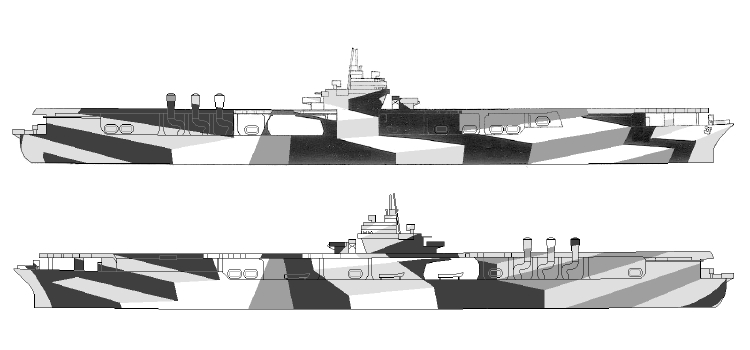
Here is the silhouette of the design drawing for Measure 33/1A for the carrier USS Ranger (CV-4) dated June 6, 1944. This design was similar to Design 9D and Design 2F, but used four colors: navy blue (5-N), ocean gray (5-O), haze gray (5-H) and pale gray (5-P) of the Measure 33 range. The starboard side is a very good match to 9D or 2F; the pattern was enlarged and stretched to fit a larger ship and there were three “stairs” to the right of the wedges instead of two. The wedges were just aft of the island superstructure, which is reminiscent of Design 3A for the Essex class carriers. The port side is, like 9D and 2F, a repeat of the starboard with left and right maintained.
There have been no other Design 1A drawings found. Because of the similarity with 9D and 2F, this design may have been developed earlier than the above June 1944 date.
Original drawing source: NARA 80-G-173270.
1AO Designs
March 1943 1AO in Measure 33 for AO-49
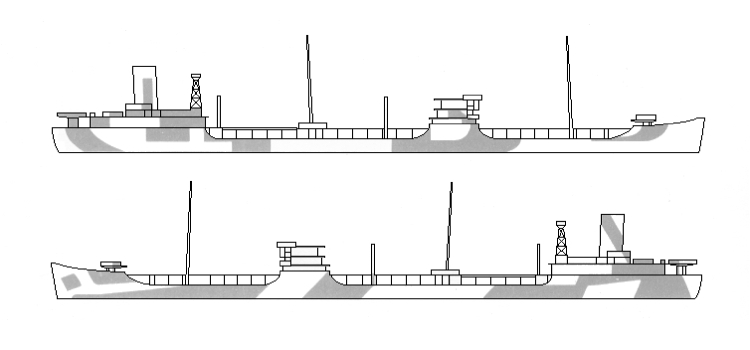
This is a silhouette of the design drawing for Measure 33/1AO drawn for the Ashtabula class fleet oilers included with the March 1943 release of SHIPS-2. The Measure 33 colors were ocean gray (5-O) and pale gray (5-P). This drawing shows only a single waterline, a full load waterline.
No other drawings for Design 1AO have been found. This design was worn by USS Chickaskia (AO-54) in late 1943 until she repainted in 32/3AO in 1944.
Original drawing source: March 1943 Supplement to SHIPS-2 Plate XXIII.
1B Designs
March 1943 1B in Measure 33 for BB-55
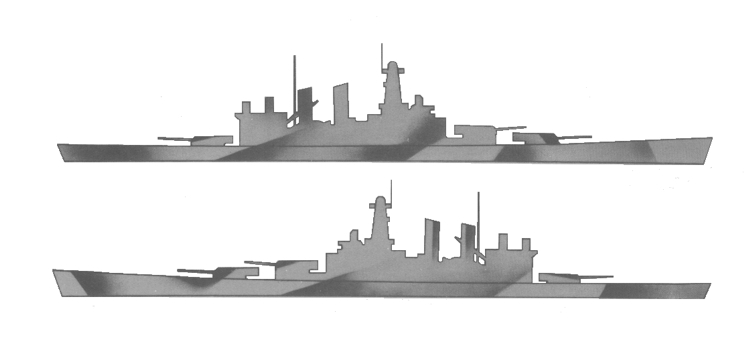
This is the earliest design drawing for Measure 33/1B drawn for the North Carolina class battleships included with the March 1943 release of SHIPS-2. The Measure 33 colors shown were haze gray (5-H) oversprayed with navy blue (5-N).
This is the only Design 1B drawing yet found.
Original drawing source: March 1943 Supplement to SHIPS-2 Plate XXIV.
July 15, 1943 ? 1B in Measure 32 for BB-56

A design drawing for Measure 32/1B for the battleship USS Washington (BB-56) was attached to the July 15, 1943, memo from BuShips to PacFleet, but has yet to be found in any archives. This may have been merely a reissue of the March drawing.
A Design 1B drawing was attached to the March 1943, SHIPS-2 for the battleship USS North Carolina (BB-55) and was porbably very similar to this. The battleship USS Iowa (BB-61) was photographed in this design in early 1944 and probably used this drawing or the previous one.
Original drawing source: NARA ?
1C Designs
March 1943 1C in Measure 32 for CA-38
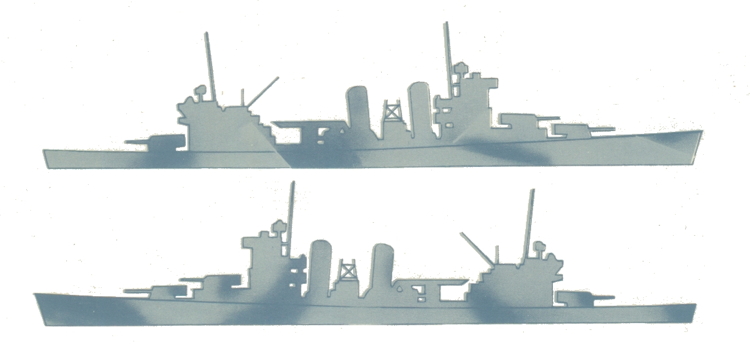
This is the earliest design drawing for Measure 32/1C drawn for the San Francisco class heavy cruisers included with the March 1943 release of SHIPS-2. The colors were light gray (5-L) oversprayed and graded by ocean gray (5-O): later this combination of colors would usually be labeled Measure 33. Almost all edges used feathering into the adjacent color; this could only be done by mechanical spraying and would probably be difficult to maintain or repaint. In fact, an August 1943 memo from the Pacific Fleet to the Bureau of Ships recommended: “Soft, graded patterns should be avoided until expert supervision for application may be made available.” This may be why no Pacific Fleet ships used this particular design drawing. Note, because of the lack of control in the color reproduction process, these colors may not be a true match to the actual colors.
The first Design 1C drawing was for the heavy cruiser USS San Francisco (CA-38) using Measure 32 and was attached to the March 1943 Supplement to SHIPS-2, as above. Then sometime later probably still 1943 Design 1C was drawn for the Atlanta class light cruisers also in Measure 32.
Original drawing source: March 1943 Supplement to SHIPS-2 Plate XXVII.
October 1943 ? 1C in Measure 32 for CL-51
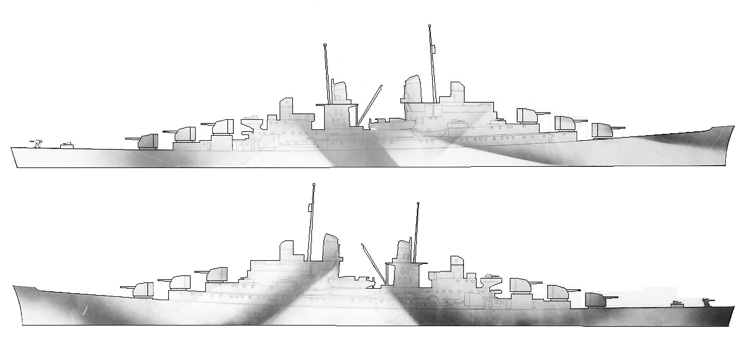
This is a silhouette of the original Design 1C drawing for the Atlanta class light cruisers probably drawn up in 1943. The style of this drawing and the fact that it is a single page indicate that this was an early design drawing. The colors indicated were pale gray (5-P) oversprated by ocean gray (5-O); again colors that later would be labeled Measure 33. Almost all edges use feathering into adjacent colors; this could only be done by spraying and would probably be difficult to maintain or repaint. In fact, an August 1943 memo from the Pacific Fleet to the Bureau of Ships recommended: “Soft, graded patterns should be avoided until expert supervision for application may be made available.” This may be why no Pacific Fleet ships used this particular design drawing.
The first Design 1C drawing was for the heavy cruiser USS San Francisco (CA-38) using Measure 32 and was attached to the March 1943 Supplement to SHIPS-2. Then sometime later probably still 1943 Design 1C was drawn for the Atlanta class light cruisers also in Measure 32, as above.
Original drawing source: NARA 80-G-150619.
1D Designs
March 1943 1D in Measure 33 for DD-380
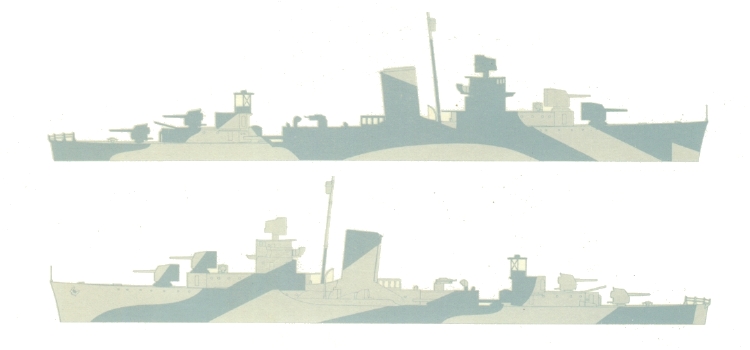
This is the earliest design drawing for Measure 33/1D drawn for the Gridley class destroyers included with the March 1943 release of SHIPS-2. The Measure 33 colors were haze gray (5-H) and pale gray (5-P). Note, because of the lack of control in the color reproduction process, these colors may not be a true match to the actual colors.
Design 1D was also worn by the battleship USS Tennessee (BB-43), the large cruiser USS Alaska (CB-1), the light cruisers USS Raleigh (CL-7), USS Houstan (CL-81), and USS Miami (CL-89) all in Measure 32 colors. The light cruiser USS Columbia (CL-56) wore this design using Measure 33 colors. In addition, Design 1D was worn by a few Evarts class destroyer escorts mostly in Measure 32.
Original drawing source: March 1943 Supplement to SHIPS-2 Plate XIX.
July 15, 1943 ? 1D in Measure 32 for DD-380
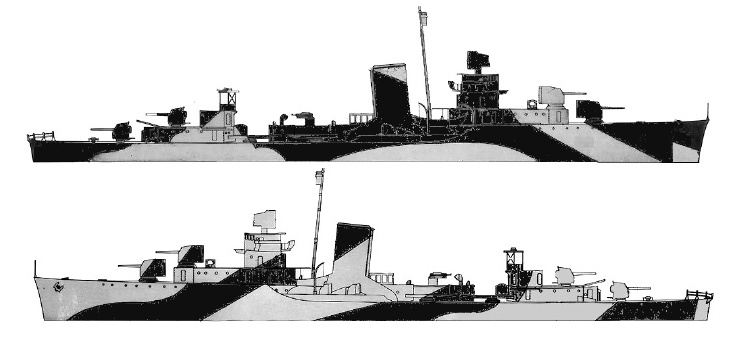
The design drawing for Measure 32/1D for the Gridley class destroyers. This may be one of the earliest design drawings for Measure 32/1D drawn for the Gridley class destroyers included with the memo to PacFleet dated July 15, 1943. The pattern here is exactly the same as the previous drawing with different colors, dull black (BK) and light gray (5-L) for Measure 32.
The first drawing for Design 1D was attached to the March 1943 Supplement to SHIPS-2 for DD-380 Gridley class using Measure 33. Design 1D was also worn by the battleship USS Tennessee (BB-43), the large cruiser USS Alaska (CB-1), the light cruisers USS Raleigh (CL-7), USS Houstan (CL-81), and USS Miami (CL-89) all in Measure 32 colors. The light cruiser USS Columbia (CL-56) wore this design using Measure 33 colors. In addition, Design 1D was worn by a few Evarts class destroyer escorts mostly in Measure 32.
Original drawing source: NARA 80-G-170944 and 80-G-170945.
August 1943 ? 1D in Measure 32 for BB-43
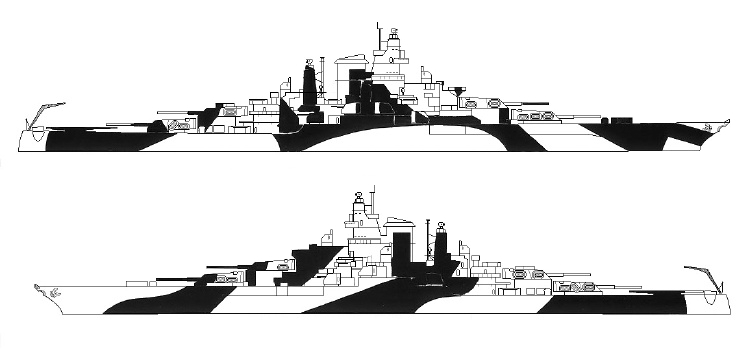
A silhouette of the design drawing for Measure 32/1D drawn probably in August 1943, for the battleship USS Tennessee (BB-43). The overall pattern has been stretched out onto a much larger ship's profile and thus the panels are much larger. The pattern on the superstructure appears intended to break up the distinctive profile and to possibly simulate a ship with two smaller stacks.
The first drawing for Design 1D was attached to the March 1943 Supplement to SHIPS-2 for DD-380 Gridley class using Measure 33. Design 1D was also worn by the battleship USS Tennessee (BB-43), the large cruiser USS Alaska (CB-1), the light cruisers USS Raleigh (CL-7), USS Houstan (CL-81), and USS Miami (CL-89) all in Measure 32 colors. The light cruiser USS Columbia (CL-56) wore this design using Measure 33 colors. In addition, Design 1D was worn by a few Evarts class destroyer escorts mostly in Measure 32.
Original drawing source: NARA 80-G-157054 and 80-G-157055.
August 1943 ? 1D in Measure 32 for CL-55
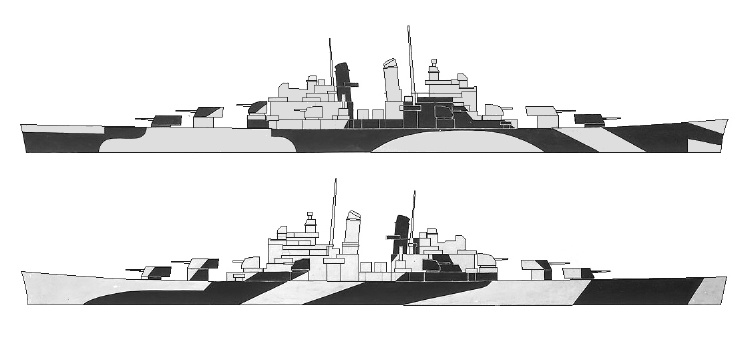
The design silhouette for Measure 32/1D for the Cleveland class light cruisers drawn possibly in August, 1943. The vertical colors were light gray (5-L) and dull black (BK) for Measure 32 or pale gray (5-P) and ocean gray (5-O) or navy blue (5-N) for Measure 33. The pattern has remained the same with some changes around the superstructure.
The first drawing for Design 1D was attached to the March 1943 Supplement to SHIPS-2 for DD-380 Gridley class using Measure 33. Design 1D was also worn by the battleship USS Tennessee (BB-43), the large cruiser USS Alaska (CB-1), the light cruisers USS Raleigh (CL-7), USS Houstan (CL-81), and USS Miami (CL-89) all in Measure 32 colors. The light cruiser USS Columbia (CL-56) wore this design using Measure 33 colors. In addition, Design 1D was worn by a few Evarts class destroyer escorts mostly in Measure 32.
Original drawing source: NARA 80-G-170944 and 80-G-170945.
August 19, 1943 1D in Measure 32 for CL-7
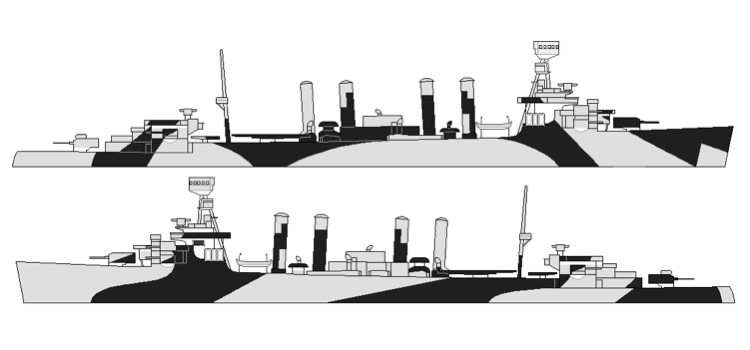
A silhouette of the design drawing for Measure 32/1D for USS Raleigh (CL-7) of the Omaha class light cruisers drawn on August 19, 1943. The 1D pattern has been only slightly changed mostly to break up the distinctive outline of the stacks and the bridge. White countershading has been added to lessen the shadows of overhangs.
The first drawing for Design 1D was attached to the March 1943 Supplement to SHIPS-2 for DD-380 Gridley class using Measure 33. Design 1D was also worn by the battleship USS Tennessee (BB-43), the large cruiser USS Alaska (CB-1), the light cruisers USS Raleigh (CL-7), USS Houstan (CL-81), and USS Miami (CL-89) all in Measure 32 colors. The light cruiser USS Columbia (CL-56) wore this design using Measure 33 colors. In addition, Design 1D was worn by a few Evarts class destroyer escorts mostly in Measure 32.
Original drawing source: NARA 80-G-170944 and 80-G-170945.
September 1943 ? 1D in Open Measure for DD-445
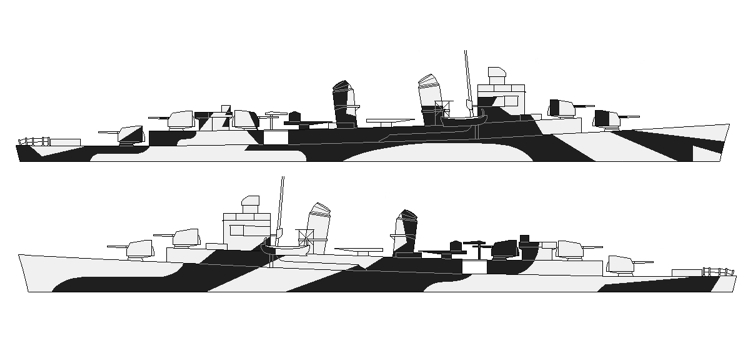
The silhouette for the design drawing for Measure 32/1D for the Fletcher class destroyers probably drawn in September 1943. The lightest vertical color light gray (5-L) could be replaced by ocean gray (5-O) or haze gray (5-H) to make this Measure 31. This version of Design 1D retains the curves and shapes of previous versions.
The first drawing for Design 1D was attached to the March 1943 Supplement to SHIPS-2 for DD-380 Gridley class using Measure 33. Design 1D was also worn by the battleship USS Tennessee (BB-43), the large cruiser USS Alaska (CB-1), the light cruisers USS Raleigh (CL-7), USS Houstan (CL-81), and USS Miami (CL-89) all in Measure 32 colors. The light cruiser USS Columbia (CL-56) wore this design using Measure 33 colors. In addition, Design 1D was worn by a few Evarts class destroyer escorts mostly in Measure 32.
Original drawing source: NARA 80-G-170944 and 80-G-170945.
December 1943 ? 1D in Measure 32 for BB-59
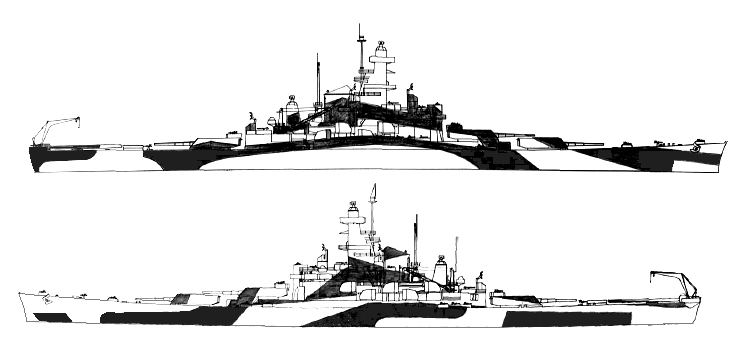
This is the silhouette of Design 1D in Measure 32 colors drawn for the USS Massachusetts (BB-59) probably dated November or December 1943, since it was sent to Massachusetts on December 8, 1943. As with the earlier design for Tennessee, the pattern was stretched over a larger ship, but the pattern on the superstructure was much different to break up a different profile. The stretch of the pattern has added a panel to the port bow. This version of Design 1D was apparently never used.
Design 1D was also worn by the battleship USS Tennessee (BB-43), the large cruiser USS Alaska (CB-1), the light cruisers USS Raleigh (CL-7), USS Houstan (CL-81), and USS Miami (CL-89) all in Measure 32 colors. The light cruiser USS Columbia (CL-56) wore this design using Measure 33 colors. In addition, Design 1D was worn by a few Evarts class destroyer escorts mostly in Measure 32.
Original drawing source: NARA 80-G-157914.
January, 1944 ? 1D in Measure 31 for DE-5
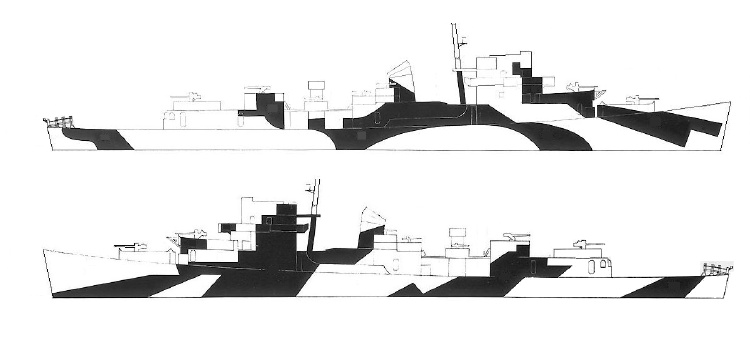
This is a silhouette from the drawing for Design 1D drawings for the Evarts class destroyer escorts produced probably in early 1944. The curves on the port side edges of the black panels are now straight lines. The colors shown are dull black (BK) and haze gray (5-H), a lighter version of Measure 31, which often in photos appears to be dull black (BK) and light gray (5-L), Measure 32.
Design 1D was also worn by the battleship USS Tennessee (BB-43), the large cruiser USS Alaska (CB-1), the light cruisers USS Raleigh (CL-7), USS Houstan (CL-81), and USS Miami (CL-89) all in Measure 32 colors. The light cruiser USS Columbia (CL-56) wore this design using Measure 33 colors. In addition, Design 1D was worn by a few Evarts class destroyer escorts mostly in Measure 32.
Original drawing source: NARA 80-G-172859 and 80-G-172871.
February 12, 1944 1D in Measure 32 for CB-1
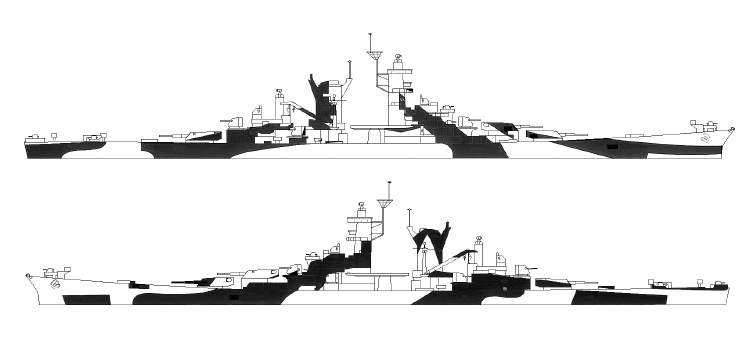
Here is the silhouette of the design drawing for Measure 32/1D in two colors drawn for the Alaska class large cruisers dated February 12, 1944. This pattern has also been stretched to fit a much longer ship and many panels have been lengthened and the port bow panel appears again. The panels on the superstructure are intended to break up a very distinctive profile.
Design 1D was also worn by the battleship USS Tennessee (BB-43), the large cruiser USS Alaska (CB-1), the light cruisers USS Raleigh (CL-7), USS Houstan (CL-81), and USS Miami (CL-89) all in Measure 32 colors. The light cruiser USS Columbia (CL-56) wore this design using Measure 33 colors. In addition, Design 1D was worn by a few Evarts class destroyer escorts mostly in Measure 32.
Original drawing source: NARA 80-G-165989 and 80-G-165990.
March 6, 1944 1D in Measure 32 for DD-409
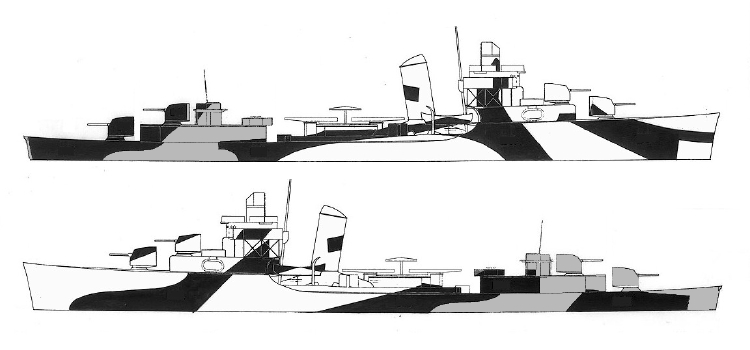
The design drawing silhouette for Measure 32/1D for the Sims class destroyers drawn on March 6, 1944. The lightest vertical color light gray (5-L) could be replaced by haze gray (5-H) to make this Measure 31. This may be the first version of Design 1D that used three colors. The port side curves have been retained.
Design 1D was also worn by the battleship USS Tennessee (BB-43), the large cruiser USS Alaska (CB-1), the light cruisers USS Raleigh (CL-7), USS Houstan (CL-81), and USS Miami (CL-89) all in Measure 32 colors. The light cruiser USS Columbia (CL-56) wore this design using Measure 33 colors. In addition, Design 1D was worn by a few Evarts class destroyer escorts mostly in Measure 32.
Original drawing source: NARA 80-G-170944 and 80-G-170945.
May 27, 1944 1D in Measure 32 for DE-51
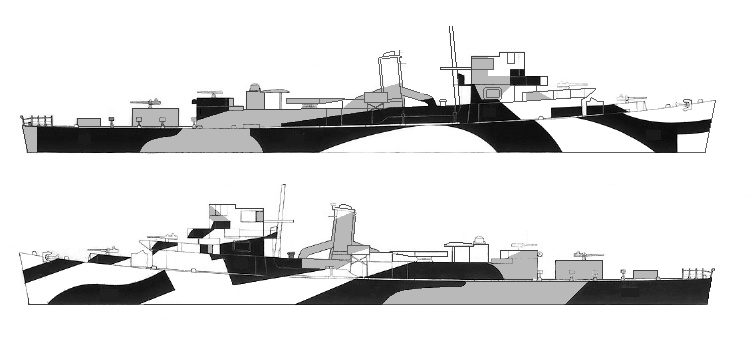
This is a silhouette of the original Design 1D drawings for the Buckley class Destroyer Escorts. The original drawings were produced on May 27, 1944, and did not include the whaleboat. The three colors shown are Measure 32: dull black (BK) ocean gray (5-O) and light gray (5-L). The curve of the port bow panel has returned along with an additional panel.
Design 1D was also worn by the battleship USS Tennessee (BB-43), the large cruiser USS Alaska (CB-1), the light cruisers USS Raleigh (CL-7), USS Houstan (CL-81), and USS Miami (CL-89) all in Measure 32 colors. The light cruiser USS Columbia (CL-56) wore this design using Measure 33 colors. In addition, Design 1D was worn by a few Evarts class destroyer escorts mostly in Measure 32.
Original drawing source: NARA 80-G-172860 and 80-G-172872.
July 15, 1943 ? 1D in Measure 33 for DD-380
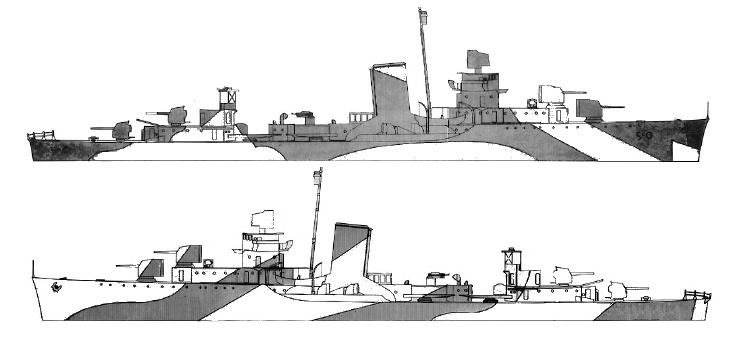
This is possibly the design drawing for Measure 33/1D drawn for the Gridley class destroyers included with the July 15, 1943, memo to PacFleet, but has not yet been found. The Measure 33 colors would have been ocean gray (5-O) and light gray (5-L). This may have been identical to the design included with the March 1943 release of SHIPS-2. There was also another DD-380 drawing in 32/1D included with the July 15, 1943, memo to PacFleet possibly the next drawing.
Design 1D was also worn by the battleship USS Tennessee (BB-43), the large cruiser USS Alaska (CB-1), the light cruisers USS Raleigh (CL-7), USS Houstan (CL-81), and USS Miami (CL-89) all in Measure 32 colors. The light cruiser USS Columbia (CL-56) wore this design using Measure 33 colors. In addition, Design 1D was worn by a few Evarts class destroyer escorts mostly in Measure 32.
Original drawing source: NARA ?
1F Designs
March 1943 1F in Measure 33 for EC-2
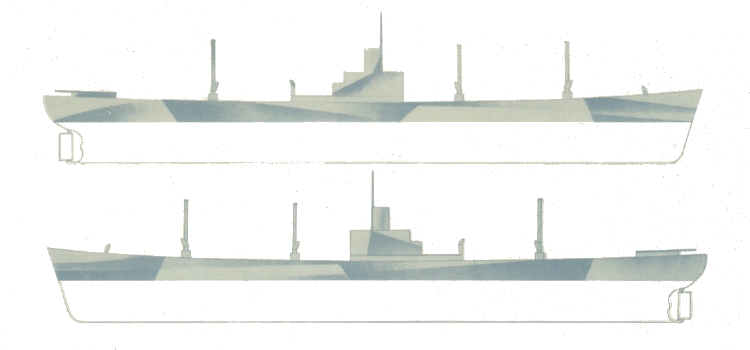
This design drawing for Measure 33/1F for “Liberty” cargo ships of (EC2-S-C1) maritime hull was attached to the March 1943 supplement to SHIPS-2. The Measure 33 colors were ocean gray (5-O) over a background of pale gray (5-P). Note, because of the lack of control in the color reproduction process, these colors may not be a true match to the actual colors. The ocean gray was intended to be sprayed and “feathered” over the pale gray. This could probably only be done or maintained at a port facility. This design was later redrawn with solid edged panels probably because of the Pacific Fleet memo in August 1943 which recommended: “Soft, graded patterns should be avoided until expert supervision for application may be made available.”
The first drawing for Design 1F was for “Liberty” style cargo ships using feathered edges was attached to the March 1943 supplement to SHIPS-2 as above. On January 29, 1944, Design 1F was redrawn using “open” measure colors and with solid edges for the Alkaid class “Liberty” style cargo ships. Then Design 1F was drawn for the Barnegat class small seaplane tenders on March 6, 1944.
Original drawing source: March 1943 Supplement to SHIPS-2 Plate XXII.
September 1943 ? 1F in Measure 33 for EC-2
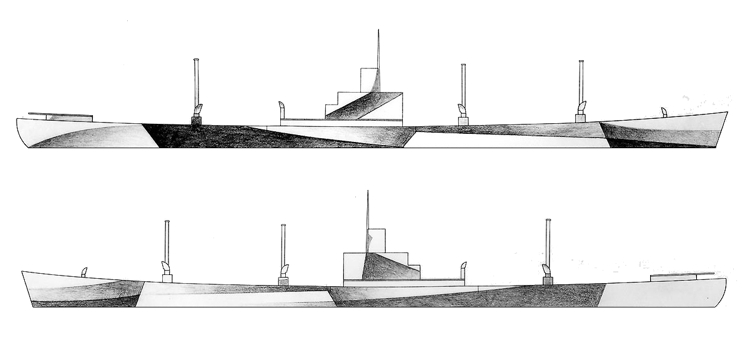
This design drawing for Measure 33/1F for “Liberty” cargo ships of (EC2-S-C1) maritime hull was undated, but is almost identical to the drawing attached to the March 1943 supplement to SHIPS-2 except not in color. The Measure 33 colors were ocean gray (5-O) over a background of pale gray (5-P). The ocean gray was intended to be sprayed and “feathered” over the pale gray. This could probably only be done or maintained at a port facility. This design was later redrawn with solid edged panels probably because of the Pacific Fleet memo in August 1943 which recommended: “Soft, graded patterns should be avoided until expert supervision for application may be made available.”
The first drawing for Design 1F was for “Liberty” style cargo ships using feathered edges was attached to the March 1943 supplement to SHIPS-2. On January 29, 1944, Design 1F was redrawn using “open” measure colors and with solid edges for the Alkaid class “Liberty” style cargo ships. Then Design 1F was drawn for the Barnegat class small seaplane tenders on March 6, 1944.
Original drawing source: NARA 80-G-152118 and 80-G-152122.
January 29, 1944 1F in Measure 3_ for AK-114
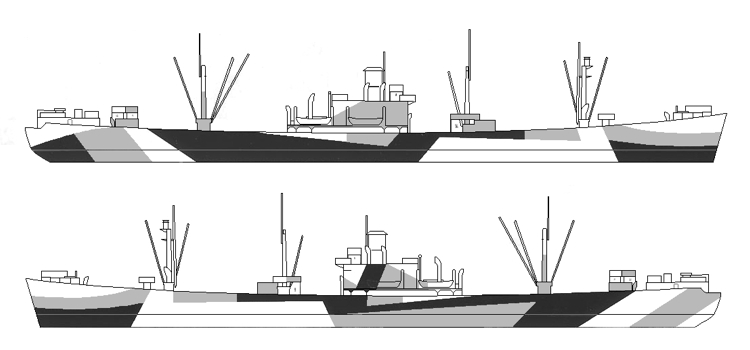
This is the drawing for Design 1F for the Alkaid class “Liberty” cargo ships of (EC2-S-C1) maritime hull dated January 29, 1944. The open measure colors were shown, but would have been dull black (BK), ocean gray (5-O) and light gray (5-L) for Measure 32 or navy blue (5-N), haze gray (5-H) and pale gray (5-P) for Measure 33. Note: the boundaries between colors are solid lines and not feathered; also a second waterline is shown so that the pattern extends below the load line down to the light load waterline. Thus, any ship that was lightly loaded would have camouflage to the waterline.
The first drawing for Design 1F was for “Liberty” style cargo ships using feathered edges was attached to the March 1943 supplement to SHIPS-2. On January 29, 1944, Design 1F was redrawn using “open” measure colors and with solid edges for the Alkaid class “Liberty” style cargo ships as above. Then Design 1F was drawn for the Barnegat class small seaplane tenders on March 6, 1944.
Original drawing source: NARA 80-G-105492 and 80-G-105493. .
March 6, 1944 1F in Measure 33 for AVP-10
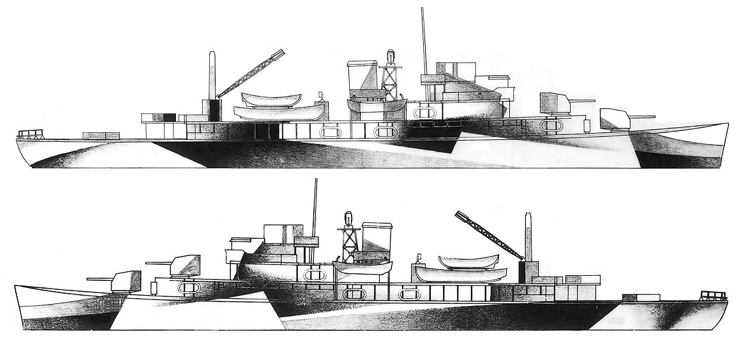
The design drawing for Measure 33/1F for the Barnegat class small seaplane tenders drawn on March 6, 1944. The Measure 33 colors were navy blue (5-N), ocean gray (5-O) and pale gray (5-P). The dark colors are feathered into the lighter colors as in the earlier C-2 version. Some ships painted this design with solid or straight edges. A drawing showing the solid edges for this design has not been found.
The first drawing for Design 1F was for “Liberty” style cargo ships using feathered edges was attached to the March 1943 supplement to SHIPS-2. On January 29, 1944, Design 1F was redrawn using “open” measure colors and with solid edges for the Alkaid class “Liberty” style cargo ships. Then Design 1F was drawn as above for the Barnegat class small seaplane tenders on March 6, 1944.
Original drawing source: NARA 80-G-174529 and 80-G-174530.
1L Designs
March 1943 1L in Measure 31 for LST-1
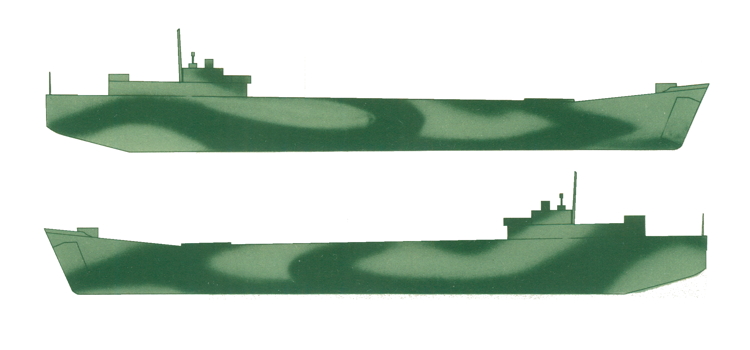
This is a silhouette of the design drawing for Measure 33/1L drawn for the LST's included with the March 1943 release of SHIPS-2. The Measure 31 colors were navy green (5-NG) oversprayed on haze green (5-HG). Note, because of the lack of control in the color reproduction process, these colors may not be a true match to the actual colors.
No other drawings for Design 1L have been found.
Original drawing source: March 1943 Supplement to SHIPS-2 Plate XXXVI.
1M Designs
January 25, 1944 1M in Measure 32 for AM-55
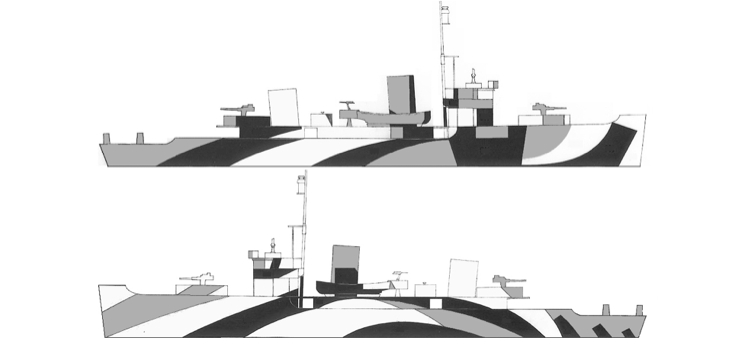
A silhouette of the design drawing for Measure 32 Design 1M for the Raven class minesweepers but could also be used by the Auk class minesweepers. This drawing was dated January 25, 1944. The vertical colors were light gray (5-L), ocean gray (5-O) and dull black (BK). The sweeping curves in the pattern give an observer a sense of rotation.
No other drawings for Design 1M have been found.
Original drawing source: NARA 80-G-105494 and 80-G-105495.
1P Designs
March 1943 1P in Measure 31 for SC 110'
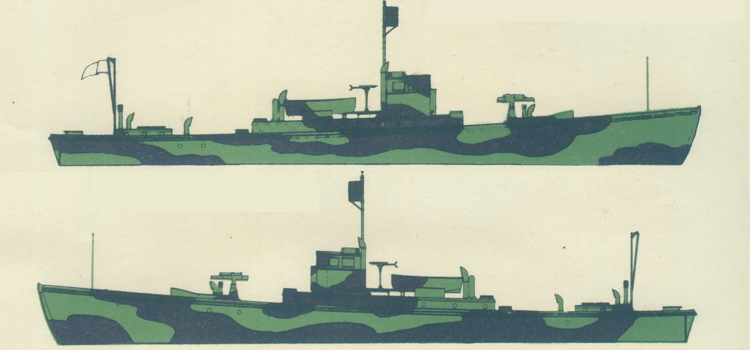
This is a silhouette of the design drawing for Measure 31/1P drawn for the 110-foot subchasers included with the March 1943 release of SHIPS-2. The Measure 31 colors were navy blue (5-N) and ocean green (5-OG). Note, because of the lack of control in the color reproduction process, these colors may not be a true match to the actual colors.
No other drawings for Design 1P have been found.
Original drawing source: March 1943 Supplement to SHIPS-2 Plate XXXIII.
1T Designs
March 1943 1T in Measure 32 for AP-21
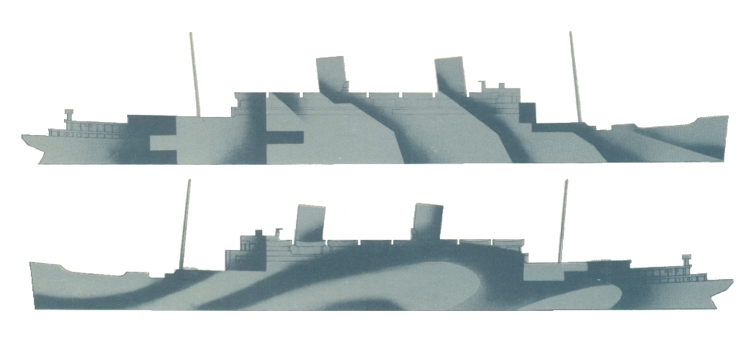
This is a silhouette of the design drawing for Measure 32/1T drawn for the transport USS Wakefield included with the March 1943 release of SHIPS-2. The Measure 32 colors were haze gray (5-H) oversprayed with navy blue (5-N). Note, because of the lack of control in the color reproduction process, these colors may not be a true match to the actual colors.
No other drawings for Design 1T have been found.
Original drawing source: March 1943 Supplement to SHIPS-2 Plate XXXI.
2A Designs
March 18, 1944 2A in Measure 33 for CVE-9
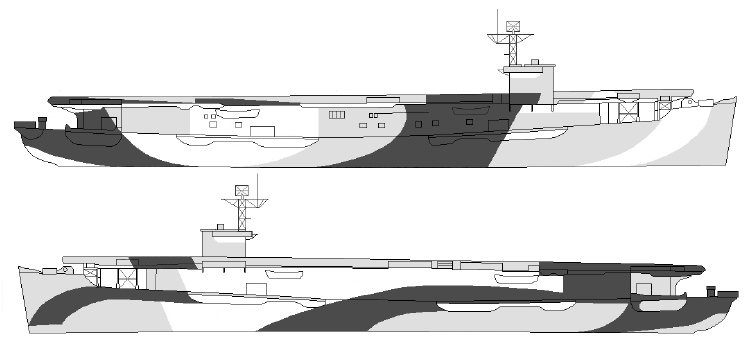
This is the earliest design drawing for Measure 33 Design 2A for the Bogue class escort carriers dated March 18, 1944. The vertical colors were specified to be navy blue (5-N), haze gray (5-H) and pale gray (5-P) and the horizontal color was deck blue (20-B). The Measure 32 vertical colors would probably be dull black (BK), ocean gray (5-O) and light gray (5-L).
The first drawing for Design 2A was for the Bogue class of escort carriers on March 18, 1944. Then probably later in 1944 Design 2A was drawn for USS Bayfield (APA-33).
Original drawing source: NARA 80-G-109717 and 80-G-109718.
June 1944 ? 2A in Measure 32 for APA-33
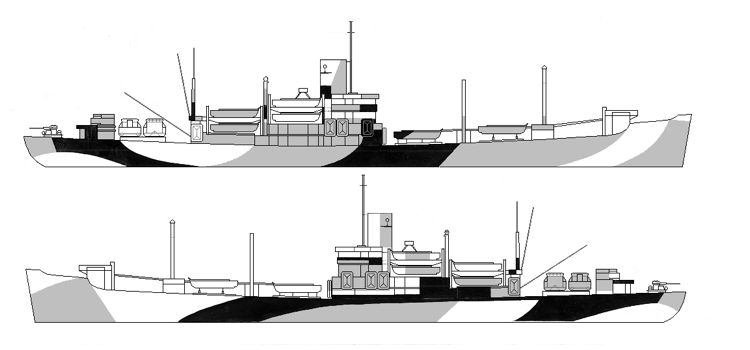
This is a silhouette of the original drawing for Measure 32 Design 2A for the Bayfield class attack transports of (C3-S-A2) maritime type hull. The vertical colors were specified to be navy blue (5-N), ocean gray (5-O) and light gray (5-L) with deck blue (20-B) for the horizontal color. This drawing was mislabeled for “APA 3,7,10 & AGC 3” and was undated, but was probably drawn in June or July 1944.
The first drawing for Design 2A was for the Bogue class of escort carriers on March 18, 1944. Then probably later in 1944 Design 2A was drawn as above for the Bayfield class attack transports.
Original drawing source: NARA 80-G-177453 and 80-G-177454.
2AO Designs
February 28, 1944 2AO in Measure 32 for AOG-1
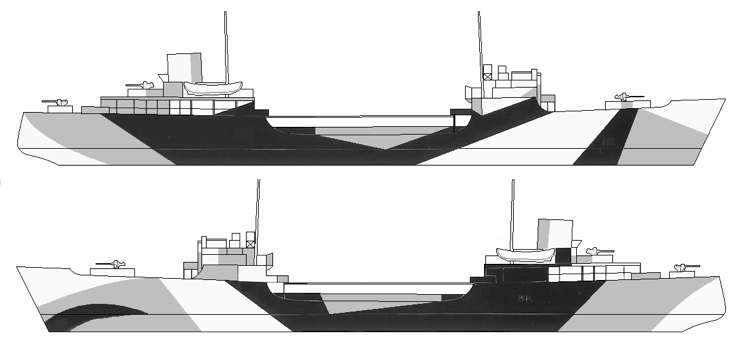
The composite drawings for Design 32/2AO for the Patapsco class gasoline tankers based on the T1-MT-M1 maritime hull. The vertical colors specified were: dull black (BK), ocean gray (5-O) and light gray (5-L). This drawing was dated February 28, 1944. This drawing shows two waterlines: a load waterline and a “camouflage line.” This was common for most tanker drawings.
No other drawings for Design 2AO have been found.
Original drawing source: NARA 80-G-174539 and 80-G-174540.
2Ax Designs
December 9, 1943 2AX in Measure 32 for AVP-10
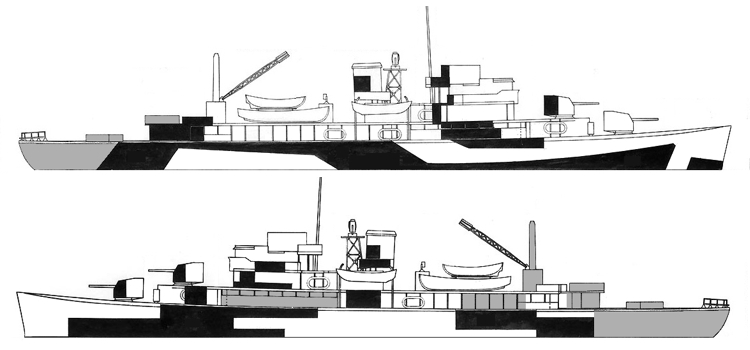
A silhouette of the design drawings for Design 2Ax for the Barnegat class small seaplane tenders drawn on December 9, 1943. The Measure 32 colors shown are dull black (BK), ocean gray (5-O) and light gray (5-L). The deck color is all deck blue (20-B).
No other drawings for Design 2AX have been found.
Original drawing source: NARA 80-G-162028 and 80-G-162029.
2C Designs
July 15, 1943 ? 2C in Measure 32 for CA-38
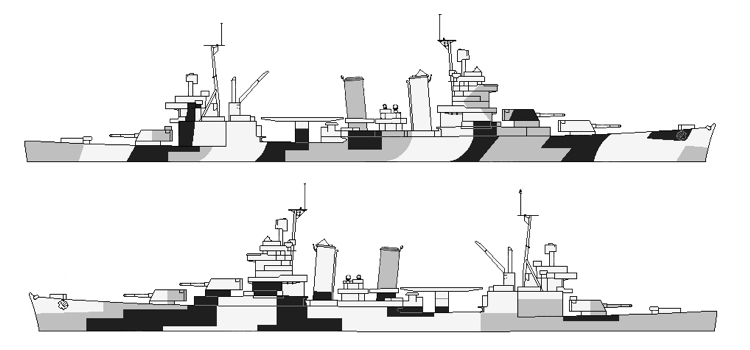
The earliest design drawing for Design 2C drawn for the New Orleans class heavy cruiser USS San Francisco (CA-38) dated July 15, 1943, has yet to be found. This is what that drawing may have looked like. USS Honolulu (CL-48) reported on February 21, 1944, that she had been painted in 32/2C by Mare Island (probably in November 1943 using the CA-38 drawing) and asked for a copy of the drawing for maintenence. BuShips produced the drawing slightly modified on March 31, 1944, for USS St Louis (CL-49). This could explain the slight differences in pattern between Honolulu and St Louis.
A drawing for Design 2C was attached to the July 15, 1943, memo to PacFleet for the heavy cruiser San Francisco (CA-38). Probably in January 1944 Design 2C was drawn for the Fletcher class destroyers. Design 2C can be seen carried by the Brooklyn class light cruisers USS St Louis (CL-49) and USS Honolulu (CL-48). It was also used with slight modifications on many destroyer escorts of the John C. Butler class.
Original drawing source: NARA ?
December 1943 ? 2C in Measure 31 for DD-445
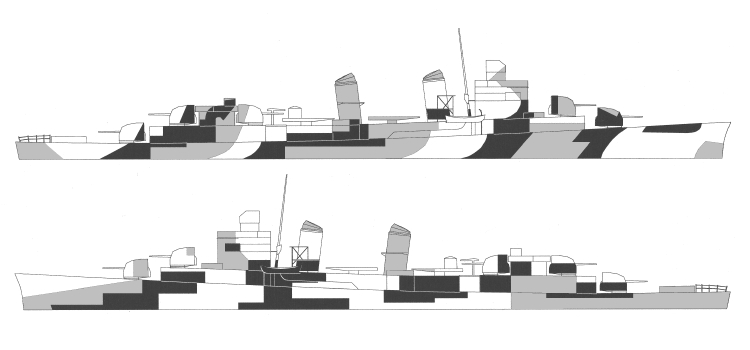
The design drawing for Measure 31 Design 2C for the Fletcher class destroyers drawn probably in December, 1943. The vertical colors for Measure 31 were dull black (BK), ocean gray (5-O) and haze gray (5-H) while light gray (5-L) could be subsituted for haze gray to become Measure 32. This Design 2C drawing is probably not very different from the first version in July 1943.
A drawing for Design 2C was attached to the July 15, 1943, memo to PacFleet for the heavy cruiser San Francisco CA-38. Design 2C can be seen carried by the Brooklyn class light cruisers USS St Louis (CL-49) and USS Honolulu (CL-48). It was also used with slight modifications on many destroyer escorts of the John C. Butler class.
Original drawing source: NARA 80-G-109625 and 80-G-109626.
February 16, 1944 2C in Measure 32 for DD-409
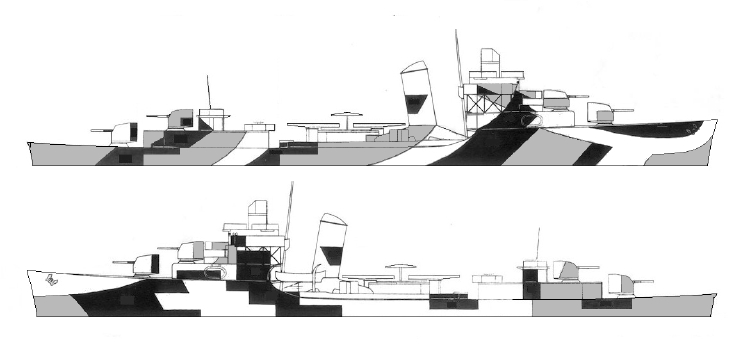
A silhouette of the design drawing for Measure 32 Design 2C drawn on February 16, 1944, for the Sims class destroyers. There have been slight adjustments to the pattern on the port side and not as much to the starboard side except for the disappearance of the “lucky seven” panel near the bow.
A drawing for Design 2C was attached to the July 15, 1943, memo to PacFleet for the heavy cruiser San Francisco CA-38. Design 2C can be seen carried by the Brooklyn class light cruisers USS St Louis (CL-49) and USS Honolulu (CL-48). It was also used with slight modifications on many destroyer escorts of the John C. Butler class.
Original drawing source: NARA 80-G-172533 and 80-G-172535.
March 28, 1944 2C in Measure 31 for DE-339

The design silhouette for Measure 31/2C for the John C. Butler class destroyer escorts drawn on March 28, 1944. The colors for Measure 32 were dull black (BK), ocean gray (5-O) and haze gray (5-H), if light gray (5-L) were used instead of haze gray thia would be Measure 32. This version of Design 2C has some additional slight modifications, but is still recognizable as Design 2C.
A drawing for Design 2C was attached to the July 15, 1943, memo to PacFleet for the heavy cruiser San Francisco CA-38. Design 2C can be seen carried by the Brooklyn class light cruisers USS St Louis (CL-49) and USS Honolulu (CL-48). It was also used with slight modifications as above by many destroyer escorts of the John C. Butler class.
Original drawing source: NARA 80-G-172518 and 80-G-172519.
March 31, 1944 2C in Measure 32 for CL-49
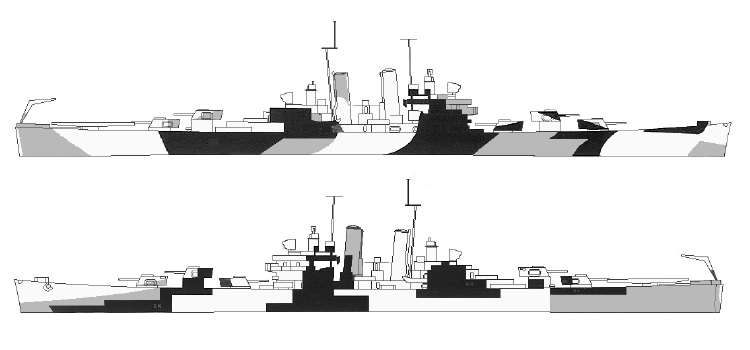
A silhouette of the design drawing for Measure 32/2C for the Brooklyn class light cruisers drawn on March 31, 1944. This last version of Design 2C more closely resembles the earlier Fletcher version and has the “lucky seven” panel on the starboard.
A drawing for Design 2C was attached to the July 15, 1943, memo to PacFleet for the heavy cruiser San Francisco CA-38. Design 2C can be seen carried by the Brooklyn class light cruisers USS St Louis (CL-49) and USS Honolulu (CL-48). It was also used with slight modifications on many destroyer escorts of the John C. Butler class.
Original drawing source: NARA 80-G-109719 and 80-G-109720.
2D Designs
March 1943 2D in Measure 33 for 3-stack DD's

A silhouette of the drawing for Design 2D for three-stack destroyer classes (modified from four-stack) using Measure 33 was attached to the March 1943 Supplement to SHIPS-2. The Measure 33 vertical colors were specified to be the very light combination of haze gray (5-H) and pale gray (5-P). Note, because of the lack of control in the color reproduction process, these colors may not be a true match to the actual colors.
No other drawings for Design 2D have been found.
Original drawing source: March 1943 Supplement to SHIPS-2 Plate XXI.
2F Designs
March 1943 2F in Measure 32 for AK-25
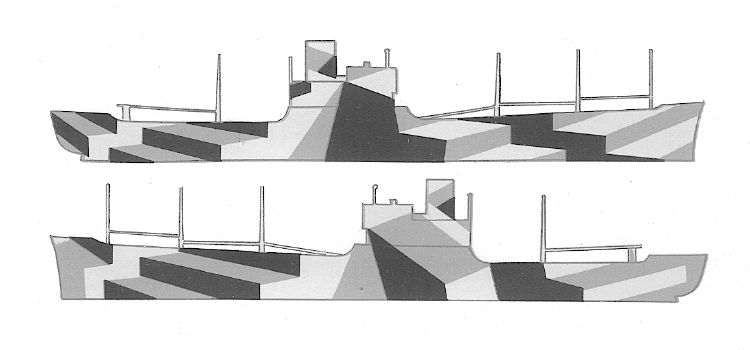
This is the silhouette of the earliest design drawing for Design 2F in Measure 32 for the USS Algorab (AK-25) a C2 type cargo ship and was attached to the March 1943 supplement to SHIPS-2. The Measure 32 colors were dull black (BK), haze gray (5-H) and pale gray (5-P). This starboard pattern is almost identical to the Design 9D pattern and consists of a wedge of haze gray and black centered under the bridge area flanked by false perspective “stairs” with dark sets to the left and light sets to the right. The port pattern is very similar it also has the wedge near the bridge with dark “stairs” on the left toward the bow and light “stairs” to the right and stern. Because of the similarity of Design 2F and Design 9D, they were probably developed at the same time or at least had the same root or origination.
The earliest Design 2F drawing was attached to the Supplement to SHIPS-2 in March 1943 as above. Then Design 2F was drawn for the Omaha class light cruisers on June 3, 1944.
Original drawing source: The March 1943 supplement to SHIPS-2 Plate XXIX.
June 3, 1944 2F in Measure 33 for CL-4
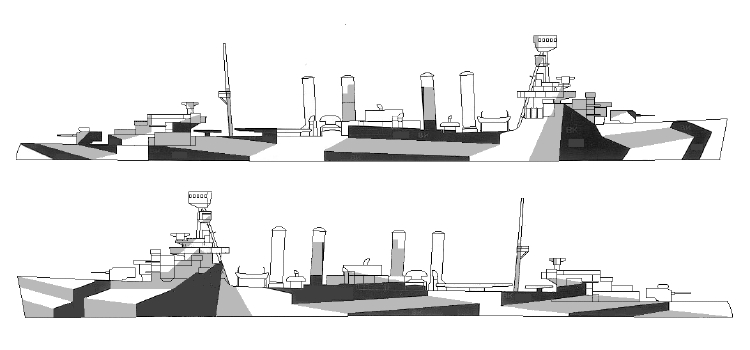
The silhouette for Measure 33/2F for the Omaha class light cruisers drawn on June 3, 1944. The vertical Measure 33 colors were pale gray (5-P), haze gray (5-H) and navy blue (5-N) with a pattern of ocean gray (5-O) and deck blue (20-B) on the horizontal surfaces. Measure 32 colors would be light gray (5-L), ocean gray (5-O) and dull black (BK) on the vertical surfaces. The starboard pattern here is much like the Design 9D pattern and consists of a wedge of haze gray and navy blue centered near the bridge area flanked by false perspective “stairs” with dark sets to the left and a light set to the right. The port pattern is unique among the other 2F and 9D patterns because it is almost a mirror image and keeps symmetry bow to stern while the earlier 2F and 9D port patterns had symmetry left to right and thus dark “stairs” on the bow and light “stairs” to the stern.
The earliest Design 2F drawing was attached to the Supplement to SHIPS-2 in March 1943. Then Design 2F was drawn for the Omaha class light cruisers on June 3, 1944, as above.
Original drawing source: NARA 80-G-172091 and 80-G-172092.
2M Designs
February 17, 1944 2M in Measure 32 for CM-11
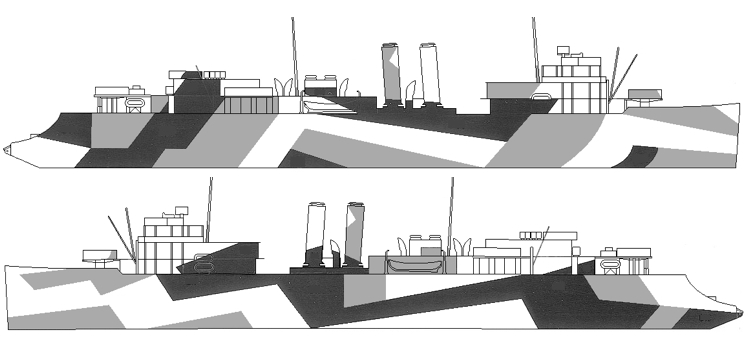
A silhouette of the drawing for Design 32/2M for the Salem class minelayers which had been modified from ferries. The Measure 32 vertical colors specified were: dull black (BK), ocean gray (5-O) and light gray (5-L) and the deck was deck blue (20-B). This drawing was dated February 17, 1944.
No other drawings for Design 2M have been found.
Original drawing source: NARA 80-G-165983 and 80-G-165984.
3A Designs
September 19, 1943 3A in Measure 3_ for CV-9
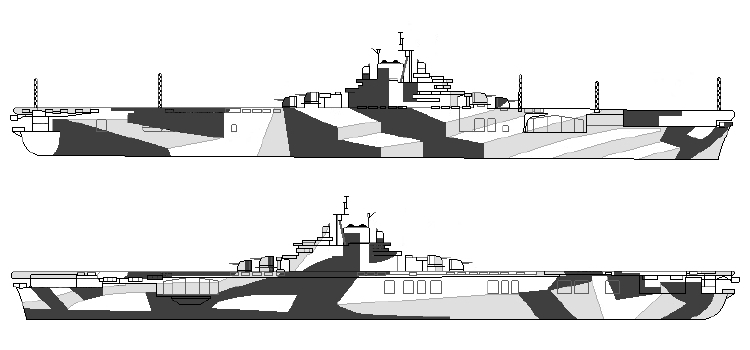
The earliest design drawing for Design 3A drawn for the Essex class carriers dated September 19, 1943. The Measure specified was open. The Measure 32 vertical colors would normally be dull black (BK), ocean gray (5-O) and light gray (5-L). Measure 33 vertical colors would be navy gray (5-N), haze gray (5-H) and pale gray (5-P). Notice the pattern on the starboard that is very similar to both Design 2F and Design 9D. These patterns were probably developed at the same time or had the same source. The port side pattern is unique and was probably only intended for carriers.
This is the only Design 3A drawing yet found.
Original drawing source: NARA 80-G-160238.
3AO Designs
January 1944 ? 3AO in Measure 32 for AO-22
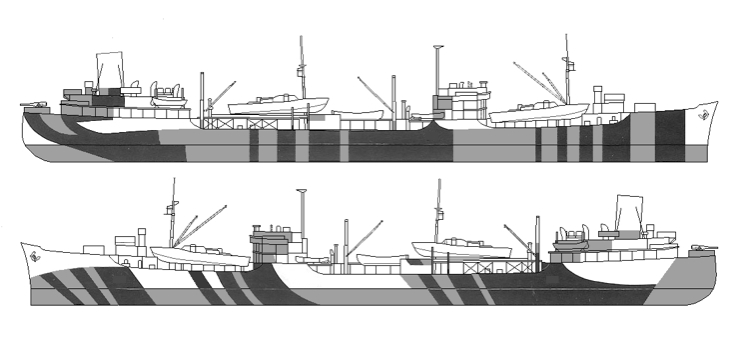
The silhouette of the drawing for Design 32/3AO for the Cimarron and Ashtabula classes of fleet oilers based on the T3 maritime hull. The vertical colors specified were: dull black (BK), ocean gray (5-O) and light gray (5-L); ships that substituted haze gray (5-H) for light gray would have been in Measure 31. This drawing was probably completed by January 1944. Note the PT boats shown as deck cargo and the two waterlines.
This is the only design drawing for Design 3AO.
Original drawing source: NARA 80-G-160236 and 80-G-160237.
3C Designs
Late 1943 3C in Measure 32 for CL-4

A silhouette of the design drawing for Measure 32/3C for the Omaha class light cruisers drawn on an unidentified date, but probably 1943. The style of this drawing indicates that this was an early design drawing. The vertical colors were specified to be pale gray (5-P), haze gray (5-H) and navy blue (5-N) with solid deck blue (20-B) on the horizontal surfaces. This color selection was usually identified as Measure 33; Measure 32 colors would usually be light gray (5-L), ocean gray (5-O) and dull black (BK) on the vertical surfaces. This pattern was probably never used.
No other drawings for Design 3C have been found.
Original drawing source: NARA 80-G-152117 and 80-G-152119.3D Designs
March 1943 3D in Measure 32 for DD-380
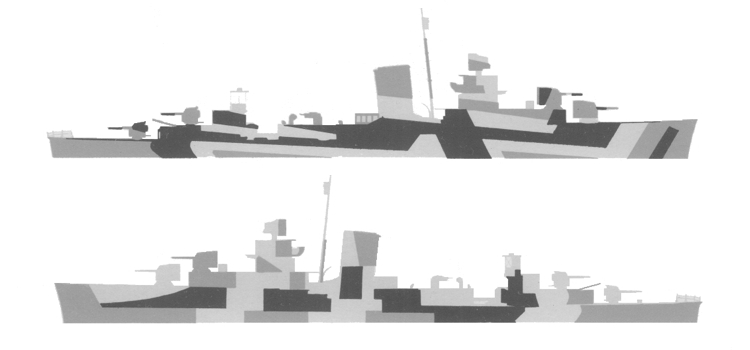
This is the earliest design drawing for Design 3D drawn for the Gridley class destroyers included with the March 1943 release of SHIPS-2. It used a light range of Measure 32 colors: navy blue (5-N), haze gray (5-H) and pale gray (5-P). This drawing established the signature for Design 3D: on the starboard bow there is the “anchor shadow” dark panel and the dark wedge-shaped panel on the port bow.
A Design 3D drawing was attached to the March 1943, SHIPS-2 for the DD-380 Gridley class of destroyers. Design 3D was also drawn for every other class of destroyers and destroyer escorts and for most other classes of major warships including the Independence class light carriers, the Casablanca class escort carriers, Omaha class light cruisers and Cleveland class light cruisers. The battleship USS Colorado (BB-45) also used Design 3D beginning in October 1943. A handful of ships of the Livermore class of destroyers and some destroyer escorts used a mirrored version in which the port pattern appeared on the starboard and the starboard pattern was painted on the port side. I have identified this as 3D rev (reversed) even though there seem to be no USN drawings that would depict this.
Original drawing source: March 1943 Supplement to SHIPS-2 Plate XXVI.
July 15, 1943 ? 3D in Measure 32 for DD-380

A design drawing for Measure 32/3D for the Gridley class destroyers was attached to the July 15, 1943, memo from BuShips to PacFleet, but has yet to be found. This may have been merely a reissue of the March drawing.
A Design 3D drawing was attached to the March 1943, SHIPS-2 for the DD-380 Gridley class of destroyers. Design 3D was also drawn for every other class of destroyers and destroyer escorts and for most other classes of major warships including the Independence class light carriers, the Casablanca class escort carriers, Omaha class light cruisers and Cleveland class light cruisers. The battleship USS Colorado (BB-45) also used Design 3D beginning in October 1943. A handful of ships of the Livermore class of destroyers and some destroyer escorts used a mirrored version in which the port pattern appeared on the starboard and the starboard pattern was painted on the port side. I have identified this as 3D rev (reversed) even though there seem to be no USN drawings that would depict this.
Original drawing source: NARA ?
July 1943 ? 3D in Measure 31 for BB-45
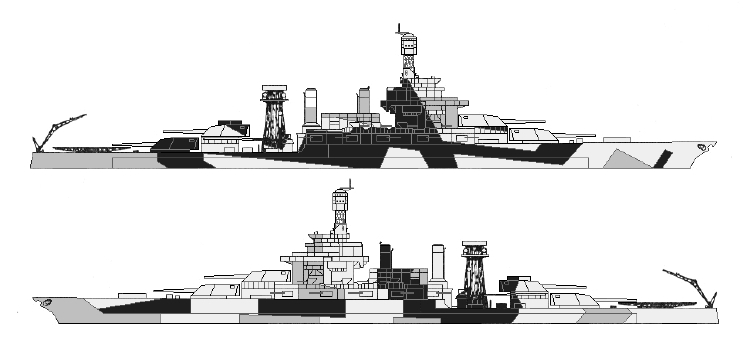
The design drawing for Measure 31/3D drawn probably about July 1943, for the battleship USS Colorado (BB-45) has not yet been found. Colorado was photographed in this camouflage as early as October 1943 at Pearl Harbor and later in April 1944; the above drawing was produced using those photos.
A Design 3D drawing was attached to the March 1943, SHIPS-2 for the DD-380 Gridley class of destroyers. Design 3D was also drawn for every other class of destroyers and destroyer escorts and for most other classes of major warships including the Independence class light carriers, the Casablanca class escort carriers, Omaha class light cruisers and Cleveland class light cruisers. The battleship USS Colorado (BB-45) also used Design 3D beginning in October 1943. A handful of ships of the Livermore class of destroyers and some destroyer escorts used a mirrored version in which the port pattern appeared on the starboard and the starboard pattern was painted on the port side. I have identified this as 3D rev (reversed) even though there seem to be no USN drawings that would depict this.
Original drawing source: NARA ?
August 1943 ? 3D in open Measure for DE-51
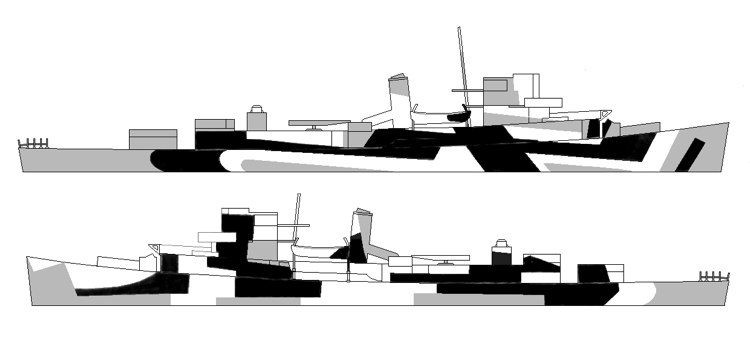
A silhouette of the design drawing for Measure 3_/3D drawn probably in August 1943, for the Buckley class of destroyer escorts.
A Design 3D drawing was attached to the March 1943, SHIPS-2 for the DD-380 Gridley class of destroyers. Design 3D was also drawn for every other class of destroyers and destroyer escorts and for most other classes of major warships including the Independence class light carriers, the Casablanca class escort carriers, Omaha class light cruisers and Cleveland class light cruisers. The battleship USS Colorado (BB-45) also used Design 3D beginning in October 1943. A handful of ships of the Livermore class of destroyers and some destroyer escorts used a mirrored version in which the port pattern appeared on the starboard and the starboard pattern was painted on the port side. I have identified this as 3D rev (reversed) even though there seem to be no USN drawings that would depict this.
Original drawing source: NARA 80-G-157407 and 80-G-157408.
October 1943 ? 3D in Measure 32 for BB-40
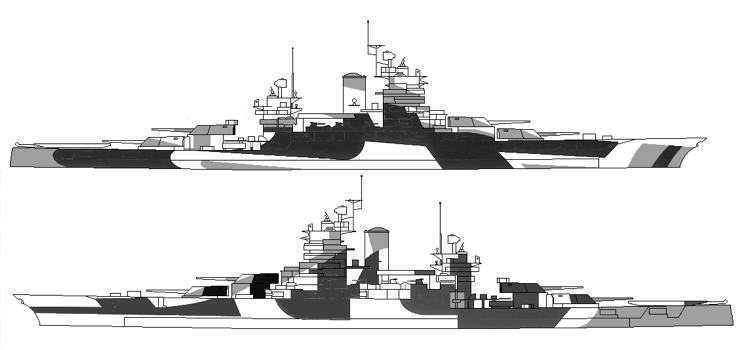
A silhouette of the design drawing for Measure 32/3D for New Mexico class battleships drawn probably in the fall of 1943, but probably never used.
A Design 3D drawing was attached to the March 1943, SHIPS-2 for the DD-380 Gridley class of destroyers. Design 3D was also drawn for every other class of destroyers and destroyer escorts and for most other classes of major warships including the Independence class light carriers, the Casablanca class escort carriers, Omaha class light cruisers and Cleveland class light cruisers. The battleship USS Colorado (BB-45) also used Design 3D beginning in October 1943. A handful of ships of the Livermore class of destroyers and some destroyer escorts used a mirrored version in which the port pattern appeared on the starboard and the starboard pattern was painted on the port side. I have identified this as 3D rev (reversed) even though there seem to be no USN drawings that would depict this.
Original drawing source: NARA 80-G-104915 and 80-G-104916.
October 1943 ? 3D in Measure 32 for DD-357

The silhouette for the design drawing for Measure 32/1D for the Porter class destroyers probably drawn in September or October 1943. The vertical colors were dull black (BK), ocean gray (5-O) and light gray (5-L) and haze gray (5-H) could have been used in place of light gray to be Measure 31.
A Design 3D drawing was attached to the March 1943, SHIPS-2 for the DD-380 Gridley class of destroyers. Design 3D was also drawn for every other class of destroyers and destroyer escorts and for most other classes of major warships including the Independence class light carriers, the Casablanca class escort carriers, Omaha class light cruisers and Cleveland class light cruisers. The battleship USS Colorado (BB-45) also used Design 3D beginning in October 1943. A handful of ships of the Livermore class of destroyers and some destroyer escorts used a mirrored version in which the port pattern appeared on the starboard and the starboard pattern was painted on the port side. I have identified this as 3D rev (reversed) even though there seem to be no USN drawings that would depict this.
Original drawing source: NARA 80-G-104909 and 80-G-104910.
December 23, 1943 3D in Measure 33 for CL-55
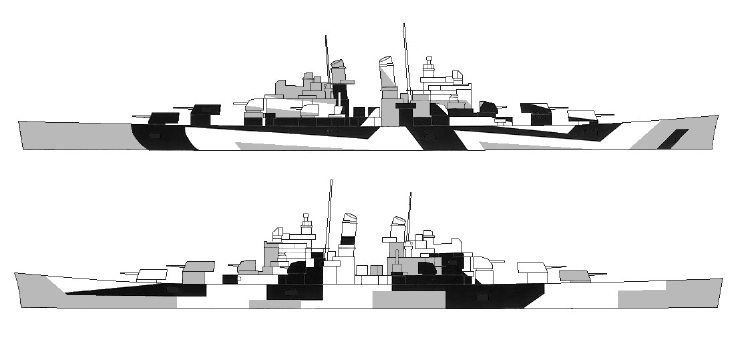
The design silhouette for Measure 33/3D for the Cleveland class light cruisers drawn on December, 23, 1943. The vertical colors were pale gray (5-P), haze gray (5-H) and navy blue (5-N) for Measure 33.
A Design 3D drawing was attached to the March 1943, SHIPS-2 for the DD-380 Gridley class of destroyers. Design 3D was also drawn for every other class of destroyers and destroyer escorts and for most other classes of major warships including the Independence class light carriers, the Casablanca class escort carriers, Omaha class light cruisers and Cleveland class light cruisers. The battleship USS Colorado (BB-45) also used Design 3D beginning in October 1943. A handful of ships of the Livermore class of destroyers and some destroyer escorts used a mirrored version in which the port pattern appeared on the starboard and the starboard pattern was painted on the port side. I have identified this as 3D rev (reversed) even though there seem to be no USN drawings that would depict this.
Original drawing source: NARA 80-G-109713 and 80-G-109714.
December 1943 ? 3D in Measure 32 for BB-38
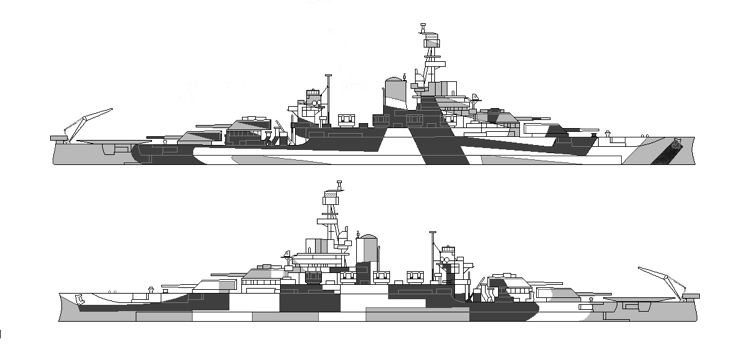
A silhouette of the design drawing for Measure 32/3D for USS Pennsylvania (BB-38) drawn probably in late 1943, but probably never used.
A Design 3D drawing was attached to the March 1943, SHIPS-2 for the DD-380 Gridley class of destroyers. Design 3D was also drawn for every other class of destroyers and destroyer escorts and for most other classes of major warships including the Independence class light carriers, the Casablanca class escort carriers, Omaha class light cruisers and Cleveland class light cruisers. The battleship USS Colorado (BB-45) also used Design 3D beginning in October 1943. A handful of ships of the Livermore class of destroyers and some destroyer escorts used a mirrored version in which the port pattern appeared on the starboard and the starboard pattern was painted on the port side. I have identified this as 3D rev (reversed) even though there seem to be no USN drawings that would depict this.
Original drawing source: NARA 80-G-157915 and 80-G-157916.
January 1944 ? 3D in Open Measure for CL-4
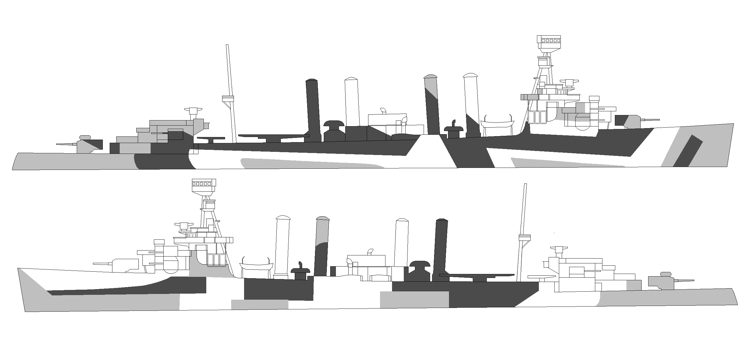
This is the silhouette of the design drawing for Measure 3_/3D drawn for the Omaha class light cruisers probably in January 1944.
A Design 3D drawing was attached to the March 1943, SHIPS-2 for the DD-380 Gridley class of destroyers. Design 3D was also drawn for every other class of destroyers and destroyer escorts and for most other classes of major warships including the Independence class light carriers, the Casablanca class escort carriers, Omaha class light cruisers and Cleveland class light cruisers. The battleship USS Colorado (BB-45) also used Design 3D beginning in October 1943. A handful of ships of the Livermore class of destroyers and some destroyer escorts used a mirrored version in which the port pattern appeared on the starboard and the starboard pattern was painted on the port side. I have identified this as 3D rev (reversed) even though there seem to be no USN drawings that would depict this.
Original drawing source: NARA 80-G-157919 and 80-G-157920.
January 1944 ? 3D in Open Measure for DD-445
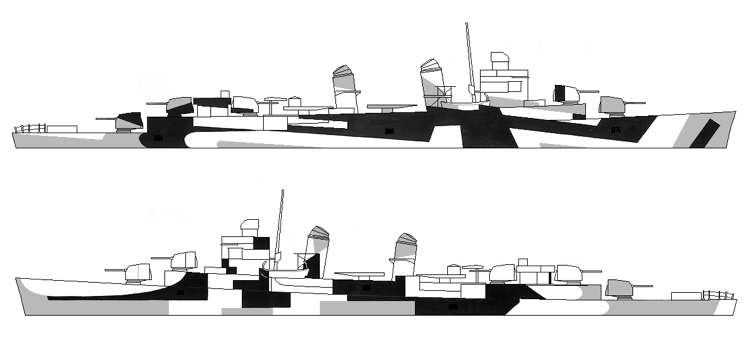
The design drawing silhouette for Measure 3_/3D for the Fletcher class destroyers drawn probably in January 1944, but possibly earlier.
A Design 3D drawing was attached to the March 1943, SHIPS-2 for the DD-380 Gridley class of destroyers. Design 3D was also drawn for every other class of destroyers and destroyer escorts and for most other classes of major warships including the Independence class light carriers, the Casablanca class escort carriers, Omaha class light cruisers and Cleveland class light cruisers. The battleship USS Colorado (BB-45) also used Design 3D beginning in October 1943. A handful of ships of the Livermore class of destroyers and some destroyer escorts used a mirrored version in which the port pattern appeared on the starboard and the starboard pattern was painted on the port side. I have identified this as 3D rev (reversed) even though there seem to be no USN drawings that would depict this.
Original drawing source: NARA 80-G-158591 and 80-G-158592.
January 8, 1944 3D in Measure 32 for DE-445
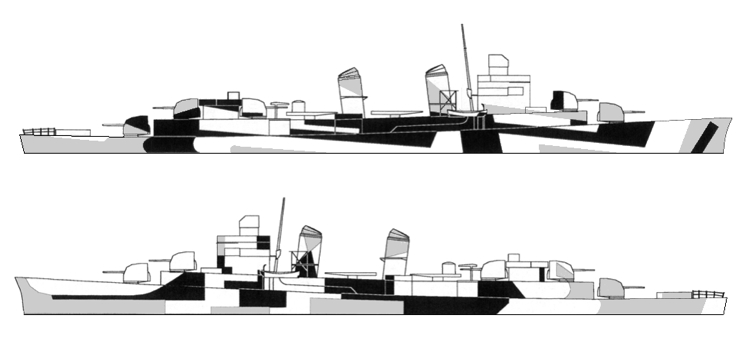
This is a silhouette of the original 32/3D drawings for the Fletcher class destroyers. The original drawings were produced on January 8, 1944. The three colors shown are Measure 32: dull black (BK) ocean gray (5-O) and light gray (5-L).
A Design 3D drawing was attached to the March 1943, SHIPS-2 for the DD-380 Gridley class of destroyers. Design 3D was also drawn for every other class of destroyers and destroyer escorts and for most other classes of major warships including the Independence class light carriers, the Casablanca class escort carriers, Omaha class light cruisers and Cleveland class light cruisers. The battleship USS Colorado (BB-45) also used Design 3D beginning in October 1943. A handful of ships of the Livermore class of destroyers and some destroyer escorts used a mirrored version in which the port pattern appeared on the starboard and the starboard pattern was painted on the port side. I have identified this as 3D rev (reversed) even though there seem to be no USN drawings that would depict this.
Original drawing source: FloatingDrydock.
January 11, 1944 3D in Measure 32 for APA-33
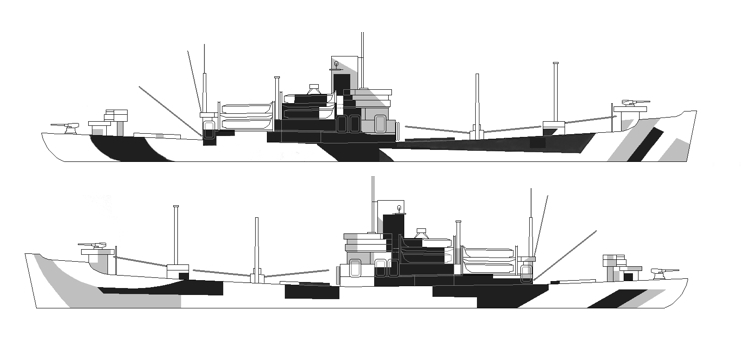
This is a silhouette of the original 32/3D drawings for the Bayfield class attack transports dated January 11, 1944. The three Measure 32 colors shown are: dull black (BK) ocean gray (5-O) and light gray (5-L). The starboard “anchor shadow” has been changed and the portside stern panel modified.
A Design 3D drawing was attached to the March 1943, SHIPS-2 for the DD-380 Gridley class of destroyers. Design 3D was also drawn for every other class of destroyers and destroyer escorts and for most other classes of major warships including the Independence class light carriers, the Casablanca class escort carriers, Omaha class light cruisers and Cleveland class light cruisers. The battleship USS Colorado (BB-45) also used Design 3D beginning in October 1943. A handful of ships of the Livermore class of destroyers and some destroyer escorts used a mirrored version in which the port pattern appeared on the starboard and the starboard pattern was painted on the port side. I have identified this as 3D rev (reversed) even though there seem to be no USN drawings that would depict this.
Original drawing source: NARA 80-G-164288 and 80-G-164289.
January 25, 1944 3D in Measure 31 for DE-5
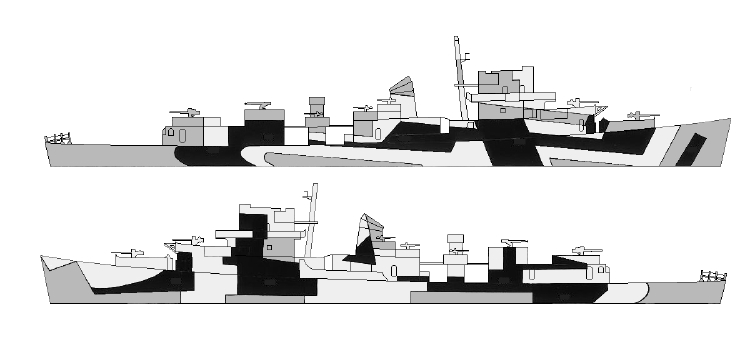
A silhouette of the original 31/3D drawings for the Evarts class destroyer escorts dated January 25, 1944. The three Measure 31 colors specified were: dull black (BK) ocean gray (5-O) and haze gray (5-H). Ships assigned to the Atlantic used Measure 32 dull black, ocean gray and light gray (5-L).
A Design 3D drawing was attached to the March 1943, SHIPS-2 for the DD-380 Gridley class of destroyers. Design 3D was also drawn for every other class of destroyers and destroyer escorts and for most other classes of major warships including the Independence class light carriers, the Casablanca class escort carriers, Omaha class light cruisers and Cleveland class light cruisers. The battleship USS Colorado (BB-45) also used Design 3D beginning in October 1943. A handful of ships of the Livermore class of destroyers and some destroyer escorts used a mirrored version in which the port pattern appeared on the starboard and the starboard pattern was painted on the port side. I have identified this as 3D rev (reversed) even though there seem to be no USN drawings that would depict this.
Original drawing source: NARA 80-G-105504 and 80-G-105504.
January 26, 1944 3D in Measure 33 for CVL-22
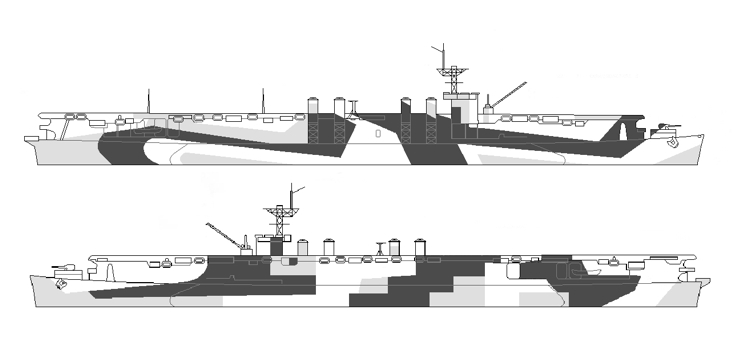
The original Design 3D drawings for the Independence class light carriers were dated January 26, 1944 and used Measure 33. The three vertical colors specified were: navy blue (5-N) haze gray (5-H) and pale gray (5-P). The “anchor shadow” has disappeared.
A Design 3D drawing was attached to the March 1943, SHIPS-2 for the DD-380 Gridley class of destroyers. Design 3D was also drawn for every other class of destroyers and destroyer escorts and for most other classes of major warships including the Independence class light carriers, the Casablanca class escort carriers, Omaha class light cruisers and Cleveland class light cruisers. The battleship USS Colorado (BB-45) also used Design 3D beginning in October 1943. A handful of ships of the Livermore class of destroyers and some destroyer escorts used a mirrored version in which the port pattern appeared on the starboard and the starboard pattern was painted on the port side. I have identified this as 3D rev (reversed) even though there seem to be no USN drawings that would depict this.
Original drawing source: NARA 80-G-165767 and 80-G-165768.
January 27, 1944 3D in Measure 32 for APA-1
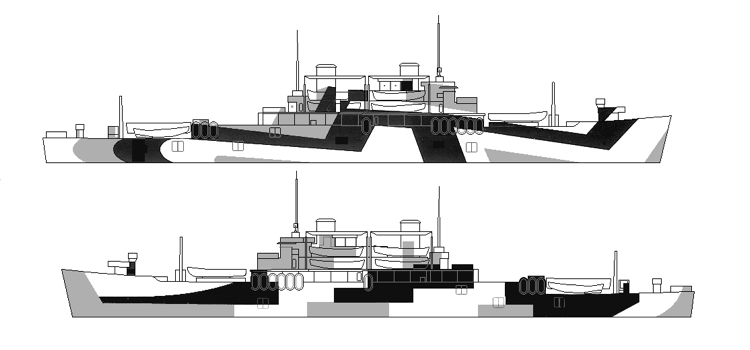
A silhouette of the original Design 3D drawing for the Doyen class attack transports dated January 27, 1944. The Measure 32 vertical colors specified were: dull black (BK) ocean gray (5-O) and light gray (5-L). The “anchor shadow” is gone again.
A Design 3D drawing was attached to the March 1943, SHIPS-2 for the DD-380 Gridley class of destroyers. Design 3D was also drawn for every other class of destroyers and destroyer escorts and for most other classes of major warships including the Independence class light carriers, the Casablanca class escort carriers, Omaha class light cruisers and Cleveland class light cruisers. The battleship USS Colorado (BB-45) also used Design 3D beginning in October 1943. A handful of ships of the Livermore class of destroyers and some destroyer escorts used a mirrored version in which the port pattern appeared on the starboard and the starboard pattern was painted on the port side. I have identified this as 3D rev (reversed) even though there seem to be no USN drawings that would depict this.
Original drawing source: NARA 80-G-170037 and 80-G-170038.
February 17, 1944 3D in Measure 32 for AOG-1
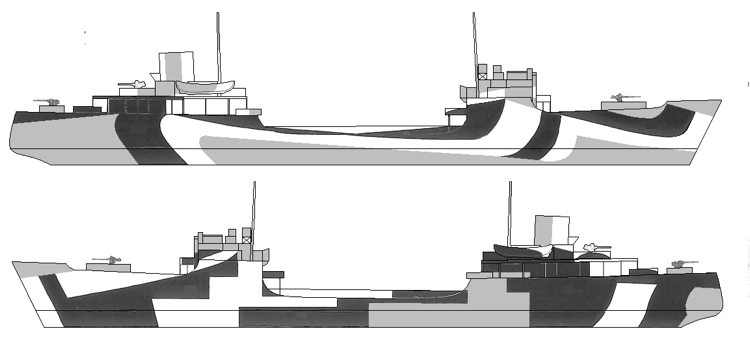
The silhouette from the original Measure 32 Design 3D drawing for the Patapsco class gasoline tankers dated Feruary 17, 1944. The vertical colors specified were: dull black (BK) ocean gray (5-O) and light gray (5-L). The pattern has been modified to fit this profile and to match the smaller size of this ship.
A Design 3D drawing was attached to the March 1943, SHIPS-2 for the DD-380 Gridley class of destroyers. Design 3D was also drawn for every other class of destroyers and destroyer escorts and for most other classes of major warships including the Independence class light carriers, the Casablanca class escort carriers, Omaha class light cruisers and Cleveland class light cruisers. The battleship USS Colorado (BB-45) also used Design 3D beginning in October 1943. A handful of ships of the Livermore class of destroyers and some destroyer escorts used a mirrored version in which the port pattern appeared on the starboard and the starboard pattern was painted on the port side. I have identified this as 3D rev (reversed) even though there seem to be no USN drawings that would depict this.
Original drawing source: NARA 80-G-174541 and 80-G-174542.
February 25, 1944 3D in Measure 31 for PG-50
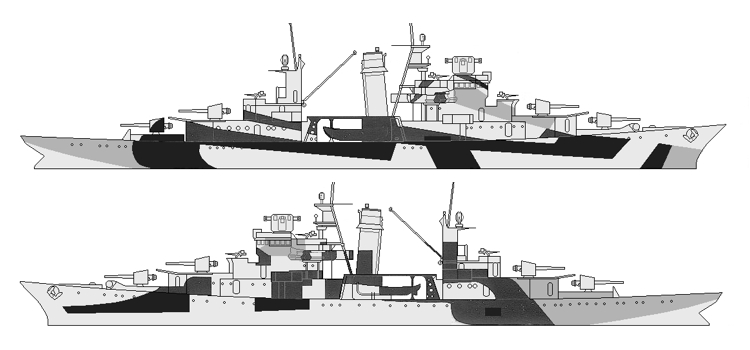
The silhouette of the Measure 31 Design 3D drawing for the Erie class patrol gunboats dated February 17, 1944. The vertical colors specified were: dull black (BK) ocean gray (5-O) and haze gray (5-H). The pattern has been modified slightly.
A Design 3D drawing was attached to the March 1943, SHIPS-2 for the DD-380 Gridley class of destroyers. Design 3D was also drawn for every other class of destroyers and destroyer escorts and for most other classes of major warships including the Independence class light carriers, the Casablanca class escort carriers, Omaha class light cruisers and Cleveland class light cruisers. The battleship USS Colorado (BB-45) also used Design 3D beginning in October 1943. A handful of ships of the Livermore class of destroyers and some destroyer escorts used a mirrored version in which the port pattern appeared on the starboard and the starboard pattern was painted on the port side. I have identified this as 3D rev (reversed) even though there seem to be no USN drawings that would depict this.
Original drawing source: NARA 80-G-166238 and 80-G-166239.
February 29, 1944 3D in Measure 32 for DD-692
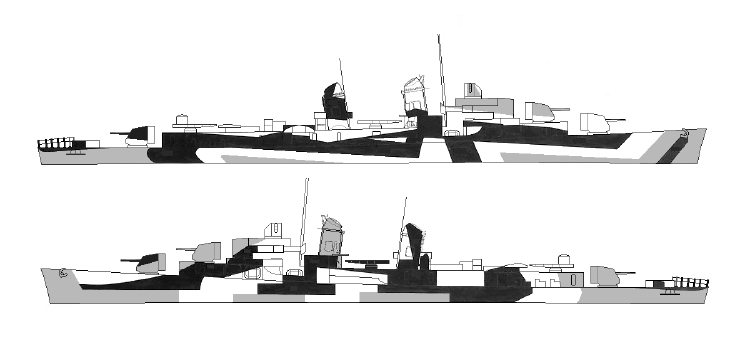
The silhouette of the 32/3D drawing for the Allen M. Sumner class destroyers dated February 29, 1944. The vertical colors specified were: dull black (BK) ocean gray (5-O) and light gray (5-L). The pattern is mostly standard Design 3D.
A Design 3D drawing was attached to the March 1943, SHIPS-2 for the DD-380 Gridley class of destroyers. Design 3D was also drawn for every other class of destroyers and destroyer escorts and for most other classes of major warships including the Independence class light carriers, the Casablanca class escort carriers, Omaha class light cruisers and Cleveland class light cruisers. The battleship USS Colorado (BB-45) also used Design 3D beginning in October 1943. A handful of ships of the Livermore class of destroyers and some destroyer escorts used a mirrored version in which the port pattern appeared on the starboard and the starboard pattern was painted on the port side. I have identified this as 3D rev (reversed) even though there seem to be no USN drawings that would depict this.
Original drawing source: NARA 80-G-109623 and 80-G-109624.
March 18, 1944 3D in Measure 32 for DD-421
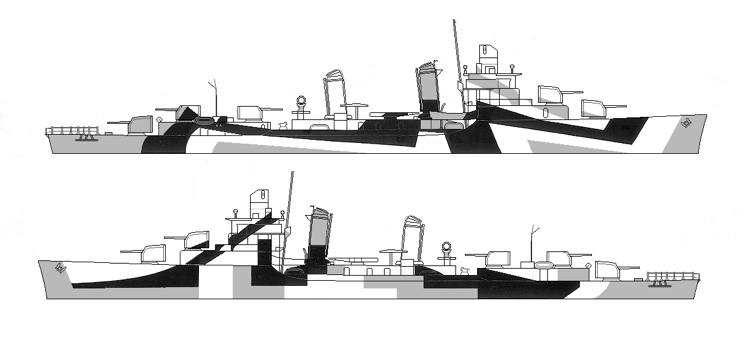
The silhouette of the Design 3D drawing for the Benson class destroyers dated March 18, 1944. The vertical colors specified were Measure 32: dull black (BK) ocean gray (5-O) and light gray (5-L). This version has lost the signature “anchor shadow” on the starboard bow.
A Design 3D drawing was attached to the March 1943, SHIPS-2 for the DD-380 Gridley class of destroyers. Design 3D was also drawn for every other class of destroyers and destroyer escorts and for most other classes of major warships including the Independence class light carriers, the Casablanca class escort carriers, Omaha class light cruisers and Cleveland class light cruisers. The battleship USS Colorado (BB-45) also used Design 3D beginning in October 1943. A handful of ships of the Livermore class of destroyers and some destroyer escorts used a mirrored version in which the port pattern appeared on the starboard and the starboard pattern was painted on the port side. I have identified this as 3D rev (reversed) even though there seem to be no USN drawings that would depict this.
Original drawing source: NARA 80-G-170950 and 80-G-170951.
April 13 1944 3D in Measure 33 for CVE-55
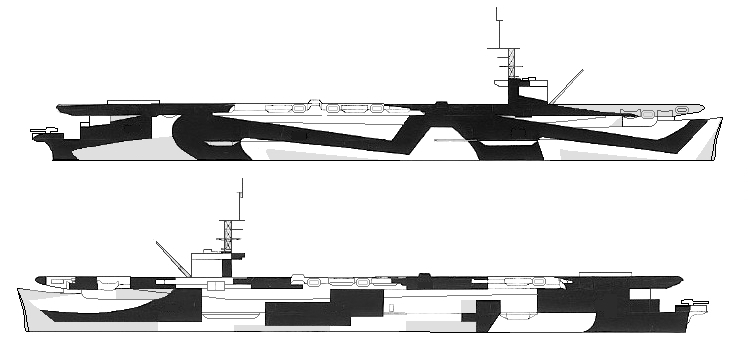
This is a silhouette from the drawing for Measure 33 Design 3D for the Casablanca class escort carriers dated April 13, 1944. The vertical colors were specified to be navy blue (5-N), haze gray (5-H) and pale gray (5-P). This version also does not have the signature “anchor shadow” on the starboard bow.
A Design 3D drawing was attached to the March 1943, SHIPS-2 for the DD-380 Gridley class of destroyers. Design 3D was also drawn for every other class of destroyers and destroyer escorts and for most other classes of major warships including the Independence class light carriers, the Casablanca class escort carriers, Omaha class light cruisers and Cleveland class light cruisers. The battleship USS Colorado (BB-45) also used Design 3D beginning in October 1943. A handful of ships of the Livermore class of destroyers and some destroyer escorts used a mirrored version in which the port pattern appeared on the starboard and the starboard pattern was painted on the port side. I have identified this as 3D rev (reversed) even though there seem to be no USN drawings that would depict this.
Original drawing source: NARA 80-G-109711 and 80-G-109712.
May 1944 ? 3D in Measure 32 for DE-51
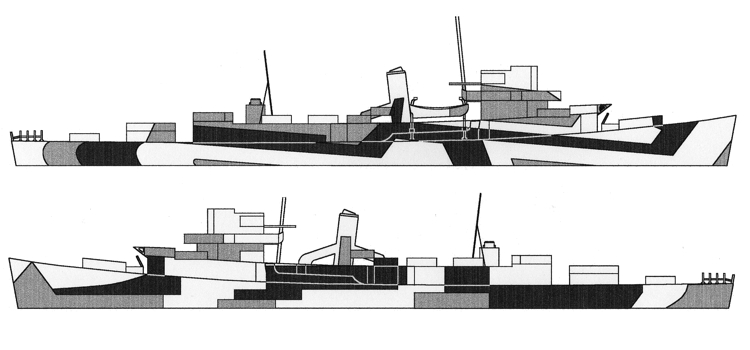
This is a silhouette of the possible drawing for Measure 32 Design 3D for the Buckley class destroyer escorts possibly drawn in May 1944. Destroyer escorts of the Atlantic Fleet began appearing in this camouflage in early June and the drawing uses the profile of the typical Atlantic based ships that used this version. The vertical colors probably were dull black (BK), ocean gray (5-O) and light gray (5-L). Note, this version does not have the signature “anchor shadow” on the starboard bow and the pattern wraps around the bow. Also, there are differences between this version and the earlier version for the Buckleys in the superstructure area.
A Design 3D drawing was attached to the March 1943, SHIPS-2 for the DD-380 Gridley class of destroyers. Design 3D was also drawn for every other class of destroyers and destroyer escorts and for most other classes of major warships including the Independence class light carriers, the Casablanca class escort carriers, Omaha class light cruisers and Cleveland class light cruisers. The battleship USS Colorado (BB-45) also used Design 3D beginning in October 1943. A handful of ships of the Livermore class of destroyers and some destroyer escorts used a mirrored version in which the port pattern appeared on the starboard and the starboard pattern was painted on the port side. I have identified this as 3D rev (reversed) even though there seem to be no USN drawings that would depict this.
Original drawing source: Has not yet been found.
June 2, 1944 3D in Measure 31 for DE-339
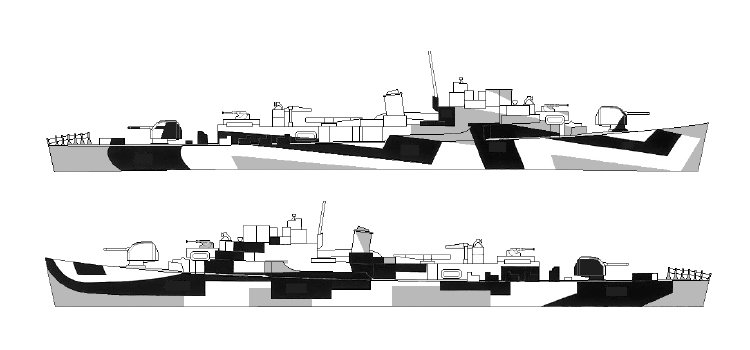
This is a silhouette from the drawings for 31/3D for the John C. Butler class destroyer escorts dated June 2, 1944. The Measure 31 colors were the standard: dull black (BK), ocean gray (5-O) and haze gray (5-H). Notice there is no “anchor shadow” on the starboard bow and the port bow black panel is extended into a “ramp”.
A Design 3D drawing was attached to the March 1943, SHIPS-2 for the DD-380 Gridley class of destroyers. Design 3D was also drawn for every other class of destroyers and destroyer escorts and for most other classes of major warships including the Independence class light carriers, the Casablanca class escort carriers, Omaha class light cruisers and Cleveland class light cruisers. The battleship USS Colorado (BB-45) also used Design 3D beginning in October 1943. A handful of ships of the Livermore class of destroyers and some destroyer escorts used a mirrored version in which the port pattern appeared on the starboard and the starboard pattern was painted on the port side. I have identified this as 3D rev (reversed) even though there seem to be no USN drawings that would depict this.
Original drawing source: NARA 80-G-172880 and 80-G-172881.
June 5, 1944 3D in Measure 31 for DD-423
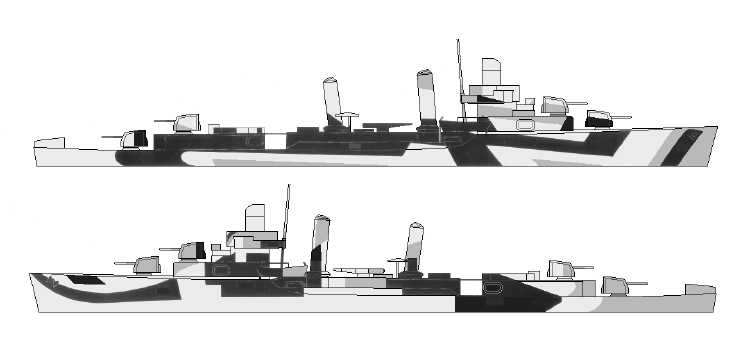
A silhouette of the drawing for Measure 31 Design 3D for the Gleaves (DD-423) sub-class of the Benson class dated June 5, 1944. The vertical colors were specified to be dull black (BK), ocean gray (5-O) and haze gray (5-H). Light gray (5-L) could have been used in place of haze gray to be Measure 32. Note, the port bow black panel has been extended to a “ramp” and the “anchor shadow” has returned.
A Design 3D drawing was attached to the March 1943, SHIPS-2 for the DD-380 Gridley class of destroyers. Design 3D was also drawn for every other class of destroyers and destroyer escorts and for most other classes of major warships including the Independence class light carriers, the Casablanca class escort carriers, Omaha class light cruisers and Cleveland class light cruisers. The battleship USS Colorado (BB-45) also used Design 3D beginning in October 1943. A handful of ships of the Livermore class of destroyers and some destroyer escorts used a mirrored version in which the port pattern appeared on the starboard and the starboard pattern was painted on the port side. I have identified this as 3D rev (reversed) even though there seem to be no USN drawings that would depict this.
Original drawing source: NARA 80-G-172884 and 80-G-172885.
June 29, 1944 3D in Measure 32 for DD-356
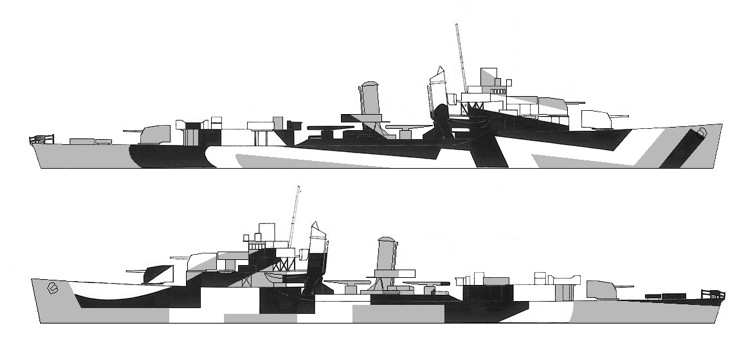
This is the silhouette for Design 3D drawn for the Porter class destroyers on June 29, 1944. The vertical colors were Measure 32: dull black (BK), ocean gray (5-O) and light gray (5-L). Haze gray (5-H) could have been used in place of light gray to be Measure 31. This version of Design 3D is pretty standard.
A Design 3D drawing was attached to the March 1943, SHIPS-2 for the DD-380 Gridley class of destroyers. Design 3D was also drawn for every other class of destroyers and destroyer escorts and for most other classes of major warships including the Independence class light carriers, the Casablanca class escort carriers, Omaha class light cruisers and Cleveland class light cruisers. The battleship USS Colorado (BB-45) also used Design 3D beginning in October 1943. A handful of ships of the Livermore class of destroyers and some destroyer escorts used a mirrored version in which the port pattern appeared on the starboard and the starboard pattern was painted on the port side. I have identified this as 3D rev (reversed) even though there seem to be no USN drawings that would depict this.
Original drawing source: NARA 80-G-174779 and 80-G-174780.
July 4, 1944 3D in Measure 32 for DD-409
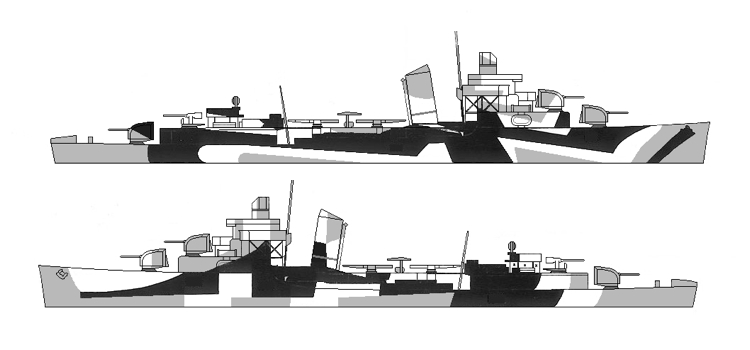
This is the silhouette for the drawing for Measure 32 Design 3D for the Sims class destroyers dated July 4, 1944. The vertical colors were specified to be dull black (BK), ocean gray (5-O) and light gray (5-L). Haze gray (5-H) could have been used in place of light gray to be Measure 31. This version is close to the standard 3D pattern except for the increased slant of the “anchor shadow”.
A Design 3D drawing was attached to the March 1943, SHIPS-2 for the DD-380 Gridley class of destroyers. Design 3D was also drawn for every other class of destroyers and destroyer escorts and for most other classes of major warships including the Independence class light carriers, the Casablanca class escort carriers, Omaha class light cruisers and Cleveland class light cruisers. The battleship USS Colorado (BB-45) also used Design 3D beginning in October 1943. A handful of ships of the Livermore class of destroyers and some destroyer escorts used a mirrored version in which the port pattern appeared on the starboard and the starboard pattern was painted on the port side. I have identified this as 3D rev (reversed) even though there seem to be no USN drawings that would depict this.
Original drawing source: NARA 80-G-174777 and 80-G-174778.
July 26, 1944 3D in Measure 32 for four-stack DDs (1200 ton)
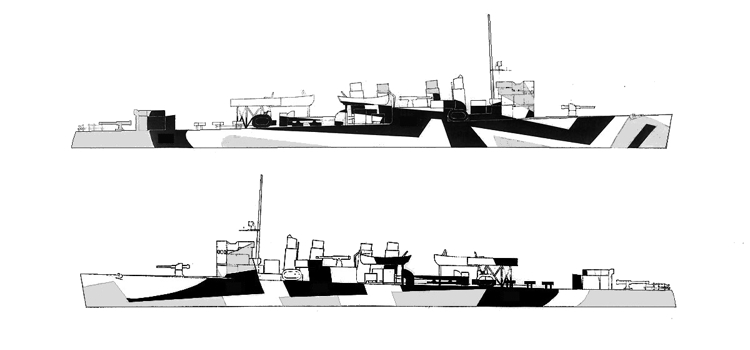
This is the silhouette for the drawing for Design 3D for four-stack destroyer classes (labeled 1200 ton DD) with Measure 32 colors dated July 26, 1944. The vertical colors were specified to be dull black (BK), ocean gray (5-O) and light gray (5-L). This version is close to the standard 3D pattern.
A Design 3D drawing was attached to the March 1943, SHIPS-2 for the DD-380 Gridley class of destroyers. Design 3D was also drawn for every other class of destroyers and destroyer escorts and for most other classes of major warships including the Independence class light carriers, the Casablanca class escort carriers, Omaha class light cruisers and Cleveland class light cruisers. The battleship USS Colorado (BB-45) also used Design 3D beginning in October 1943. A handful of ships of the Livermore class of destroyers and some destroyer escorts used a mirrored version in which the port pattern appeared on the starboard and the starboard pattern was painted on the port side. I have identified this as 3D rev (reversed) even though there seem to be no USN drawings that would depict this.
Original drawing source: NARA 80-G-177465 and 80-G-177466.
August 9, 1944 3D in Measure 32 for DD-364
This is the silhouette for the drawing for Measure 32 Design 3D for the Mahan class destroyers as dated August 9, 1944. The vertical colors were specified to be navy blue (5-N), ocean gray (5-O), haze gray (5-H) and light gray (5-L). This version has returned to the “ramp” panel on port and many panels on both port and starboard have been modified.
A Design 3D drawing was attached to the March 1943, SHIPS-2 for the DD-380 Gridley class of destroyers. Design 3D was also drawn for every other class of destroyers and destroyer escorts and for most other classes of major warships including the Independence class light carriers, the Casablanca class escort carriers, Omaha class light cruisers and Cleveland class light cruisers. The battleship USS Colorado (BB-45) also used Design 3D beginning in October 1943. A handful of ships of the Livermore class of destroyers and some destroyer escorts used a mirrored version in which the port pattern appeared on the starboard and the starboard pattern was painted on the port side. I have identified this as 3D rev (reversed) even though there seem to be no USN drawings that would depict this.
Original drawing source: NARA 80-G-176509 and 80-G-176510.
September 1, 1944 3D (ex) in Measure 32 & 33 for DE-5
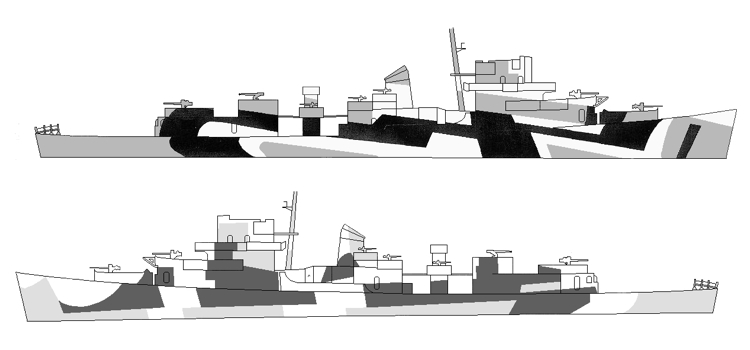
This is the silhouette for the 32-33/3D (ex) drawings for the Evarts class destroyer escorts dated September 1, 1944, the “ex” was for experimental. The vertical colors were specified to be: dull black (BK), ocean gray (5-O) and light gray (5-L), on the starboard side for Measure 32 and navy blue (5-N), haze gray (5-H) and pale gray (5-P) for Measure 33 on the port. These drawings were produced for the camouflage tests that were to be performed in October 1944, but were not used.
A Design 3D drawing was attached to the March 1943, SHIPS-2 for the DD-380 Gridley class of destroyers. Design 3D was also drawn for every other class of destroyers and destroyer escorts and for most other classes of major warships including the Independence class light carriers, the Casablanca class escort carriers, Omaha class light cruisers and Cleveland class light cruisers. The battleship USS Colorado (BB-45) also used Design 3D beginning in October 1943. A handful of ships of the Livermore class of destroyers and some destroyer escorts used a mirrored version in which the port pattern appeared on the starboard and the starboard pattern was painted on the port side. I have identified this as 3D rev (reversed) even though there seem to be no USN drawings that would depict this.
Original drawing source: NARA 19-N-104913 and 19-N-104914.
September 4, 1944 3D (ex) in Measure 32 & 33 for DE-339
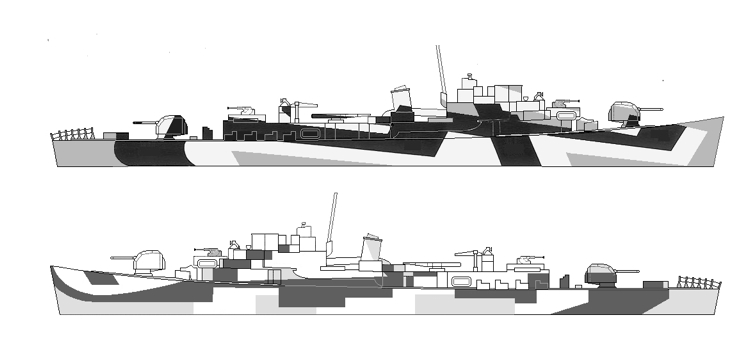
This is the silhouette for the drawings for the John C. Butler class of destroyer escorts showing the experimental version of Design 3D with Measure 32 colors on starboard and Measure 33 colors on port dated September 4, 1944, These drawings were produced for the camouflage tests that were to be performed in October 1944.
A Design 3D drawing was attached to the March 1943, SHIPS-2 for the DD-380 Gridley class of destroyers. Design 3D was also drawn for every other class of destroyers and destroyer escorts and for most other classes of major warships including the Independence class light carriers, the Casablanca class escort carriers, Omaha class light cruisers and Cleveland class light cruisers. The battleship USS Colorado (BB-45) also used Design 3D beginning in October 1943. A handful of ships of the Livermore class of destroyers and some destroyer escorts used a mirrored version in which the port pattern appeared on the starboard and the starboard pattern was painted on the port side. I have identified this as 3D rev (reversed) even though there seem to be no USN drawings that would depict this.
Original drawing source: NARA 19-N-104901 and 19-N-104902.
September 7, 1944 3D (ex) in Measure 32 & 33 for DE-51
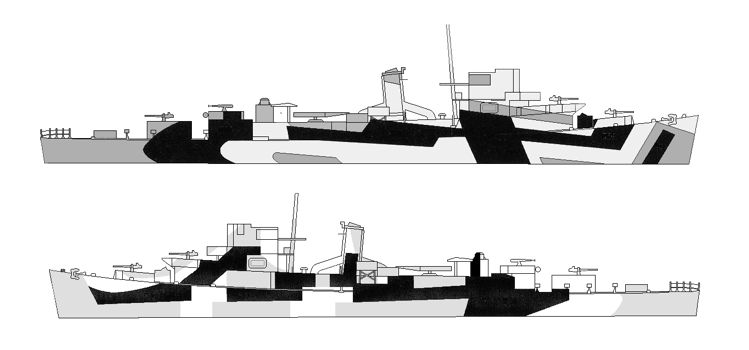
This is the silhouette from the Measure 32 and Measure 33/3D(ex) drawings for the Buckley class destroyer escorts dated September 7, 1944, where the “ex” indicated an experimental design. The vertical colors were specified to be: dull black (BK), ocean gray (5-O) and light gray (5-L), on the starboard side for Measure 32. The port side used the Measure 33 vertical colors of navy gray (5-N), haze gray (5-H) and pale gray (5-P). These drawings were produced for the camouflage tests that were to be performed in October 1944.
A Design 3D drawing was attached to the March 1943, SHIPS-2 for the DD-380 Gridley class of destroyers. Design 3D was also drawn for every other class of destroyers and destroyer escorts and for most other classes of major warships including the Independence class light carriers, the Casablanca class escort carriers, Omaha class light cruisers and Cleveland class light cruisers. The battleship USS Colorado (BB-45) also used Design 3D beginning in October 1943. A handful of ships of the Livermore class of destroyers and some destroyer escorts used a mirrored version in which the port pattern appeared on the starboard and the starboard pattern was painted on the port side. I have identified this as 3D rev (reversed) even though there seem to be no USN drawings that would depict this.
Original drawing source: NARA 19-N-104889 and 19-N-104890.
November 3, 1944 3Da in Measure 32 for DE-339
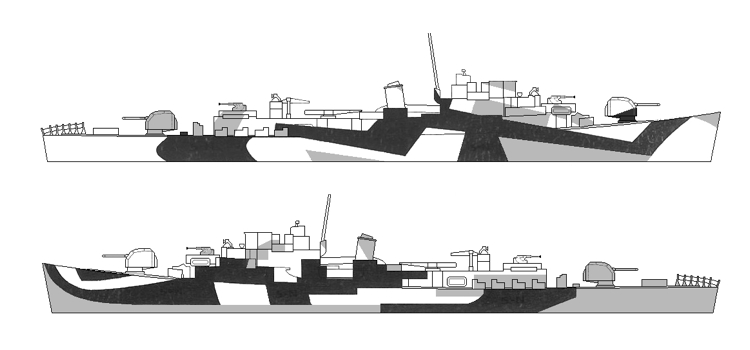
This is the silhouette from the Measure 32 Design 3Da drawings for the John C. Butler class destroyer escorts dated November 3, 1944, where the a probably indicated a modified design. The vertical colors were specified to be: navy blue (5-N), ocean gray (5-O) and light gray (5-L) for Measure 32. The changes to the pattern are not as drastic as those for DD-364 in August.
A Design 3D drawing was attached to the March 1943, SHIPS-2 for the DD-380 Gridley class of destroyers. Design 3D was also drawn for every other class of destroyers and destroyer escorts and for most other classes of major warships including the Independence class light carriers, the Casablanca class escort carriers, Omaha class light cruisers and Cleveland class light cruisers. The battleship USS Colorado (BB-45) also used Design 3D beginning in October 1943. A handful of ships of the Livermore class of destroyers and some destroyer escorts used a mirrored version in which the port pattern appeared on the starboard and the starboard pattern was painted on the port side. I have identified this as 3D rev (reversed) even though there seem to be no USN drawings that would depict this.
Original drawing source: NARA 19-N-104903 and 19-N-104904.
November 18, 1944 3Db in Measure 32 for DE-51

This is the silhouette from the Measure 32 Design 3Db drawings for the Buckley class destroyer escorts dated November 18, 1944, where the b probably indicated a second modification to the design. The vertical colors were specified to be: navy blue (5-N), ocean gray (5-O) and light gray (5-L) for Measure 32. The changes to the pattern are a little more than those for the previous 3Da.
A Design 3D drawing was attached to the March 1943, SHIPS-2 for the DD-380 Gridley class of destroyers. Design 3D was also drawn for every other class of destroyers and destroyer escorts and for most other classes of major warships including the Independence class light carriers, the Casablanca class escort carriers, Omaha class light cruisers and Cleveland class light cruisers. The battleship USS Colorado (BB-45) also used Design 3D beginning in October 1943. A handful of ships of the Livermore class of destroyers and some destroyer escorts used a mirrored version in which the port pattern appeared on the starboard and the starboard pattern was painted on the port side. I have identified this as 3D rev (reversed) even though there seem to be no USN drawings that would depict this.
Original drawing source: NARA 19-N-100386 and 19-N-100387.
3F Designs
March 1943 3F in Measure 32 for C-1A
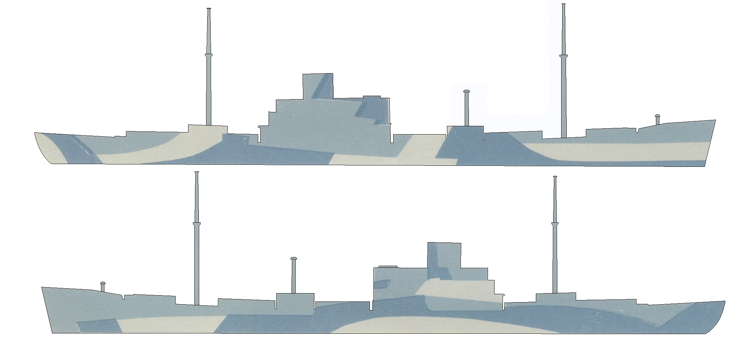
The silhouette from the design drawing for Measure 32/3F for a C-1A type cargo ship attached to the March 1943 supplement to SHIPS-2. The Measure 32 colors were ocean gray (5-O), light gray (5-L) and pale gray (5-P). Note, because of the lack of control in the color reproduction process, these colors may not be a true match to the actual colors.
No other drawings for Design 3F have been found.
Original drawing source: The March 1943 supplement to SHIPS-2 Plate XXX.3L Designs
March 1943 3L in Measure 31 for LCI(L)
 3L.jpg)
The silhouette from the drawing for Measure 31 Design 3L for LCI(L) and similar ships from the March 1943 release of SHIPS-2. The specified vertical colors were navy green (5-NG) oversprayed on ocean green (5-OG) with the same navy green oversprayed on ocean green on horizontal surfaces. Note, because of the lack of control in the color reproduction process, these colors may not be a true match to the actual colors.
There were two drawings of Design 3L in the March 1943 version of SHIPS-2: one for LCT's and one for LCI(L) as above.
Original drawing source: March 1943 version of SHIPS-2 plate XXXVIII.
3M Designs
June 16, 1944 3M in Measure 32 for AM-80
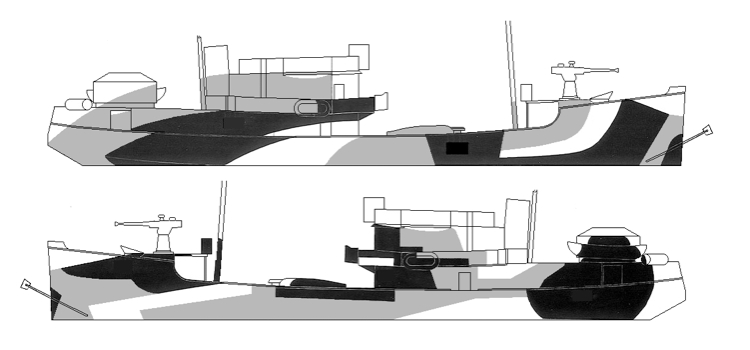
The silhouette from the drawing for Measure 32 Design 3M for the Goldcrest class minesweepers, that were modified trawlers, dated June 16, 1944. The vertical colors were specified to be dull black (BK), ocean gray (5-O) and light gray (5-L) and the horizontal color was deck blue (20-B).
No other drawings for Design 3M have been found.
Original drawing source: NARA 80-G-174535 and 80-G-174536.3P Designs
March 1943 3P in Measure 31 for APc's
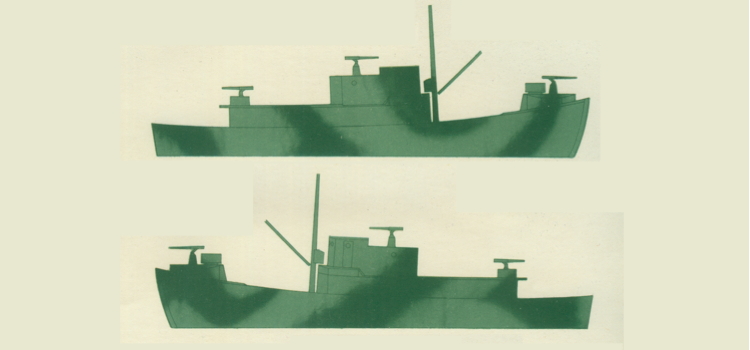
This is the silhouette from the drawing for Measure 31 Design 3P for coastal transports (APc) included with the March 1943 version of SHIPS-2. The specified vertical colors were navy green (5-NG) sprayed over ocean green (5-OG) with ocean green and deck green (20-G) on horizontal surfaces. Note, because of the color reproduction process these colors may not be an exact match to the originals.
This is the only drawing for Design 3P that has yet been found.
Original drawing source: NARA March 1943 Supplement to SHIPS-2 Plate XXXIV.
4A Designs
March 1943 4A in Measure 32 for CV-6
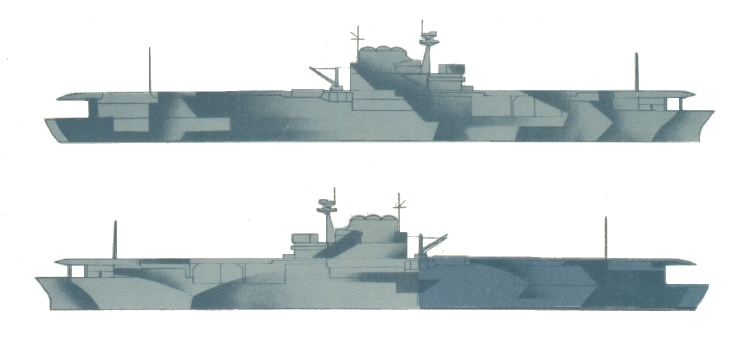
The design drawing for Design 4A that was drawn for the USS Enterprise (CV-6) in Measure 32 and was attached to the March 1943 Supplement to SHIPS-2. The vertical colors were specified to be haze gray (5-H) and ocean gray (5-O) with navy blue (5-N) over those with some edges sprayed and feathered while the horizontal color was deck blue (20-B).
The First drawing for Design 4A was as above for USS Enterprise (CV-6) in March 1943. An August 1943 memo from the Pacific Fleet to the Bureau of Ships recommended: “Soft, graded patterns should be avoided until expert supervision for application may be made available.” The 4A Design for CV-6 was redrawn and labeled 4Ab possibly because the design’s panels all had solid edges instead of the soft feathered edges of many panels of Design 4A. It is possible that the original Design 4A was modified to be 4Ab to comply with the PacFleet recommendation. Then on March 21, 1944, Design 4A was produced for the Bogue class of escort carriers and later on March 25, 1944, for the Casablanca class escort carriers and finally for the Charger class of escort carriers on May 8, 1944. Most of the escort carriers that wore Design 4A were in the Atlantic Fleet.
Original drawing source: March 1943 Supplement to SHIPS-2 Plate XXV.
March 21, 1944 4A in Measure 32 for CVE-9
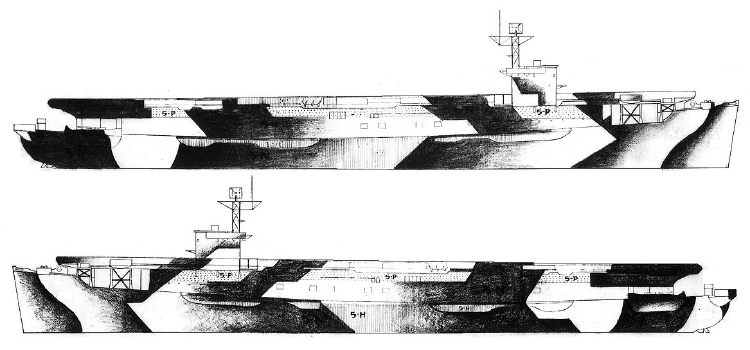
A silhouette from the Measure 32/4A drawing for the Bogue class escort carriers dated March 21, 1944. The vertical colors were specified to be navy blue (5-N), haze gray (5-H), light gray (5-L) and pale gray (5-P) as countershading. On this drawing this color combination is called Measure 32, but on some other drawings this combination might be Measure 33. Like other Design 4A drawings, some edges of the navy blue (5-N) were intended to “feather” or slowly blend into the lighter color. Feathering usually required using a sprayer and might only be done at a port facility.
The First drawing for Design 4A was for USS Enterprise (CV-6) in March 1943. The 4A Design for CV-6 was redrawn and labeled 4Ab possibly because the design’s panels all had solid edges instead of the soft feathered edges of many panels of Design 4A. Then on March 21, 1944, Design 4A was produced for the Bogue class of escort carriers and later on March 25, 1944, for the Casablanca class escort carriers and finally for the Charger class of escort carriers on May 8, 1944. Most of the escort carriers that wore Design 4A were in the Atlantic Fleet.
Original drawing source: NARA 80-G-172975 and 80-G-172976.
March 25, 1944 4A in Measure 32 for CVE-55
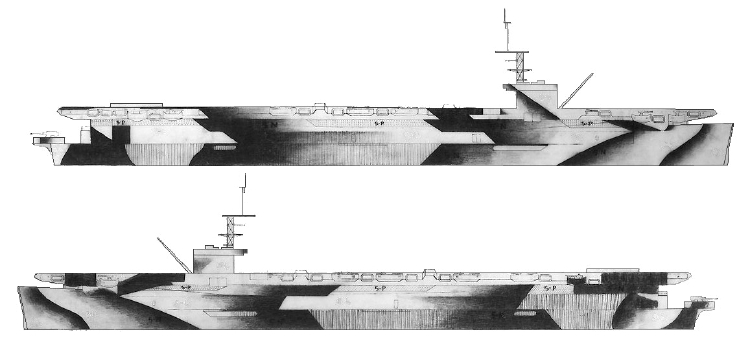
A silhouette of the design drawing for Measure 32/4A dated December 30, 1943, for the Casablanca class escort carriers. This version of 4A specified vertical colors to be navy blue (5-N), haze gray (5-H), light gray (5-L) and pale gray (5-P). This color combination is called Measure 32, but on some other drawings this combination might be labeled Measure 33. Like other Design 4A drawings, some edges of the dark color: navy blue (5-N) were intended to be “feathered” or slowly blended into the lighter color. Feathering usually required using a sprayer and might only be done at a port facility.
The First drawing for Design 4A was for USS Enterprise (CV-6) in March 1943. The 4A Design for CV-6 was redrawn and labeled 4Ab possibly because the design’s panels all had solid edges instead of the soft feathered edges of many panels of Design 4A. Then on March 21, 1944, Design 4A was produced for the Bogue class of escort carriers and later on March 25, 1944, for the Casablanca class escort carriers as above and finally for the Charger class of escort carriers on May 8, 1944. Most of the escort carriers that wore Design 4A were in the Atlantic Fleet.
Original drawing source: NARA 80-G-109641 and 80-G-109642.
May 8, 1944 4A in Measure 32 for CVE-30
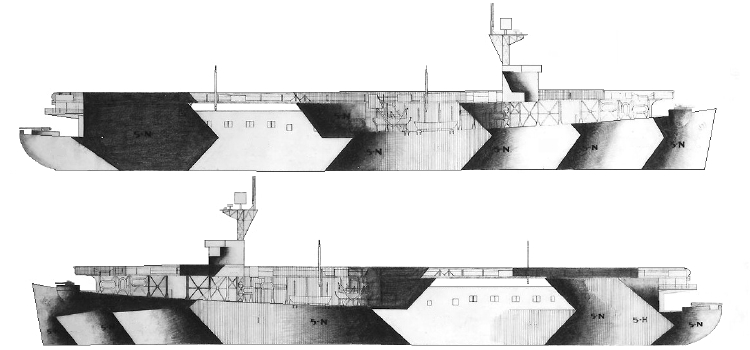
The design silhouette for Measure 32/4A for the Charger class escort carriers dated May 8, 1944. The vertical colors were specified to be navy blue (5-N), haze gray (5-H) and pale gray (5-P). Like other Design 4A drawings, some edges of the dark color 5-N were intended to “feather” or slowly blend into the ajacent lighter color.
The First drawing for Design 4A was for USS Enterprise (CV-6) in March 1943. The 4A Design for CV-6 was redrawn and labeled 4Ab possibly because the design’s panels all had solid edges instead of the soft feathered edges of many panels of Design 4A. Then on March 21, 1944, Design 4A was produced for the Bogue class of escort carriers and later on March 25, 1944, for the Casablanca class escort carriers and finally for the Charger class of escort carriers on May 8, 1944 as above. Most of the escort carriers that wore Design 4A were in the Atlantic Fleet.
Original drawing source: NARA 80-G-109643 and 80-G-109644.
February 23, 1944 4Ab in Measure 33 for CV-6
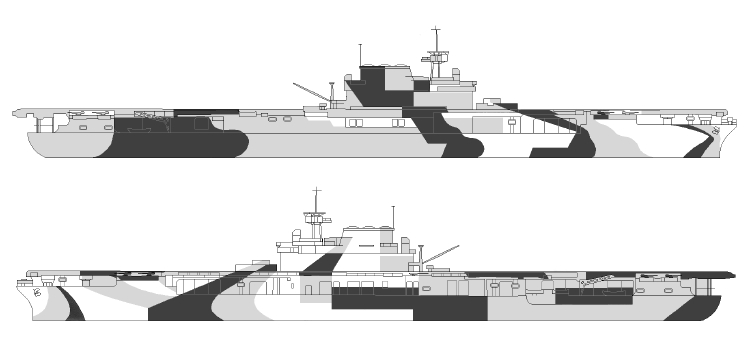
The design drawing for Design 4A that was drawn for the USS Enterprise (CV-6) in Measure 33. The Measure 33 vertical colors were navy blue (5-N), haze gray (5-H) and pale gray (5-P). The 4A Design for CV-6 above was labeled 4Ab possibly because in this version of the design the panels all had solid edges instead of the soft feathered edges of many panels of standard Design 4A. An August 1943 memo from the Pacific Fleet to the Bureau of Ships recommended: “Soft, graded patterns should be avoided until expert supervision for application may be made available.” It is possible that the original Design 4A was modified to be 4Ab to comply with that request.
The First drawing for Design 4A was for USS Enterprise (CV-6) in March 1943. The 4A Design for CV-6 was redrawn and labeled 4Ab possibly because the design’s panels all had solid edges instead of the soft feathered edges of many panels of Design 4A. Then on March 21, 1944, Design 4A was produced for the Bogue class of escort carriers and later on March 25, 1944, for the Casablanca class escort carriers and finally for the Charger class of escort carriers on May 8, 1944. Most of the escort carriers that wore Design 4A were in the Atlantic Fleet.
Original drawing source: NARA 80-G-170022 and 80-G-174772.
4AO Designs
February 16, 1944 4AO in Measure 32 for AO-2

The silhouette from the drawing for Design 32/4AO for the Maumee class of fleet oilers and others of similar design and profile dated February 16, 1944. The specified vertical colors were: light gray (5-L), ocean gray (5-O) and dull black (BK). The deck was all deck blue (20-B). Note the false perspective “stairs” on the port bow. This drawing also shows two waterlines.
No other drawings for Design 4AO have been found.
Original drawing source: NARA 80-G-173258 and 80-G-173259.4Ax Designs
January 6, 1944 4AX in Measure 32 for AD-14
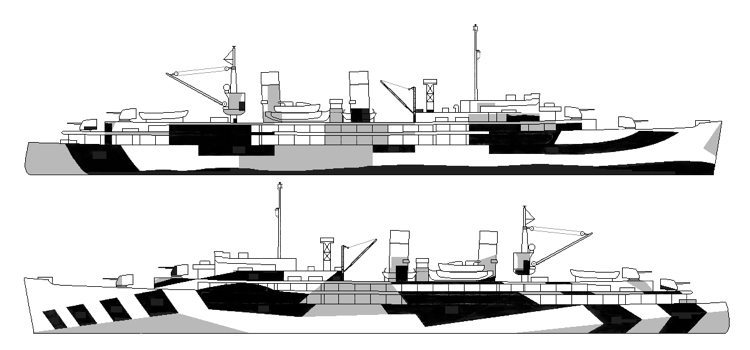
The silhouette from the drawing for Measure 32 Design 4Ax for the Dixie class destroyer tenders dated January 6, 1944. The vertical colors were specified to be dull black (BK), ocean gray (5-O) and light gray (5-L) with deck blue (20-B) and ocean gray for the horizontal colors.
This is the only version of Design 4Ax yet found.
Original drawing source: NARA 80-G-163666 and 80-G-163667.4D Designs
March 1943 4D in Measure 3! for DD-445
The silhouette from the drawing for Measure 31/4D for the Fletcher class destroyers that was attached to the March 1943 Supplement to SHIPS-2. The vertical colors were ocean green (5-OG) with a sprayed pattern of navy green (5-NG). The horizontal pattern used ocean green (5-OG) and deck green (20-G). Note, because of the lack of control in the color reproduction process, these colors may not be a true match to the actual colors. Also the profile used for the Fletcher was an early (design?) version with out shields on 5-inch guns number three and four.
This is the only version of Design 4D yet found.
Original drawing source: March 1943 Supplement to SHIPS-2 Plate XXXII.4F Designs
July 15, 1943 ? 4F in Measure 32 for AK-25

The design drawing for Design 4F drawn for the USS Algorab (AK-25) a C2 type cargo ship dated July 15, 1943, has yet to be found.
A drawing for Design 4F was attached to the July 15, 1943, memo to PacFleet for the USS Algorab (AK-25).
Original drawing source: NARA ?
4P Designs
August 25, 1943 4P in Measure 31 for PT-71-94
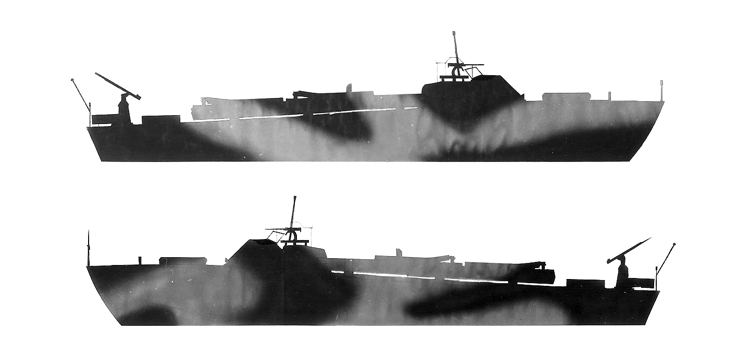
This is the silhouette from the drawing for Measure 31 Design 4P for motor torpedo boats dated August 25, 1943. The specified vertical colors were navy blue (5-N) sprayed and feathered over ocean green (5-OG) with ocean green and deck blue (20-B) on horizontal surfaces.
This is the only drawing for Design 4P that has yet been found.
Original drawing source: NARA 80-G-152114 and 80-G-152115.
4T Designs
January 11, 1944 4T in Measure 32 for APA-2
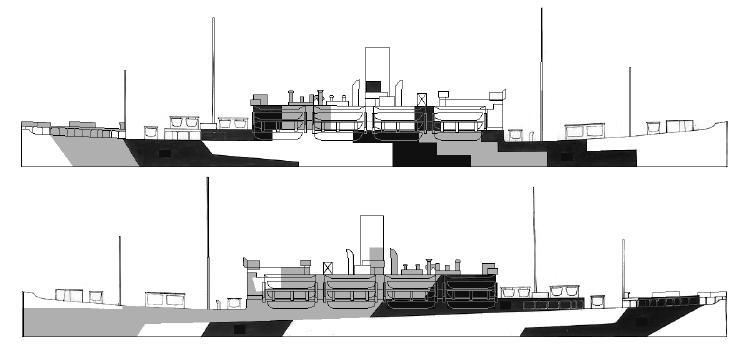
This is probably the earliest design drawing for Measure 32/4T drawn for the Harris class attack transports dated January 11, 1944. The vertical colors for Measure 32 were dull black (BK), ocean gray (5-O) and light gray (5-L) with the horizontal color deck blue (20-B). The boat colors were not specifically identified, but appeared to blend with their background.
The first Design 4T drawing was for USS Harris (APA-2) as above on January 11, 1944. Design 4T was then drawn for the Harry Lee class of attack transports on March 9, 1944. Then 4T was drawn for USS Borias (AF-8) on April 5, 1944, and on April 7 for USS President Polk (AP-103) a (C3A-P&C) maritime hull. On July 5, 1944, Design 4T was issued for the Sumter class of attack transports using a (C2-S-E1) maritime hull and again on August 1, 1944, for the Haskell class attack transports with (VC2-S-AP5) maritime hulls.
Original drawing source: NARA 80-G-165755 and 80-G-165756
March 9, 1944 4T in Measure 32 for APA-10
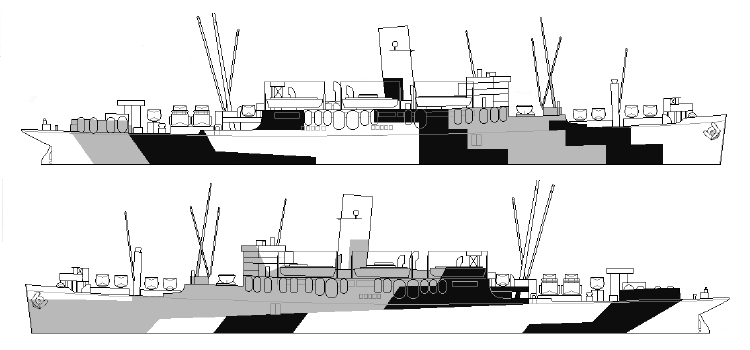
The design drawing for Measure 32/4T for the Harry Lee class of transports. The vertical colors for Measure 32 were again dull black (BK), ocean gray (5-O) and light gray (5-L) with deck blue (20-B) for the horizontal color.
The first Design 4T drawing was for USS Harris (APA-2) on January 11, 1944. Design 4T was then drawn for the Harry Lee class of attack transports on March 9, 1944. Then 4T was drawn for USS Borias (AF-8) on April 5, 1944, and on April 7 for USS President Polk (AP-103) a (C3A-P&C) maritime hull. On July 5, 1944, Design 4T was issued for the Sumter class of attack transports using a (C2-S-E1) maritime hull and again on August 1, 1944, for the Haskell class attack transports with (VC2-S-AP5) maritime hulls.
Original drawing source: NARA 80-G-170028 and 80-G-170029.
April 5, 1944 4T in Measure 32 for AF-8
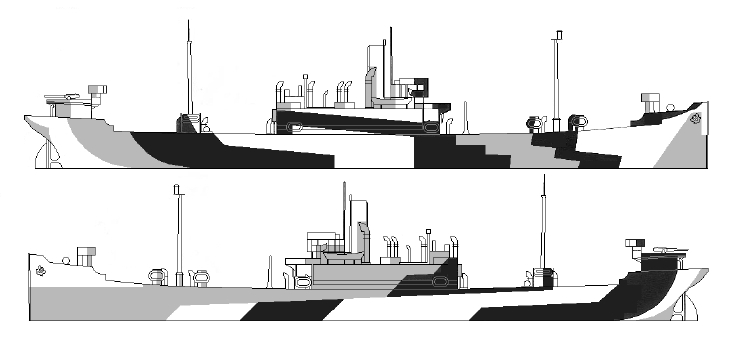
A silhouette of the design drawing for Measure 32/4T drawn on April 5, 1944, for the storeship USS Borias (AF-8). The overall pattern has remained very much the same with only slight differences mainly on the starboard bow and the superstructure.
The first Design 4T drawing was for USS Harris (APA-2) on January 11, 1944. Design 4T was then drawn for the Harry Lee class of attack transports on March 9, 1944. Then 4T was drawn for USS Borias (AF-8) on April 5, 1944, and on April 7 for USS President Polk (AP-103) a (C3A-P&C) maritime hull. On July 5, 1944, Design 4T was issued for the Sumter class of attack transports using a (C2-S-E1) maritime hull and again on August 1, 1944, for the Haskell class attack transports with (VC2-S-AP5) maritime hulls.
Original drawing source: NARA 80-G-172877 and 80-G-172878.
April 7, 1944 4T in Measure 32 for AP-103
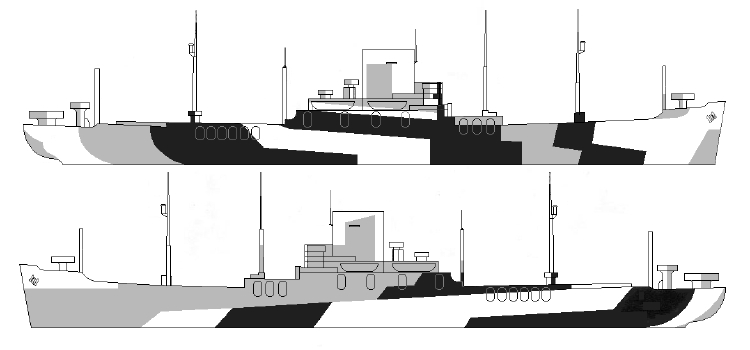
The design silhouette for Measure 32/4T for the President Polk class transports drawn on April 7, 1944. The vertical colors were light gray (5-L), ocean gray (5-O) and dull black (BK) for Measure 32. The pattern has remained the same with some changes around the superstructure.
The first Design 4T drawing was for USS Harris (APA-2) on January 11, 1944. Design 4T was then drawn for the Harry Lee class of attack transports on March 9, 1944. Then 4T was drawn for USS Borias (AF-8) on April 5, 1944, and on April 7 for USS President Polk (AP-103) a (C3A-P&C) maritime hull. On July 5, 1944, Design 4T was issued for the Sumter class of attack transports using a (C2-S-E1) maritime hull and again on August 1, 1944, for the Haskell class attack transports with (VC2-S-AP5) maritime hulls.
Original drawing source: NARA 80-G-173496 and 80-G-173497.
July 5, 1944 4T in Measure 32 for APA-52
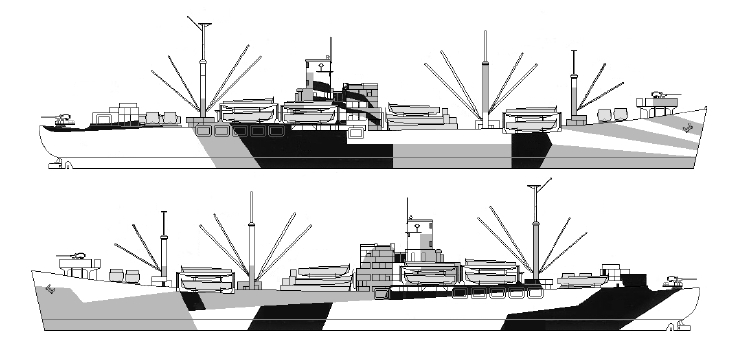
A silhouette of the design drawing for Measure 32/4T for the Sumter class of attack transports dated July 5, 1944. The pattern has been slightly changed on the starboard bow with the addition of a ray pattern. The standard Measure 32 colors were used plus the landing boats were specified to be haze gray (5-H).
The first Design 4T drawing was for USS Harris (APA-2) on January 11, 1944. Design 4T was then drawn for the Harry Lee class of attack transports on March 9, 1944. Then 4T was drawn for USS Borias (AF-8) on April 5, 1944, and on April 7 for USS President Polk (AP-103) a (C3A-P&C) maritime hull. On July 5, 1944, Design 4T was issued for the Sumter class of attack transports using a (C2-S-E1) maritime hull and again on August 1, 1944, for the Haskell class attack transports with (VC2-S-AP5) maritime hulls.
Original drawing source: NARA 80-G-174758 and 80-G-174759.
August 1, 1944 4T in Measure 32 for APA-117
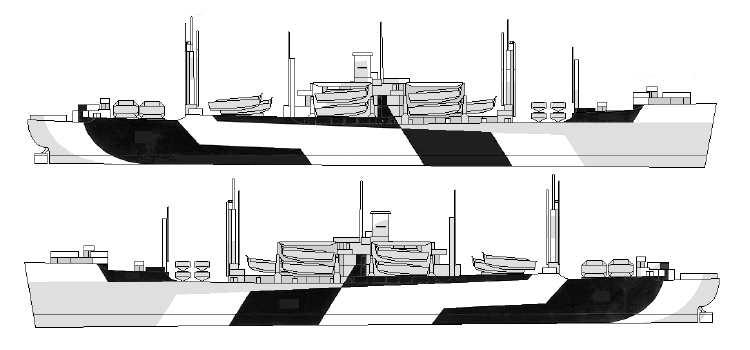
The silhouette for the design drawing for Measure 32/4T for the Haskell class attack transports with the (VC2-S-AP5) maritime hull drawn on August 1, 1944. The Measure 32 colors were light gray (5-L), haze gray (5-H) and dull black (BK) and the landing boats were haze gray. This version of Design 4T is almost identical port and starboard.
The first Design 4T drawing was for USS Harris (APA-2) on January 11, 1944. Design 4T was then drawn for the Harry Lee class of attack transports on March 9, 1944. Then 4T was drawn for USS Borias (AF-8) on April 5, 1944, and on April 7 for USS President Polk (AP-103) a (C3A-P&C) maritime hull. On July 5, 1944, Design 4T was issued for the Sumter class of attack transports using a (C2-S-E1) maritime hull and again on August 1, 1944, for the Haskell class attack transports with (VC2-S-AP5) maritime hulls.
Original drawing source: NARA 80-G-176517 and 80-G-176518.
September 1944 ? 4T in Measure 32 for AKA-21
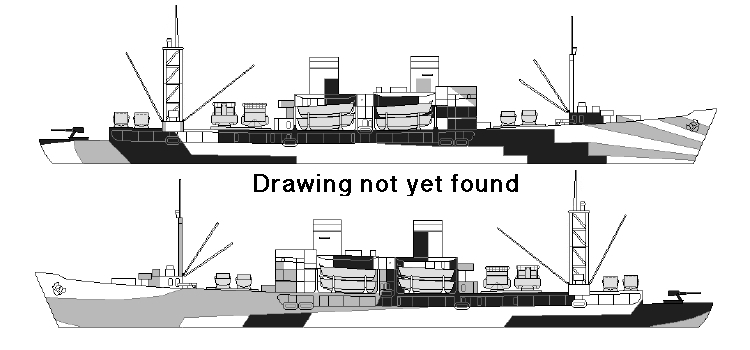
This is a silhouette of what the version of Design 4T used by the Artemis class attack cargo ships of (S4-SE2-BE1) maritime type hull may have looked like dated possibly September 1944. The vertical colors for Measure 32 would have been dull black (BK), ocean gray (5-O) and light gray (5-L) with deck blue (20-B) for the horizontal colors. Some ships painted the boats haze gray (5-H) and some used darker colors. The official US Navy version of this design drawing has not yet been found but at least five ships used this camouflage so the drawing must have existed. The modification to the starboard bow with rays has reappeared in this version.
The first Design 4T drawing was for USS Harris (APA-2) on January 11, 1944. Design 4T was then drawn for the Harry Lee class of attack transports on March 9, 1944. Then 4T was drawn for USS Borias (AF-8) on April 5, 1944, and on April 7 for USS President Polk (AP-103) a (C3A-P&C) maritime hull. On July 5, 1944, Design 4T was issued for the Sumter class of attack transports using a (C2-S-E1) maritime hull and again on August 1, 1944, for the Haskell class attack transports with (VC2-S-AP5) maritime hulls.
Original drawing source: NARA ?
5A Designs
July 15, 1943 ? 5A in Measure 31 for ACV-26
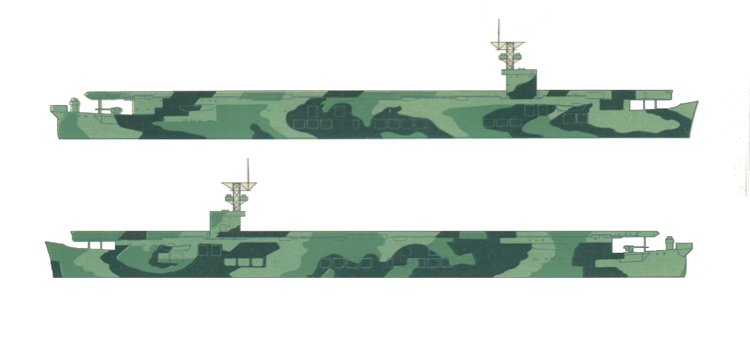
The silhouette from the drawing for Measure 31 Design 5A for for the Sangamon class escort carriers that was attached to the March 1943 Supplement to SHIPS-2. At that time the Sangemon class was labeled ACV, auxilliary aircraft carrier, instead of later CVE, escort carrier. The vertical colors were specified to be dull black (BK), ocean green (5-OG) and haze green (5-HG) with the horizontal surfaces deck green (20-G). Note, because of the lack of control in the color reproduction process, these colors may not be a true match to the actual colors.
This is only Design 5A drawing that has been found.
Original drawing source: March 1943 Supplement to SHIPS-2 Plate XXXV.
5AO Designs
February 21, 1944 5AO in Measure 32 for AO-22
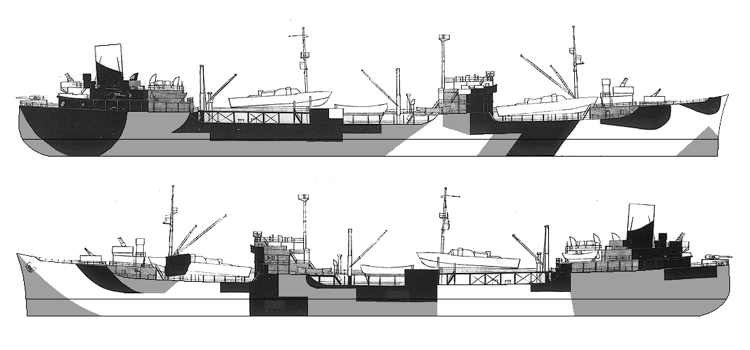
The silhouette from the drawing for Design 32/5AO for the Cimarron and Ashtabula classes of fleet oilers with T3 maritime type hulls dated February 21, 1944. This drawing could also be used for Chiwawa class and similar ships. The vertical colors: light gray (5-L), ocean gray (5-O) and dull black (BK). The deck was all deck blue (20-B). This drawing also displays PT boats as deck cargo and has two waterlines.
This is only Design 5AO drawing that has been found.
Original drawing source: NARA 80-G-165982 and 80-G-165988.
5AS Designs
April 12, 1944 5AS in Measure 32 for AS-15
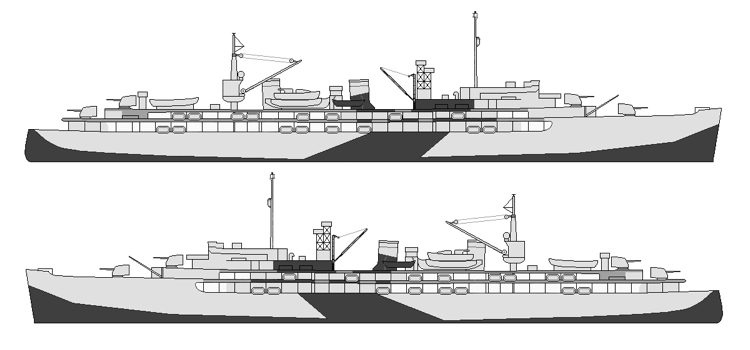
The silhouette from the drawing for Design 32/5AS for the USS Bushnell (AS-15) a Fulton class subarine tender dated April 12, 1944. This drawing was drawn by Lt. Cmdr. Dayton R. E. Brown, a camouflage expert who had been assigned to the Fleet Maintenance Office of Service Force, Pacific Fleet. The pattern was the same both port and starboard and the vertical colors were pale gray (5-P), haze gray (5-H) and dull black (BK). The deck was deck blue (20-B) and ocean gray (5-O).
This is only Design 5AS drawing that has been found.
Original drawing source: NARA 19-G-Box2815.
5Ax Designs
March 18, 1944 5AX in Measure 32 for AV-4
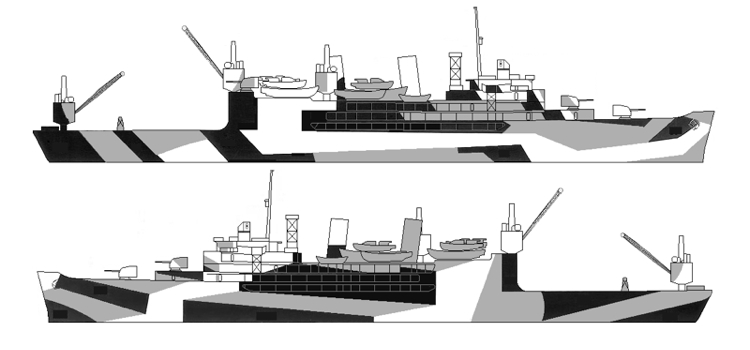
The silhouette from the drawing for Design 5Ax for Curtiss class seaplane tenders dated March 18, 1944. The Measure 32 vertical colors were dull black (BK), ocean gray (5-O) and light gray (5-L) and the deck was a pattern of deck blue (20-B) and ocean gray. The “stairs” on the port and black on the aft of the hangar give the impression that the bow of the ship is rotated away from the observer.
This is the only version of Design 5Ax that has been found.
Original drawing source: NARA 80-G-172521 and 80-G-172522.
5D Designs
March 1943 5D in Measure 32 for DD-356
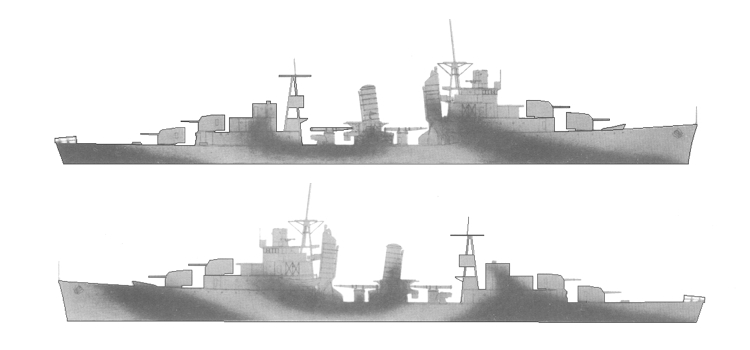
This is a silhouette of the earliest design drawing for Measure 32/5D drawn for the Porter class destroyers from the March 1943 supplement to SHIPS-2. This drawing specifies two vertical colors: haze gray (5-H) and navy blue (5-N) with a horizontal pattern of deck blue (20-B) and ocean gray (5-O).
The earliest drawing for Design 5D was attached to the March 1943 Supplement to SHIPS-2 for the Porter Class destroyers using Measure 32 colors and sprayed edges as above. Sometime in 1943 the cruiser USS Phoenix (CL-46) painted in Design 5D, possibly based on the above drawing. Then Design 5D was drawn for the Barnegat class of small seaplane tenders again using Measure 32 with sprayed edges. However, there may have been an additional drawing for the Barnegat class using solid edges because at least five of the class painted 5D with solid panels instead of sprayed and feathered edges.
Original drawing source: NARA March 1943 Supplement to SHIPS-2 Plate XXVIII.
September 1943 ? 5D in Measure 32 for CL-46
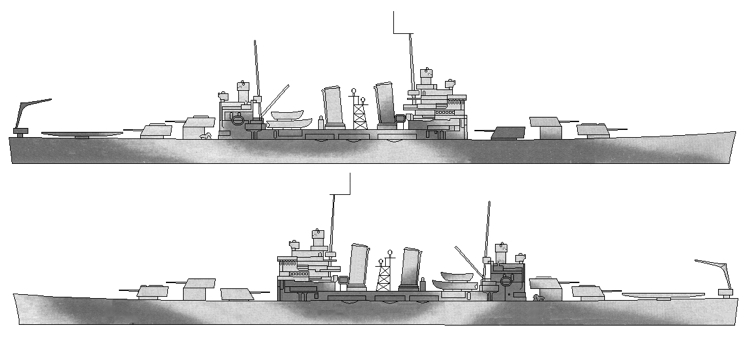
The silhouette for the possible design drawing for Measure 32/5D for the light cruiser USS Phoenix (CL-46) which has not yet been found. This drawing may have used the vertical colors: haze gray (5-H) and navy blue (5-N) with a horizontal pattern of deck blue (20-B) and ocean gray (5-O). Phoenix applied this camouflage in late September 1943.
The earliest drawing for Design 5D was attached to the March 1943 Supplement to SHIPS-2 for the Porter Class destroyers using Measure 32 colors and sprayed edges. Sometime in 1943 the cruiser USS Phoenix (CL-46) painted in Design 5D, possibly based on the March drawing. Then Design 5D was drawn for the Barnegat class of small seaplane tenders again using Measure 32 with sprayed edges. However, there may have been an additional drawing for the Barnegat class using solid edges because at least five of the class painted 5D with solid panels instead of sprayed and feathered edges.
Original drawing source: NARA ?
February 29, 1944 5D in Measure 32 for AVP-10

The drawing for Design 32/5D for the Barnegat class of small seaplane tenders dated February 29, 1944. This drawing shows the dark color feathering into the light color. Some ships painted this design with solid or straight edges. It is not known if there existed a drawing showing the solid edges. The vertical colors were haze gray (5-H), and navy blue (5-N) and was labeled Measure 32. The deck was all deck blue (20-B).
The earliest drawing for Design 5D was attached to the March 1943 Supplement to SHIPS-2 for the Porter Class destroyers using Measure 32 colors and sprayed edges. Sometime in 1943 the cruiser USS Phoenix (CL-46) painted in Design 5D, possibly based on the March drawing. Then Design 5D was drawn for the Barnegat class of small seaplane tenders again using Measure 32 with sprayed edges. However, there may have been an additional drawing for the Barnegat class using solid edges because at least five of the class painted 5D with solid panels instead of sprayed and feathered edges.
Original drawing source: NARA 80-G-166240 and 80-G-166241.
5L Designs
December 14, 1943 5L in Measure 31 for LCI(L)
 5L.jpg)
The silhouette from the drawing for Measure 31 Design 5L for LCI(L) and similar ships dated December 14, 1943. The specified vertical colors were dull black (BK), navy green (5-NG), brown (4A) and ocean green (5-OG) with deck green (20-G) deck paint on horizontal surfaces.
The first drawings of Design 5L was for LCI(L)s on December 14, 1943, as above. Then Design 5L using Measure 31 was used for LST type ships and APDs. No other drawings for Design 5L have yet been found, but drawings labeled 5L were sent to some amphibious ships and also to yards that would paint them.
Original drawing source: NARA 80-G-162018 and 80-G-162019.
February 1945 5L in Measure 31 for LST's.
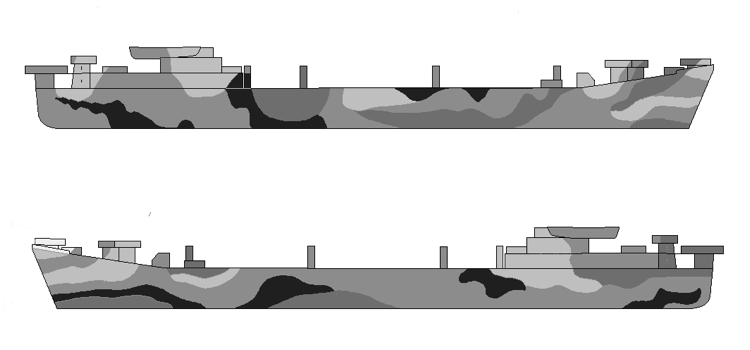
This is what the silhouette for Measure 31 Design 5L for LST's and similar ships might have looked like. Drawings for Design 5L for these ships were sent out beginning in February 1945, but copies have not yet been found. The specified vertical colors were probably dull black (BK), navy green (5-NG), brown (4A) and ocean green (5-OG) with deck green (20-G) deck paint on horizontal surfaces.
The first drawings of Design 5L was for LCI(L)s on December 14, 1943. Then Design 5L using Measure 31 was used for LST type ships and APDs. No other drawings for Design 5L have yet been found, but drawings labeled 5L were sent to some amphibious ships and also to yards that would paint them.
Original drawing source: NARA ? This drawing was done from photographs.
5P Designs
May, 1944 ? 5P in Measure 31 for PT Boats
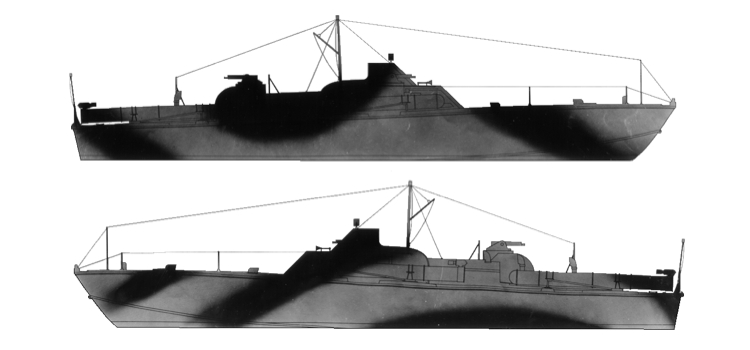
The silhouette from the drawing for Measure 31 Design 5P for PT boats probably drawn in May 1944. The specified vertical colors were navy green (5-NG) sprayed over motor torpedo boat green with deck green (20-G) and motor torpedo boat green deck paint on horizontal surfaces. The drawing included a color chip for motor torpedo boat green.
This is the only drawing for Design 5P yet found.
Original drawing source: NARA 19-N-72203 and 19-N-72216.
6A Designs
July 19, 1943 6A in Measure 3_ for CV-9
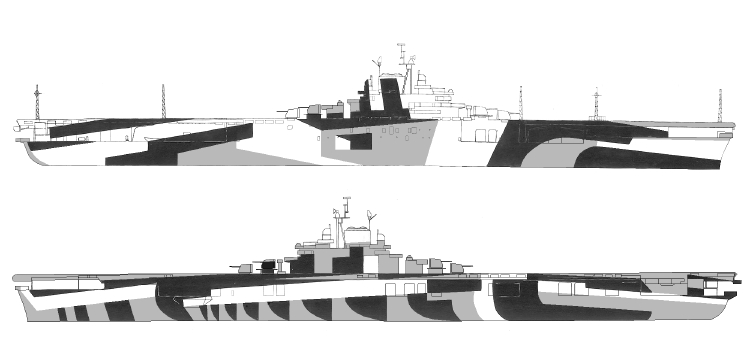
The earliest design drawing for Design 6A drawn for the Essex class carriers dated July 19, 1943. The Measure specified was open. The Measure 32 vertical colors would normally be dull black (BK), ocean gray (5-O) and light gray (5-L). Notice the false perspective on the starboard that slightly resembles an optical illusion. The diminishing panels on the port side are meant to give a false sense of rotation away from the observer. However, this port pattern may have been regarded as difficult to repaint/maintain, because the carrier Franklin originally carried this pattern when built, but three months later changed the port side to match the drawing for Design 3A.
The first Design 6A drawing was for the Essex class carriers as above on July 19, 1943. Design 6A was then redrawn for the USS Terror class minelayers on April 9, 1944. Design 6A was redrawn on May 26, 1944, for the USS Wright (AV-1) seaplane tender in Measure 32 colors. Later in June it was drawn up for transports.
Original drawing source: NARA 80-G-160238.
April 9, 1944 6A in Measure 32 for CM-5
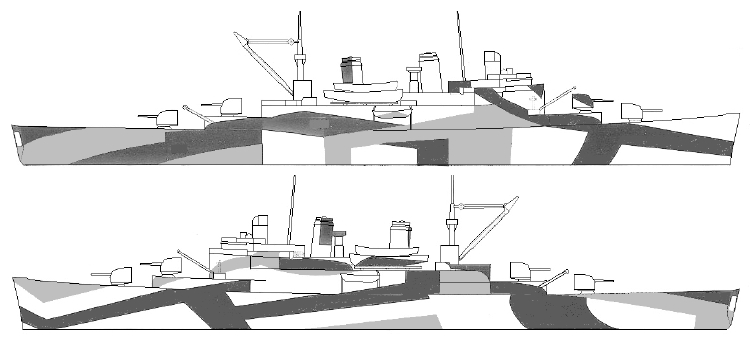
The design drawing for Measure 32 Design 6A for the Terror class minelayers drawn on April 9, 1944. The vertical colors for Measure 32 were dull black (BK), ocean gray (5-O) and light gray (5-L). The starboard perspective panels have been enlarged and shifted while the port side pattern has been dramatically changed.
The first Design 6A drawing was for the Essex class carriers on July 19, 1943. Design 6A was then redrawn for the USS Terror class minelayers on April 9, 1944. Design 6A was redrawn on May 26, 1944, for the USS Wright (AV-1) seaplane tender in Measure 32 colors. Later in June it was drawn up for transports.
Original drawing source: NARA 80-G-172973 and 80-G-172974.
May 26, 1944 6A in Measure 32 for AV-1
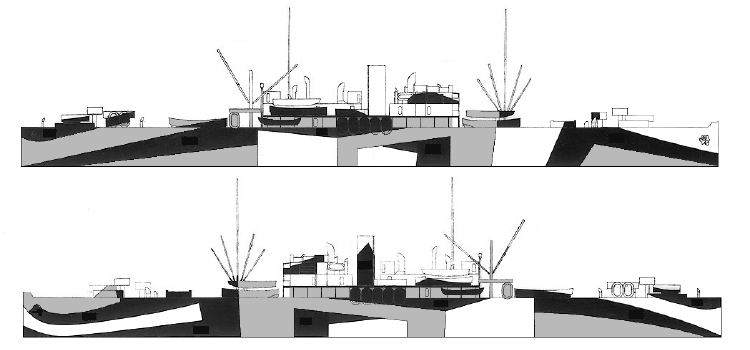
A silhouette of the design drawing for Measure 32 Design 6A drawn on May 26, 1944, for the seaplane tender USS Wright. The pattern on the port side has been reworked again and now closely resembles a mirrored version of the starboard pattern.
The first Design 6A drawing was for the Essex class carriers on July 19, 1943. Design 6A was then redrawn for the USS Terror class minelayers on April 9, 1944. Design 6A was redrawn on May 26, 1944, for the USS Wright (AV-1) seaplane tender in Measure 32 colors. Later in June it was drawn up for transports.
Original drawing source: NARA 80-G-172533 and 80-G-172535.
June 12, 1944 6A in Measure 32 for AP-33
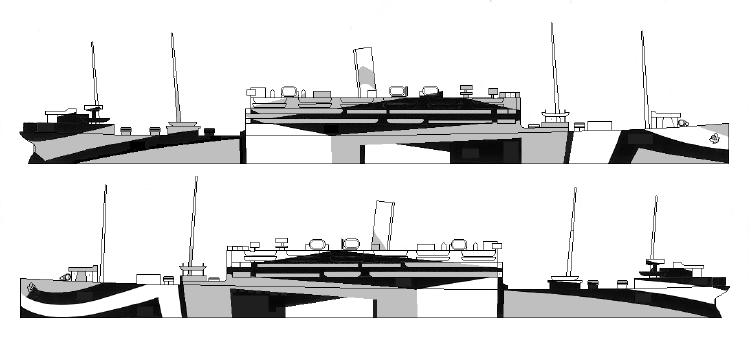
The design silhouette for Measure 32/6A for the transport USS Republic (AP-33) drawn on June 12, 1944. This version of Design 6A closely matches the previous version.
The first Design 6A drawing was for the Essex class carriers on July 19, 1943. Design 6A was then redrawn for the USS Terror class minelayers on April 9, 1944. Design 6A was redrawn on May 26, 1944, for the USS Wright (AV-1) seaplane tender in Measure 32 colors. Later in June it was drawn up for transports.
Original drawing source: NARA 80-G-174756 and 80-G-174757.
July, 1944 ? 6A in Measure 32 for APA-117
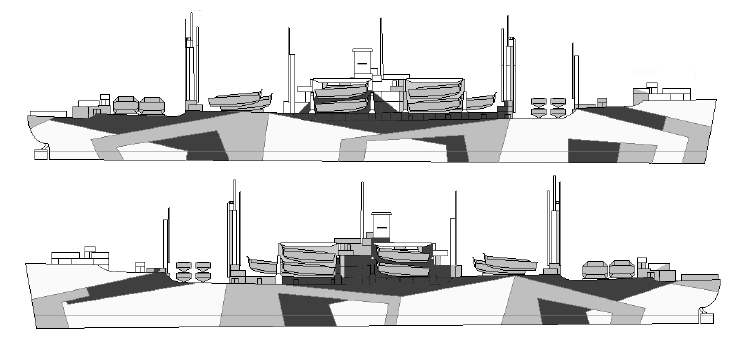
This is what a silhouette of the drawing for Design 6A for the Haskell class of attack transports using a VC2 hull may have looked like. This was possibly dated June or July 1944. This design probably used the standard vertical colors for Measure 32: dull black (BK), ocean gray (5-O) and light gray (5-L). In this version of Design 6A the false perspective panels have been increased to two on each side.
The first Design 6A drawing was for the Essex class carriers on July 19, 1943. Design 6A was then redrawn for the USS Terror class minelayers on April 9, 1944. Design 6A was redrawn on May 26, 1944, for the USS Wright (AV-1) seaplane tender in Measure 32 colors. Later in June it was drawn up for transports.
Original drawing source: NARA ? This drawing created from multiple ship photographs.
6AO Designs
February 29, 1944 6AO in Measure 32 for AO-37
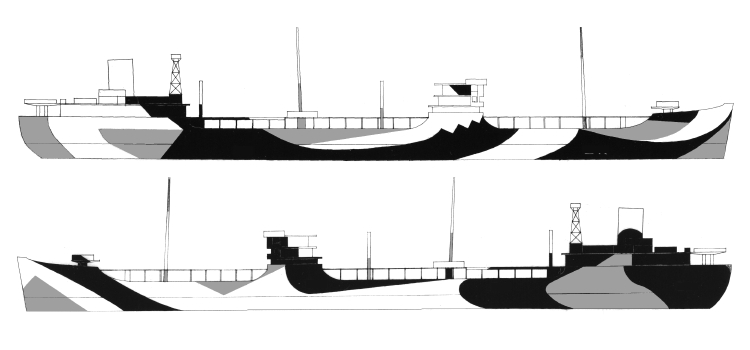
This is a silhouette of the earliest design drawing for Measure 32/6AO drawn for the Merrimac class fleet oilers dated February 29, 1944. This drawing specifies three vertical colors: light gray (5-L), ocean gray (5-O) and dull black (BK) with the horizontal color of deck blue (20-B). This drawing also shows two waterlines. Note the sawtooth edge on the starboard side.
The earliest drawing for Design 6AO was this one on February 29, 1944. Design 6AO was redrawn on May 10, 1944, for the Alamosa class cargo ships and later on July 3, 1944, for the Tolland class of attack cargo ships.
Original drawing source: NARA 80-G-166242 and 80-G-166243.
May 10, 1944 6AO in Measure 33 for AK-156
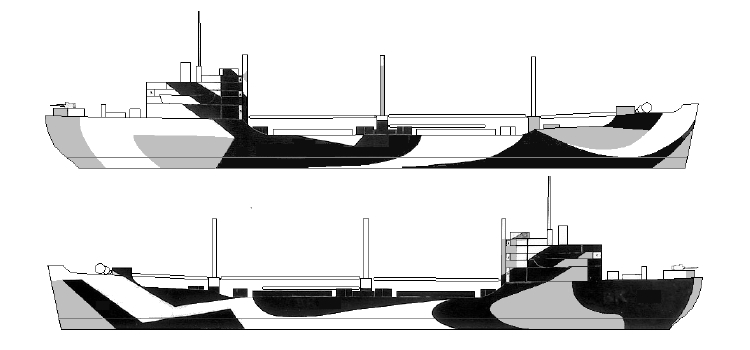
The design drawing for Measure 33/6AO for the Alamosa class cargo ships. This drawing uses the (C1-M-AV1) maritime hull and specifies three vertical colors: pale gray (5-P), haze gray (5-H) and navy blue (5-N) with the horizontal color of deck blue (20-B). This drawing also includes two waterlines: a load waterline and a camouflage line. Note, this version has lost the sawtooth edge on the starboard side.
The earliest drawing for Design 6AO was on February 29, 1944. Design 6AO was redrawn on May 10, 1944, for the Alamosa class cargo ships above and later on July 3, 1944, for the Tolland class of attack cargo ships.
Original drawing source: NARA 80-G-172530 and 80-G-172532.
July 3, 1944 6AO in Measure 32 for AKA-64
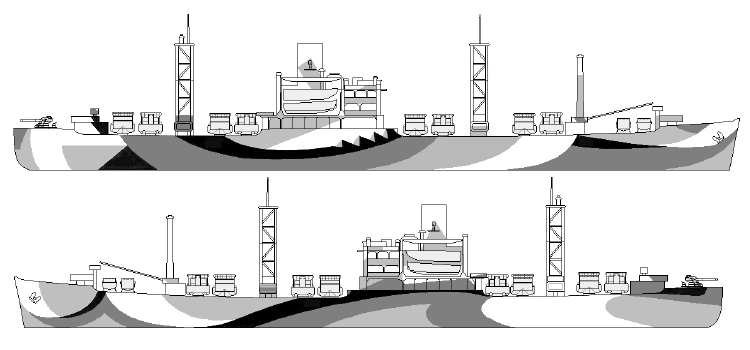
The silhouette of the drawing for Design 32/6AO for the Tolland class attack cargo ships using the (C2-S-AJ3) maritime hull dated July 3, 1944. This drawing specifies four vertical colors: light gray (5-L), ocean gray (5-O), navy blue (5-N) and dull black (BK) with the horizontal color of deck blue (20-B). The boats were all specified to be a sixth color of haze gray (5-H). This drawing has one waterline, the load waterline so most ships painted camouflage below that line. The sawtooth edge on the starboard has returned slightly modified due to the fourth color.
The earliest drawing for Design 6AO was on February 29, 1944. Design 6AO was redrawn on May 10, 1944, for the Alamosa class cargo ships and later on July 3, 1944, for the Tolland class of attack cargo ships as above.
Original drawing source: NARA 80-G-177456 and 80-G-177457.
6Ax Designs
April 3, 1944 6AX in Measure 31 for ARG-2
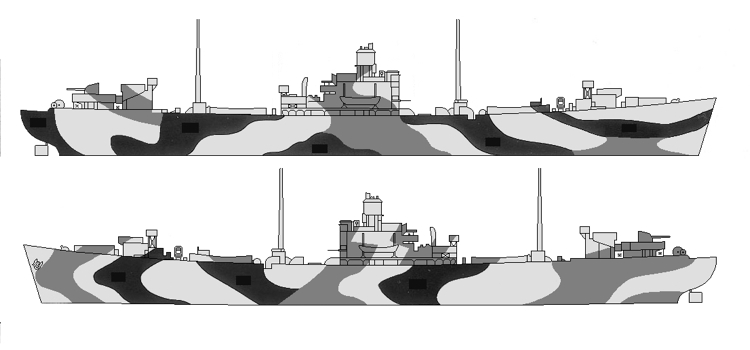
The silhouette from the drawing for Design 6Ax for Luzon class internal combustion repair ships dated April 3, 1944. The Measure 31 vertical colors were dull black (BK), navy green (5-NG) and ocean green (5-OG) and the deck was deck green (20-G).
This is the only version of Design 6Ax that has been found.
Original drawing source: NARA 80-G-173494 and 80-G-173495.
6B Designs
October 14, 1944 6B in Measure 31a for BB-36
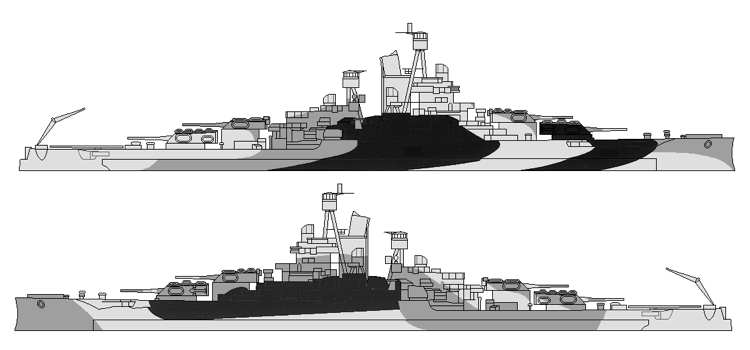
The silhouette from the drawing for Design 6B using Measure 31a colors drawn for the battleship USS Nevada dated October 14, 1944. The Measure 31a colors are navy blue (5-N), ocean gray (5-O) and haze gray (5-H) on vertical surfaces with deck blue (20-B) on the horizontal surfaces.
This is the only version of Design 6B that has been found.
Original drawing source: NARA 19-N-73630 and 19-N-73631.
6D Designs
July 15, 1943 ? 6D in Measure 32 for DD-445

The earliest design drawing for Design 6D drawn for the Fletcher class destroyers dated July 15, 1943, has yet to be found.
The first drawing for Design 6D was included with the July 15, 1943, memo to PacFleet for the Fletcher class destroyers. Another Design 6D drawing for Fletcher was dated December 22, 1943, and it was redrawn on January 19, 1944, for the Cleveland class light cruisers and was worn by USS Birmingham (CL-62) and USS Vicksburg (CL-86) in Measure 33 colors and reportedly by USS Biloxi (CL-80) in Measure 32 colors. It was also worn by the battleships USS New Mexico (BB-40) and USS Mississippi (BB-41).
Original drawing source: NARA ?
October 1943 ? 6D in Measure 33 for CA-28
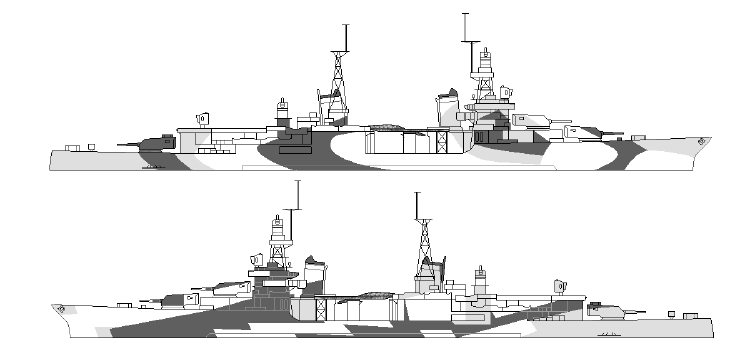
Beginning in December 1943 the USS Louisville (CA-28) was painted in Design 6D using the colors: navy blue (5-N), haze gray (5-H) and pale gray (5-P), which was Measure 33. Any drawing for this version of 6D has not yet been found; it may have been drawn by the Fleet Maintenance Office (FMO) of Pacific Fleet Service Force. The drawing above was done from photos of Louisville.
The first drawing for Design 6D was included with the July 15, 1943, memo to PacFleet for the Fletcher class destroyers. Another Design 6D drawing for Fletcher was dated December 22, 1943, and it was redrawn on January 19, 1944, for the Cleveland class light cruisers and was worn by USS Birmingham (CL-62) and USS Vicksburg (CL-86) in Measure 33 colors and reportedly by USS Biloxi (CL-80) in Measure 32 colors. It was also worn by the battleships USS New Mexico (BB-40) and USS Mississippi (BB-41).
Original drawing source: NARA ?
December 22, 1943 6D in Open Measure for DD-445
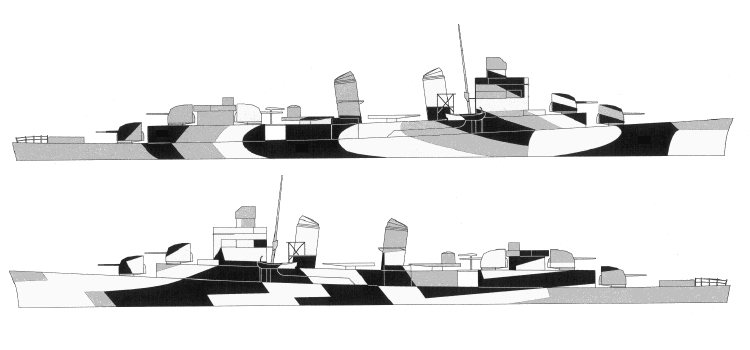
This silhouette is from the drawing for the Fletcher class destroyers showing Design 3_/6D dated December 22, 1943. The vertical colors would be dull black (BK), ocean gray (5-O) and light gray (5-L) for Measure 32 or haze gray (5-H) for light gray to be Measure 31. This drawing was probably not much different than the previous two drawings.
The first drawing for Design 6D was included with the July 15, 1943, memo to PacFleet for the Fletcher class destroyers. Another Design 6D drawing for Fletcher was dated December 22, 1943, and it was redrawn on January 19, 1944, for the Cleveland class light cruisers and was worn by USS Birmingham (CL-62) and USS Vicksburg (CL-86) in Measure 33 colors and reportedly by USS Biloxi (CL-80) in Measure 32 colors. It was also worn by the battleships USS New Mexico (BB-40) and USS Mississippi (BB-41).
Original drawing source: NARA 80-G-162024 and 80-G-62025.
January 1, 1944 6D in Measure 32 for DE-5
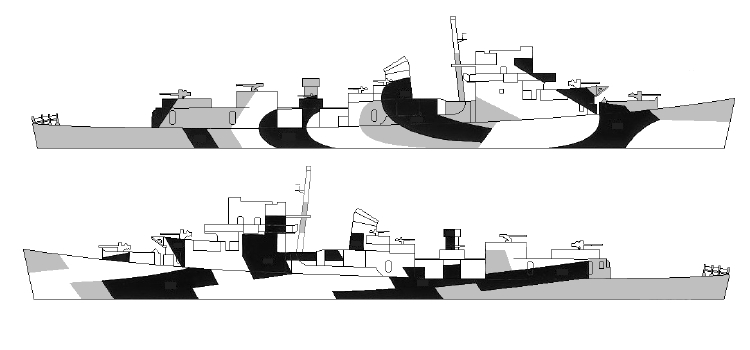
Drawing silhouete of Measure 32 Design 6D for the Evarts class destroyer escorts dated January 1, 1944. This three-color design used dull black (BK), ocean gray (5-O) and light gray (5-L) for the vertical surfaces; haze gray (5-H) subsituted for light gray would give Measure 31.
The first drawing for Design 6D was included with the July 15, 1943, memo to PacFleet for the Fletcher class destroyers. Another Design 6D drawing for Fletcher was dated December 22, 1943, and it was redrawn on January 19, 1944, for the Cleveland class light cruisers and was worn by USS Birmingham (CL-62) and USS Vicksburg (CL-86) in Measure 33 colors and reportedly by USS Biloxi (CL-80) in Measure 32 colors. It was also worn by the battleships USS New Mexico (BB-40) and USS Mississippi (BB-41).
Original drawing source: NARA 80-G-105510 and 80-G-105511.
Jabuary 1944 6D in Measure 32 for DE-51
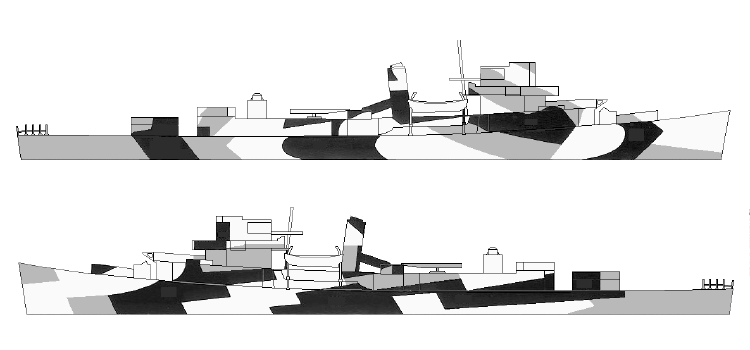
A silhouette of drawing 31/6D for the Buckley class destroyer escorts dated probably January 1944. The vertical colors were dull black (BK), ocean gray (5-O) and light gray (5-L). The starboard bow medium panel is along the waterline in this version of Design 6D.
The first drawing for Design 6D was included with the July 15, 1943, memo to PacFleet for the Fletcher class destroyers. Another Design 6D drawing for Fletcher was dated December 22, 1943, and it was redrawn on January 19, 1944, for the Cleveland class light cruisers and was worn by USS Birmingham (CL-62) and USS Vicksburg (CL-86) in Measure 33 colors and reportedly by USS Biloxi (CL-80) in Measure 32 colors. It was also worn by the battleships USS New Mexico (BB-40) and USS Mississippi (BB-41).
Original drawing source: NARA 80-G-170041 and 80-G-170042.
January 19, 1944 6D in Measure 33 for CL-55
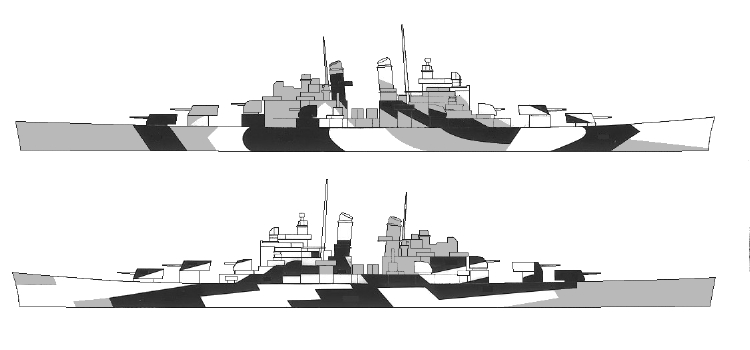
The silhouette from the drawing of 33/6D for the Cleveland class light cruisers drawn on January 19, 1944. The vertical colors were specified to be pale gray (5-P), haze gray (5-H) and navy blue (5-N). Measure 32 colors would be light gray (5-L), ocean gray (5-O) and dull black (BK) on the vertical surfaces. Note, this version of 6D has the starboard bow medium color panel along the waterline instead of the sheer line.
The first drawing for Design 6D was included with the July 15, 1943, memo to PacFleet for the Fletcher class destroyers. Another Design 6D drawing for Fletcher was dated December 22, 1943, and it was redrawn on January 19, 1944, for the Cleveland class light cruisers and was worn by USS Birmingham (CL-62) and USS Vicksburg (CL-86) in Measure 33 colors and reportedly by USS Biloxi (CL-80) in Measure 32 colors. It was also worn by the battleships USS New Mexico (BB-40) and USS Mississippi (BB-41).
Original drawing source: NARA 80-G-105496 and 80-G-105497.
February 1944 ? 6D in Measure 32 for AS-3
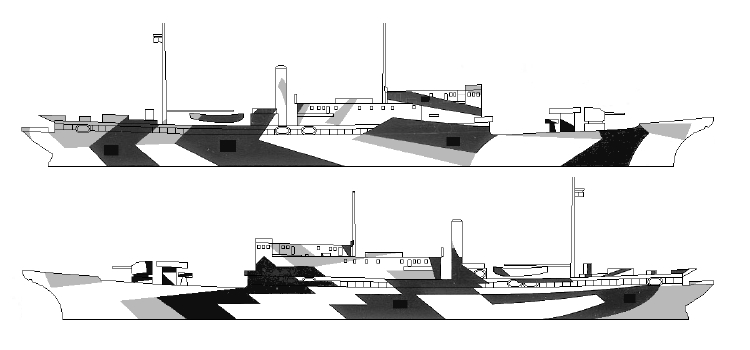
This is the silhouette of the drawing for Measure 32 Design 6D for the submarine tender USS Holland (AS-3) dated probably February 1944. The vertical colors were: dull black (BK), ocean gray and light gray (5-L), standard for Measure 32.
The first drawing for Design 6D was included with the July 15, 1943, memo to PacFleet for the Fletcher class destroyers. Another Design 6D drawing for Fletcher was dated December 22, 1943, and it was redrawn on January 19, 1944, for the Cleveland class light cruisers and was worn by USS Birmingham (CL-62) and USS Vicksburg (CL-86) in Measure 33 colors and reportedly by USS Biloxi (CL-80) in Measure 32 colors. It was also worn by the battleships USS New Mexico (BB-40) and USS Mississippi (BB-41).
Original drawing source: NARA 80-G-105488 and 80-G-105489.
February 16, 1944 6D in Measure 32 for BB-40
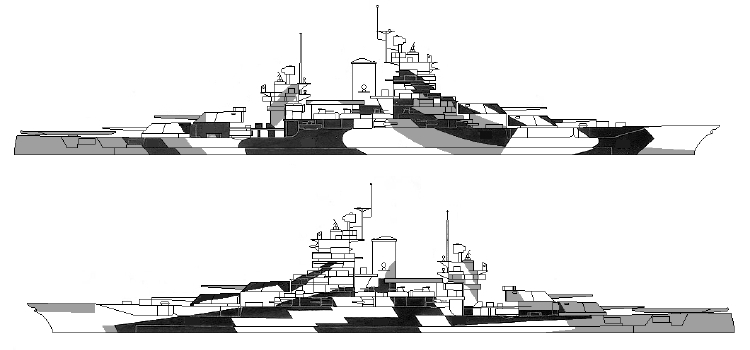
This is a silhouette from the drawing of Measure 33 Design 22D for the New Mexico class battleships dated February 16, 1944. The Measure 32 colors specified were: dull black (BK), ocean gray (5-O) and light gray (5-L). The pattern has been stretched over a much larger profile and panels modified for the superstructure. Also this version continues with the starboard bow medium panel along the waterline.
The first drawing for Design 6D was included with the July 15, 1943, memo to PacFleet for the Fletcher class destroyers. Another Design 6D drawing for Fletcher was dated December 22, 1943, and it was redrawn on January 19, 1944, for the Cleveland class light cruisers and was worn by USS Birmingham (CL-62) and USS Vicksburg (CL-86) in Measure 33 colors and reportedly by USS Biloxi (CL-80) in Measure 32 colors. It was also worn by the battleships USS New Mexico (BB-40) and USS Mississippi (BB-41).
Original drawing source: NARA 80-G-166246 and 80-G-166247.
February 17, 1944 6D in Measure 32 for ARG-1
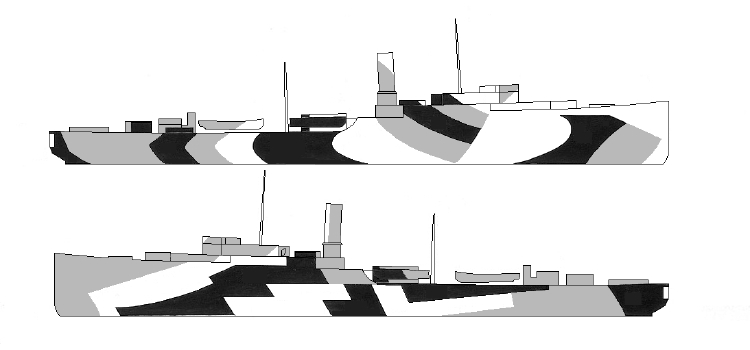
Here is the silhouette of the design drawing for Measure 32/6D drawn for the USS Oglala (ARG-1) dated February 17, 1944.
The first drawing for Design 6D was included with the July 15, 1943, memo to PacFleet for the Fletcher class destroyers. Another Design 6D drawing for Fletcher was dated December 22, 1943, and it was redrawn on January 19, 1944, for the Cleveland class light cruisers and was worn by USS Birmingham (CL-62) and USS Vicksburg (CL-86) in Measure 33 colors and reportedly by USS Biloxi (CL-80) in Measure 32 colors. It was also worn by the battleships USS New Mexico (BB-40) and USS Mississippi (BB-41).
Original drawing source: NARA 80-G-165761 and 80-G-165762.
March 24, 1944 6D in Measure 31 for DD-421
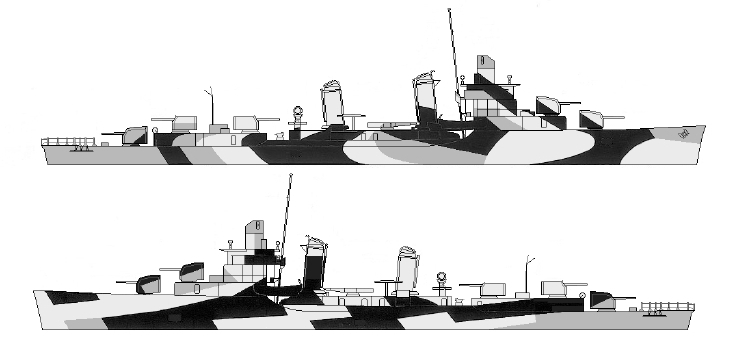
Here is the silhouette of the design drawing for Measure 31/6D drawn for the Benson class destroyers dated March 18, 1944. The colors were dull black (BK), ocean gray (5-O) and haze gray (5-H). The starboard bow medium panel has returned to the upper bow instead of the waterline.
The first drawing for Design 6D was included with the July 15, 1943, memo to PacFleet for the Fletcher class destroyers. Another Design 6D drawing for Fletcher was dated December 22, 1943, and it was redrawn on January 19, 1944, for the Cleveland class light cruisers and was worn by USS Birmingham (CL-62) and USS Vicksburg (CL-86) in Measure 33 colors and reportedly by USS Biloxi (CL-80) in Measure 32 colors. It was also worn by the battleships USS New Mexico (BB-40) and USS Mississippi (BB-41).
Original drawing source: NARA 80-G-170946 and 80-G-170947.
May 5, 1944 6D in Measure 32 for DD-348
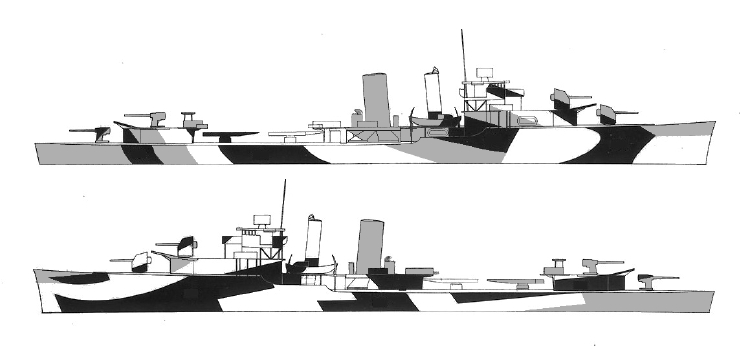
Here is the silhouette of the design drawing for Measure 32 Design 6D drawn for the Faragut class of destroyers dated May 5, 1944. This version of Design 6D used the Measure 32 colors of dull black (BK), ocean gray (5-O) and light gray (5-L).
The first drawing for Design 6D was included with the July 15, 1943, memo to PacFleet for the Fletcher class destroyers. Another Design 6D drawing for Fletcher was dated December 22, 1943, and it was redrawn on January 19, 1944, for the Cleveland class light cruisers and was worn by USS Birmingham (CL-62) and USS Vicksburg (CL-86) in Measure 33 colors and reportedly by USS Biloxi (CL-80) in Measure 32 colors. It was also worn by the battleships USS New Mexico (BB-40) and USS Mississippi (BB-41).
Original drawing source: NARA 80-G-109631 and 80-G-109632.
June 23, 1944 6D in Measure 32 for DE-339
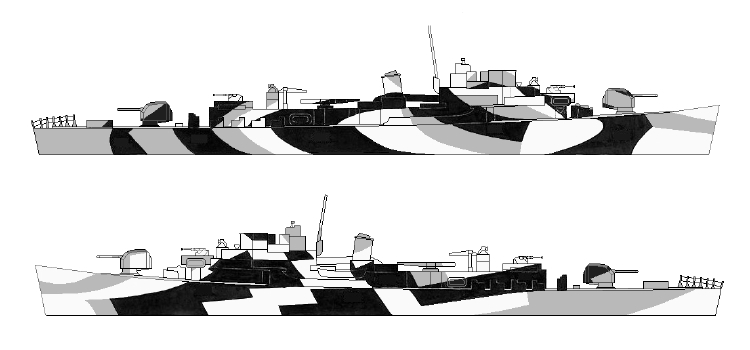
This is the silhouette of the drawing for Design 6D drawn for the John C. Butler class destroyer escorts dated June 23, 1944. The Measure 32 colors were dull black (BK), ocean gray (5-O) and light gray (5-L). The starboard bow medium panel has been modified and wraps around the bow to the port side.
The first drawing for Design 6D was included with the July 15, 1943, memo to PacFleet for the Fletcher class destroyers. Another Design 6D drawing for Fletcher was dated December 22, 1943, and it was redrawn on January 19, 1944, for the Cleveland class light cruisers and was worn by USS Birmingham (CL-62) and USS Vicksburg (CL-86) in Measure 33 colors and reportedly by USS Biloxi (CL-80) in Measure 32 colors. It was also worn by the battleships USS New Mexico (BB-40) and USS Mississippi (BB-41).
Original drawing source: NARA 80-G-176507 and 80-G-176508.
July 1, 1944 6D in Measure 31 for DD-348
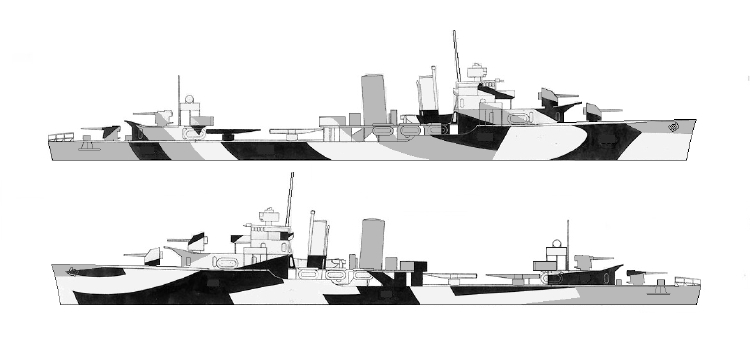
This is the silhouette of the drawing for Design 6D for the Faragut class of destroyers dated July 1, 1944. The colors used were Measure 31: dull black (BK), ocean gray (5-O) and haze gray (5-H). The starboard bow medium panel now wraps around the bow into a black panel.
The first drawing for Design 6D was included with the July 15, 1943, memo to PacFleet for the Fletcher class destroyers. Another Design 6D drawing for Fletcher was dated December 22, 1943, and it was redrawn on January 19, 1944, for the Cleveland class light cruisers and was worn by USS Birmingham (CL-62) and USS Vicksburg (CL-86) in Measure 33 colors and reportedly by USS Biloxi (CL-80) in Measure 32 colors. It was also worn by the battleships USS New Mexico (BB-40) and USS Mississippi (BB-41).
Original drawing source: NARA 80-G-176511 and 80-G-176512.
June 1944 ? 6D in Measure 31 for DD-598
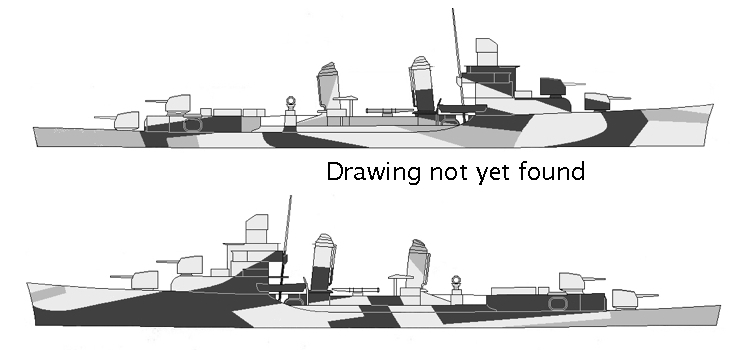
This is the silhouette of the possible design drawing for Measure 31 Design 6D drawn for the sub-class of Benson destroyers that carried four 5-inch guns, possibly dated late May or early June 1944. This version of Design 6D probably used the Measure 31 colors of dull black (BK), ocean gray (5-O) and haze gray (5-H). Light gray (5-L) instead of haze gray would be Measure 32. Notice how the ocean gray panel wraps around the bow.
The first drawing for Design 6D was included with the July 15, 1943, memo to PacFleet for the Fletcher class destroyers. Another Design 6D drawing for Fletcher was dated December 22, 1943, and it was redrawn on January 19, 1944, for the Cleveland class light cruisers and was worn by USS Birmingham (CL-62) and USS Vicksburg (CL-86) in Measure 33 colors and reportedly by USS Biloxi (CL-80) in Measure 32 colors. It was also worn by the battleships USS New Mexico (BB-40) and USS Mississippi (BB-41).
Original drawing source: NARA ?
6L Designs
December 22, 1943 6L in Measure 31 for LCI(L)-1-350
1 6L.jpg)
The silhouette from the drawing for Measure 31 Design 6L for LCI(L)-1 class and similar ships dated December 22, 1943. The specified vertical colors were dull black (BK), navy green (5-NG), brown (4A) and haze green (5-HG) with ocean green (5-OG), glossy black and brown deck paint on horizontal surfaces.
The first drawings of Design 6L was for LCI(L)s on December 22 1943, as above.
Original drawing source: NARA 80-G-162030 and 80-G-162031.
6T Designs
January 10, 1944 6T in Measure 32 for APA-18
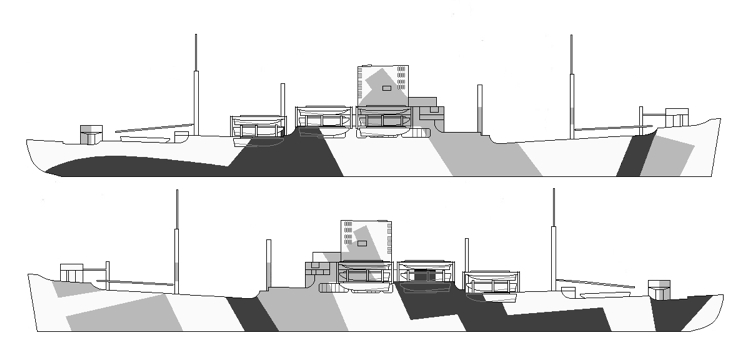
The silhouette from the drawing for Design 32/6T for the President Jackson class attack cargo ships using the (C3 P & C) maritime hull dated January 10, 1944. This drawing specified the Measure 32 vertical colors: light gray (5-L), ocean gray (5-O) and dull black (BK) with the horizontal color of deck blue (20-B).
The only other drawing for Design 6T was also for the President Jackson class and identical except it was Measure 33 using pale gray (5-P) and ocean gray (5-O) probably drawn at the same time.
Original drawing source: NARA 80-G-165759 and 80-G-165760 for Measure 32 as above and 80-G-152120 and 80-G-152121 for Measure 33.
7A Designs
September 4, 1943 7A in Measure 33 for CVE-9
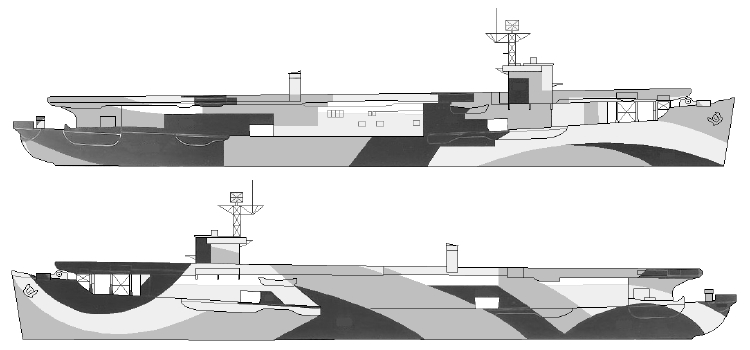
This is a silhouette of the earliest design drawing for Design 7A drawn for the Bogue class escort carriers dated September 4, 1943. This drawing specified vertical colors to be navy blue (5-N), haze gray (5-H) and pale gray (5-P) with some panels of white (5-U) for countershading.
The first version of Design 7A seems to have been for the Bogue class escort carriers on September 4, 1943, using Measure 33 colors. Then probably in November 1943, Design 7A was redrawn for the Independence class light carriers also in Measure 33. On January 19, 1944, Design 7A was drawn up for the Iowa class battleships using Measure 32.
Original drawing source: NARA 80-G-109715 and 80-G-109716.
November 1943 ? 7A in Measure 33 for CVL-22
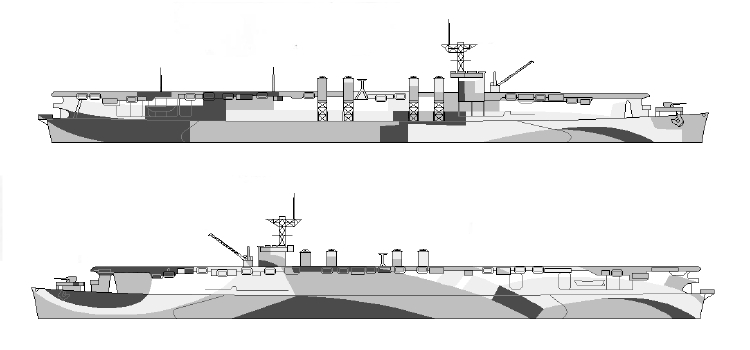
The design drawing for Measure 33/7A for the Independence class light carriers probably drawn in November 1943, since USS San Jacinto (CVL-30) commissioned in this design on November 15, 1943. This drawing specifies vertical colors of pale gray (5-P), haze gray (5-H) and navy blue (5-N) with white (5-U) as countershading.
The first version of Design 7A seems to have been for the Bogue class escort carriers on September 4, 1943, using Measure 33 colors. Then probably in November 1943, Design 7A was redrawn for the Independence class light carriers also in Measure 33. On January 19, 1944, Design 7A was drawn up for the Iowa class battleships using Measure 32.
Original drawing source: NARA 80-G-160566 and 80-G-160567.
January 19, 1944 7A in Measure 32 for BB-61
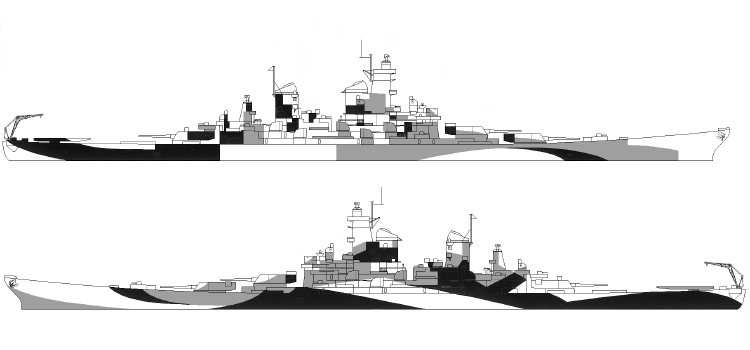
The silhouette of the Measure 32 Design 7A drawings for the Iowa class battleships dated January 19, 1944. The Measure 32 colors are dull black (BK), ocean gray (5-O) and light gray (5-L) vertically.
The first version of Design 7A seems to have been for the Bogue class escort carriers on September 4, 1943, using Measure 33 colors. Then probably in November 1943, Design 7A was redrawn for the Independence class light carriers also in Measure 33. On January 19, 1944, Design 7A was drawn up for the Iowa class battleships using Measure 32.
Original drawing source: NARA 80-G-105514 and 80-G-105515.
7AO Designs
March 1, 1944 7AO in Measure 32 for AO-22
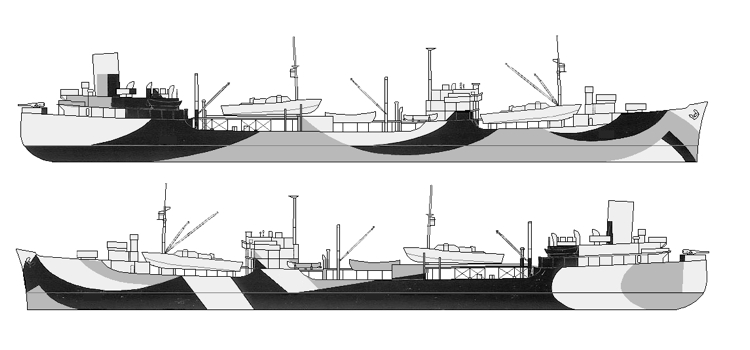
The silhouette from the drawing for Design 7AO for the Cimarron and Ashtabula classes of fleet oilers of the T3 type maritime hulls. This drawing used Measure 32 colors: dull black (BK), ocean gray (5-O) and light gray (5-L) on vertical sufaces with deck blue (20-B) on horizontal surfaces. The date of this drawing was March 1, 1944, and shows two waterlines.
This is only version of Design 7AO yet found.
Original drawing source: NARA 80-G-170039 and 80-G--170040.
7Ax Designs
April 7, 1944 7Ax in Measure 32 for IX-110
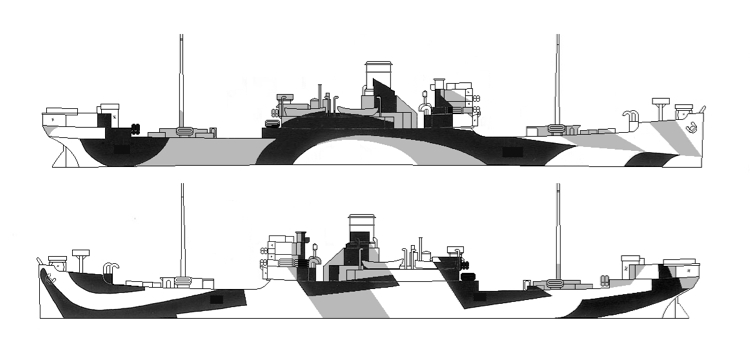
The silhouette from the drawing for Measure 32 Design 7Ax for the unclassified vessal USS Ocelot (IX-110) dated April 7, 1944. This drawing specifies Measure 32 vertical colors: light gray (5-L), ocean gray (5-O), and dull black (BK) with the horizontal color of deck blue (20-B).
This is the only drawing for Design 7Ax that has yet been found.
Original drawing source: NARA 80-G-172900 and 80-G-172894.
7B Designs
October 11, 1944 7B in Measure 31a for BB-33
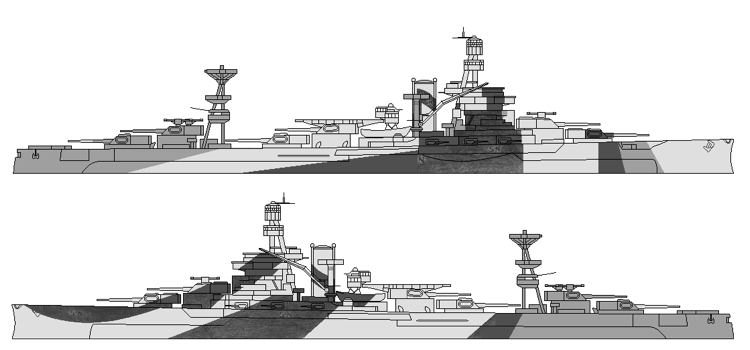
The silhouette from the drawing for Design 7B using Measure 31a colors drawn for the battleship USS Arkansas dated October 11, 1944. The Measure 31a colors are navy blue (5-N), ocean gray (5-O) and haze gray (5-H) on the vertical surfaces with deck blue (20-B) on the horizontal surfaces.
This is the only version of Design 7B that has been found.
Original drawing source: NARA 19-N-73634 and 19-N-736351.
7C Designs
April 7, 1944 7C in Measure 32 for CB-1
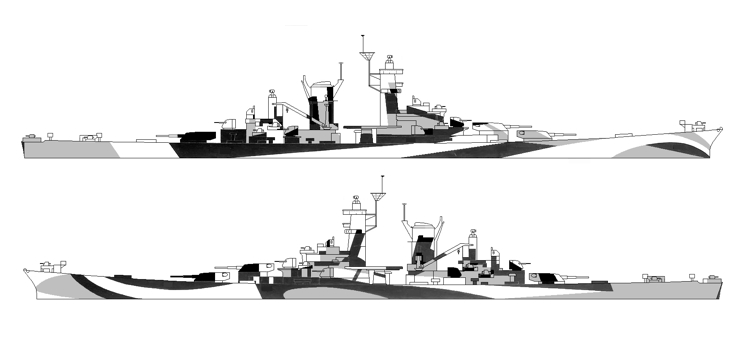
The silhouette from the drawing for Camouflage Design 32/7C drawn for the Alaska class large cruisers dated April 7, 1944. The specified vertical colors were dull black (BK), ocean gray (5-O) and light gray (5-L) with deck blue (20-B) and ocean gray (5-O) on the horizontal surfaces. This design was worn by USS Guam (CB-2).
This is the only drawing for Design 7C that has been found.
Original drawing source: NARA 80-G-109731 and 80-G-109732.
7D Designs
July 15, 1943 ? 7D in Measure 33 for DD-381

The earliest design drawing for Design 7D drawn for the Somers class destroyers dated July 15, 1943, has yet to be found.
A Design 7D drawing was attached to the July 15, 1943, memo to PacFleet for the DD-381 Somers class of destroyers. On August 19, 1943, it appeared for the Fletcher class destroyers. Design 7D was redrawn for the Farragut class destroyers, the Gamble class light minelayers and for the Chandler class high speed minesweepers; it was worn by, at least, USS Gamble (DM-15), USS Sicard (DM-21) and USS Hamilton (DMS-18). This design was also slightly modified and drawn for the Portland class heavy cruisers on March 21, 1944, using three colors and worn by the cruisers USS Portland (CA-33) and USS Indianapolis (CA-35) and it was worn by the battleship USS West Virginia (BB-48).
Original drawing source: NARA ?
August 19, 1943 7D in open Measure 3_ for DD-445
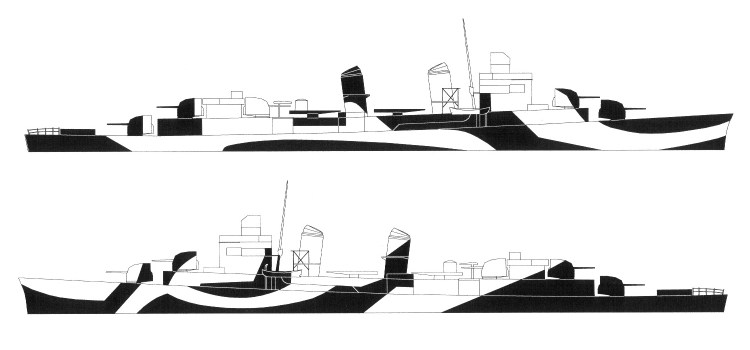
A silhouette of the drawing for Design 7D for the Fletcher class destroyers dated August 19, 1943. The colors were not specified, but it could be used for multiple measures. Starting with the darkest color of dull black (BK), if the lightest vertical color was light gray (5-L) it would be Measure 32. If the lightest color used were ocean gray (5-O) or haze gray (5-H), then this would result in Measure 31.
A Design 7D drawing was attached to the July 15, 1943, memo to PacFleet for the DD-381 Somers class of destroyers. On August 19, 1943, it appeared for the Fletcher class destroyers. Design 7D was redrawn for the Farragut class destroyers, the Gamble class light minelayers and for the Chandler class high speed minesweepers; it was worn by, at least, USS Gamble (DM-15), USS Sicard (DM-21) and USS Hamilton (DMS-18). This design was also slightly modified and drawn for the Portland class heavy cruisers on March 21, 1944, using three colors and worn by the cruisers USS Portland (CA-33) and USS Indianapolis (CA-35) and it was worn by the battleship USS West Virginia (BB-48).
Original drawing source: NARA 80-G-157410 and 80-G-157411.
January 1944 ? 7D in Measure 31 for DD-348
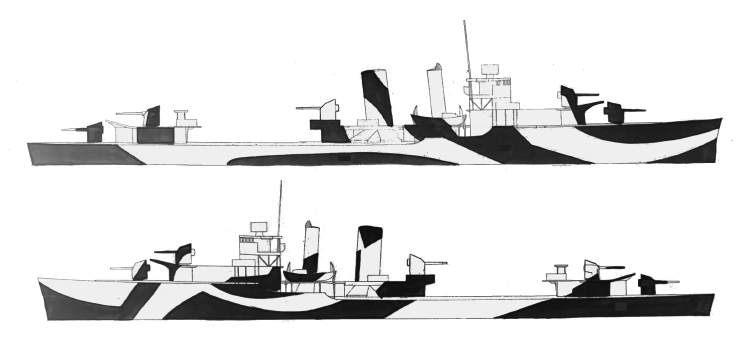
A silhouette of the design drawing for Measure 31/7D drawn probably in January 1944, for the Farragut class destroyers.
A Design 7D drawing was attached to the July 15, 1943, memo to PacFleet for the DD-381 Somers class of destroyers. On August 19, 1943, it appeared for the Fletcher class destroyers. Design 7D was redrawn for the Farragut class destroyers, the Gamble class light minelayers and for the Chandler class high speed minesweepers; it was worn by, at least, USS Gamble (DM-15), USS Sicard (DM-21) and USS Hamilton (DMS-18). This design was also slightly modified and drawn for the Portland class heavy cruisers on March 21, 1944, using three colors and worn by the cruisers USS Portland (CA-33) and USS Indianapolis (CA-35) and it was worn by the battleship USS West Virginia (BB-48).
Original drawing source: NARA 80-G-157917 and 80-G-157918.
September 1943 ? 7D in Measure 31 for BB-46
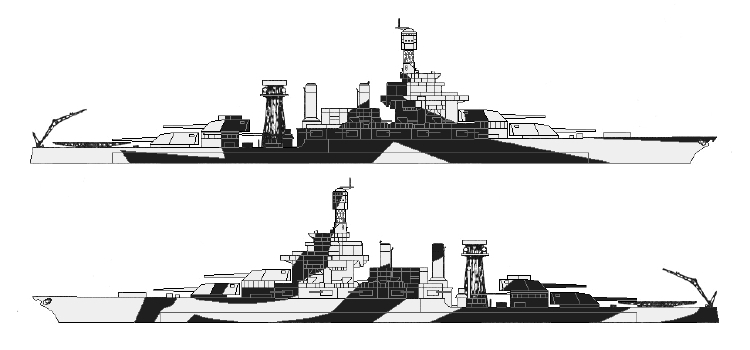
The Design drawing for camouflage carried by USS Maryland (BB-46) has not yet been found, but probably looked like this and was drawn in 1943, since Maryland was photographed in this camouflage in early October 1943 and again in April 1944. The vertical colors were probably Measure 31: dull black (BK) and ocean gray (5-O). The October photo shows Maryland probably painting or repainting this camouflage. Maryland's camouflage has been labeled with other design numbers at other sources, but I feel that it most closely resembles Design 7D especially from the port side. Also, Maryland was designated to receive camouflage Measure 31/7D in a memo from PacFleet to BuShips in August 1943.
A Design 7D drawing was attached to the July 15, 1943, memo to PacFleet for the DD-381 Somers class of destroyers. On August 19, 1943, it appeared for the Fletcher class destroyers. Design 7D was redrawn for the Farragut class destroyers, the Gamble class light minelayers and for the Chandler class high speed minesweepers; it was worn by, at least, USS Gamble (DM-15), USS Sicard (DM-21) and USS Hamilton (DMS-18). This design was also slightly modified and drawn for the Portland class heavy cruisers on March 21, 1944, using three colors and worn by the cruisers USS Portland (CA-33) and USS Indianapolis (CA-35) and it was worn by the battleship USS West Virginia (BB-48).
Original drawing source: NARA ?
March 18, 1944 7D in Measure 32 for BB-45
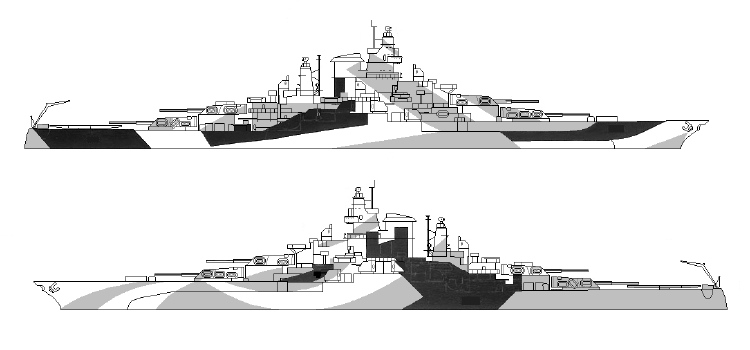
The design silhouette for Measure 32/7D for the Colorado class battleships as modernized dated March 18, 1944. The Measure 32 vertical colors were light gray (5-L), ocean gray (5-O) and dull black (BK). This version of 7D was worn by USS West Virginia (BB-48) and has some slight resemblances with the previous version worn by USS Maryland (BB-46).
A Design 7D drawing was attached to the July 15, 1943, memo to PacFleet for the DD-381 Somers class of destroyers. On August 19, 1943, it appeared for the Fletcher class destroyers. Design 7D was redrawn for the Farragut class destroyers, the Gamble class light minelayers and for the Chandler class high speed minesweepers; it was worn by, at least, USS Gamble (DM-15), USS Sicard (DM-21) and USS Hamilton (DMS-18). This design was also slightly modified and drawn for the Portland class heavy cruisers on March 21, 1944, using three colors and worn by the cruisers USS Portland (CA-33) and USS Indianapolis (CA-35) and it was worn by the battleship USS West Virginia (BB-48).
Original drawing source: NARA 80-G-109733 and 80-G-109734.
March 21, 1944 7D in Measure 32 for CA-33
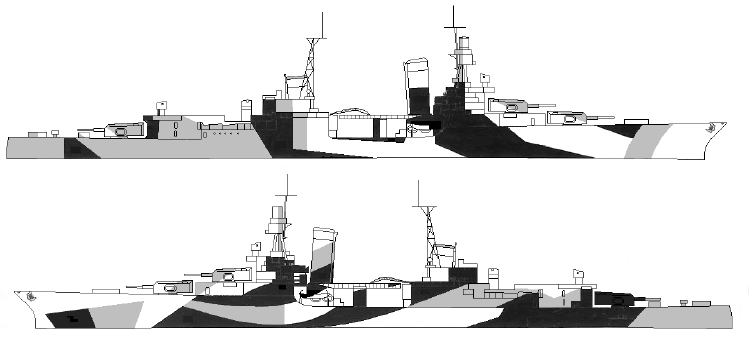
A silhouette of the design drawing for Measure 32/7D for Portland class heavy cruisers drawn on March 21, 1944. The 7D pattern has been slightly changed to accomodate a third color.
A Design 7D drawing was attached to the July 15, 1943, memo to PacFleet for the DD-381 Somers class of destroyers. On August 19, 1943, it appeared for the Fletcher class destroyers. Design 7D was redrawn for the Farragut class destroyers, the Gamble class light minelayers and for the Chandler class high speed minesweepers; it was worn by, at least, USS Gamble (DM-15), USS Sicard (DM-21) and USS Hamilton (DMS-18). This design was also slightly modified and drawn for the Portland class heavy cruisers on March 21, 1944, using three colors and worn by the cruisers USS Portland (CA-33) and USS Indianapolis (CA-35) and it was worn by the battleship USS West Virginia (BB-48).
Original drawing source: NARA 80-G-109725 and 80-G-109726.
June 14, 1944 7D in Measure 32 for DM-15
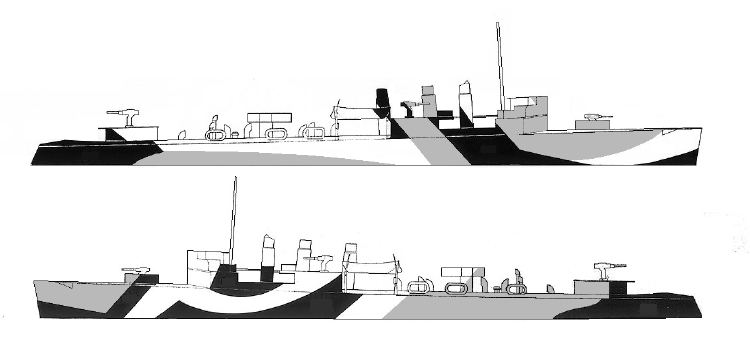
The silhouette for the design drawing for Measure 32/7D for the Gamble class light minelayers modified from four stack destroyers dated June 14, 1944. This version of Design 7D is also using three colors. The lightest vertical color light gray (5-L) could be replaced by haze gray (5-O) to make this Measure 31.
A Design 7D drawing was attached to the July 15, 1943, memo to PacFleet for the DD-381 Somers class of destroyers. On August 19, 1943, it appeared for the Fletcher class destroyers. Design 7D was redrawn for the Farragut class destroyers, the Gamble class light minelayers and for the Chandler class high speed minesweepers; it was worn by, at least, USS Gamble (DM-15), USS Sicard (DM-21) and USS Hamilton (DMS-18). This design was also slightly modified and drawn for the Portland class heavy cruisers on March 21, 1944, using three colors and worn by the cruisers USS Portland (CA-33) and USS Indianapolis (CA-35) and it was worn by the battleship USS West Virginia (BB-48).
Original drawing source: NARA 80-G-173486 and 80-G-13487.
June 14, 1944 7D in Measure 32 for DMS-9
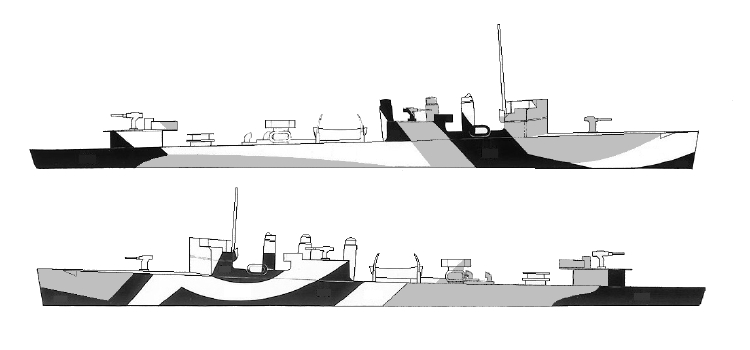
This is a silhouette from the drawing for Design 7D drawings for the Chandler class high speed minesweepers produced on June 14, 1944. This drawing was almost identical to the previous version except the slightly different ship profile; both drawings were dated on the same day. The colors shown are also Measure 32: dull black (BK), ocean gray (5-O) and light gray (5-L).
A Design 7D drawing was attached to the July 15, 1943, memo to PacFleet for the DD-381 Somers class of destroyers. On August 19, 1943, it appeared for the Fletcher class destroyers. Design 7D was redrawn for the Farragut class destroyers, the Gamble class light minelayers and for the Chandler class high speed minesweepers. This design was also slightly modified and drawn for the Portland class heavy cruisers on March 21, 1944, using three colors and worn by the cruisers USS Portland (CA-33) and USS Indianapolis (CA-35) and it was worn by the battleship USS West Virginia (BB-48).
Original drawing source: NARA 80-G-173484 and 80-G-173485.
June 16, 1944 7D in Measure 32 for DD-445

This is a silhouette of what was a reissue of the Design 7D drawings for the Fletcher class Destroyers. This drawing was almost identical to the earlier Fletcher drawing but used Measure 32 colors: light gray (5-L) and dull black (BK) and added details such as a deck pattern and turret fronts and backs.
A Design 7D drawing was attached to the July 15, 1943, memo to PacFleet for the DD-381 Somers class of destroyers. On August 19, 1943, it appeared for the Fletcher class destroyers. Design 7D was redrawn for the Farragut class destroyers, the Gamble class light minelayers and for the Chandler class high speed minesweepers. This design was also slightly modified and drawn for the Portland class heavy cruisers on March 21, 1944, using three colors and worn by the cruisers USS Portland (CA-33) and USS Indianapolis (CA-35) and it was worn by the battleship USS West Virginia (BB-48).
Original drawing source: NARA 80-G-1003980 and 80-G-100399.
7L Designs
July 25, 1944 7L in Measure 31 for LCT-1-500
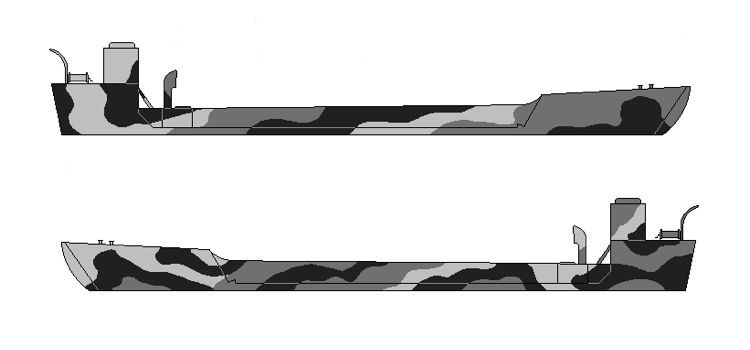
The silhouette from the drawing for Measure 31 Design 7L for the LCT-1 to LCT-500 class of tank landing craft dated July 25, 1944. The specified vertical colors were dull black (BK), navy green (5-NG) and ocean green (5-OG) with deck green (20-G) and black deck paint on horizontal surfaces.
This is the only version of Design 7L yet found.
Original drawing source: NARA BS 72176 and BS 72177.
7P Designs
May 1, 1944 7P in Measure 31 32 and 33 for PT Boats
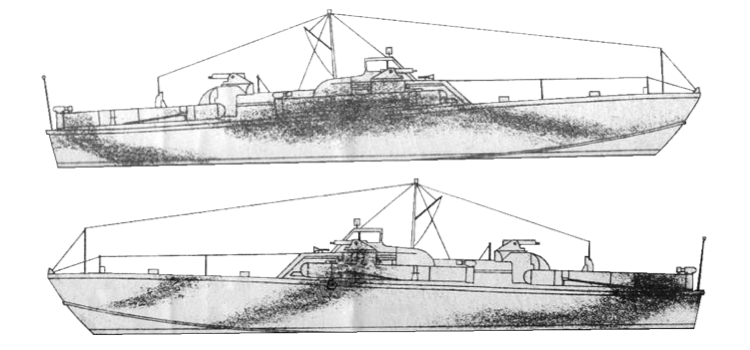
The silhouette from the drawing for Measure 31, 32 or 33 Design 7P for PT boats all drawn on May 1, 1944. The specified vertical colors were for Measure 31: navy green (5-NG) sprayed over motor torpedo boat green, Measure 32: ocean green (5-OG) or motor torpedo boat green sprayed over light gray (5-L) and Measure 33: ocean green sprayed over pale green (5-PG) with deck green (20-G) and motor torpedo boat green deck paint on horizontal surfaces. The drawing included directions for mixing motor torpedo boat green: four parts of ocean green with one part of navy green.
These are the only drawings for Design 7P yet found.
Original drawing source: Measure 31: NARA 19-N-72202 and 19-N-72208, Measure 32: NARA 19-N-72212 and 19-N-72213, Measure 33: NARA 19-N-72205 and 19-N-72215.
8A Designs
December 1943 8A in Measure 3_ for CVL-22
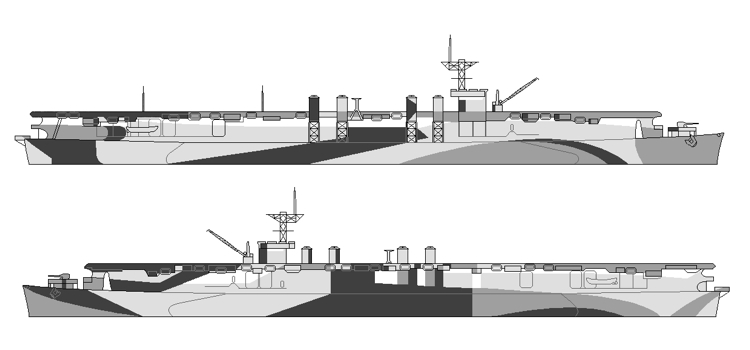
The silhouette from the drawing for Design 8A for the Independence class light carriers probably dated December 9, 1943. The drawing had been titled Measure 32, but the 2 was erased to create the “open” Measure design. The vertical colors were not identified, but the Measure 33 colors would normally be navy blue (5-N), haze gray (5-H) and pale gray (5-P) and the horizontal surfaces were deck blue (20-B).
There have been no other versions of Design 8A found.
Original drawing source: NARA 80-G-170023 and 80-G-170024.
8Ax Designs
April 7, 1944 8Ax in Measure 32 for AV-14
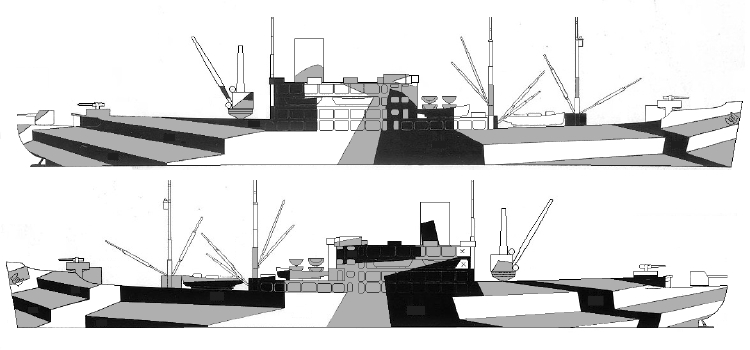
This is the silhouette of the only design drawing for Design 8Ax in Measure 32 drawn for the USS Kenneth Whiting (AV-14) class of seaplane tenders modified from a C-3 type hull dated April 7, 1944. The Measure 32 colors were dull black (BK), haze gray (5-H) and pale gray (5-P). The pattern both port and starboard is very much like the Fletcher class 9D pattern and consists of a wedge of ocean gray and black centered in the middle of the hull at the bridge flanked by false perspective “stairs” with dark sets to the left and light sets to the right. Because of the similarity of Design 8Ax and both Design 9D and Design 2F, Design 8Ax was probably developed from the same source.
This is the only version of Design 8Ax that has been found.
Original drawing source: NARA 80-G-172989 and 80-G-172990.
8B Designs
October 11, 1944 8B in Measure 31a for BB-34
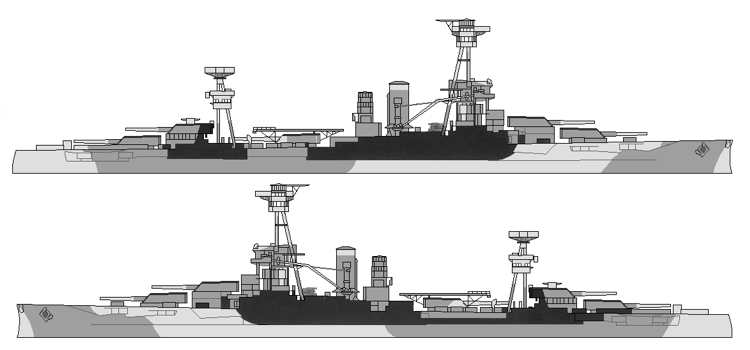
The silhouette from the drawing for Design 8B drawn for the New York class battleships dated October 11, 1944, using the Measure 31a colors of navy blue (5-N), ocean gray (5-O) and haze gray (5-H) on vertical surfaces with deck blue (20-B) on the horizontal surfaces. Note, the pattern is nearly identical on both port and starboard.
There have been no other versions of Design 8B found.
Original drawing source: NARA 19-N-73640 and 19-N-73641.
8C Designs
July 28, 1944 8C in Measure 33 for CL-40
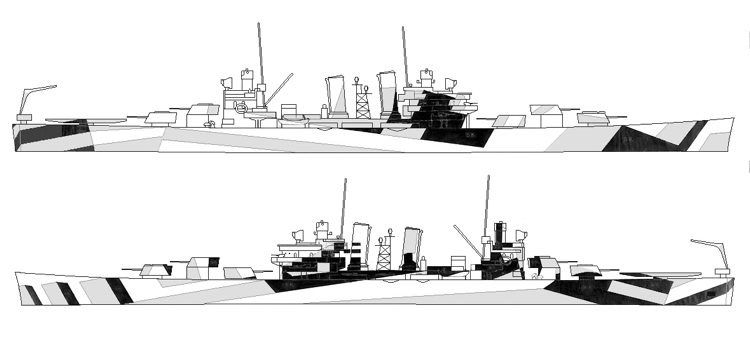
The silhouette from the drawing for Measure 33/8C for the Brooklyn class light cruisers drawn on July 28, 1944. The vertical colors were specified to be pale gray (5-P), haze gray (5-H) and navy blue (5-N) with a pattern of ocean gray (5-O) and deck blue (20-B) on the horizontal surfaces.
Design 8C shows themes and influences from some other designs. The port bow panels are reminiscent of similar panels on Design 10A and both port and starboard stern areas show influences from Design 16D. There have been no other drawings of Design 8C found.
Original drawing source: NARA 80-G-176515 and 80-G-176516.
8F Designs
April 20, 1944 8F in Measure 32 for AGC-1
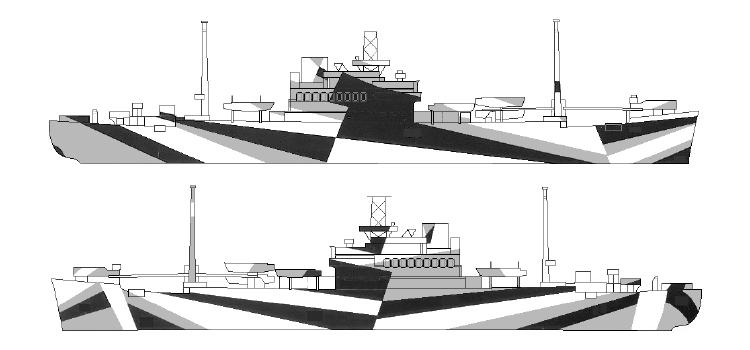
This is a silhouette of the earliest design drawing for Measure 32/8F drawn for the Appalachian class amphibious command ships dated April 20, 1944. This drawing specifies vertical colors of light gray (5-L), ocean gray (5-O) and dull black (BK) with the horizontal color of deck blue (20-B).
The first drawing for Design 8F was for the Appalachian class amphibious command ships on April 20, 1944, as above. Then Design 8F was drawn for the Hyades class stores ships on June 14, 1944, and later on July 1 for the Bogue class escort carriers.
Original drawing source: NARA 80-G-172862 and 80-G-172875.
June 14, 1944 8F in Measure 32 for AF-28
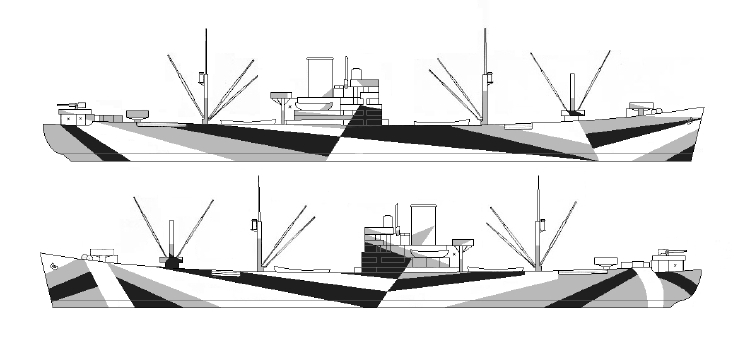
The design drawing for Measure 32/8F for the Hyades class stores ships. This drawing uses the (C2-S-E1) maritime hull and specifies three vertical colors: light gray (5-L), ocean gray (5-O) and dull black (BK) with the horizontal color of deck blue (20-B). This drawing also includes two waterlines: a load waterline and a lower camouflage line.
The first drawing for Design 8F was for the Appalachian class amphibious command ships on April 20, 1944. Then Design 8F was drawn for the Hyades class stores ships on June 14, 1944, and later on July 1 for the Bogue class escort carriers.
Original drawing source: NARA 80-G-174781 and 80-G-174782.
July 1, 1944 8F in Measure 33 for CVE-9

The silhouette of the drawing for Design 33/8F for the Bogue class escort carriers dated July 1, 1944. This drawing specifies vertical colors of pale gray (5-P), haze gray (5-H) and navy blue (5-N) with the horizontal color of deck blue (20-B). This version of Design 8F has been slightly modified from previous versions.
The first drawing for Design 8F was for the Appalachian class amphibious command ships on April 20, 1944. Then Design 8F was drawn for the Hyades class stores ships on June 14, 1944, and later on July 1 for the Bogue class escort carriers as above.
Original drawing source: NARA 80-G-174768 and 80-G-174769.
8L Designs
December 22, 1943 8L in Measure 31 for LST
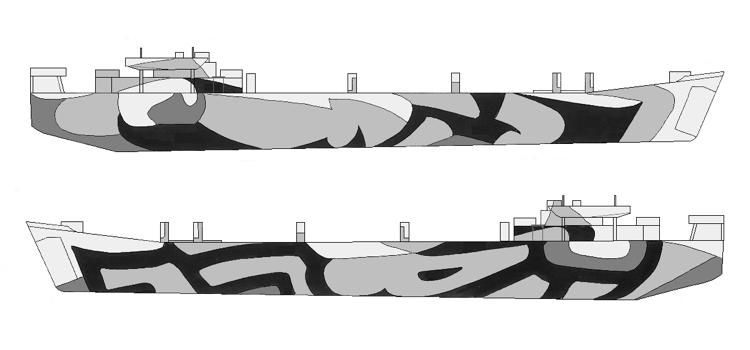
The silhouette from the drawing for Measure 31 Design 8L for LST and similar ships dated December 22, 1943. The specified vertical colors were dull black (BK), ocean green (5-OG), brown (4A) and haze gray (5-H) with navy green (5-NG) and glossy black deck paint on horizontal surfaces.
The first drawings of Design 8L was for LSTs on December 22, 1943, as above. Then drawings for Design 8L for the LCI(L)-351 class were drawn using Measure 31 and Measure 33 colors on December 31, 1943.
Original drawing source: NARA 80-G-162022 and 80-G-162023.
December 31, 1943 8L in Measure 31 for LCI(L)-351
351 8L.jpg)
The silhouette from the drawing for Measure 31 Design 8L for LCI(L)-351 class large infantry landing craft and similar ships dated December 31, 1943. The specified vertical colors were navy green (5-NG), ocean green (5-OG) and ocean brown (4-A) with deck green (20-G), ocean green and ocean brown paint on horizontal surfaces.
The first drawings of Design 8L was for LSTs on December 22, 1943. Then drawings for Design 8L for the LCI(L)-351 class were drawn using Measure 31, with a very different pattern as above, on December 31, 1943.
Original drawing source: NARA 80-G-165765 and 80-G-165766.
8P Designs
May 1, 1944 8P in Measure 32 for PT Boats
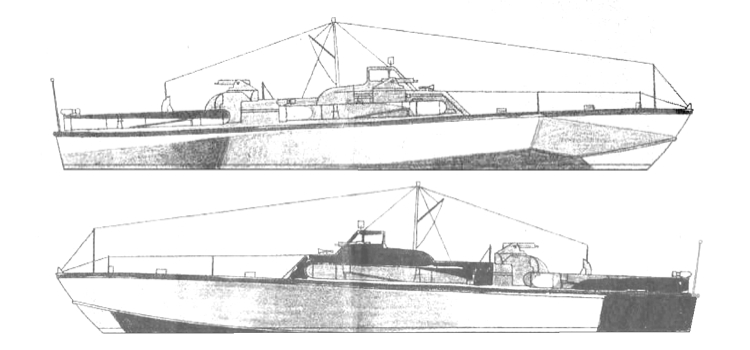
The silhouette from the drawing for Measure 32 Design 8P for PT boats drawn on May 1, 1944. The specified vertical colors were navy blue (5-N), ocean gray (5-O) and pale gray (5-P) with deck blue (20-B), ocean gray and pale gray deck paint on horizontal surfaces.
This is the only drawing for Design 8P yet found.
Original drawing source: NARA 19-N-72207 and 19-N-72209.
8T Designs
January 11, 1944 8T in Measure 32 for AKA-15
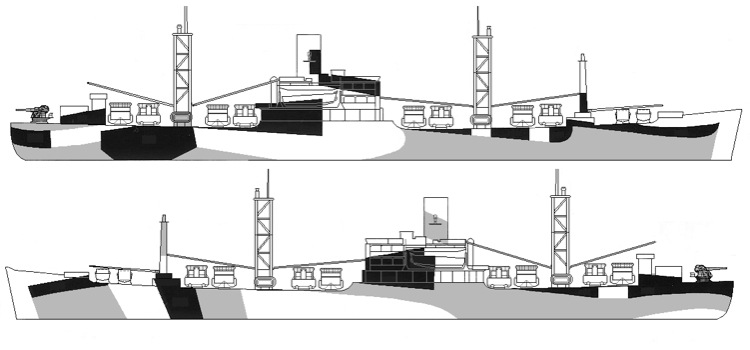
The silhouette from the drawing for Measure 32 Design 8T for the Andromeda class attack cargo ships using the (C2-S-B1) maritime hull dated January 11, 1944. This drawing specifies Measure 32 vertical colors: light gray (5-L), ocean gray (5-O), and dull black (BK) with the horizontal color of deck blue (20-B). The color of the boats was not specified. This drawing has a single waterline, the load waterline. A May 9, 1944, memo from the Bureau of Ships rescinded this drawing and forwarded a replacement that extended the pattern to the light load line. That drawing has not yet been found.
This is the only drawing for Design 8T that has yet been found.
Original drawing source: NARA 80-G-172987 and 80-G-172988.
9A Designs
December 24, 1943 9A in Measure 32 for CVE-1
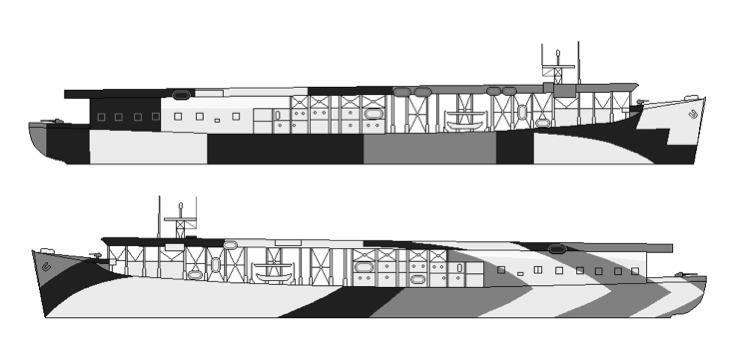
The silhouette from the drawing for Measure 32 Design 9A for the escort carrier USS Long Island (CVE-1) dated December 24, 1943. The specified vertical colors were dull black (BK), ocean gray (5-O) and light gray (5-L) with some panels of white (5-U) for countershading. The deck colors were not specified, but were probably deck blue (20-B).
This is the only version of Design 9A yet found.
Original drawing source: NARA 80-G-170027 and 80-G-170032.
9AO Designs
May 16, 1944 9AO in Measure 32 for AO-9
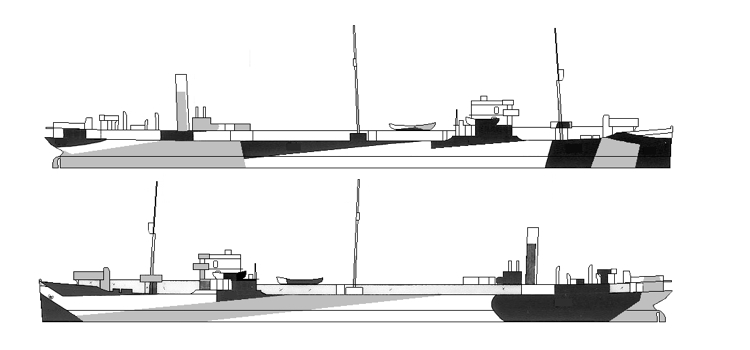
The silhouette from the drawing for Measure 32 Design 9AO for the oiler USS Patoka and similar ships dated May 16, 1944. The colors were Measure 32: dull black (BK), ocean gray (5-O) and light gray (5-L) on vertical surfaces and deck blue (20-B) on horizontal surfaces. This drawing also shows two waterlines.
There have been no other drawings for Design 9AO found.
Original drawing source: NARA 80-G-173260 and 80-G-173261.
9Ax Designs
April 20, 1944 9Ax in Measure 31 for IX-110
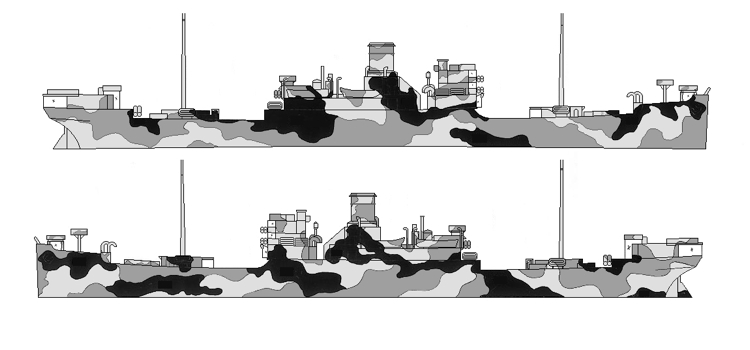
The silhouette from the drawing for Measure 31 Design 9Ax for the unclassified vessal USS Ocelot (IX-110) dated April 20, 1944. This drawing specifies vertical colors in the green range of Measure 31: ocean green (5-OG), navy green (5-NG), and dull black (BK) with the horizontal color of deck green (20-G).
This is the only drawing for Design 9Ax that has yet been found.
Original drawing source: NARA 80-G-172898 and 80-G-172899.
9C Designs
October 21, 1944 9C in Measure 31a for CA-68
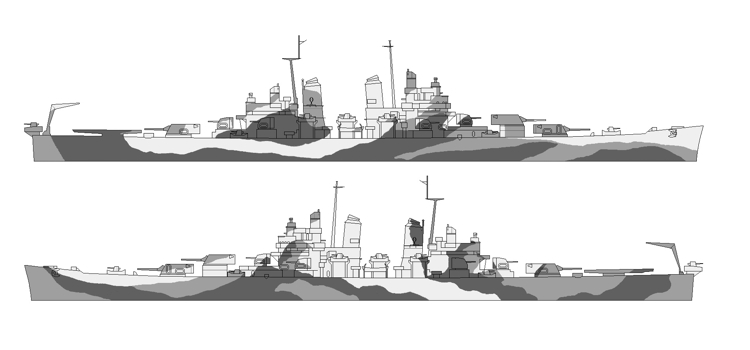
The silhouette from the drawing for Design 31a/9C drawn for the Baltimore class heavy cruisers dated October 21, 1944. The specified Measure 31a vertical colors were navy blue (5-N), ocean gray (5-O) and haze gray (5-H) with deck blue (20-B) with no pattern on the horizontal surfaces.
This is the only version of Design 9C that has been found.
Original drawing source: NARA 80-G-104917 and 80-G-104918.
9D Designs
July 15, 1943 ? 9D in Measure 31 for DD-445

The earliest design drawing for Design 9D drawn for the Fletcher class destroyers dated July 15, 1943, has yet to be found.
The first drawing for Design 9D was attached to the July 15, 1943, memo to PacFleet for Fletcher class. Design 9D later appeared again in March 1944 for the Fletcher class destroyers and was drawn in April 1944 for the Allen M. Sumner class destroyers. This design was redrawn on May 1, 1944, for Evarts class destroyer escorts; and on May 10, 1944, for the Dunlap class destroyers: Dunlap and Fanning. The cruiser USS Chester (CA-27) appeared in Design 9D beginning in June 1944. The camouflage worn by USS Ranger (CV-4) in July 1944 was a very good match for Design 9D even though the design was identified as 33/1A. Design 32/8Ax was an almost exact copy of 9D and was used by most of the ships of the Kenneth Whiting class of seaplane tenders.
Original drawing source: NARA ?
March 8, 1944 9D in Measure 31 for DD-445
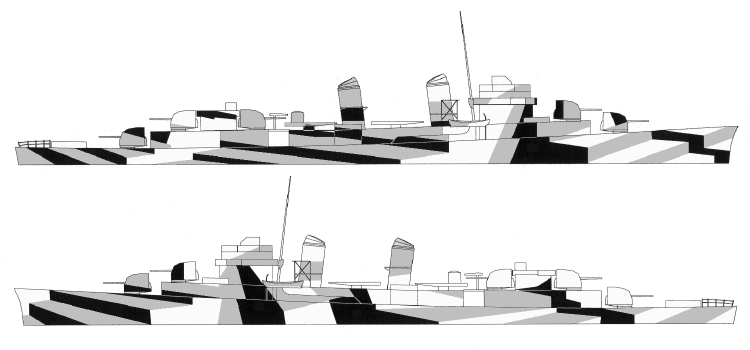
The design drawing for Measure 31/9D for the Fletcher class destroyers drawn on March 8, 1944. This drawing specified Measure 31 colors: dull black (BK), ocean gray (5-O) and haze gray (5-H), but by substituting light gray (5-L) for haze gray (5-H) on the vertical surfaces a ship would be in Measure 32. This Design 9D drawing is probably not very different from the first version in July 1943.
The first drawing for Design 9D was attached to the July 15, 1943, memo to PacFleet for the Fletcher class. Design 9D later appeared again in March 1944 for the Fletcher class destroyers and was drawn in April 1944 for the Allen M. Sumner class destroyers. This design was redrawn on May 1, 1944, for Evarts class destroyer escorts; and on May 10, 1944, for the Dunlap class destroyers: Dunlap and Fanning. The cruiser USS Chester (CA-27) appeared in Design 9D beginning in June 1944.
The following designs are very similar to 9D and may have derived from 9D or 2F: Design 1A for USS Ranger (CV-4) in July 1944, and Design 8Ax for the Kenneth Whiting class of seaplane tenders.
Original drawing source: NARA 80-G-170932 and 80-G-170933.
March 18, 1944 9D in Measure 32 for CA-27
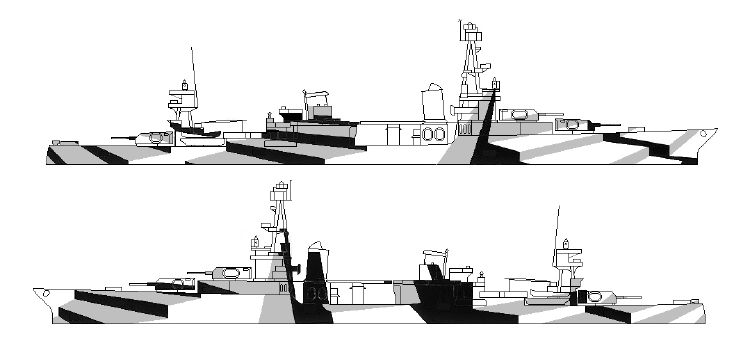
A silhouette of the design drawing for Measure 32/9D drawn on March 18, 1944, for the heavy cruiser USS Chester (CA-27). The pattern is still the same with a wedge of medium and dark at the bridge and sets of “stairs.” The light sets to the right (bow on starboard and stern on port) and dark sets to the left.
The first drawing for Design 9D was attached to the July 15, 1943, memo to PacFleet for Fletcher class. Design 9D later appeared again in March 1944 for the Fletcher class destroyers and was drawn in April 1944 for the Allen M. Sumner class destroyers. This design was redrawn on May 1, 1944, for Evarts class destroyer escorts; and on May 10, 1944, for the Dunlap class destroyers: Dunlap and Fanning. The cruiser USS Chester (CA-27) appeared in Design 9D beginning in June 1944. The camouflage worn by USS Ranger (CV-4) in July 1944 was a very good match for Design 9D even though the design was identified as 33/1A. Design 32/8Ax was an almost exact copy of 9D and was used by most of the ships of the Kenneth Whiting class of seaplane tenders.
Original drawing source: NARA 80-G-173263 and 80-G-173265.
April 6, 1944 9D in Measure 32 for DD-692
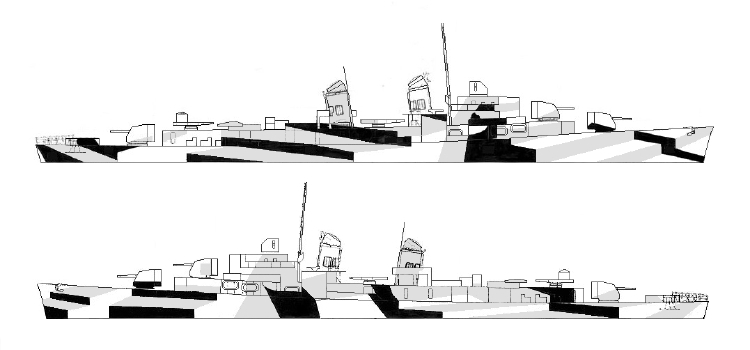
The design silhouette for Measure 32/9D for the Allen M. Sumner class destroyers drawn on April 6, 1944. The Measure 32 vertical colors were light gray (5-L), ocean gray (5-O) and dull black (BK). If haze gray (5-H) were used instead of light gray then it would be Measure 31. The pattern has remained the same with some changes around the superstructure and an additional set of “stairs” on the port bow.
The first drawing for Design 9D was attached to the July 15, 1943, memo to PacFleet for Fletcher class. Design 9D later appeared again in March 1944 for the Fletcher class destroyers and was drawn in April 1944 for the Allen M. Sumner class destroyers. This design was redrawn on May 1, 1944, for Evarts class destroyer escorts; and on May 10, 1944, for the Dunlap class destroyers: Dunlap and Fanning. The cruiser USS Chester (CA-27) appeared in Design 9D beginning in June 1944. The camouflage worn by USS Ranger (CV-4) in July 1944 was a very good match for Design 9D even though the design was identified as 33/1A. Design 32/8Ax was an almost exact copy of 9D and was used by most of the ships of the Kenneth Whiting class of seaplane tenders.
Original drawing source: NARA 80-G-170938 and 80-G-170939.
April 28, 1944 9D in Measure 33 for AK-99
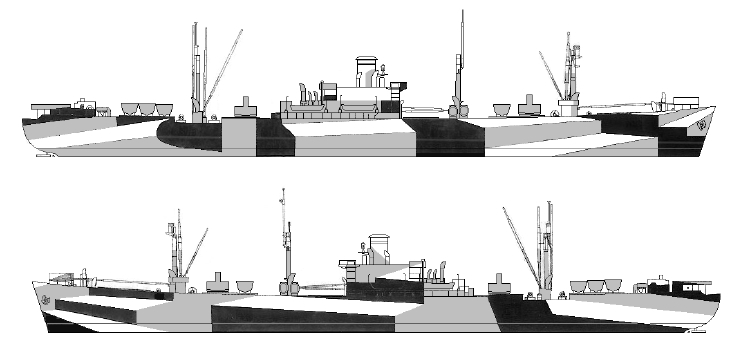
A silhouette of the design drawing for Measure 33/9D for the Bootes class of cargo ships drawn on April 28, 1944. The Measure 33 colors specified were navy blue (5-N), haze gray (5-H) and pale gray (5-P); the Measure 32 colors would be dull black (BK), ocean gray (5-O) and light gray (5-L). The distinctive 9D pattern has been only slightly modified.
The first drawing for Design 9D was attached to the July 15, 1943, memo to PacFleet for the Fletcher class. Design 9D later appeared again in March 1944 for the Fletcher class destroyers and was drawn in April 1944 for the Allen M. Sumner class destroyers. This design was redrawn on May 1, 1944, for Evarts class destroyer escorts; and on May 10, 1944, for the Dunlap class destroyers: Dunlap and Fanning. The cruiser USS Chester (CA-27) appeared in Design 9D beginning in June 1944. The camouflage worn by USS Ranger (CV-4) in July 1944 was a very good match for Design 9D even though the design was identified as 33/1A. Design 32/8Ax was an almost exact copy of 9D and was used by most of the ships of the Kenneth Whiting class of seaplane tenders.
Original drawing source: NARA 80-G-172892 and 80-G-172893.
May 1, 1944 9D in Measure 32 for DE-5
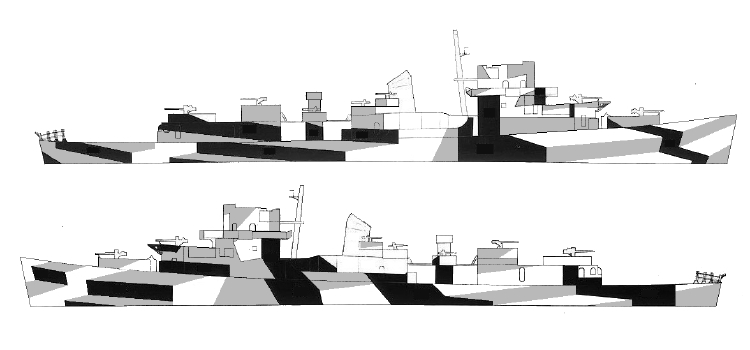
The silhouette for the design drawing for Measure 32/9D for the Evarts class destroyer escorts drawn on May 1, 1944. The Measure 32 vertical colors were dull black (BK), ocean gray (5-O) and light gray (5-L) and the Measure 31 colors would be dull black, ocean gray and haze gray (5-H). This version of Design 9D is very similar to the earlier Sumner class version.
The first drawing for Design 9D was attached to the July 15, 1943, memo to PacFleet for the Fletcher class. Design 9D later appeared again in March 1944 for the Fletcher class destroyers and was drawn in April 1944 for the Allen M. Sumner class destroyers. This design was redrawn on May 1, 1944, for Evarts class destroyer escorts; and on May 10, 1944, for the Dunlap class destroyers: Dunlap and Fanning. The cruiser USS Chester (CA-27) appeared in Design 9D beginning in June 1944. The camouflage worn by USS Ranger (CV-4) in July 1944 was a very good match for Design 9D even though the design was identified as 33/1A. Design 32/8Ax was an almost exact copy of 9D and was used by most of the ships of the Kenneth Whiting class of seaplane tenders.
Original drawing source: NARA 80-G-172865 and 80-G-172867.
May 10 , 1944 9D in Measure 32 for DD-384
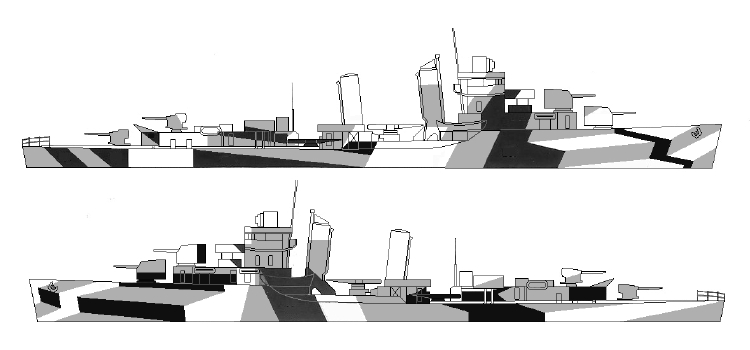
This is the silhouette of Design 9D in Measure 32 colors drawn for the Dunlap class destroyers dated May 10, 1944. The Measure 32 vertical colors were dull black (BK), ocean gray (5-O) and light gray (5-L) and the Measure 31 colors would be dull black, ocean gray and haze gray (5-H). This version of Design 9D is a very good match to the previous versions for destroyers and destroyer escorts.
The first drawing for Design 9D was attached to the July 15, 1943, memo to PacFleet for the Fletcher class. Design 9D later appeared again in March 1944 for the Fletcher class destroyers and was drawn in April 1944 for the Allen M. Sumner class destroyers. This design was redrawn on May 1, 1944, for Evarts class destroyer escorts; and on May 10, 1944, for the Dunlap class destroyers: Dunlap and Fanning. The cruiser USS Chester (CA-27) appeared in Design 9D beginning in June 1944. The camouflage worn by USS Ranger (CV-4) in July 1944 was a very good match for Design 9D even though the design was identified as 33/1A. Design 32/8Ax was an almost exact copy of 9D and was used by most of the ships of the Kenneth Whiting class of seaplane tenders.
Original drawing source: NARA 80-G-109637 and 80-G-109638.
June 30, 1944 9D in Measure 31 for DD-380
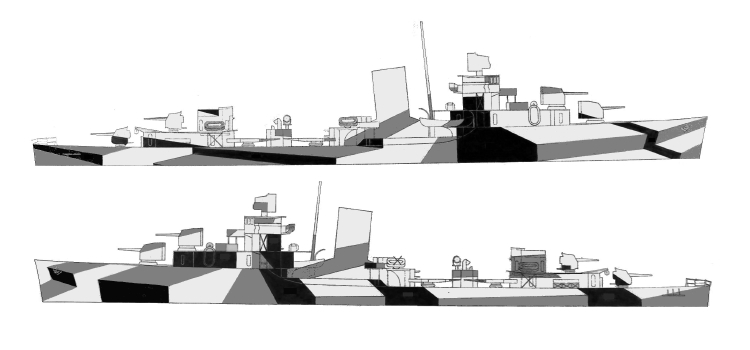
This is a silhouette from the drawing for Design 9D drawings for the Gridley class destroyers produced on June 30, 1944. The specified vertical colors were unusual for Measure 31: dull black (BK), navy blue (5-N) and haze gray (5-H) with ocean gray (5-O) and deck blue (20-B) on horizontal surfaces. The Measure 32 vertical colors would have been dull black (BK), ocean gray (5-O) and light gray (5-L). This version of Design 9D is very similar to previous versions except for the colors.
The first drawing for Design 9D was attached to the July 15, 1943, memo to PacFleet for the Fletcher class. Design 9D later appeared again in March 1944 for the Fletcher class destroyers and was drawn in April 1944 for the Allen M. Sumner class destroyers. This design was redrawn on May 1, 1944, for Evarts class destroyer escorts; and on May 10, 1944, for the Dunlap class destroyers: Dunlap and Fanning. The cruiser USS Chester (CA-27) appeared in Design 9D beginning in June 1944. The camouflage worn by USS Ranger (CV-4) in July 1944 was a very good match for Design 9D even though the design was identified as 33/1A. Design 32/8Ax was an almost exact copy of 9D and was used by most of the ships of the Kenneth Whiting class of seaplane tenders.
Original drawing source: NARA 80-G-100382 and 80-G-100383.
9F Designs
May 27, 1944 9F in Measure 32 for AK-90
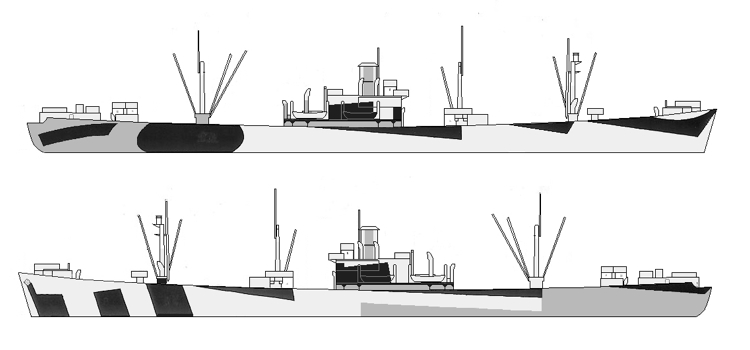
The silhouette from the drawing for Measure 32 Design 9F for the USS Albireo (AK-90) and cargo ships using the (EC2-S-C1) maritime hull dated May 27, 1944. This drawing specifies vertical colors of light gray (5-L), ocean gray (5-O), and dull black (BK) with pale gray (5-P) on the upper masts and booms and the horizontal color of deck blue (20-B). This drawing has a single waterline, the load waterline, so some ships may have painted camouflage below that line.
This is the only drawing for Design 9F that has yet been found.
Original drawing source: NARA 80-G-172886 and 80-G-172887.
9L Designs
January 12, 1944 9L in Measure 31 for LSD-1
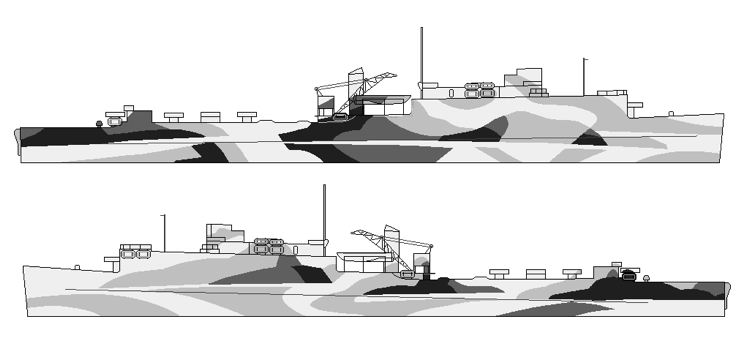
The silhouette from the drawing for Measure 31 Design 9L for the LSD-1 class dock landing ships dated January 12, 1944. The specified vertical colors were dull black (BK), navy green (5-NG), ocean green (5-OG), haze gray (5-H) and light gray (5-L), with black, deck green, ocean green, deck blue and ocean gray paint on horizontal surfaces.
This is the only version of Design 9L yet found.
Original drawing source: NARA 80-G-170030 and 80-G-170031.
9P Designs
June 10, 1944 9P in Measure 32 for 110' subchasers
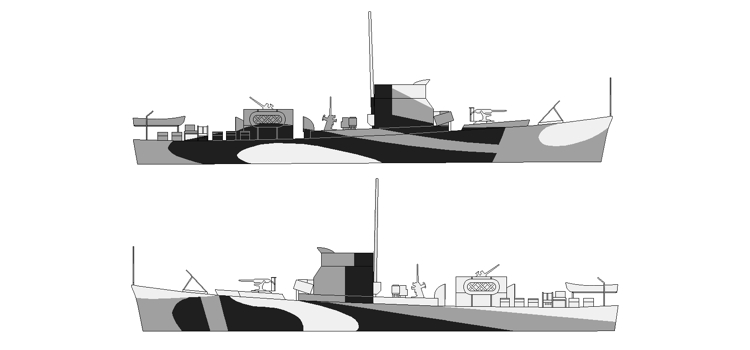
The silhouette from the drawing for Measure 32 Design 9P for 110-foot subchasers dated June 10, 1944. The specified vertical colors were dull black (BK), ocean gray (5-O) and light gray (5-L), with deck blue (20-B) on horizontal surfaces.
This is the only drawing for Design 9P that has yet been found.
Original drawing source: NARA 80-G-173490 and 80-G-173491.
9T Designs
June 1, 1944 9T in Measure 32 for APA-6

The earliest design drawing for Design 9T drawn for the Heywood class attack transports dated June 1, 1944. This drawing specified Measure 32 vertical colors of light gray (5-L), ocean gray (5-O), and dull black (BK). There was also no specific color identified for the landing boats.
The first drawing for Design 9T was for the Heywood class attack transports as above on June 1, 1944. Then 9T was drawn for the the Uranus class stores ships on July 14, 1944.
Original drawing source: NARA 80-G-105490 and 80-G-105491.
July 14, 1944 9T in Measure 32 for AF-14
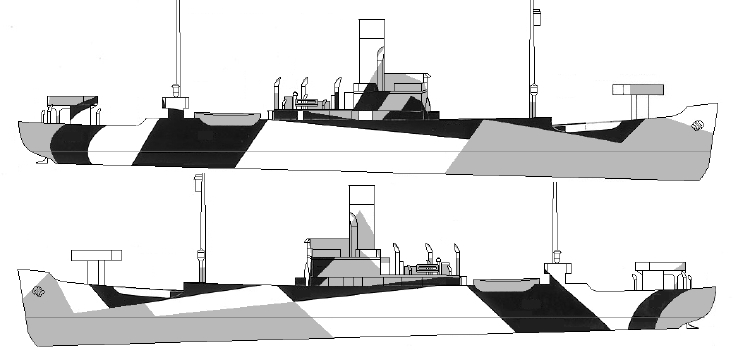
This the silhouette of the drawing for Design 9T for the Uranus class stores ships drawn on July 14, 1944. This drawing included two waterlines: the load line and the light load waterline. This version also used the standard vertical colors for Measure 32: dull black (BK), ocean gray (5-O) and light gray (5-L). There have been a few modifications in this version of Design 9T in the month and a half since the previous version.
The first drawing for Design 9T was for the Heywood class attack transports on June 1, 1944. Then 9T was drawn for the the Uranus class stores ships on July 14, 1944, as above.
Original drawing source: NARA 80-G-174750 and 80-G-174751.
10A Designs
January 19, 1944 10A in Measure 33 for CV-9
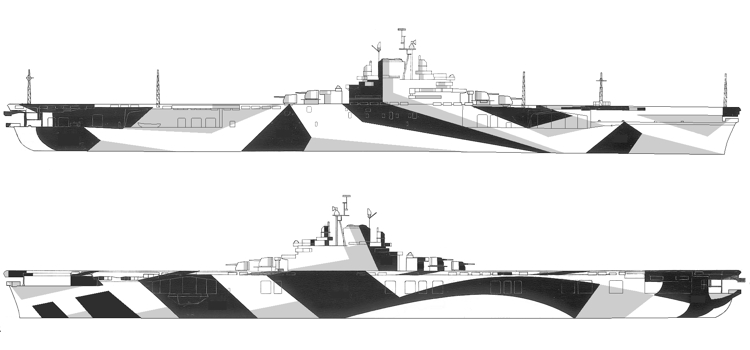
This is a silhouette of the earliest design drawing for Design 10A drawn for the Essex class carriers dated January 19, 1944. This drawing specified vertical colors to be navy blue (5-N), ocean gray (5-O) and light gray (5-L) in Measure 33. The long sloping panels on starboard seem to be an attempt to confuse the length and rotation of the ship. The port side has panels of decending size to give a false perspective sense of rotation.
Design 10A was first drawn as above for the Essex class carriers on January 19, 1944. Shortly after that it was drawn for the Sangamon class escort carriers. Then on February 16, 1944 Design 10A was drawn for the Casablanca class escort carriers.
Original drawing source: NARA 80-G-170025.
January 1944 ? 10A in Measure 33 for CVE-26
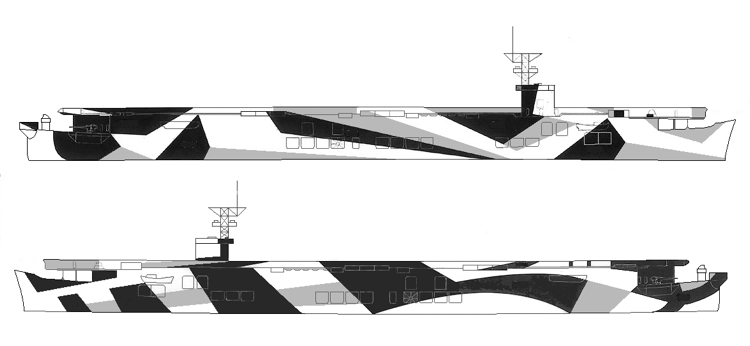
The design drawing for Measure 33/10A for the Sangamon class escort carriers probably drawn in January 1944. This drawing specifies vertical colors of light gray (5-L), ocean gray (5-O) and navy blue (5-N). The pattern in this version is merely scaled down from the Essex version and maintains the false perspectives of each side.
Design 10A was first drawn for the Essex class carriers on January 19, 1944. Shortly after that it was drawn for the Sangamon class escort carriers as above. Then on February 16, 1944 Design 10A was drawn for the Casablanca class escort carriers.
Original drawing source: NARA 80-G-165751 and 80-G-165752.
February 16, 1944 10A in Measure 33 for CVE-55
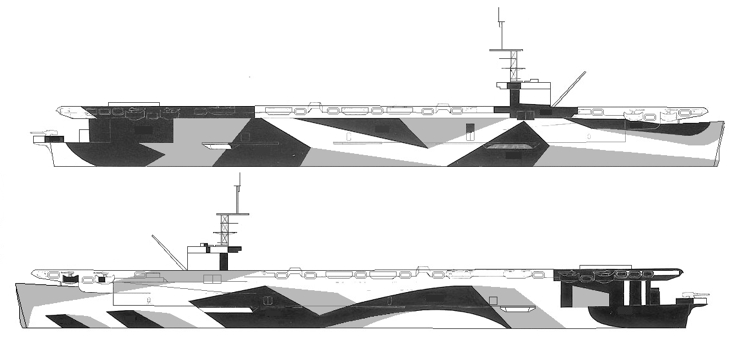
The silhouette of the Measure 33 Design 10A drawings for the Casablanca class escort carriers dated February 16, 1944. The Measure 33 colors are navy blue (5-N), haze gray (5-H) and pale gray (5-P) vertically. This version of 10A has been slightly modified from the previous. The port stern panels are intended to give the impression of seeing the stern from an angle.
Design 10A was first drawn for the Essex class carriers on January 19, 1944. Shortly after that it was drawn for the Sangamon class escort carriers. Then on February 16, 1944 Design 10A was drawn for the Casablanca class escort carriers.
Original drawing source: NARA 80-G-170035 and 80-G-170036.
10AO Designs
June 12, 1944 10AO in Measure 32 for AO-22
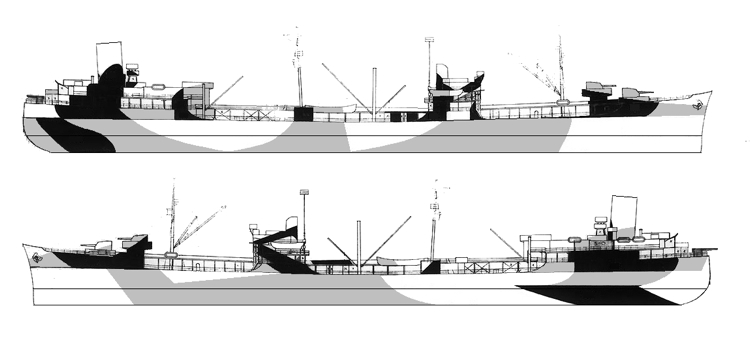
The silhouette from the drawing for Design 32/10AO for the Cimarron class of fleet oilers with T3 type maritime hulls. The date was June 12, 1944, and this drawing depicts two 5-inch gun mounts on the bow. The specified colors were Measure 32: dull black (BK), ocean gray (5-O) and light gray (5-L) on the vertical surfaces with deck blue on horizontal surfaces. This drawing also shows two waterlines.
This is the only Design 10AO that has been found.
Original drawing source: NARA 80-G-173492 and 80-G-173493.
10Ax Designs
April 28, 1944 10Ax in Measure 32 for AS-13
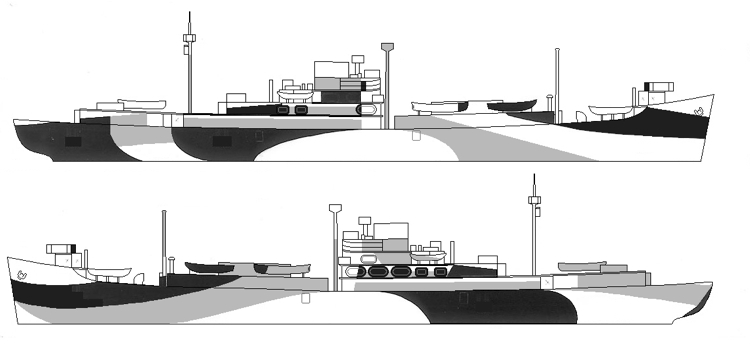
The silhouette from the drawing for Measure 32 Design 10Ax for the Griffin class of submarne tenders using a C3 maritime hull dated April 28, 1944. This drawing specified vertical colors of light gray (5-L), ocean gray (5-O), and dull black (BK) with the horizontal color of deck blue (20-B).
This is only drawing for Design 10Ax that has yet been found.
Original drawing source: NARA 80-G-174764 and 80-G-174765.
10C Designs
November 1, 1944 10C in Measure 31a for CL-55
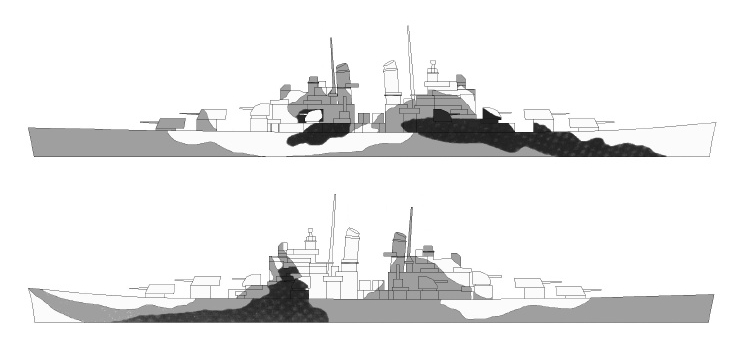
The silhouette from the drawing for Measure 31a/10C for the Cleveland class light cruisers dated November 1, 1944. The vertical colors were specified to be haze gray (5-H), ocean gray (5-O) and navy blue (5-N) with solid deck blue (20-B) on the horizontal surfaces.
There have been no other drawings of Design 10C found.
Original drawing source: NARA 80-G-100394 and 80-G-100395.
10D Designs
July 15, 1943 ? 10D in Measure 31 for DD-384
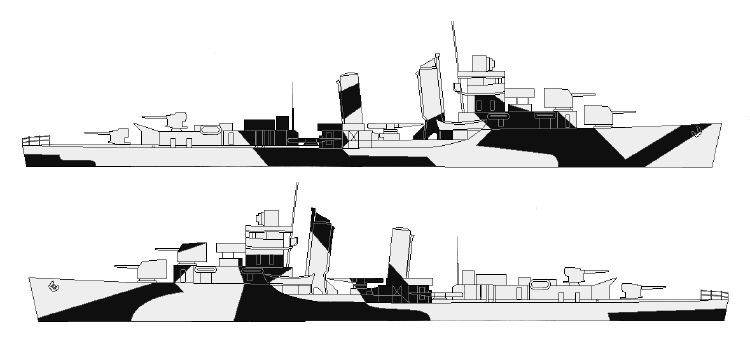
This is what the earliest design drawing for Design 10D drawn for the Dunlap class destroyers dated July 15, 1943, may have looked like. The original has yet to be found. The Measure 31 vertical colors should have been ocean gray (5-O) and dull black (BK) with deck blue (20-B) and possibly ocean gray on horizontal surfaces.
A Design 10D drawing was attached to the July 15, 1943, memo to PacFleet for the DD-384 Dunlap class using Measure 31 probably similar to the above. USS Pensacola (CA-24) appeared at Pearl Harbor in October 1943 in 33/10D. Design 10D was used as a design for the carrier USS Essex (CV-9) that was labeled 32/6-10D and applied during April 1944. The number 6 comes from a table used in some memos between the Bureau of Ships and Pacific Fleet around August 1943. This table listed camouflage designs and the sixth listing in the table under “Patterns” was Design 10D. Design 10D was also drawn for the Buckley class destroyer escorts on December 30, 1943.
Original drawing source: NARA ?
July, 1943 10D in open Measure 32 for CV-9
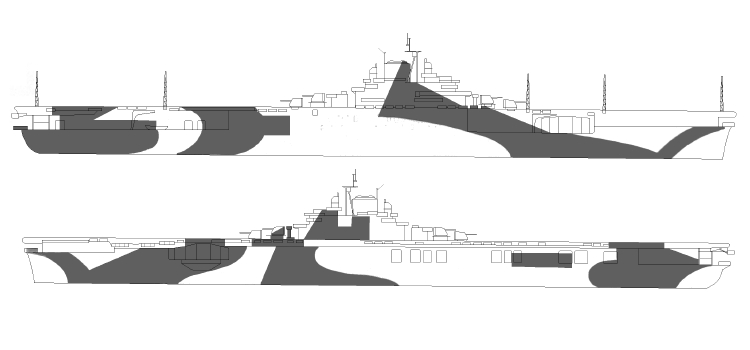
A silhouette of the drawing for Design 10D for the Essex class carriers dated probably July 1943. The colors were specified as Measure 32 : dull black (BK) and light gray (5-L).
A Design 10D drawing was attached to the July 15, 1943, memo to PacFleet for the DD-384 Dunlap class using Measure 31. USS Pensacola (CA-24) appeared at Pearl Harbor in October 1943 in 33/10D. Design 10D was used as a design for the carrier USS Essex (CV-9) that was labeled 32/6-10D and applied during April 1944. The number 6 comes from a table used in some memos between the Bureau of Ships and Pacific Fleet around August 1943. This table listed camouflage designs and the sixth listing in the table under “Patterns” was Design 10D. Design 10D was also drawn for the Buckley class destroyer escorts on December 30, 1943.
Original drawing source: NARA 80-G-157409.
September 1943 ? 10D in Measure 33 for CA-24
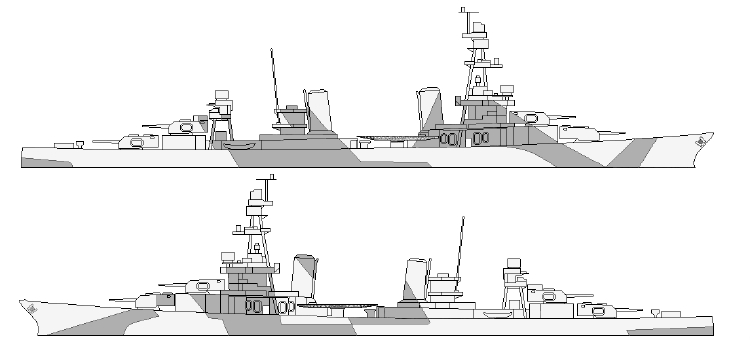
A silhouette of what the design drawing for Measure 33/10D may have looked like drawn probably in September or October 1943, for the USS Pensacola (CA-24). Pensacola was photographed in this camouflage in October 1943 at Pearl Harbor and again in January 1944. The Measure 33 colors were probably ocean gray (5-O) and light gray (5-L).
A Design 10D drawing was attached to the July 15, 1943, memo to PacFleet for the DD-384 Dunlap class using Measure 31. USS Pensacola (CA-24) appeared at Pearl Harbor in October 1943 in 33/10D. Design 10D was used as a design for the carrier USS Essex (CV-9) that was labeled 32/6-10D and applied during April 1944. The number 6 comes from a table used in some memos between the Bureau of Ships and Pacific Fleet around August 1943. This table listed camouflage designs and the sixth listing in the table under “Patterns” was Design 10D. Design 10D was also drawn for the Buckley class destroyer escorts on December 30, 1943.
Original drawing source: NARA ? This drawing created from photographs.
December 9, 1943 10D in Measure 3_ for DD-445
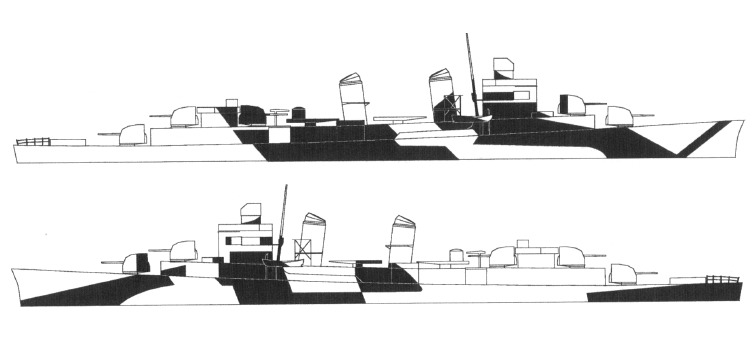
The design silhouette for Measure 3_/10D for the Fletcher class destroyers dated December 9, 1943. This drawing could be used for either Measure 31 or Measure 32. The vertical colors of light gray (5-L) and dull black (BK) would result in Measure 32 and ocean gray (5-O) or haze gray (5-H) with dull black (BK) would result in Measure 31.
A Design 10D drawing was attached to the July 15, 1943, memo to PacFleet for the DD-384 Dunlap class using Measure 31. USS Pensacola (CA-24) appeared at Pearl Harbor in October 1943 in 33/10D. Design 10D was used as a design for the carrier USS Essex (CV-9) that was labeled 32/6-10D and applied during April 1944. The number 6 comes from a table used in some memos between the Bureau of Ships and Pacific Fleet around August 1943. This table listed camouflage designs and the sixth listing in the table under “Patterns” was Design 10D. Design 10D was also drawn for the Buckley class destroyer escorts on December 30, 1943.
Original drawing source: NARA 80-G-163664 and 80-G-163665.
December 30, 1943 10D in Measure 3_ for DE-51
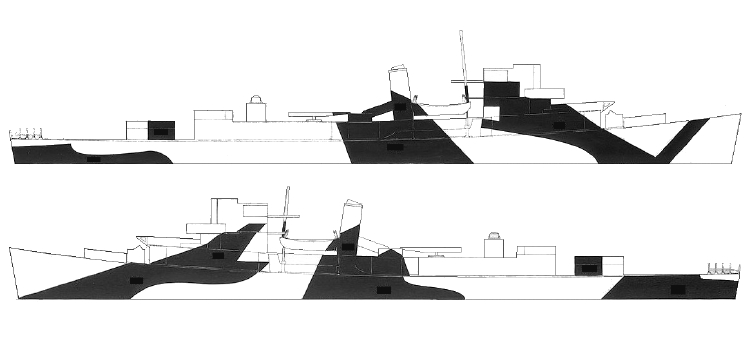
A silhouette of the design drawing for Measure 3_/10D for Buckley class destroyer escorts drawn on December 30, 1943. To make Measure 31 the colors would be dull black (BK) and ocean gray (5-O) and for Measure 32 the colors would be dull black and light gray (5-L).
A Design 10D drawing was attached to the July 15, 1943, memo to PacFleet for the DD-384 Dunlap class using Measure 31. USS Pensacola (CA-24) appeared at Pearl Harbor in October 1943 in 33/10D. Design 10D was used as a design for the carrier USS Essex (CV-9) that was labeled 32/6-10D and applied during April 1944. The number 6 comes from a table used in some memos between the Bureau of Ships and Pacific Fleet around August 1943. This table listed camouflage designs and the sixth listing in the table under “Patterns” was Design 10D. Design 10D was also drawn for the Buckley class destroyer escorts on December 30, 1943.
Original drawing source: NARA 80-G-172863 and 80-G-172864.
10F Designs
May 3, 1944 10F in Measure 32 for AK-156
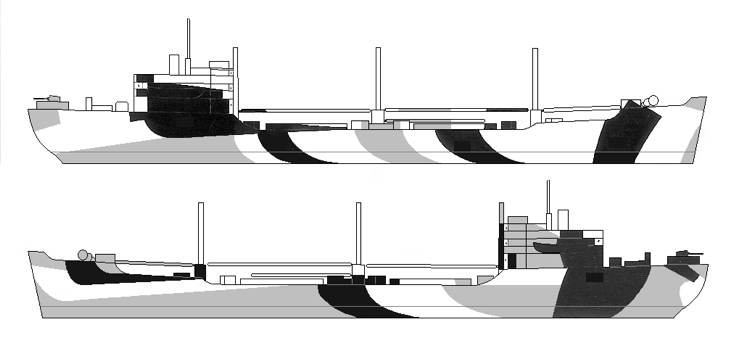
The silhouette from the drawing for Design 32/10F for the Alamosa class cargo ships using the (C1-M-AV1) maritime hull dated May 3, 1944. This drawing specifies three vertical colors: light gray (5-L), ocean gray (5-O) and dull black (BK) with the horizontal color of deck blue (20-B). This drawing shows two waterlines: a load waterline and a camouflage line.
This is the only version of Design 10F that has been found.
Original drawing source: NARA 80-G-172526 and 80-G-172528.
10L Designs
March 28, 1944 10L in Measure 31 for LSM-1

The silhouette from the drawing for Measure 31 Design 10L for the LSM-1 class medium landing ships dated March 28, 1944. The specified vertical colors were dull black (BK), navy green (5-NG) and ocean green (5-OG), with deck green (20-G), black and ocean green paint on horizontal surfaces.
This is the only drawing of Design 10L yet found.
Original drawing source: NARA 80-G-176521 and 80-G-176522.
10P Designs
May 22, 1944 10P in Measure 31 for AGP-6
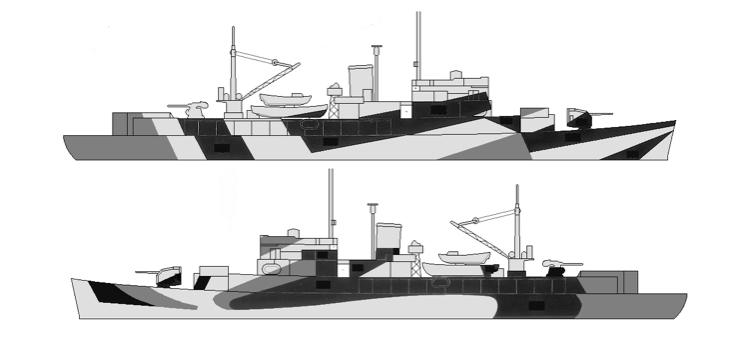
The silhouette from the drawing for Measure 31 Design 10P for the motor torpedo boat tender USS Oyster Bay (AGP-6) dated May 22, 1944. Oyster Bay was formerly AVP-28, a Barnegat class small seaplane tender. This drawing specified vertical colors in the Measure 31 green range: ocean green (5-OG), navy green (5-NG), and dull black (BK) with the horizontal color of deck green (20-G).
This is only drawing for Design 10P that has yet been found.
Original drawing source: NARA 80-G-172868 and 80-G-172876.
10T Designs
March 28, 1944 10T in Measure 32 for AP-110
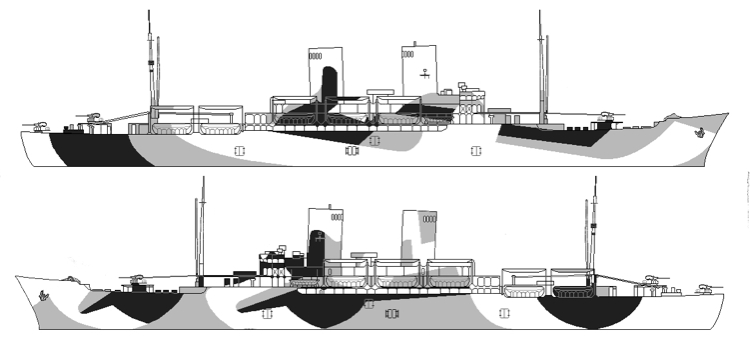
The silhouette from the drawing for Measure 32 Design 10T for the General John Pope class of transports using the (P2-S2-R2) maritime hull dated March 28, 1944. This drawing specified vertical colors of light gray (5-L), ocean gray (5-O), and dull black (BK) with the horizontal color of deck blue (20-B).
This is only drawing for Design 10T that has yet been found.
Original drawing source: NARA 80-G-173498 and 80-G-173499.
11A Designs
January 25, 1944 11A in Measure 32 for CV-3
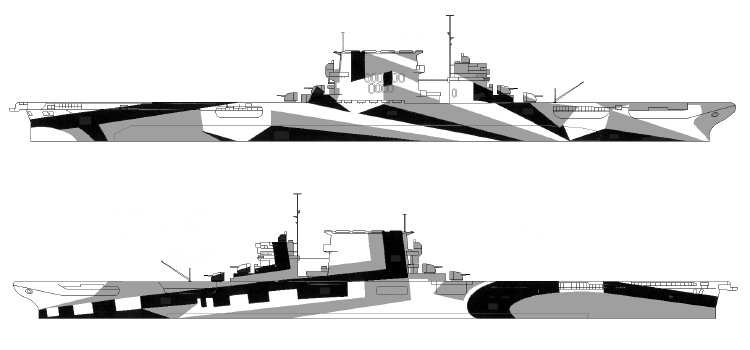
This is the earliest design drawing for Design 11A drawn for the carrier USS Saratoga dated January 25, 1944. The colors were Measure 32 dull black (BK), ocean gray (5-O) and light gray (5-L).
The earliest drawing for Design 11A as above was on January 25, 1944, for the carrier USS Saratoga (CV-3) and at the same time for the Sangemon class of escort carriers. This design was then redrawn on January 27, 1944, for the Cleveland class cruisers. On April 21, 1944, it was drawn for the General John Pope class of transports. Design 11A was redrawn for the gasoline tanker USS Kaloli (AOG-13) on May 1, 1944. Finally, it was drawn for the Allen M. Sumner class of destroyers on May 11, 1944.
Original drawing source: NARA 80-G-165991.
January 25, 1944 11A in Measure 32 for CVE-26
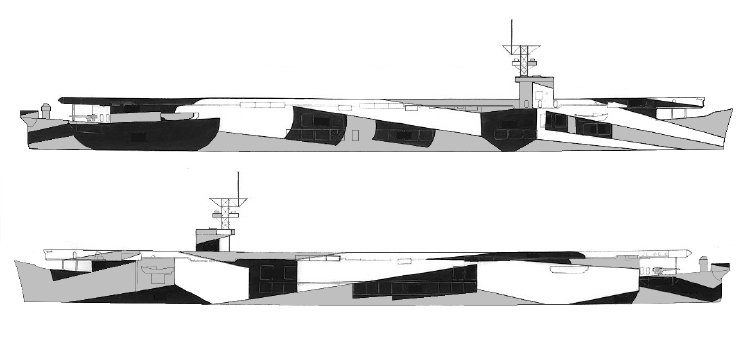
The design drawing for Measure 32/11A for the Sangemon class escort carriers dated January 25, 1944, the same as the previous drawing for CV-3. These colors were also Measure 32 dull black (BK), ocean gray (5-O) and light gray (5-L). The pattern here has been simplified somewhat and covers this smaller profile.
The earliest drawing for Design 11A was on January 25, 1944, for the carrier USS Saratoga (CV-3) and at the same time for the Sangemon class of escort carriers above. This design was then redrawn on January 27, 1944, for the Cleveland class cruisers. On April 21, 1944, it was drawn for the General John Pope class of transports. Design 11A was redrawn for the gasoline tanker USS Kaloli (AOG-13) on May 1, 1944. Finally, it was drawn for the Allen M. Sumner class of destroyers on May 11, 1944.
Original drawing source: NARA 80-G-165753 and 80-G-165754.
January 27, 1944 11A in Measure 32 for CL-55
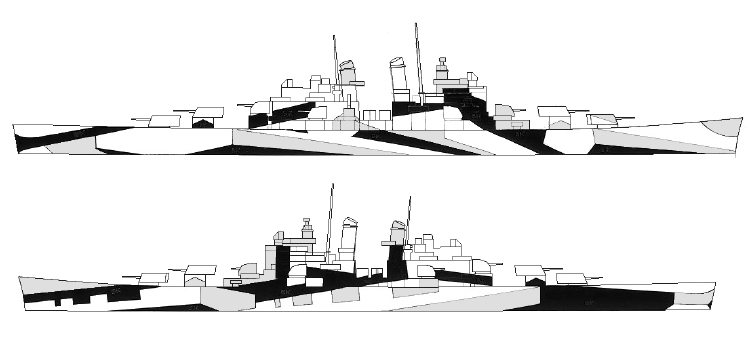
A silhouette of the design drawing for Measure 32/11A drawn on January 27, 1944, for the Cleveland class light cruisers.
The earliest drawing for Design 11A was on January 25, 1944, for the carrier USS Saratoga (CV-3) and at the same time for the Sangemon class of escort carriers. This design was then redrawn on January 27, 1944, for the Cleveland class cruisers. On April 21, 1944, it was drawn for the General John Pope class of transports. Design 11A was redrawn for the gasoline tanker USS Kaloli (AOG-13) on May 1, 1944. Finally, it was drawn for the Allen M. Sumner class of destroyers on May 11, 1944.
Original drawing source: NARA 80-G-155500 and 80-G-155501.
April 21, 1944 11A in Measure 32 for AP-110
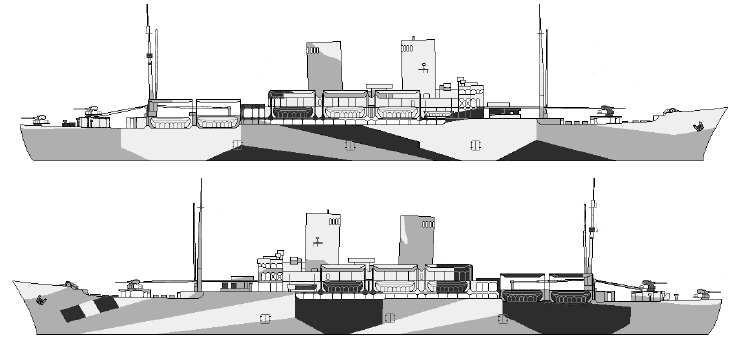
The design silhouette for Measure 32/11A for the General John Pope class transports drawn on April 21, 1944. The vertical colors were light gray (5-L), ocean gray (5-O) and dull black (BK) for Measure 32. The pattern on this profile provides a good deal of deception as to the rotation of the ship relative to the observer.
The earliest drawing for Design 11A was on January 25, 1944, for the carrier USS Saratoga (CV-3) and at the same time for the Sangemon class of escort carriers. This design was then redrawn on January 27, 1944, for the Cleveland class cruisers. On April 21, 1944, it was drawn for the General John Pope class of transports. Design 11A was redrawn for the gasoline tanker USS Kaloli (AOG-13) on May 1, 1944. Finally, it was drawn for the Allen M. Sumner class of destroyers on May 11, 1944.
Original drawing source: NARA 80-G-173500 and 80-G-173501.
August 19, 1943 11A in Measure 32 for AOG-13
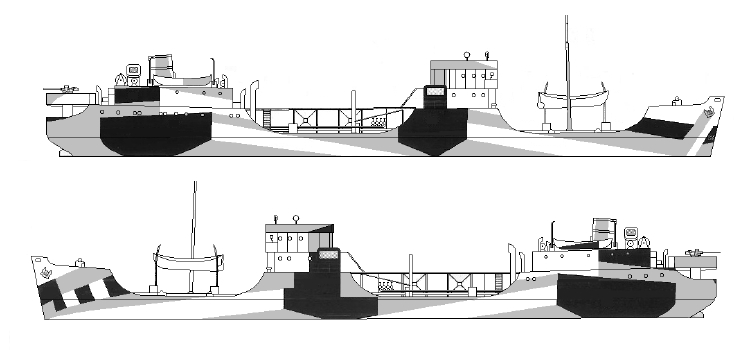
A silhouette of the design drawing for Measure 32/11A for USS Kaloli (AOG-13) gasoline tanker drawn on May 1, 1944. The 11A pattern has been fit well into the distinctive profile of this ship.
The earliest drawing for Design 11A was on January 25, 1944, for the carrier USS Saratoga (CV-3) and at the same time for the Sangemon class of escort carriers. This design was then redrawn on January 27, 1944, for the Cleveland class cruisers. On April 21, 1944, it was drawn for the General John Pope class of transports. Design 11A was redrawn for the gasoline tanker USS Kaloli as above on May 1, 1944. Finally, it was drawn for the Allen M. Sumner class of destroyers on May 11, 1944.
Original drawing source: NARA 80-G-174543 and 80-G-174544.
May 27, 1944 11A in Measure 32 for DD-692
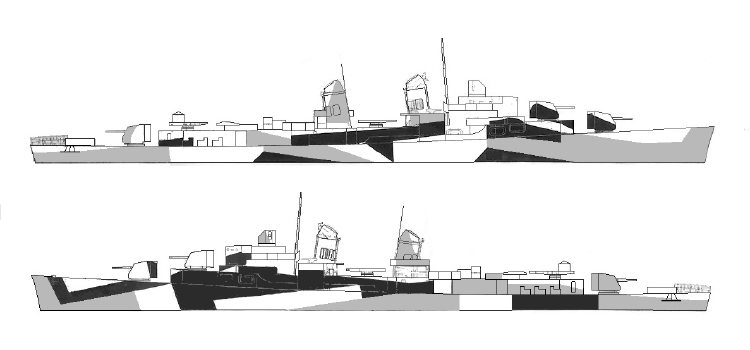
This is a silhouette of the original Design 11A drawing for the Allen M. Sumner class Destroyers. The original drawings were produced on May 11, 1944. The three colors shown are Measure 32: dull black (BK) ocean gray (5-O) and light gray (5-L), haze gray (5-H) subsituted for light gray would result in Measure 31. The smaller freeboard of this profile makes the false perspective of this design a little less effective.
The earliest drawing for Design 11A was on January 25, 1944, for the carrier USS Saratoga (CV-3) and at the same time for the Sangemon class of escort carriers. This design was then redrawn on January 27, 1944, for the Cleveland class cruisers. On April 21, 1944, it was drawn for the General John Pope class of transports. Design 11A was redrawn for the gasoline tanker USS Kaloli (AOG-13) on May 1, 1944. Finally, it was drawn for the Allen M. Sumner class of destroyers as above on May 11, 1944.
Original drawing source: NARA 80-G-109633 and 80-G-109634.
11C Designs
October 28, 1944 11C in Measure 31a for CA-33
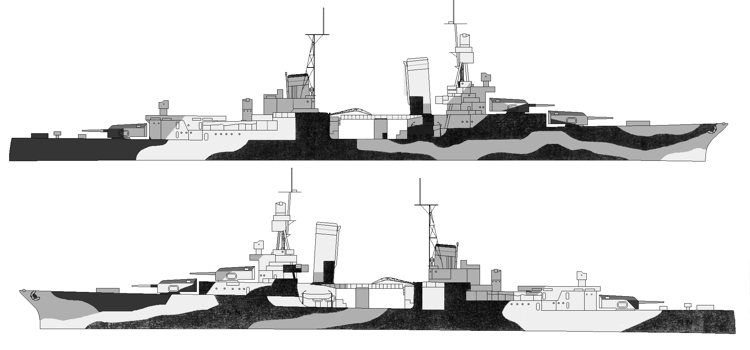
The silhouette from the drawing for Camouflage Design 31a/11C drawn for the Portland class heavy cruisers dated October 28, 1944. The Measure 31a vertical colors were navy blue (5-N), ocean gray (5-O) and haze gray (5-H) with deck blue (20-B) and no pattern on the horizontal surfaces.
No other drawing for Design 11C has been found.
Original drawing source: NARA 80-G-100390 and 80-G-100391.
11D Designs
July 15, 1943 ? 11D in Measure 32 for DD-422

The earliest design drawing for Design 11D drawn for the Benson class destroyers dated July 15, 1943, has yet to be found.
The first drawing for Design 11D was attached to the July 15, 1943, memo to PacFleet for Benson class. This design was drawn up for the Buckley class destroyer escorts on December 22, 1943, and also for the Sims class destroyers on March 1, 1944. The earlier design for the Buckley destroyer escorts had its patterns almost reversed port and starboard; the prominent panel of the Fletcher port bow was on the Buckley starboard bow. Design 11D was adapted and worn by the battleship USS Indiana (BB-58) beginning in October 1943.
Original drawing source: NARA ?
September 1943 ? 11D in Measure 32 for BB-58
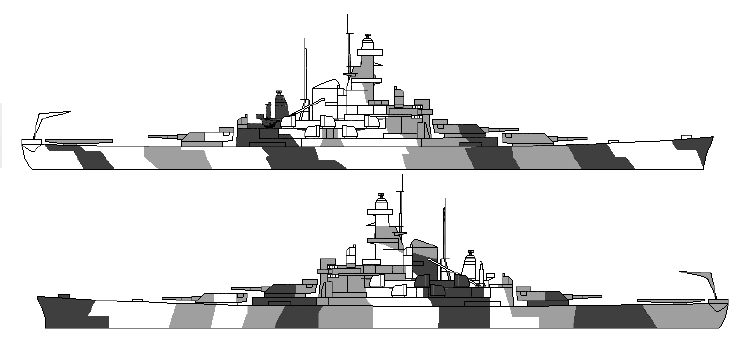
This is how design drawing for Measure 32/11D for the battleship USS Indiana (BB-58) may have looked, probably drawn in September 1943. Researcher Tracy White has found a memo dated September 16, 1943, to Indiana directing the application of this camouflage as an experiment; drawings were attached with the memo, but have yet to be found. The specified vertical colors were probably dull black (BK), ocean gray (5-O) and light gray (5-L). Indiana appeared in photographs in this camouflage beginning in October 1943. Note the panel on the starboard bow.
The first drawing for Design 11D was attached to the July 15, 1943, memo to PacFleet for Benson class. This design was drawn up for the Buckley class destroyer escorts on December 22, 1943, and also for the Sims class destroyers on March 1, 1944. The earlier design for the Buckley destroyer escorts had its patterns almost reversed port and starboard; the prominent panel of the Fletcher port bow was on the Buckley starboard bow. Design 11D was adapted and worn by the battleship USS Indiana (BB-58) beginning in October 1943.
Original drawing source: NARA ? A modern drawing of this camouflage can be obtained at The Floating Drydock: floatingdrydock.com.
December 22, 1943 11D in Measure 32 for DE-51
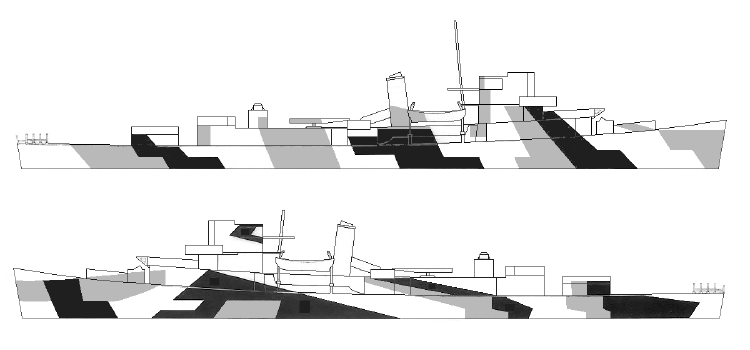
A silhouette of the design drawing for Measure 32/11D drawn on December 22, 1943, for the Buckley class of destroyer escorts. The specified Measure 32 colors vertically were dull black (BK), ocean gray (5-O) and light gray (5-L). The starboard bow panels remain similar, but many other panels on both the starboard and port are more varied from the previous pattern.
The first drawing for Design 11D was attached to the July 15, 1943, memo to PacFleet for Benson class. This design was drawn up for the Buckley class destroyer escorts on December 22, 1943, and also for the Sims class destroyers on March 1, 1944. The earlier design for the Buckley destroyer escorts had its patterns almost reversed port and starboard; the prominent panel of the Fletcher port bow was on the Buckley starboard bow. Design 11D was adapted and worn by the battleship USS Indiana (BB-58) beginning in October 1943.
Original drawing source: NARA 80-G-162032 and 80-G-162033.
March 1, 1944 11D in Measure 31 for DD-409
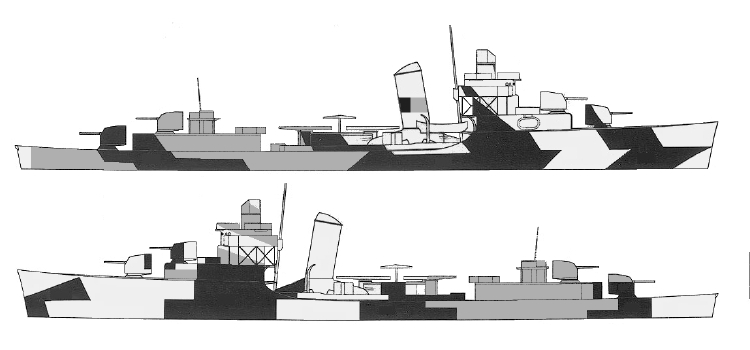
The design silhouette for Measure 31/11D for the Sims class destroyers drawn on March 1, 1944. The Measure 31 vertical colors were haze gray (5-H), ocean gray (5-O) and dull black (BK), replacing haze gray with light gray (5-L) would give Measure 32. The pattern has been almost reversed port and starboard as the previous starboard bow panels now appear on the port side.
The first drawing for Design 11D was attached to the July 15, 1943, memo to PacFleet for Benson class. This design was drawn up for the Buckley class destroyer escorts on December 22, 1943, and also for the Sims class destroyers on March 1, 1944. The earlier design for the Buckley destroyer escorts had its patterns almost reversed port and starboard; the prominent panel of the Fletcher port bow was on the Buckley starboard bow. Design 11D was adapted and worn by the battleship USS Indiana (BB-58) beginning in October 1943.
Original drawing source: NARA 80-G-166244 and 80-G-166245.
March 8, 1944 11D in Measure 31 for DD-445
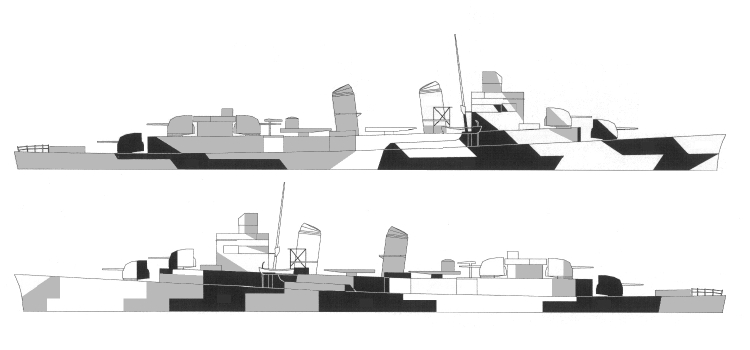
A silhouette of the design drawing for Measure 31/11D for the Fletcher class destroyers drawn on March 8, 1944. The Measure 31 colors specified were dull black (BK), ocean gray (5-O) and haze gray (5-H). This version of 11D pattern is a much closer match to the previous version.
The first drawing for Design 11D was attached to the July 15, 1943, memo to PacFleet for Benson class. This design was drawn up for the Buckley class destroyer escorts on December 22, 1943, and also for the Sims class destroyers on March 1, 1944. The earlier design for the Buckley destroyer escorts had its patterns almost reversed port and starboard; the prominent panel of the Fletcher port bow was on the Buckley starboard bow. Design 11D was adapted and worn by the battleship USS Indiana (BB-58) beginning in October 1943.
Original drawing source: NARA 80-G-170934 and 80-G-170935.
11L Designs
May 22, 1944 11L in Measure 31 for LST-1
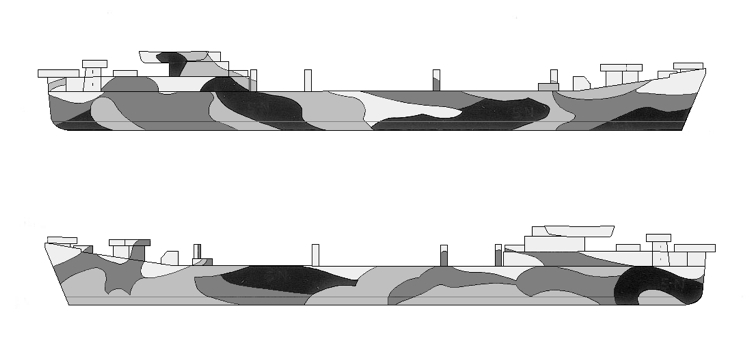
The silhouette from the drawing for Measure 31 Design 11L for the LST-1 class tank landing ships and similar ships dated May 22, 1944. The specified vertical colors were dull black (BK), navy green (5-NG), ocean green (5-OG) and haze green (5-HG) with deck green (20-G) on horizontal surfaces. Note, this drawing had two waterlines: a load line and a light load line.
This is the only drawing for Design 11L yet found.
Original drawing source: NARA 80-G-172985 and 80-G-172986.
11P Designs
June 23, 1944 11P in Measure 31 for AGP-3
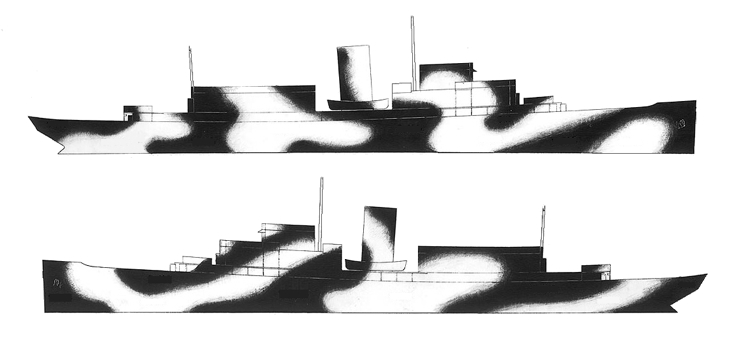
The silhouette from the drawing for Measure 31 Design 11P for the motor torpedo boat tender USS Jamestown (AGP-3) dated June 23, 1944. The specified vertical colors were navy green (5-NG) and ocean green (5-OG), with deck green (20-G) on horizontal surfaces.
This is the only drawing for Design 11P that has yet been found.
Original drawing source: NARA 80-G-174531 and 80-G-174532.
11T Designs
April 13, 1944 11T in Measure 33 for AP-130
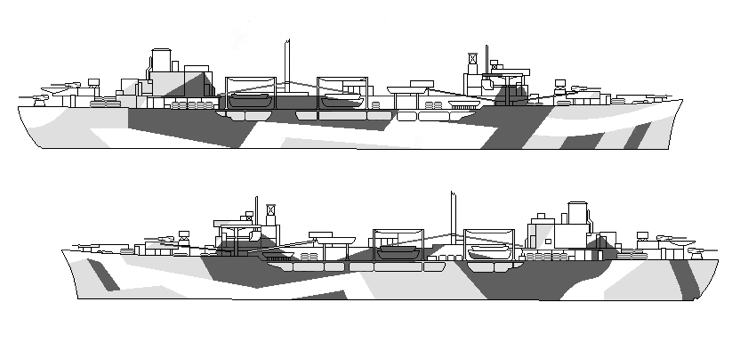
The silhouette from the drawing for Measure 33 Design 11T for the General G. O. Squier class transports using the (C4-S-A1) maritime hull dated April 13, 1944. This drawing specified Measure 33 vertical colors of pale gray (5-P), haze gray (5-H), and navy blue (5-N) with the horizontal color of deck blue (20-B).
This is the only drawing for Design 11T that has yet been found.
Original drawing source: NARA 80-G-173482 and 80-G-173483.
12A Designs
February 3, 1944 12A in Measure 33 for CVE-9
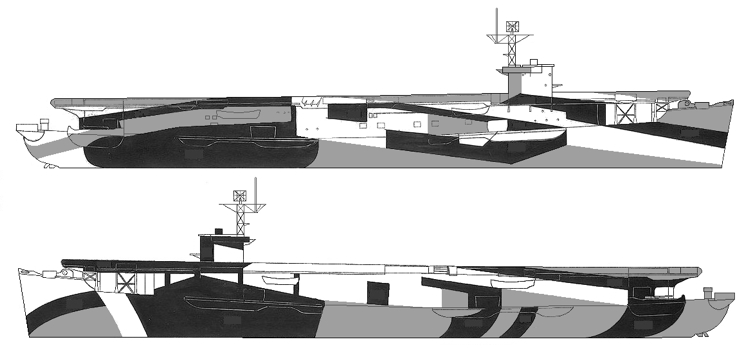
This is the silhouette from the drawing for Measure 33 Design 12A for the Bogue class escort carriers dated February 3, 1944. The vertical colors were listed as navy blue (5-N), haze gray (5-H) and pale gray (5-P) with the horizontal surfaces deck blue (20-B). There was both a bow view and a stern view.
The earliest drawing for Design 12A was probably on February 3, 1944, for the Bogue class escort carriers as above. Then on February 17, 1944, Design 12A was drawn for the Casablanca class escort carriers.
Original drawing source: NARA 80-G-165763 and 80-G-165764.
February 17, 1944 12A in Measure 32 for CVE-55
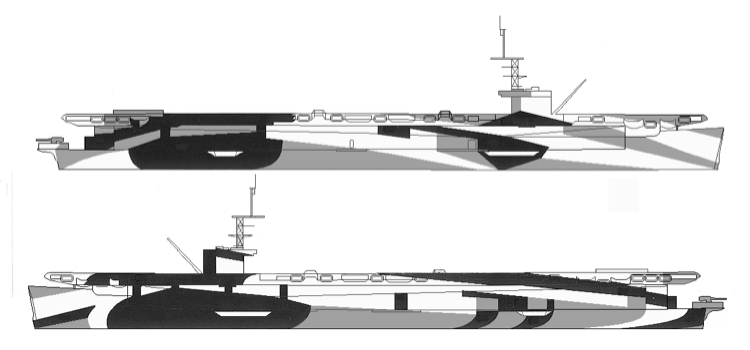
This is a silhouette of the original Design 12A for the Casablanca class escort carriers dated February 17, 1944. The vertical colors were listed as dull black (BK), ocean gray (5-O) and light gray (5-L) with the horizontal surfaces deck blue (20-B). The drawing did include both a bow view and a stern view.
The earliest drawing for Design 12A was probably on February 3, 1944, for the Bogue class escort carriers. Then on February 17, 1944, Design 12A was drawn for the Casablanca class escort carriers as above.
Original drawing source: NARA 80-G-165986 and 80-G-165987.
12Ax Designs
June 16, 1944 12Ax in Measure 32 for AV-8
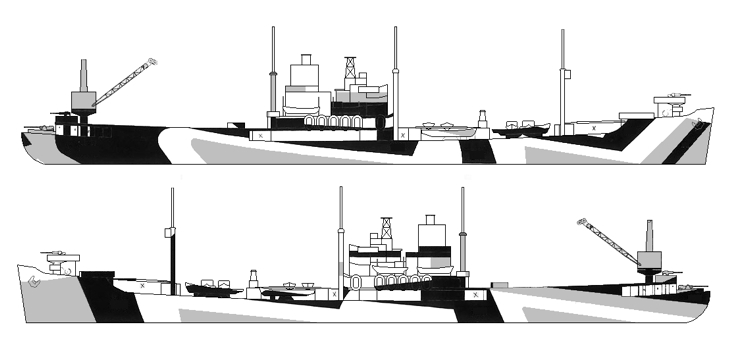
The silhouette from the drawing for Measure 32 Design 12Ax for USS Tangier (AV-8) seaplane tenders; the original was dated June 16, 1944. The vertical colors were: dull black (BK), ocean gray (5-O) and light gray (5-L) and the deck was deck blue (20-B). This pattern on the starboard is very much like the starboard of Design 3D and the port side is almost a repeat of the starboard.
This is the only version of Design 12Ax that has been found.
Original drawing source: NARA 80-G-174549 and 80-G-174550.
12F Designs
May 1, 1944 12F in Measure 33 for AK-14
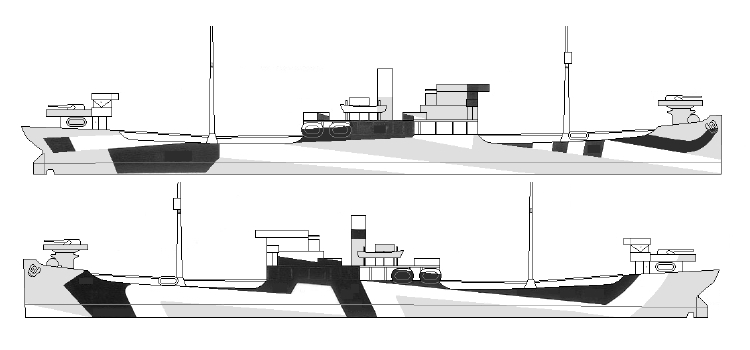
The earliest design drawing yet found for Design 12F was drawn for the cargo ship USS Regulus (AK-14) in Measure 33 on May 1, 1944. The Measure 33 colors would have been navy blue (5-N) haze gray (5-H) and pale gray (5-P) with a deck blue (20-B) deck. Note the positioning and general shape of the dark panels.
The earliest drawing for Design 12F was for the cargo ship USS Regulus (AK-14) dated May 1, 1944, using blue colors of Measure 33 as above. Design 12F was drawn for the Acontius class motor torpedo boat tenders dated June 7, 1944, on June 20, 1944, for the USS Hilo (AGP-2) and on June 21, 1944, for the Aegir class of submarine tenders. All three drawings used irregular patterns of greens.
Original drawing source: NARA 80-G-172888 and 80-G-172889.
June 7, 1944 12F in Measure 31 for AGP-12
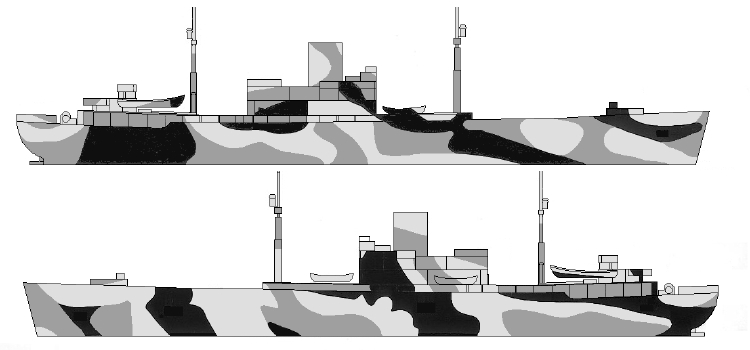
A silhouette from the Measure 31/12F drawing for the Acontius class motor torpedo boat tenders dated June 7, 1944. The vertical colors were greens: dull black (BK), navy green (5-NG) and ocean green (5-OG) with a deck pattern of dull black (BK) and deck green (20-G). Notice, many of the irregular dark panels resemble the dark panels of the previous version.
The earliest drawing for Design 12F was for the cargo ship USS Regulus (AK-14) dated May 1, 1944, using blue colors of Measure 33. Design 12F was drawn for the Acontius class motor torpedo boat tenders dated June 7, 1944, on June 20, 1944, for the USS Hilo (AGP-2) and on June 21, 1944, for the Aegir class of submarine tenders. All three drawings used irregular patterns of greens.
Original drawing source: NARA 80-G-172977 and 80-G-172978.
June 20, 1944 12F in Measure 31 for AGP-2
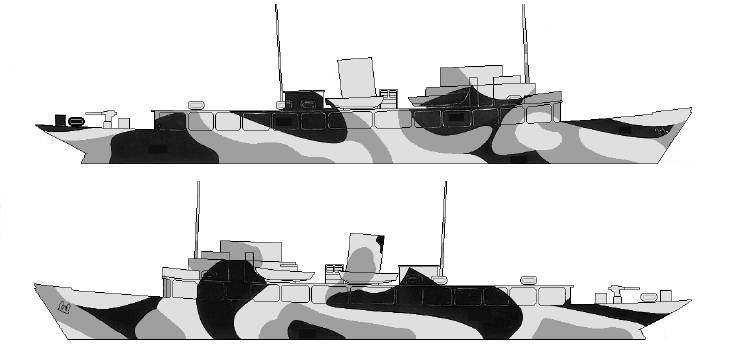
A silhouette of the design drawing for Measure 31/12F dated June 20, 1944, for the motor torpedo boat tender USS Hilo. Colors were also the same range of greens. This version of 12F is a close match to the previous version except for adjustments for the smaller profile.
The earliest drawing for Design 12F was for the cargo ship USS Regulus (AK-14) dated May 1, 1944, using blue colors of Measure 33. Design 12F was drawn for the Acontius class motor torpedo boat tenders dated June 7, 1944, on June 20, 1944, for the USS Hilo (AGP-2) and on June 21, 1944, for the Aegir class of submarine tenders. All three drawings used irregular patterns of greens.
Original drawing source: NARA 80-G-174533 and 80-G-174534.
June 21, 1944 12F in Measure 32 for AS-23
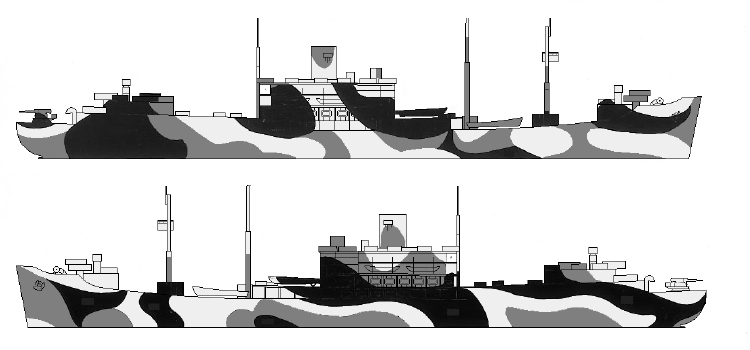
The design silhouette for Measure 32/12F for the Aegir class submarine tenders dated June 21, 1944. The vertical colors were again in the green range: haze green (5-HG), navy green (5-NG) and dull black (BK). This version of Design 12F was still similar to the previous green versions.
The earliest drawing for Design 12F was for the cargo ship USS Regulus (AK-14) dated May 1, 1944, using blue colors of Measure 33. Design 12F was drawn for the Acontius class motor torpedo boat tenders dated June 7, 1944, on June 20, 1944, for the USS Hilo (AGP-2) and on June 21, 1944, for the Aegir class of submarine tenders. All three drawings used irregular patterns of greens.
Original drawing source: NARA 80-G-174766 and 80-G-174767.
12L Designs
April 17, 1944 12L in Measure 33 for LCT(6)
 12L.jpg)
The silhouette from the drawing for Measure 33 Design 12L for the LCT(6) class of tank landing craft dated April 17, 1944. The specified vertical colors were ocean green (5-OG) sprayed and feathered over pale green (5-PG) with deck green (20-G) and ocean green paint on horizontal surfaces.
This is the only version of Design 12L yet found.
Original drawing source: NARA 80-G-172520 and 80-G-172534.
12P Designs
July 19, 1944 12P in Measure 32 for PC-578
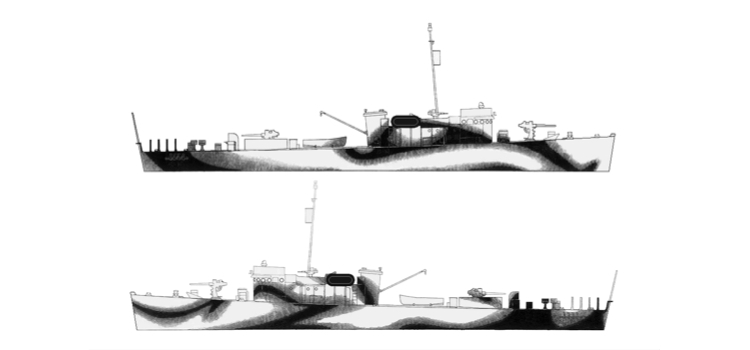
The silhouette from the drawing for Measure 32 Design 12P for PC-578 and other 173-foot subchasers dated July 19, 1944. The specified vertical colors were navy blue (5-N) sprayed and feathered over haze gray (5-H), with deck blue (20-B) on horizontal surfaces.
This is the only drawing for Design 12P that has yet been found.
Original drawing source: NARA 19-N-73642 and 19-N-73643.
March 7, 1944 12Pa in Measure 31 for PGM-1-8
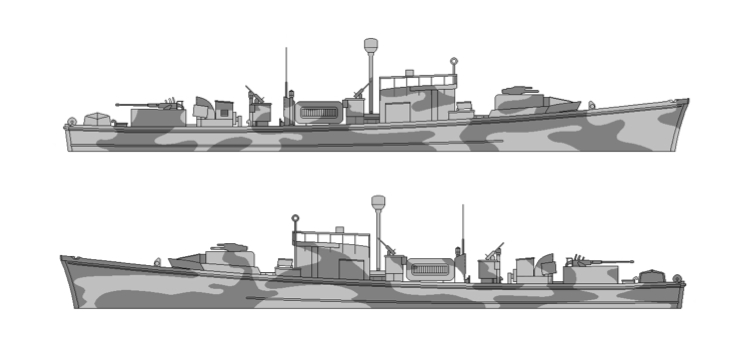
The silhouette of what might have been the drawing for a camouflage design done by Terminal Island Shipyard, San Pedro, California for PGM-1 thru PGM-8 that I have labeled Design 12Pa until documention indicates otherwise. The vertical colors were navy blue (5-N) and ocean green (5-OG). A March 7, 1944 letter from Terminal Island to BuShips identifies the colors and references a shipyard drawing for outside painting. At least PGM-2 thru PGM-7 were similarly painted.
No official drawing for Design 12Pa has yet been found.
Original drawing source: Created from ships photos.
12T Designs
April 25, 1944 12T in Measure 31 for APD-1
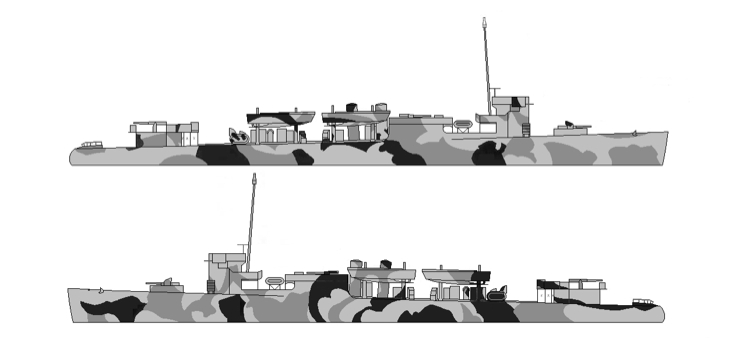
The silhouette from the drawing for Measure 31 Design 12T for the APD-1 class high speed transports dated April 25, 1944. The specified vertical colors were dull black (BK), navy green (5-NG) and ocean green (5-OG) with black, deck green and ocean green paint on horizontal surfaces.
This is the only version of Design 12T yet found.
Original drawing source: NARA 80-G-172536 and 80-G-172537.
13Ax Designs
March 9, 1944 13Ax in Measure 32 for AD-4

The silhouette from the drawing for Measure 32 Design 13Ax for the destroyer tender USS Whitney (AD-4) dated March 9, 1944. The vertical colors for Measure 32 were navy blue (5-N), ocean gray (5-O) and light gray (5-L) with deck blue (20-B) for the horizontal color.
This is the only version of Design 13Ax yet found.
Original drawing source: NARA 80-G-176505 and 80-G-176506.
13D Designs
July 15, 1943 ? 13D in Measure 32 for DD-380

The earliest design drawing for Design 13D drawn for the Gridley class destroyers in Measure 32 and included with the July 15, 1943 memo from BuShips to PacFleet has not yet been found. The Measure 32 colors would have been dull black (BK) and light gray (5-L).
The first drawing for Design 13D was attached to the July 15, 1943, memo to PacFleet for Gridley class destroyers. Design 13D was drawn for the Buckley class detroyer escorts on December 30, 1944, as well as for the New Orleans class heavy cruisers on February 3, 1944, and used by the cruisers USS Tuscaloosa (CA-37) and USS San Francisco (CA-38) in Measure 33 colors. These later versions of Design 13D differed in the area of the port bow from the destroyer escort design.
Original drawing source: NARA ?
November 1943 ? 13D in Measure 32 for DD-445
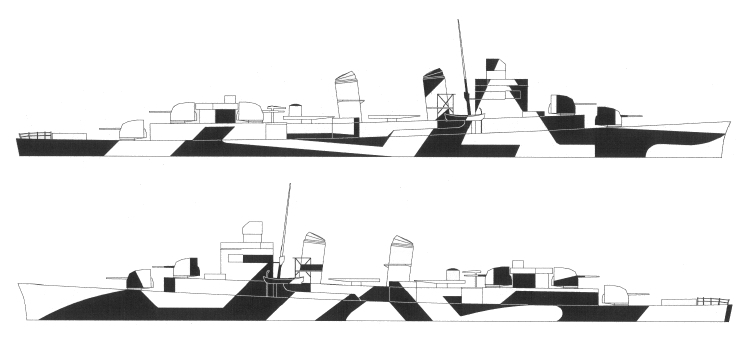
A silhouette from the Measure 32/13D drawing for the Fletcher class destroyers, probably dated no later than December 1943. The vertical colors were dull black (BK) and light gray (5-L), ocean gray (5-O) or haze gray (5-H) could be substituted for 5-L to become Measure 31.
The first drawing for Design 13D was attached to the July 15, 1943, memo to PacFleet for Gridley class destroyers. Design 13D was drawn for the Buckley class detroyer escorts on December 30, 1944, as well as for the New Orleans class heavy cruisers on February 3, 1944, and used by the cruisers USS Tuscaloosa (CA-37) and USS San Francisco (CA-38) in Measure 33 colors. These later versions of Design 13D differed in the area of the port bow from the destroyer escort design.
Original drawing source: NARA 80-G-160562 and 80-G-160563.
December 30, 1943 13D in Measure 3_ for DE-51
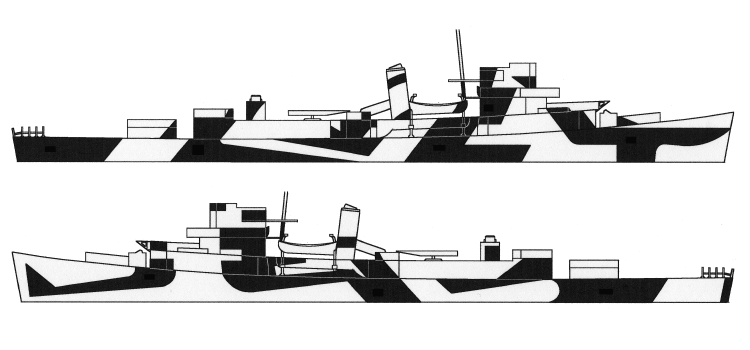
A silhouette of the design drawing for Measure 3_/13D dated December 30, 1943, for the Buckley class destroyer escorts. This drawing could be used for either Measure 31 or 32; changing the legend to show the colors of dull black (BK) and light gray would give Measure 32 and dull black with haze gray (5-H) or ocean gray (5-O) would result in Measure 31. This version of 13D is a close match to the previous version except on the port side from amidships to the bow.
The first drawing for Design 13D was attached to the July 15, 1943, memo to PacFleet for Gridley class destroyers. Design 13D was drawn for the Buckley class detroyer escorts on December 30, 1944, as well as for the New Orleans class heavy cruisers on February 3, 1944, and used by the cruisers USS Tuscaloosa (CA-37) and USS San Francisco (CA-38) in Measure 33 colors. These later versions of Design 13D differed in the area of the port bow from the destroyer escort design.
Original drawing source: NARA 80-G-163668 and 80-G-163669.
February 3, 1944 13D in Measure 33 for CA-32
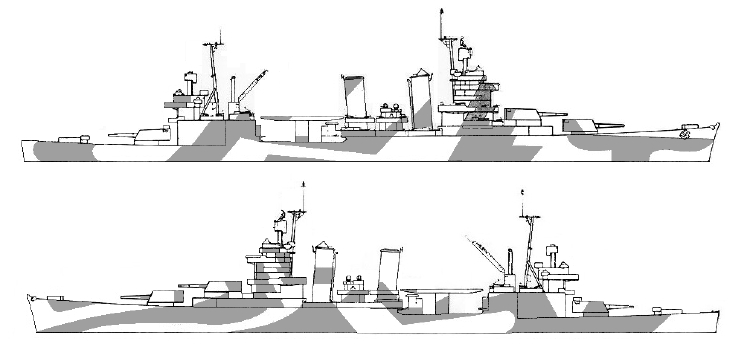
The design silhouette for Measure 33/13D for the New Orleans class heavy cruisers dated February 3, 1944. The vertical colors were light gray (5-L) and ocean gray (5-O) for Measure 33. On the same date an almost identical drawing but with Measure 32 colors was issued. This version of Design 13D continues with small additional changes to the port bow panels from the previous version.
The first drawing for Design 13D was attached to the July 15, 1943, memo to PacFleet for Gridley class destroyers. Design 13D was drawn for the Buckley class detroyer escorts on December 30, 1944, as well as for the New Orleans class heavy cruisers on February 3, 1944, and used by the cruisers USS Tuscaloosa (CA-37) and USS San Francisco (CA-38) in Measure 33 colors. These later versions of Design 13D differed in the area of the port bow from the destroyer escort design.
Original drawing source: NARA 80-G-170020 and 80-G-170021 for Measure 32 and 80-G-105506 and 80-G-105507 for Measure 33.
13F Designs
June 20, 1944 13F in Measure 32 for AE-9
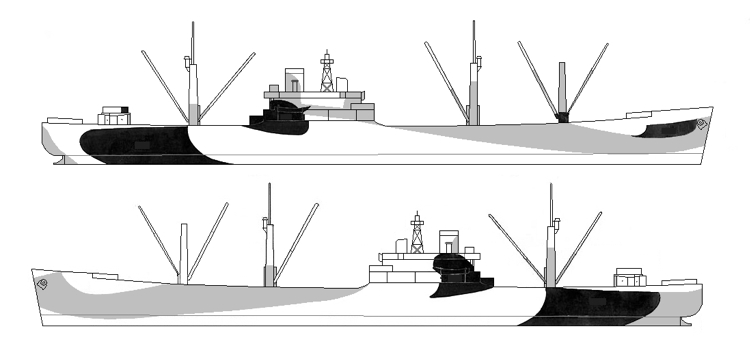
The silhouette from the drawing for Design 32/13F for the USS Mazama (AE-9) ammunition ship using the C2 maritime hull drawn on June 20, 1944. This drawing specifies vertical colors of light gray (5-L), ocean gray (5-O), and dull black (BK) with the horizontal color of deck blue (20-B). This drawing also has two waterlines.
This is the only version of Design 13F yet found.
Original drawing source: NARA 80-G-176503 and 80-G-176504.
13P Designs
July 26, 1944 13P in Measure 32 for SC-676

The silhouette from the drawing for Measure 32 Design 13P for the SC-676 class of subchasers dated July 26, 1944. The specified vertical colors were ocean green (5-OG) and light gray (5-L), with deck green (20-G) and ocean gray (5-O) on horizontal surfaces.
This is the only drawing for Design 13P that has yet been found.
Original drawing source: NARA 19-N-73628 and 19-N-73629.
13T Designs
May 17, 1944 13T in Measure 32 for AP-130
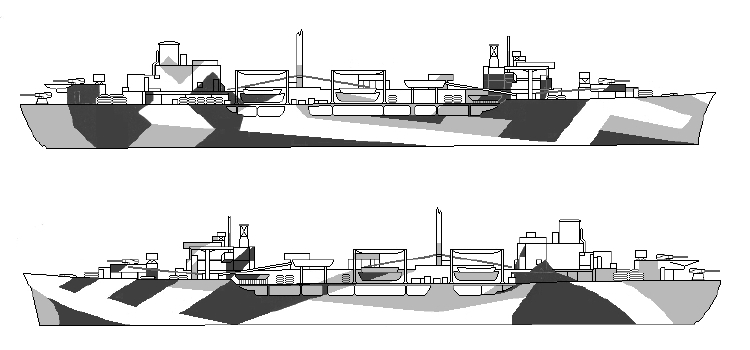
This may be the earliest design drawing for Measure 32/13T drawn for the General G. O. Squier class transports dated May 17, 1944.
The earliest drawing of Design 13T was on May 17, 1944, for the General G. O. Squier class of transports as shown above. On June 2, 1944, Design 13T was redrawn for the Cimarron class fleet oilers .
Original drawing source: NARA 80-G-173480 and 80-G-173481.
June 2, 1944 13T in Measure 32 for AO-22
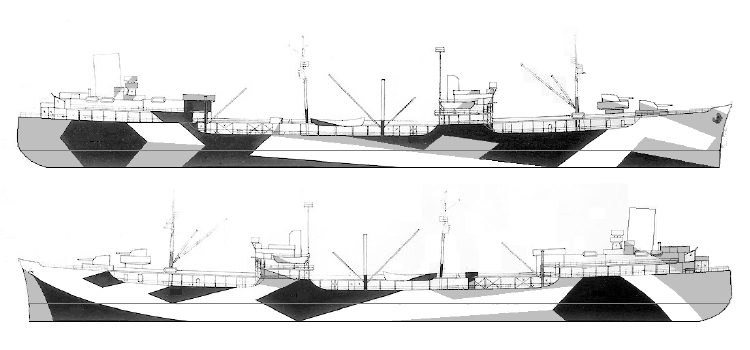
This is a silhouette of the original Design 13T drawings for the Cimarron class oilers. The drawings were produced on June 2, 1944. The three colors shown are Measure 32: dull black (BK) ocean gray (5-O) and light gray (5-L).
The earliest drawing of Design 13T was on May 17, 1944, for the General G. O. Squier class of transports. On June 2, 1944, Design 13T was redrawn for the Cimarron class fleet oilers as shown above.
Original drawing source: NARA 80-G-173262 and 80-G-173264.
14A Designs
March 2, 1944 14A in Measure 33 for CVE-55
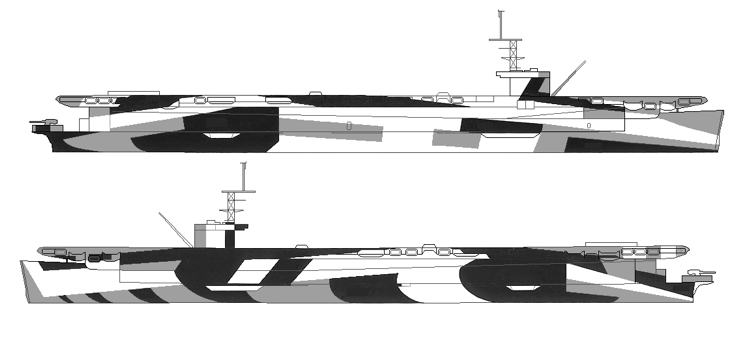
The silhouette from the drawing for Measure 33 Design 14A for the Casablanca class escort carriers issued March 2, 1944. The vertical colors were listed as navy blue (5-N), haze gray (5-H) and pale gray (5-P) with deck blue (20-B) on the horizontal surfaces. This design shows similarities to 10A and 11A.
There has been only one drawing for Design 14A found.
Original drawing source: NARA 80-G-109639 and 80-G-109640.
14D Designs
July 15, 1943 ? 14D in Measure 31 for DD-422

This would be probably the earliest design drawing for Measure 31/14D drawn for the Benson class destroyers dated July 15, 1943.
A Design 14D drawing for the Benson class destroyers was attached to the July 15, 1943, memo to PacFleet. This design was also used on the cruiser USS Pensacola (CA-24) in Measure 32 colors and USS Salt Lake City (CA-25) in Measure 33 colors. Design 14D was used by seven Fletcher class destroyers in two colors and over twenty destroyer escorts in both two and three colors. It was also redrawn on June 28, 1944, for the heavy cruiser USS Wichita (CA-45), but probably was never used.
Original drawing source: NARA ?
November 1943 ? 14D in Measure 3_ for DD-445
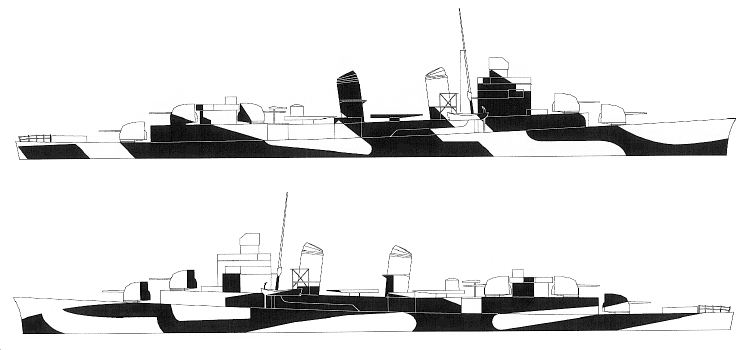
The drawing for Design 14D for the Fletcher class destroyers in an open measure with two colors: dull black (BK) and a lighter color. The date was probably before January 1944. Ships in Measure 31 would use ocean gray (5-O) or haze gray (5-H) for the lightest vertical color and ships in Measure 32 would use light gray (5-L). Note the distinctive sweeping panels on the port bow and the curves on the starboard side especially the bow.
A Design 14D drawing was attached to the July 15, 1943, memo to PacFleet for the Benson class destroyers. This design was also used on the cruiser USS Pensacola (CA-24) in Measure 32 colors and USS Salt Lake City (CA-25) in Measure 33 colors. Design 14D was used by seven Fletcher class destroyers in two colors and over twenty destroyer escorts in both two and three colors. It was also redrawn on June 28, 1944, for the heavy cruiser USS Wichita (CA-45), but probably was never used.
Original drawing source: NARA 80-G-158593 and 80-G-158594.
December 30, 1943 14D in Measure 3_ for DE-51
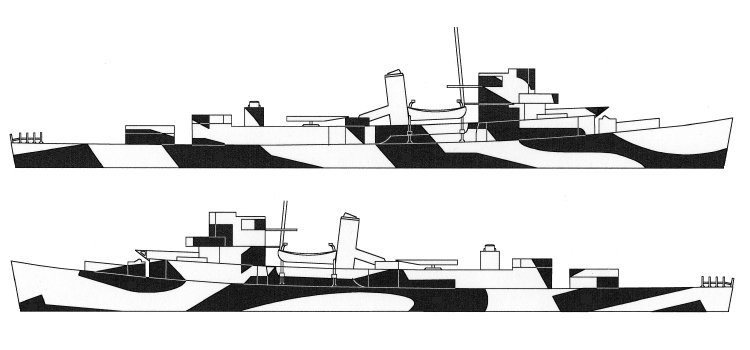
This is silhouette of the Design 14D drawing for the Buckley class destroyer escorts originally dated December 30, 1943. This was an open measure also with two colors and choosing the correct light color could create the desired measure; light gray (5-L) for Measure 32 and ocean gray (5-O) or haze gray (5-H) would result in Measure 31. This version of 14D has lost the curves of the port bow, but most of the other panels port and starboard are still clearly similar to the Fletcher version.
A Design 14D drawing was attached to the July 15, 1943, memo to PacFleet for the Benson class destroyers. This design was also used on the cruiser USS Pensacola (CA-24) in Measure 32 colors and USS Salt Lake City (CA-25) in Measure 33 colors. Design 14D was used by seven Fletcher class destroyers in two colors and over twenty destroyer escorts in both two and three colors. It was also redrawn on June 28, 1944, for the heavy cruiser USS Wichita (CA-45), but probably was never used.
Original drawing source: NARA 80-G-163670 and 80-G-163671.
April 7 1944 14D in Measure 32 for CA-24

This is a silhouette of the drawing for Design 32/14D for the Pensacola class heavy cruisers dated April 7, 1944. The three Measure 32 vertical colors were dull black (BK), ocean gray (5-O) and light gray (5-L) with the horizontal surfaces having a pattern of deck blue (20-B) and ocean gray (5-O). Measure 33 vertical colors would probably be navy blue (5-N), haze gray (5-H) and pale gray (5-P). The distinctive port bow panels are back and the rest of the port side is somewhat different. The panels on the starboard bow and stern are similar to earlier versions with new panels amidships for the third color.
A Design 14D drawing was attached to the July 15, 1943, memo to PacFleet for the Benson class destroyers. This design was also used on the cruiser USS Pensacola (CA-24) in Measure 32 colors and USS Salt Lake City (CA-25) in Measure 33 colors. Design 14D was used by seven Fletcher class destroyers and it was also redrawn on June 28, 1944, for the heavy cruiser USS Wichita (CA-45), but probably was never used.
Original drawing source: NARA 80-G-109727 and 80-G-109728.
May 17, 1944 14D in Measure 32 and 31 for DE-339
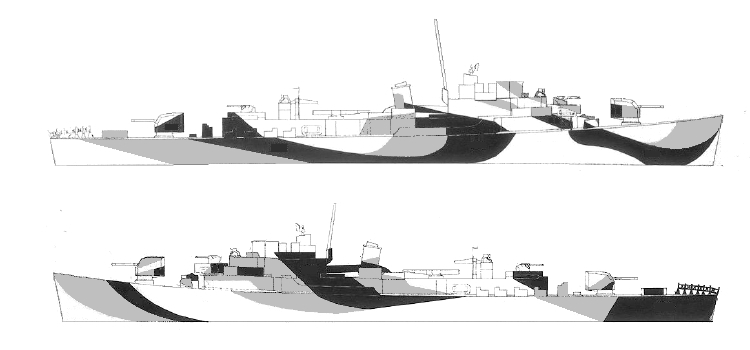
This is a silhouette of Drawing 32/14D for the John C. Butler class destroyer escorts using the colors: dull black (BK), ocean gray(5-O) and light gray (5-L) dated and signed by Everett Warner on May 17, 1944. An identical design drawing except using Measure 31 (BK, 5-O and 5-H haze gray) was dated on the same day. In this version of 14D the curves on the starboard side have been made more pronounced and the curves on the port side seem to reflect the starboard. These make this a distinctive design with sweeping curves.
A Design 14D drawing was attached to the July 15, 1943, memo to PacFleet for the Benson class destroyers. This design was also used on the cruiser USS Pensacola (CA-24) in Measure 32 colors and USS Salt Lake City (CA-25) in Measure 33 colors. Design 14D was used by seven Fletcher class destroyers in two colors and over twenty destroyer escorts in both two and three colors. It was also redrawn on June 28, 1944, for the heavy cruiser USS Wichita (CA-45), but probably was never used.
Original drawing source: NARA 80-G-109627, 80-G-109628 and 80-G-172882, 80-G-172883.
June 28, 1944 14D in Measure 32 for CA-45
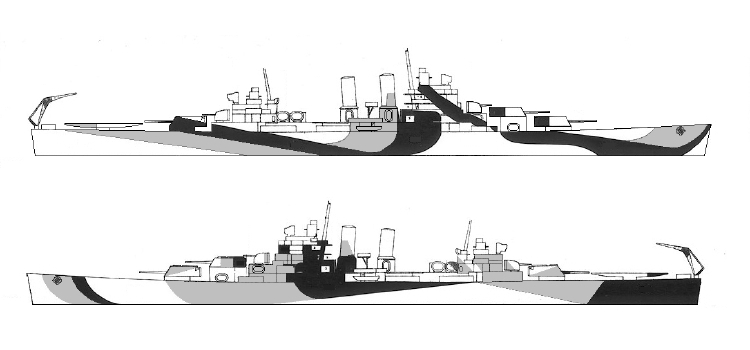
Design 32/14D drawn for the heavy cruiser USS Wichita dated June 28, 1944. The Measure 32 vertical colors were dull black (BK), ocean gray (5-O) and light gray (5-L) with the horizontal surfaces having a pattern of deck blue (20-B) and ocean gray (5-O). There is no evidence that this design was ever applied. This version of 14D is very similar to the previous DE version, but has only been enlarged and stretched for the larger hull.
A Design 14D drawing was attached to the July 15, 1943, memo to PacFleet for the Benson class destroyers. This design was also used on the heavy cruisers USS Pensacola (CA-24) in Measure 32 colors and USS Salt Lake City (CA-25) in Measure 33 colors using 5-N. Design 14D was used by seven Fletcher class destroyers in two colors and over twenty destroyer escorts in both two and three colors.
Original drawing source: NARA 80-G-174773 and 80-G-174774.
14L Designs
July 26, 1944 14L in Measure 33 for LCS(L)(3)
3 14L.jpg)
The silhouette from the drawing for Measure 33 Design 14L for LCS(L)(3) class large landing craft support ships dated July 26, 1944. The specified vertical colors were ocean green (5-OG) and pale green (5-PG) with ocean green and deck green (20-G) paint on horizontal surfaces.
This is the only Design 14L drawing yet found.
Original drawing source: NARA BS 73632 and BS 73633.
14T Designs
September 1944 14T in Measure 32 for APA-5
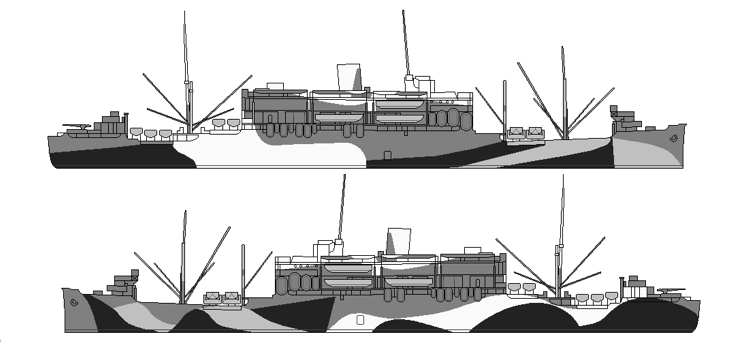
The silhouette from what the drawing for Measure 32 Design 14T for the attack transport USS Barnett (APA-5) formerly AP-11 may have looked like. This was probably dated September or October 1944. This design used four vertical colors for Measure 32: dull black (BK), ocean gray (5-O), haze gray and light gray (5-L) with deck blue (20-B) for the horizontal color. The landing craft were haze gray and there were two waterlines.
This is the only known drawing of Design 14T and was sent to Barnett on October 11, 1944.
Original drawing source: NARA ? This drawing was created from multiple ship photos.
15A Designs
March 6, 1944 15A in Measure 32 for CVE-55
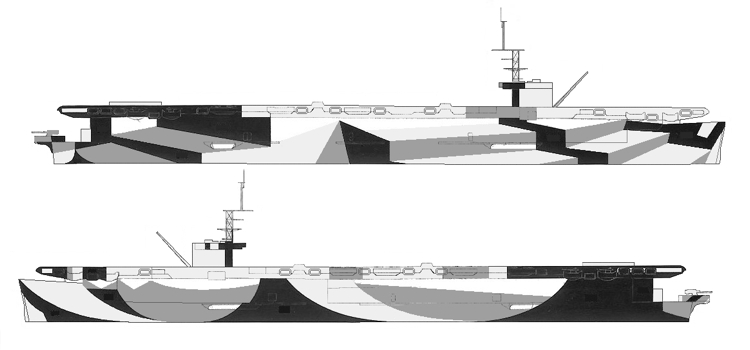
The silhouette from the drawing for Measure 32 Design 15A for the Casablanca class escort carriers; the original was dated March 6, 1944. The vertical colors were: dull black (BK), ocean gray (5-O), light gray (5-L) and pale gray (5-P). The starboard or upper hull pattern is very similar to the one that was used for the creation of Design 9D. The starboard pattern is much like the 9D or 2F pattern and consists of a wedge of ocean gray and black centered in the middle of the hull flanked by false perspective “stairs” with a dark set to the left and light sets to the right. The port pattern was very different from 9D or 2F and thus justified a new design number.
There has been only this drawing for Design 15A yet found.
Original drawing source: NARA 80-G-170033 and 80-G-170034.
15Ax Designs
June 14, 1944 15Ax in Measure 32 for AV-7
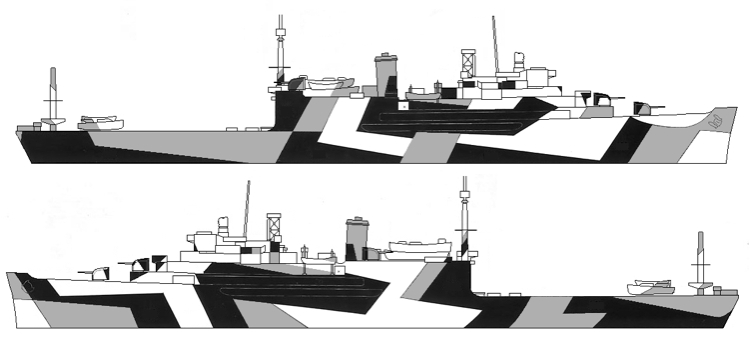
The silhouette from the drawing for Design 12Ax for Currituck class seaplane tenders dated June 14, 1944. The Measure 32 vertical colors were dull black (BK), ocean gray (5-O) and light gray (5-L) and the deck was all deck blue (20-B).
This is the only version of Design 15Ax that has been found.
Original drawing source: NARA 80-G-174551 and 80-G-174552.
15F Designs
August 17, 1944 15F in Measure 12 for APA-57

The silhouette from the drawing for Design 15F for the Gilliam class attack transports using the (S4-SE2-BD1) maritime hull dated August 17, 1944. This drawing specified four Measure 32 vertical colors of light gray (5-L), haze gray (5-H), ocean gray (5-O), and navy blue (5-N) with the horizontal color of deck blue (20-B) and was labeled as “Measure 12 modified”. I am not sure if the label was a mistake or not since this drawing is identified in memos as Measure 12. It is similar to the graded nature of Measure 12, but Measure 12 had not previously had any specific pattern applied. It was also misidentified as for USS Artemis (AKA-21) class, but the profile was for the USS Gilliam (APA-57). The landing boats were haze gray and the added note read: “life rafts are to receive a light mist of paint shade indicated.” There were also two waterlines: a light load line and a load waterline.
This is the only drawing for Design 15F that has yet been found.
Original drawing source: NARA 80-G-177459 and 80-G-177460.
15L Designs
May 29, 1944 15L in Measure 31 for LSV-1
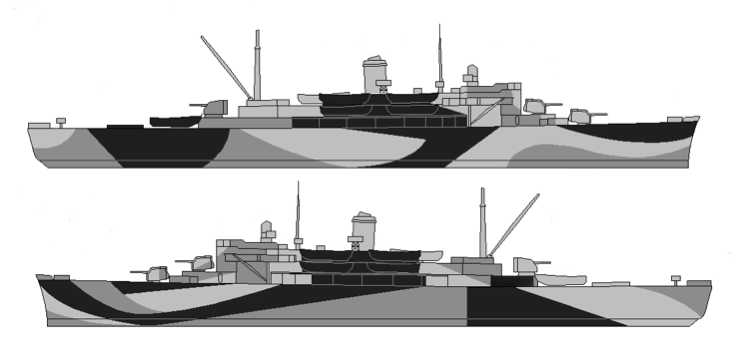
The silhouette from the drawing for Measure 31 Design 15L for LSV-1 class vehicle landing ships dated May 29, 1944. The specified vertical colors were dull black (BK), navy green (5-NG) and ocean green (5-OG), with deck green (20-G) on horizontal surfaces.
This is the only drawing for Design 15L that has yet been found.
Original drawing source: NARA 80-G-172983 and 80-G-172984.
15P Designs
October 14, 1944 15P in Measure 32a for SC-1266

The silhouette from the drawing for Measure 32a Design 15P for the SC-1266 class subchasers dated October 14, 1944. The specified vertical colors were ocean gray (5-O) and haze gray (5-H), with deck blue (20-B) on horizontal surfaces.
This is the only drawing for Design 15P that has yet been found.
Original drawing source: NARA 19-N-73626 and 19-N-73627.
15T Designs
November 22, 1944 15T in Measure 31 for APD-1
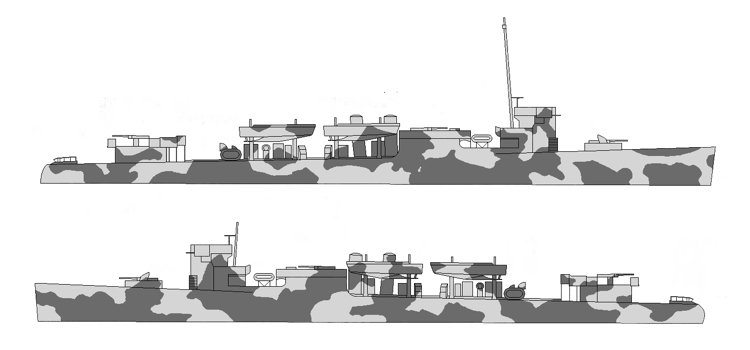
The silhouette from the drawing for Measure 31 Design 15T for the APD-1 class high speed transports dated Novenber 22, 1944. The specified vertical colors were navy green (5-NG) and ocean green (5-OG) with deck green paint on horizontal surfaces. This design is similar to Design 12T but without the black panels.
This is the only version of Design 15T yet found.
Original drawing source: NARA BS 100074 and BS 100075.
16A Designs
June 1, 1944 16A in Measure 32 for CVE-55
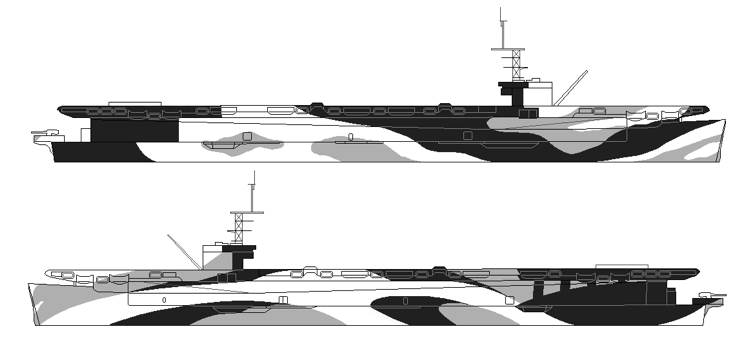
The silhouette from the drawings for Measure 32 Design 16A for the Casablanca class escort carriers dated June 1, 1944. The vertical colors were listed as dull black (BK), ocean gray (5-O) and light gray (5-L) with deck blue (20-B) on the horizontal surfaces.
This is the only drawing for Design 16A that has yet been found.
Original drawing source: NARA 80-G-172895 and 80-G-172901.
16Ax Designs
July 4, 1944 16Ax in Measure 31 for ATR-1
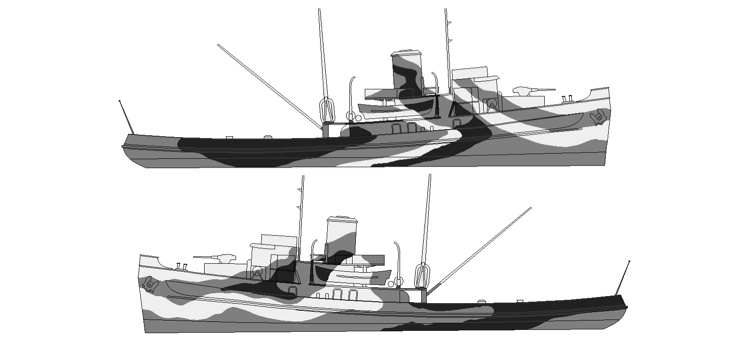
The silhouette from the drawing for Measure 31 Design 16Ax for ATR-1 class rescue tugs dated July 4, 1944. The specified vertical colors were dull black (BK), navy blue (5-N) and haze gray (5-H) with deck blue (20-B) paint on horizontal surfaces.
This is the only drawing for Design 16Ax yet found.
Original drawing source: NARA 80-G-174547 and 80-G-174548.
16D Designs
July 15, 1943 ? 16D in Measure 32 for DD-348
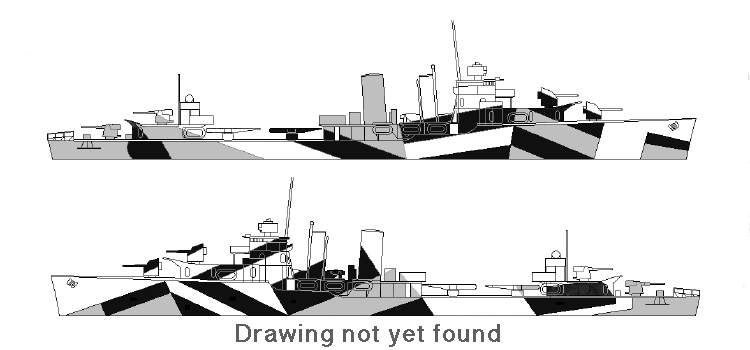
This is recreation of what the earliest design drawing for Design 16D might have looked like for the Farragut class destroyers dated July 15, 1943. This was one of the designs included with the July 15, 1943, memo to PacFleet, but has yet to be found.
Some parts of Design 16D were derived from an earlier pattern used for Measure 16. Design 16D was also drawn for Allen M. Sumner and Gleaves classes of destroyers, Buckley class destroyer escorts, Bayfield class attack transports and for Tacoma class frigates. The cruiser USS Baltimore (CA-68) and the battleship USS California (BB-44) also wore Design 16D.
Original drawing source: NARA ?
December 20, 1943 16D in Measure 32 for BB-43
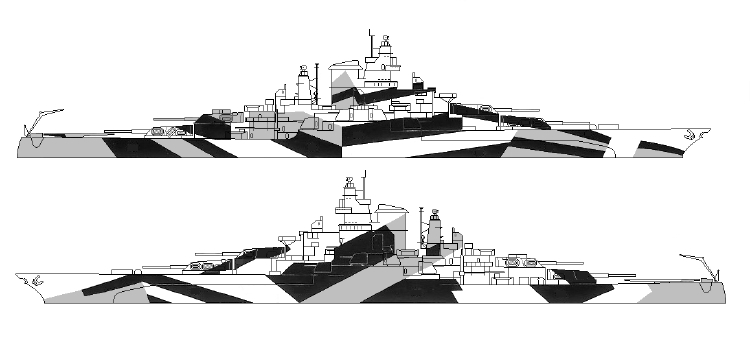
The silhouette of Design 16D for the Tennessee class battleships and worn by USS California (BB-44). This design drawing for Measure 32/16D was dated December 20, 1943.
A Design 16D drawing was attached to the July 15, 1943, memo to PacFleet for the Farragut class destroyers. Some parts of Design 16D were derived from an earlier pattern used for Measure 16. Design 16D was also drawn for Allen M. Sumner and Gleaves classes of destroyers, Buckley class destroyer escorts, Bayfield class attack transports and for Tacoma class frigates. The cruiser USS Baltimore (CA-68) also wore Design 16D. The design drawing for the Allen M. Sumner class varies from this drawing on the port side from the area under the bridge forward, in that the stripes are reversed in direction.
Original drawing source: NARA 80-G-162038 and 80-G-162039.
December 20, 1943 16D in open Measure for CA-68

The silhouette of Design 16D for the Baltimore class heavy cruisers and worn by USS Baltimore (CA-68). This design drawing for 16D was also dated December 20, 1943, and is similar to the previous 16D except in parts of the superstructure.
A Design 16D drawing was attached to the July 15, 1943, memo to PacFleet for the Farragut class destroyers. Some parts of Design 16D were derived from an earlier pattern used for Measure 16. Design 16D was also drawn for Allen M. Sumner and Gleaves classes of destroyers, Buckley class destroyer escorts, Bayfield class attack transports and for Tacoma class frigates. The battleship USS California (BB-44) also wore Design 16D. The design drawing for the Allen M. Sumner class varies from this drawing on the port side from the area under the bridge forward, in that the stripes are reversed in direction.
Original drawing source: NARA 80-G-109723 and 80-G-109724.
December 1943 ? 16D in open Measure for DE-51
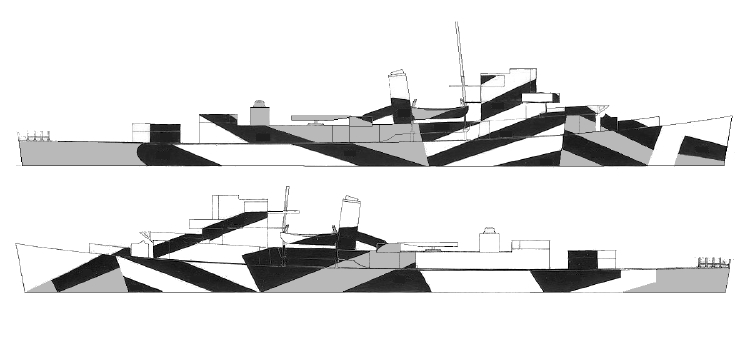
The silhouette of Design 16D for the Buckley class destroyer escorts. This design drawing for Measure 3_/16D was also probably dated December 1943, and is similar to the previous 16D designs except in parts of the superstructure.
A Design 16D drawing was attached to the July 15, 1943, memo to PacFleet for the Farragut class destroyers. Some parts of Design 16D were derived from an earlier pattern used for Measure 16. Design 16D was also drawn for Allen M. Sumner and Gleaves classes of destroyers, Bayfield class attack transports and for Tacoma class frigates. The battleship USS California (BB-44) and the heavy cruiser USS Baltimore (CA-68) also wore Design 16D. The design drawing for the Allen M. Sumner class varies from this drawing on the port side from the area under the bridge forward, in that the stripes are reversed in direction.
Original drawing source: NARA 80-G-162036 and 80-G-162037.
January 11, 1944 16D in Measure 32 for APA-33
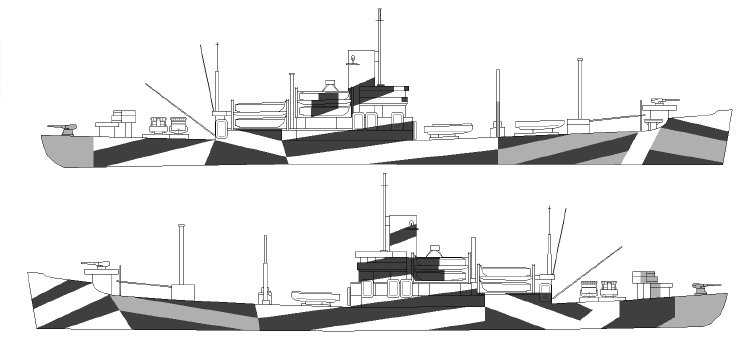
The silhouette of Design 16D for the Bayfield class attack transports. This design drawing used Measure 32 and was dated January 11, 1944. This version has some changes but is still identifiable as Design 16D.
A Design 16D drawing was attached to the July 15, 1943, memo to PacFleet for the Farragut class destroyers. Some parts of Design 16D were derived from an earlier pattern used for Measure 16. Design 16D was also drawn for Allen M. Sumner and Gleaves classes of destroyers, Buckley class destroyer escorts and for Tacoma class frigates. The battleship USS California (BB-44) and the heavy cruiser USS Baltimore (CA-68) also wore Design 16D. The design drawing for the Allen M. Sumner class varies from this drawing on the port side from the area under the bridge forward, in that the stripes are reversed in direction.
Original drawing source: NARA 80-G-164286 and 80-G-164287.
January 16, 1944 16D in Measure 31 for DD-445
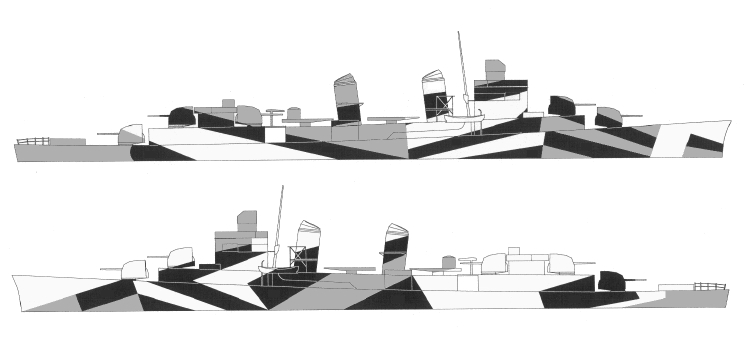
The silhouette of Design 16D for the Fletcher class destroyers. This design drawing used Measure 31: dull black (BK), ocean gray (5-O) and haze gray (5-H) for the vertical colors and was dated January 16, 1944. Measure 32 colors would be dull black, ocean gray and light gray (5-L). This version is very similar to the version for the Buckley class destroyer escorts.
A Design 16D drawing was attached to the July 15, 1943, memo to PacFleet for the Farragut class destroyers. Some parts of Design 16D were derived from an earlier pattern used for Measure 16. Design 16D was also drawn for Allen M. Sumner and Gleaves classes of destroyers, Buckley class destroyer escorts, Bayfield class attack transports and for Tacoma class frigates. The battleship USS California (BB-44) and the heavy cruiser USS Baltimore (CA-68) also wore Design 16D. The design drawing for the Allen M. Sumner class varies from this drawing on the port side from the area under the bridge forward, in that the stripes are reversed in direction.
Original drawing source: NARA 80-G-164290 and 80-G-164291.
February 9, 1944 16D in Measure 32 for PF-1
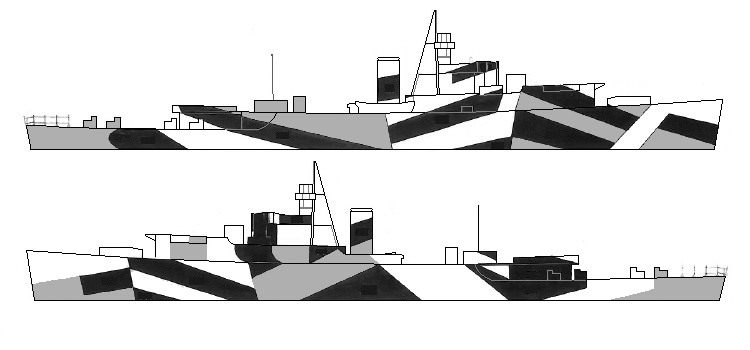
The silhouette of Design 16D for the Tacoma class frigates. This design drawing used Measure 32: dull black (BK), ocean gray (5-O) and light gray (5-L) and was dated February 9, 1944. There must have a version in Measure 31, since it was sent to at least 18 ships; it probably used dull black, ocean gray and haze gray (5-H) and would have been dated no later than June 19, 1944. This version of 16D for PF's is a slightly smaller version of the Fletcher class destroyers.
A Design 16D drawing was attached to the July 15, 1943, memo to PacFleet for the Farragut class destroyers. Some parts of Design 16D were derived from an earlier pattern used for Measure 16. Design 16D was also drawn for Allen M. Sumner and Gleaves classes of destroyers, Buckley class destroyer escorts, Bayfield class attack transports and for Fletcher class destroyers. The battleship USS California (BB-44) and the heavy cruiser USS Baltimore (CA-68) also wore Design 16D. The design drawing for the Allen M. Sumner class varies from this drawing on the port side from the area under the bridge forward, in that the stripes are reversed in direction.
Original drawing source: NARA 80-G-1657557 and 80-G-165758.
February , 1944 ? 16D in Measure 31 for DD-692
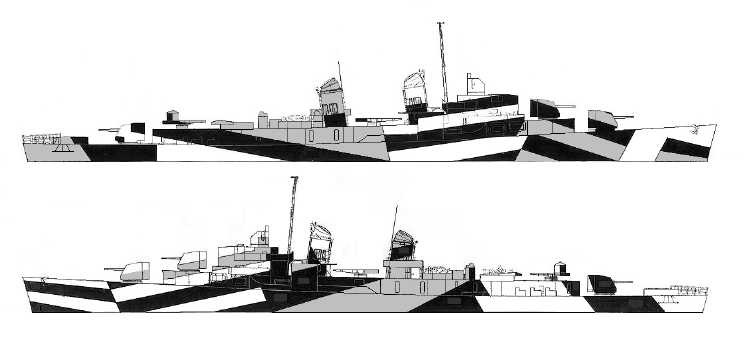
The silhouette of Design 16D for the Allen M. Sumner class destroyers. This design drawing used Measure 31 colors and was probably dated February 1944. This version has been slightly modified on the port side from the area under the bridge forward, in that the stripes are reversed in slant direction.
A Design 16D drawing was attached to the July 15, 1943, memo to PacFleet for the Farragut class destroyers. Some parts of Design 16D were derived from an earlier pattern used for Measure 16. Design 16D was also drawn for Gleaves classes of destroyers, Buckley class destroyer escorts, Bayfield class attack transports and for Fletcher class destroyers. The battleship USS California (BB-44) and the heavy cruiser USS Baltimore (CA-68) also wore Design 16D.
Original drawing source: NARA 80-G-170940 and 80-G-170941.
June 7 , 1944 16D in Measure 32 for DD-423
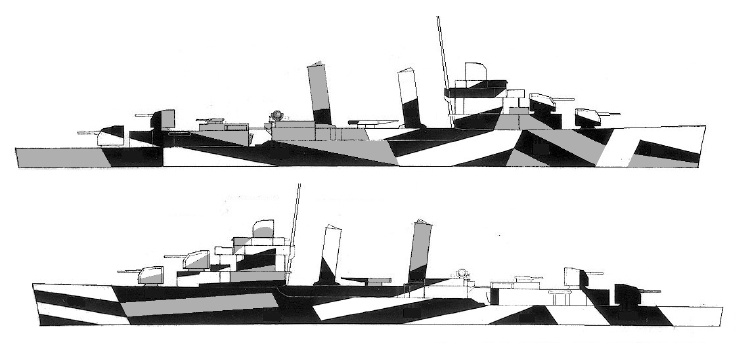
The silhouette of Design 16D for the Gleaves class destroyers. This design drawing used Measure 32 colors and was dated June 7, 1944. This version continues with the port side bow stripes being reversed in slant direction.
A Design 16D drawing was attached to the July 15, 1943, memo to PacFleet for the Farragut class destroyers. Some parts of Design 16D were derived from an earlier pattern used for Measure 16. Design 16D was also drawn for Buckley class destroyer escorts, Bayfield class attack transports and for Fletcher class destroyers. The battleship USS California (BB-44) and the heavy cruiser USS Baltimore (CA-68) also wore Design 16D.
Original drawing source: NARA 80-G-172981 and 80-G-172982.
August 4, 1944 16D in Measure 32 for AOG-17
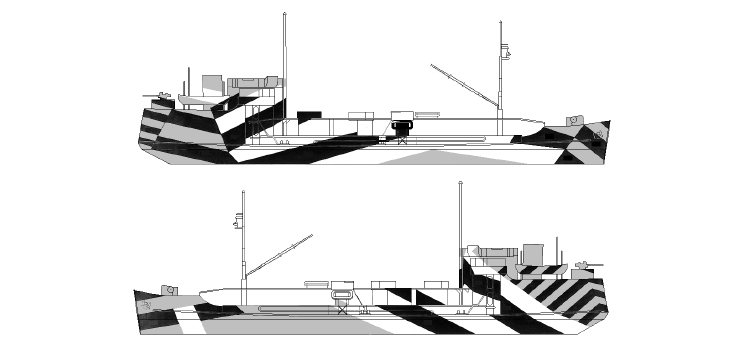
The silhouette of Design 16D for the Mettawee class gasoline tankers. This design drawing used Measure 32 colors and was dated June 7, 1944. This version is highly reworked with smaller and more numerous stripes, but still is Design 16D.
A Design 16D drawing was attached to the July 15, 1943, memo to PacFleet for the Farragut class destroyers. Some parts of Design 16D were derived from an earlier pattern used for Measure 16. Design 16D was also drawn for Buckley class destroyer escorts, Bayfield class attack transports and for Fletcher class destroyers. The battleship USS California (BB-44) and the heavy cruiser USS Baltimore (CA-68) also wore Design 16D.
Original drawing source: NARA 80-G-177455 and 80-G-177456.
16P Designs
November 11, 1944 16P in Measure 32a for PCS-1376

The silhouette from the drawing for Measure 32a Design 16P for the PCS-1376 class of patrol craft sweepers dated November 11, 1944. The specified vertical colors were ocean gray (5-O) and haze gray (5-H), with deck blue (20-B) on horizontal surfaces.
This is the only drawing for Design 16P that has yet been found.
Original drawing source: NARA San Bruno PHNY corr. box 39.
16T Designs
November 22, 1944 16T in Measure 31a for APA-25
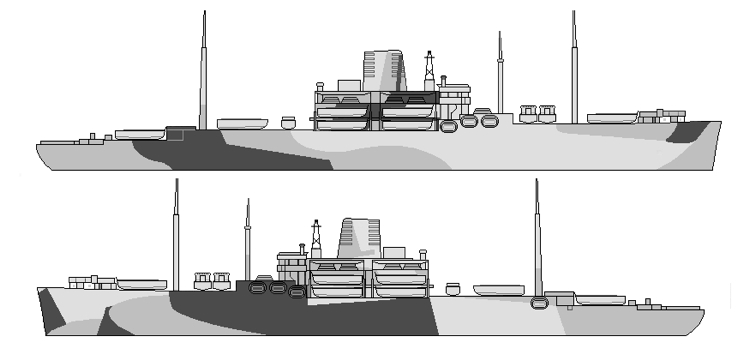
The silhouette from the drawing for Measure 31a Design 16T for the Aurthur Middleton class attack transports using the (C3-P&C) maritime hull dated November 22, 1944. This drawing specified Measure 31a vertical colors of haze gray (5-H), ocean gray (5-O), and navy blue (5-N) with the horizontal color of deck blue (20-B).
This is the only drawing for Design 16T that has yet been found.
Original drawing source: NARA BS 100064 and BS 100065.
17A Designs
June 12, 1944 17A in Measure 32 for CV-9
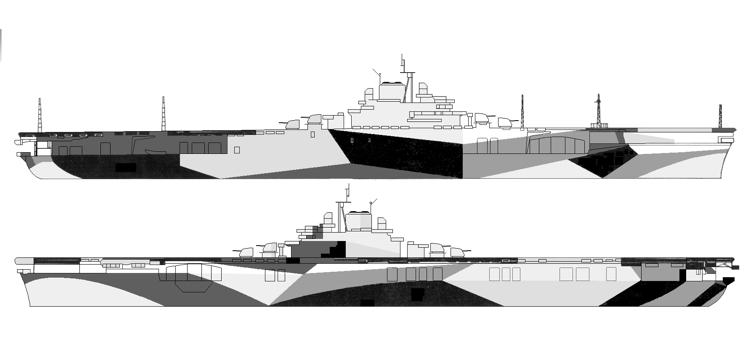
The silhouette from the Measure 32 Design 17A drawing for the Essex class carriers dated June 12, 1944. The vertical colors were specified to be dull black (BK), navy blue (5-N), ocean gray (5-O), haze gray (5-H), light gray (5-L) and pale gray (5-P) with the horizontal surfaces deck blue (20-B). This was probably the only camouflage design that used six colors vertically.
The first Design 17A drawing was dated June 12, 1944, for the Essex class carriers using Measure 32. On October 12, 1944 Design 17A was redrawn and simplified again for the Essex class carriers.
Original drawing source: NARA 19-N-100081.
October 12, 1944 17A in Measure 32 for CV-9
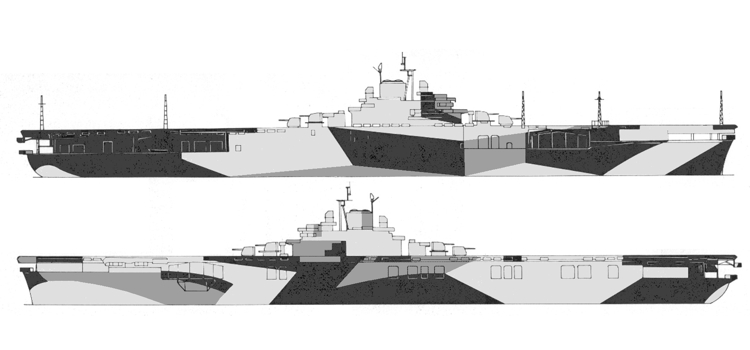
The silhouette from the second version of the Measure 32 Design 17A drawing for the Essex class carriers on October 12, 1944. The vertical colors were specified to be navy blue (5-N), ocean gray (5-O) and haze gray (5-H) with the horizontal surfaces deck blue (20-B). The vertical color range used a color range that has been called Measure 31a. This version resembles the first version of Design 17A in most of the larger panels and was probably easier to paint and maintain.
The first Design 17A drawing was dated June 12, 1944, for the Essex class carriers using Measure 32. On October 12, 1944 Design 17A was redrawn and simplified again for the Essex class carriers as above.
Original drawing source: NARA 19-N-100080.
17Ax Designs
July 14, 1944 17Ax in Measure 32 for AT-66
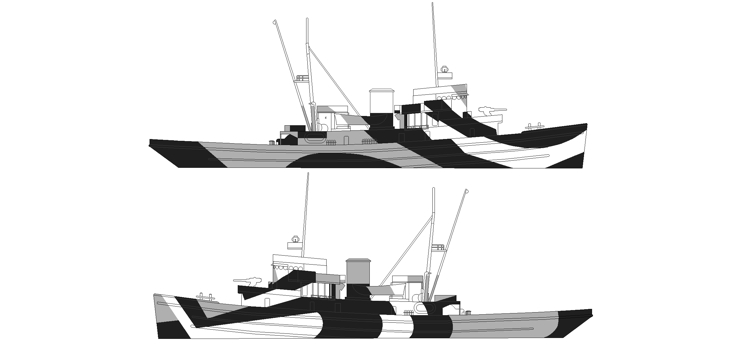
The silhouette from the drawing for Measure 31 Design 17Ax for AT-66 class ocean tugs dated July 14, 1944. The specified vertical colors were dull black (BK), ocean gray (5-O) and light gray (5-L) with deck blue (20-B) on horizontal surfaces.
This is the only drawing for Design 17Ax yet found.
Original drawing source: NARA 80-G-174537 and 80-G-174538.
17D Designs
March 1943 17D in Measure 33 for DD-598
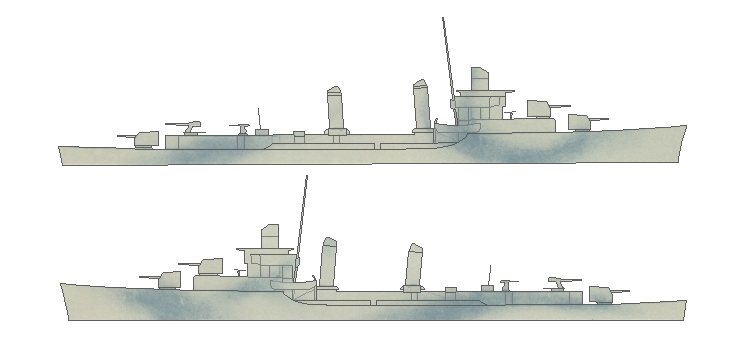
Here is the silhouette of the design drawing for Measure 33/17D for the Benson class destroyers using the profile of USS Bancroft (DD-598) that was attached to the March 1943 Supplement to SHIPS-2. The vertical colors were pale gray (5-P) with a sprayed pattern of haze gray (5-H). The horizontal pattern had the direction: “Deck blue 20-B with light, misty application of haze gray pattern to break the sheer line.” Note, because of the lack of control in the color reproduction process, these colors may not be a true match to the actual colors.
This is the only Design 17D that has yet been found.
Original drawing source: March 1943 Supplement to SHIPS-2 Plate XX.
17F Designs
November 1944 ? 17F in Measure 31a for APA-117
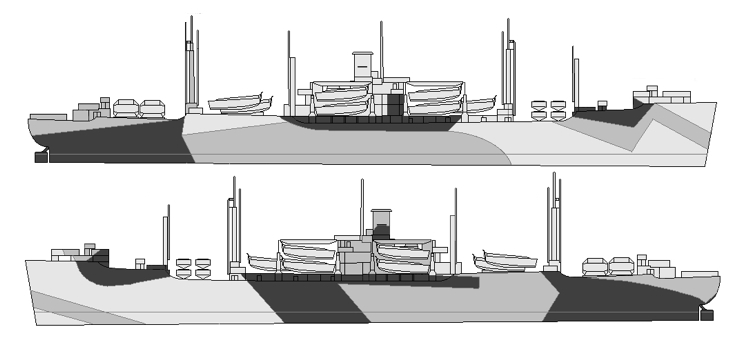
The silhouette from what the drawing for Measure 31a Design 17F for the Haskell class of attack transports using a (VC2-S-AP5) maritime hull may have looked like. This was probably dated September or November 1944. This design used the vertical colors for Measure 31a: navy blue (5-N), ocean gray (5-O) and haze gray (5-H) with deck blue (20-B) for the horizontal color.
The Design 17F drawing was sent to APA-228 on November 7, 1944, and later to APA-144 and APA-145 on December 9,1944. No archived copy of this design has yet been found.
Original drawing source: NARA ? This drawing was created from multiple ship photos.
17L Designs
July 13, 1944 17L in Measure 31 for LSM-1
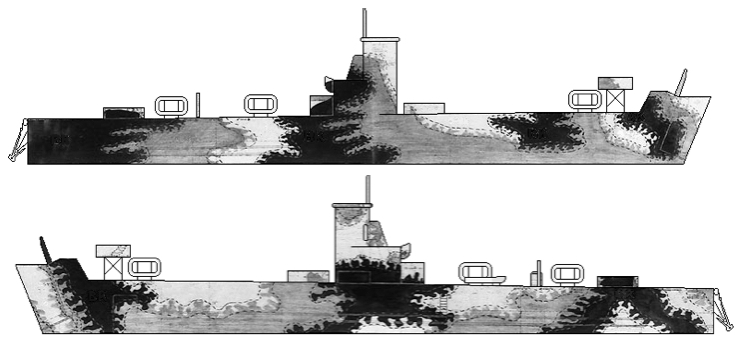
The silhouette from the drawing for Measure 31 Design 17L for LSM-1 class medium landing ships dated July 13, 1944. The specified vertical colors were dull black (BK), navy green (5-NG) and ocean green (5-OG) with navy green (5-NG), deck green (20-G) and glossy black paint on horizontal surfaces. Note the treatment of the edges of the panels; this drawing included a diagram showing how the edges were to be painted.
This is the only drawing for Design 17L yet found.
Original drawing source: NARA 80-G-176519 and 80-G-176520.
17T Designs
November 30, 1944 17T in Measure 31a for AP-130

The silhouette from the drawing for Measure 31a Design 17T for the General G. O. Squier class transports using the (C4-S-A1) maritime hull dated November 30, 1944. This drawing specified the Measure 31a vertical colors of haze gray (5-H), ocean gray (5-O), and navy blue (5-N) with the horizontal color of deck blue (20-B).
This is the only drawing for Design 17T that has yet been found.
Original drawing source: NARA BS 100396 and BS 100397.
18A Designs
November 30, 1944 18A in Measure 33 for CVE-55
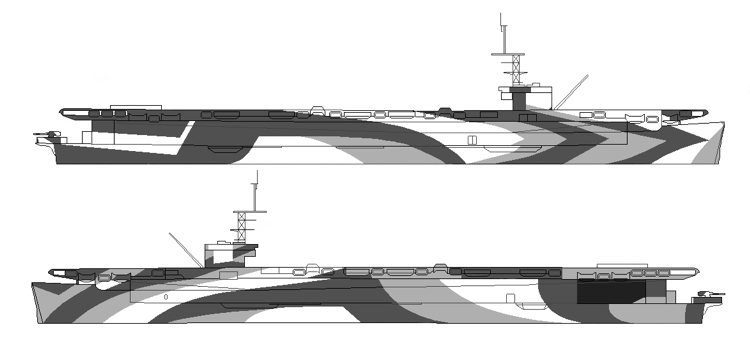
The silhouette from the drawing for Measure 33 Design 18A for the Casablanca class escort carriers dated June 26, 1944. The vertical colors were listed as dull black (BK), navy blue (5-N), haze gray (5-H) and pale gray (5-P) with deck blue (20-B) on the horizontal surfaces. This drawing provided both a bow view and a stern view.
The only drawing for Design 18A yet found was this one above.
Original drawing source: NARA 80-G-174770 and 80-G-174771.
18D Designs
June 1942 Measure 16 Pattern for AK-25
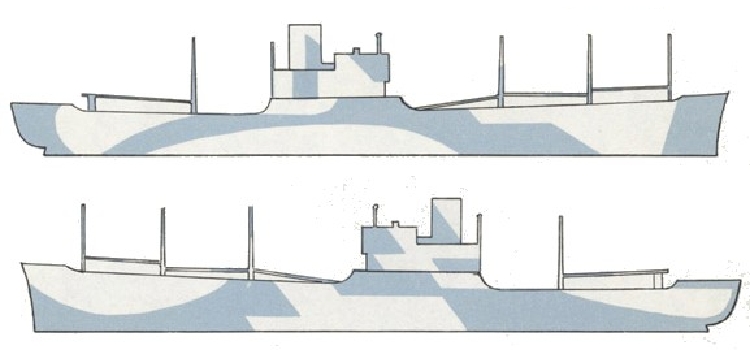
The earliest design for Design 18D began as a pattern that was included in the June 1942 version of SHIPS-2 as a Measure 16 pattern for the USS Algorab (AK-25) a (C-2) cargo ship. The light color was white (5-U) and the pattern was Thayer Blue (5-B). Note, the color for Thayer Blue on this plate may not be an exact match to the actual color. Later versions of Design 18D used three colors.
Design 18D was derived from an earlier pattern suggested in the June 1942 revision to SHIPS-2 to be used with Measure 16 introduced by that document. A Design 18D drawing was attached to the July 15, 1943, memo to PacFleet for the Fletcher class destroyers. Design 18D was dated December 1943 when drawn for the Baltimore class heavy cruisers and it was worn by USS Canberra (CA-70), USS Quincy (CA-71) and USS Pittsburgh (CA-72). The battleship USS North Carolina (BB-55) also wore Design 18D from November 1943 all the way through 1944.
Original drawing source: Plate XII attached to June 1942 version of SHIPS-2.
July 15, 1943 ? 18D in Measure 32 for DD-445

The earliest design drawing for Design 18D was drawn for the Fletcher class destroyers dated July 15, 1943, and attached to the July 1943 memo from BuShips to PacFleet has yet to be found.
Design 18D was derived from an earlier pattern suggested in the June 1942 revision to SHIPS-2 to be used with Measure 16 introduced by that document. A Design 18D drawing was attached to the July 15, 1943, memo to PacFleet for the Fletcher class destroyers. Design 18D was dated December 1943 when drawn for the Baltimore class heavy cruisers and it was worn by USS Canberra (CA-70), USS Quincy (CA-71) and USS Pittsburgh (CA-72). The battleship USS North Carolina (BB-55) also wore Design 18D from November 1943 all the way through 1944.
Original drawing source: NARA ?
August 19, 1943 18D in Measure 32 for DD-445
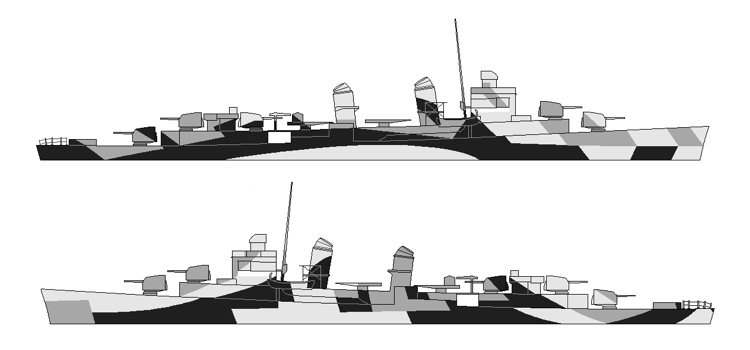
A silhouette of the design drawing for Measure 32/18D drawn on August 19, 1943, for the Fletcher class destroyers. This drawing used the profile of a “round bridge” Fletcher and included the platform and tubs for 20mm AA guns in front of the bridge which most of the Fletchers had replaced by 1944 and I have deleted. Also note the area of white countershading on both sides under the bridge wings. This drawing was probably not much different than the previous one in July 1943.
Design 18D was derived from an earlier pattern suggested in the June 1942 revision to SHIPS-2 to be used with Measure 16 introduced by that document. A Design 18D drawing was attached to the July 15, 1943, memo to PacFleet for the Fletcher class destroyers. Design 18D was dated December 1943 when drawn for the Baltimore class heavy cruisers and it was worn by USS Canberra (CA-70), USS Quincy (CA-71) and USS Pittsburgh (CA-72). The battleship USS North Carolina (BB-55) also wore Design 18D from November 1943 all the way through 1944.
Original drawing source: NARA 80-G-156814 and 80-G-156815.
September 1943 ? 18D in Measure 32 for BB-55
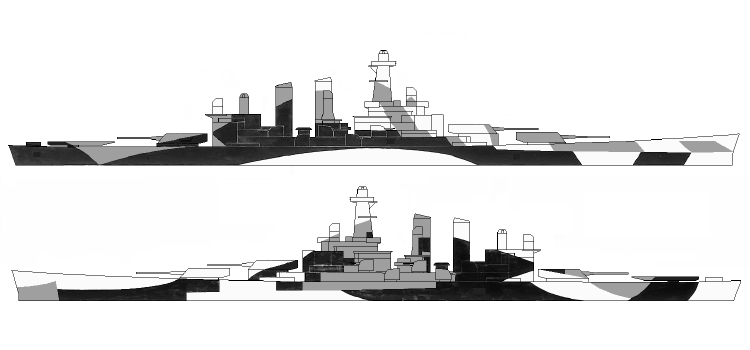
The design silhouette for Measure 32/18D for the North Carolina class battleships drawn probably in August or September 1943. The Measure 32 vertical colors were light gray (5-L), ocean gray (5-O) and dull black (BK). The pattern has remained similar to the Fletcher version. However, North Carolina actually used a slightly different version of this design probably from another drawing which is yet to be found.
Design 18D was derived from an earlier pattern suggested in the June 1942 revision to SHIPS-2 to be used with Measure 16 introduced by that document. A Design 18D drawing was attached to the July 15, 1943, memo to PacFleet for the Fletcher class destroyers. Design 18D was dated December 1943 when drawn for the Baltimore class heavy cruisers and it was worn by USS Canberra (CA-70), USS Quincy (CA-71) and USS Pittsburgh (CA-72). The battleship USS North Carolina (BB-55) also wore Design 18D from November 1943 all the way through 1944.
Original drawing source: NARA 80-G-157056 and 80-G-157057.
Deember 30, 1943 18D in Open Measure for CA-68
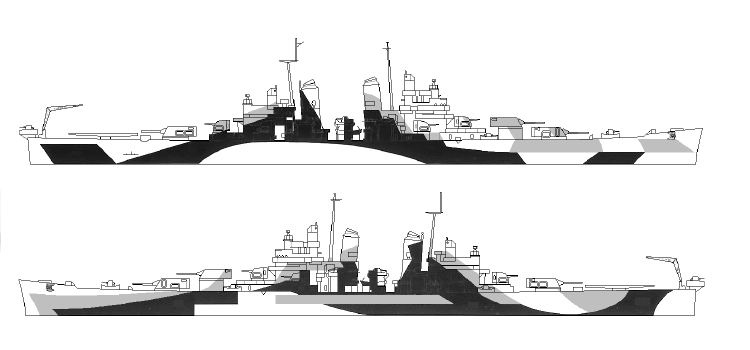
A silhouette of the design drawing for Measure 3_/18D for the Baltimore class of heavy cruisers drawn on December 30, 1943. There were no colors specified for this drawing, except dull black (BK) was labeled on the port and starboard views and ocean gray was labeled on the deck. Measure 32 vertical colors usually would be dull black (BK), ocean gray (5-O) and light gray (5-L) with the horizontal surfaces having a pattern of deck blue (20-B) and ocean gray (5-O). Measure 33 would only differ in the vertical colors: navy blue (5-N), haze gray (5-H) and pale gray (5-P).
Design 18D was derived from an earlier pattern suggested in the June 1942 revision to SHIPS-2 to be used with Measure 16 introduced by that document. A Design 18D drawing was attached to the July 15, 1943, memo to PacFleet for the Fletcher class destroyers. Design 18D was dated December 1943 when drawn for the Baltimore class heavy cruisers and it was worn by USS Canberra (CA-70), USS Quincy (CA-71) and USS Pittsburgh (CA-72). The battleship USS North Carolina (BB-55) also wore Design 18D from November 1943 all the way through 1944.
Original drawing source: NARA 80-G-157056 and 80-G-157057.
March 18, 1944 18D in Measure 32 for AD-9
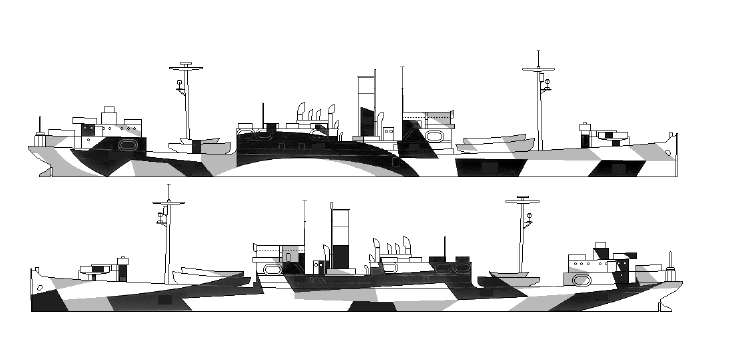
The silhouette for the design drawing for Measure 32/18D for the destroyer tender USS Blackhawk (AD-9) drawn on May 1, 1944. This version of Design 18D added some panels possibly to better break up the profile.
Design 18D was derived from an earlier pattern suggested in the June 1942 revision to SHIPS-2 to be used with Measure 16 introduced by that document. A Design 18D drawing was attached to the July 15, 1943, memo to PacFleet for the Fletcher class destroyers. Design 18D was dated December 1943 when drawn for the Baltimore class heavy cruisers and it was worn by USS Canberra (CA-70), USS Quincy (CA-71) and USS Pittsburgh (CA-72). The battleship USS North Carolina (BB-55) also wore Design 18D from November 1943 all the way through 1944.
Original drawing source: NARA 80-G-172525 and 80-G-172531.
March 21 , 1944 18D in Measure 32 for DD-445

This is the silhouette of Design 18D in Measure 32 colors redrawn for the Fletcher class destroyers on March 21, 1944. This version of Design 18D used the profile of a “square bridge” Fletcher and I have deleted the 20mm platform in front of the bridge to better match the 1944 profile of those Fletchers. The pattern here is almost identical to the earlier one for Fletcher.
Design 18D was derived from an earlier pattern suggested in the June 1942 revision to SHIPS-2 to be used with Measure 16 introduced by that document. A Design 18D drawing was attached to the July 15, 1943, memo to PacFleet for the Fletcher class destroyers. Design 18D was dated December 1943 when drawn for the Baltimore class heavy cruisers and it was worn by USS Canberra (CA-70), USS Quincy (CA-71) and USS Pittsburgh (CA-72). The battleship USS North Carolina (BB-55) also wore Design 18D from November 1943 all the way through 1944.
Original drawing source: NARA 80-G-170936 and 80-G-170937.
July 4, 1944 18D in Measure 31 for ATR-1

This is a silhouette from the drawing for Design 18D drawn for the ATR-1 class rescue tugs on July 4, 1944. The specified vertical colors for Measure 31 were: dull black (BK), navy blue (5-N) and haze gray (5-H) with ocean gray (5-O) and deck blue (20-B) on horizontal surfaces. This version of Design 18D is highly modified from previous versions probably to fit on the much smaller hull.
Design 18D was derived from an earlier pattern suggested in the June 1942 revision to SHIPS-2 to be used with Measure 16 introduced by that document. A Design 18D drawing was attached to the July 15, 1943, memo to PacFleet for the Fletcher class destroyers. Design 18D was dated December 1943 when drawn for the Baltimore class heavy cruisers and it was worn by USS Canberra (CA-70), USS Quincy (CA-71) and USS Pittsburgh (CA-72). The battleship USS North Carolina (BB-55) also wore Design 18D from November 1943 all the way through 1944.
Original drawing source: NARA 80-G-174760 and 80-G-174761.
July 25, 1944 18D in Measure 32 for DD-106
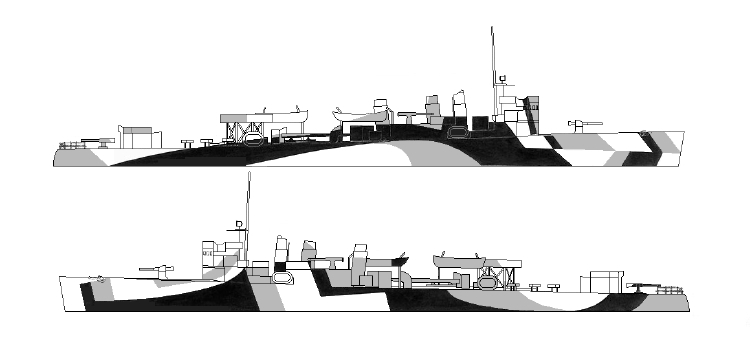
This is a silhouette from the drawings for Design 18D for the USS Chew (DD-106) on July 25, 1944. The specified vertical colors were Measure 31: dull black (BK), ocean gray (5-O) and ligh gray (5-L) with ocean gray (5-O) and deck blue (20-B) on horizontal surfaces. This version of Design 18D is similar to previous versions for cruisers and destroyers.
Design 18D was derived from an earlier pattern suggested in the June 1942 revision to SHIPS-2 to be used with Measure 16 introduced by that document. A Design 18D drawing was attached to the July 15, 1943, memo to PacFleet for the Fletcher class destroyers. Design 18D was dated December 1943 when drawn for the Baltimore class heavy cruisers and it was worn by USS Canberra (CA-70), USS Quincy (CA-71) and USS Pittsburgh (CA-72). The battleship USS North Carolina (BB-55) also wore Design 18D from November 1943 all the way through 1944.
Original drawing source: NARA 80-G-176513 and 80-G-176514.
18F Designs
October 17, 1944 18F in Measure 32 for AE-1
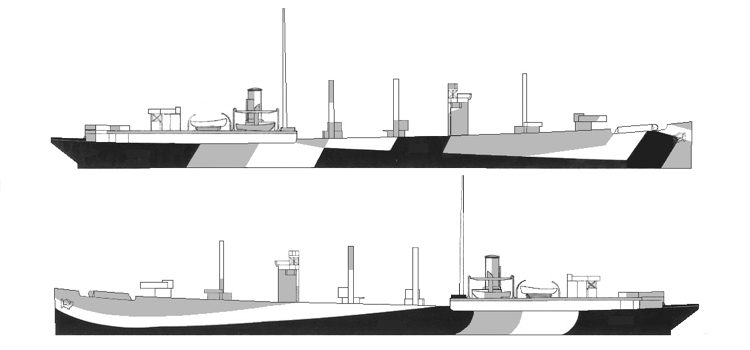
The silhouette from the drawing for Measure 32 Design 18F for the Pyro class ammunition ships dated October 17, 1944. This drawing specified the Measure 32 vertical colors of light gray (5-L), ocean gray (5-O), and navy blue (5-N) with the horizontal color of deck blue (20-B).
This is the only drawing for Design 18F that has yet been found.
Original drawing source: NARA 19-N-73624 and 19-N-73625.
18L Designs
June 16, 1944 18L in Measure 31 for LST-1
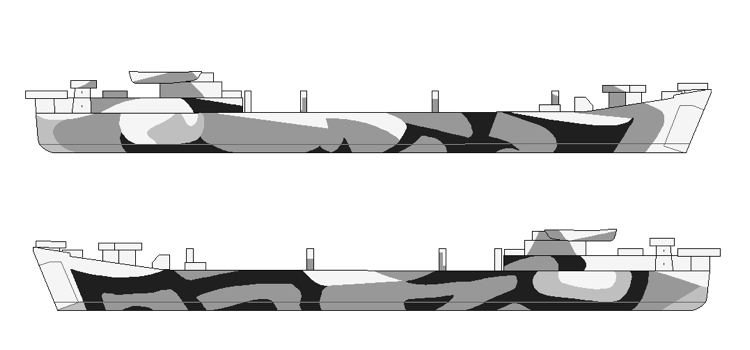
The silhouette from the drawing for Measure 31 Design 18L for LST's and similar ships dated June 16, 1944. The specified vertical colors were dull black (BK), ocean green (5-OG), brown (3-A) and haze gray (5-H) with deck green paint on horizontal surfaces. This is almost a copy of Design 8L for LST's and may have been intended as a replacement since this drawing includes a load waterline.
This is the only drawing for Design 18L yet found.
Original drawing source: NARA 80-G-173488 and 80-G-173489.
19D Designs
1943 ? 19D in Measure 32 for DE-51
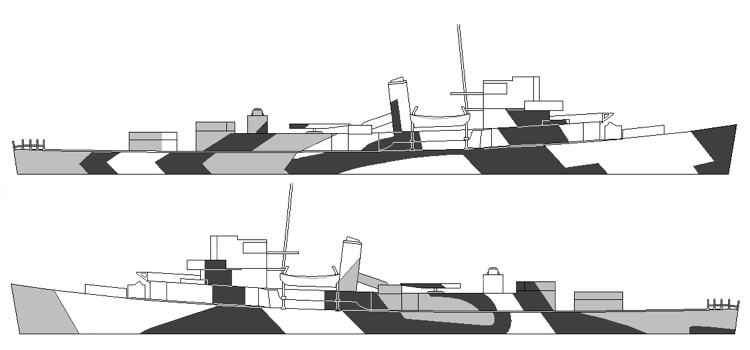
The silhouette from the drawing for Design 19D for the Buckley class destroyer escorts in Measure 32, using navy blue (5-N), haze gray (5-H) and pale gray (5-P); which combination was usually labeled Measure 33. Both a bow view and a stern view were provided. The style of this drawing indicates it was probably drawn-up in 1943 or very early 1944. No destroyer escorts are known to have used this version of Design 19D.
No other drawings of Design 19D have been found.
Original drawing source: NARA 80-G-150621 and 80-G-150623.
19F Designs
October 25, 1944 19F in Measure 31a for AKA-11
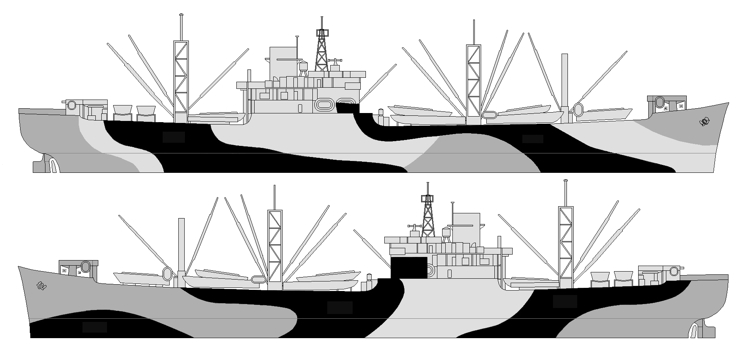
This is the earliest design drawing for Measure 31a Design 19F drawn on October 25, 1944 for the attack cargo ship USS Betelgeuse (AKA-11) using the (C2) maritime hull. This drawing specifies vertical colors of haze gray (5-H), ocean gray (5-O), and navy blue (5-N) with the horizontal color of deck blue (20-B). This drawing also has two waterlines and the color of the boats is apparently 5-H.
Design 19F was also drawn on November 4, 1944, for the attack cargo ship USS Oberon (AKA-14), a (C2-F) maritime hull.
Original drawing source: NARA 19-N-100078 and 19-N-100079.
Novenber 4, 1944 19F in Measure 31a for AKA-14
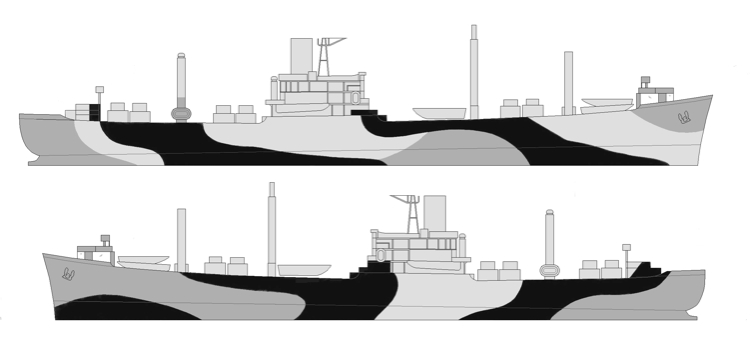
This is a silhouette of the drawing for Measure 31a Design 19F for the attack cargo ship USS Oberon (AKA-14) using the (C2-F) maritime hull drawn on November 4, 1944. This drawing specifies vertical colors of haze gray (5-H), ocean gray (5-O), and navy blue (5-N) with the horizontal color of deck blue (20-B). This drawing also has two waterlines and does not indicate the color of the boats.
Design 19F was also drawn on October 25, 1944, for the USS Betelgeuse (AKA-11), a (C2) maritime hull attack cargo ship.
Original drawing source: NARA 19-N-100062 and 19-N-100063.
19L Designs
September 1944 ? 19L in Measure 32 for LCS(L)(3)
3 19L.jpg)
This is what the silhouette from the drawing for Measure 32 Design 19L for landing craft control ships (large) mark 3 (LCS(L)(3)'s) probably drawn September 1944, may have looked like. The specified vertical colors were probably ocean gray and light gray with deck blue on horizontal surfaces. Some ships used navy blue and haze gray on verticle sufaces.
The drawings for Design 19L have not yet been found in the archives. The existence of drawings is from the labels of ships photos taken by their builders.
Original drawing source: NARA ?
20A Designs
November 4, 1944 20A in Measure 31a for CVE-55
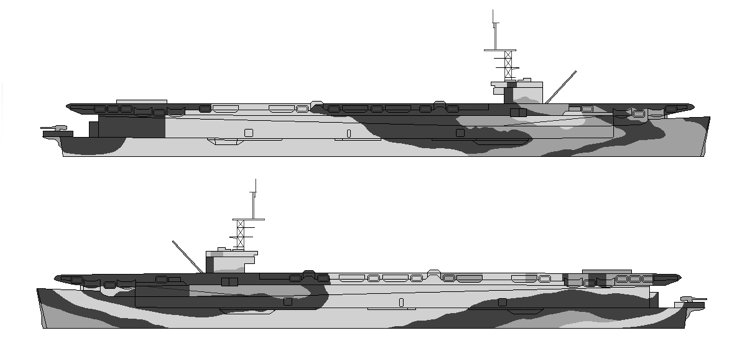
The silhouette from the drawing for Measure 31a Design 20A for the Casablanca class escort carriers dated November 4, 1944. The vertical colors were listed as navy blue (5-N), ocean gray (5-O) and haze gray (5-H) with deck blue (20-B) on the horizontal surfaces.
This is the only drawing for Design 20A yet found.
Original drawing source: NARA 19-N-100066 and 19-N-100067.
20L Designs
July 8. 1944 20L in Measure 31 Master Overlay
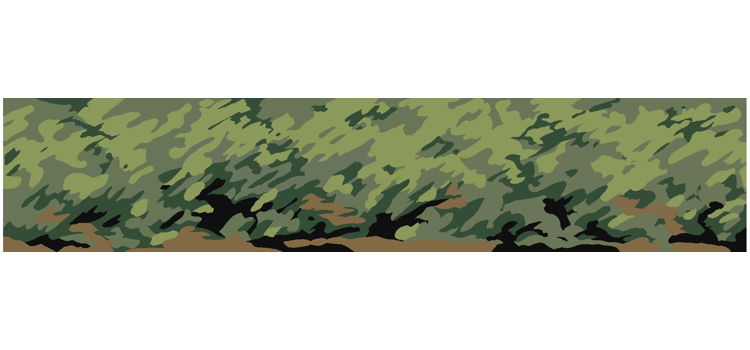
This is a restored Master for Measure 31 Design 20L sent to the Bureau of Ships on July 8, 1944, by the Fleet Maintenance Office (FMO) of the Commander Service Force Pacific Fleet (ComServPac). The colors were identified by chips which were to be matched using existing paints (such as white and green tint) and identified as Green 1, Green 2, Green 3, Brown and Black. However, green 1 was close to haze green, green 2 was similar to ocean green, green 3 was close to navy green and brown was similar to brown (4-A). This Master was intended to be overlaid on an existing ships's profile and the pattern of panels transferred to create a camouflage drawing that could be sent to a ship or yard for painting. Some examples of the result were also included. This Master was created during the time that Everett Warner was visiting and observing the Pacific Fleet, so it probably had his approval. Note, because of the color reproduction process these colors may not be an exact match to the originals.
The Master for Design 20L was sent to BuShips on July 8, 1944, and then was used to create camouflage drawings for many ship classes during July, August and September, such as LCT's, LST's, APD's, ARS's, and AN's.
Original drawing source: NARA San Bruno PHSY Correspondence Box39.
July 25, 1944 20L in Measure 31 for LCT-1
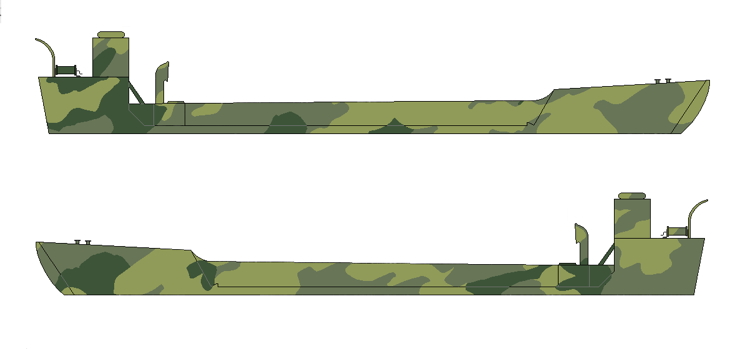
This is a color silhouette from the drawing for Measure 31 Design 20L for the LCT-1 class of tank landing craft dated July 25, 1944. The applied pattern was slightly different port and starboard and was not a mirror image. The specified vertical colors were green 1, green 2 and green 3 with deck green (20-G) paint on horizontal surfaces. Samples of green 1, green 2 and green 3 were included, but were close to haze green, ocean green and navy green respectively. Note, because of the color reproduction process these colors may not be an exact match to the originals.
The Master for Design 20L was sent to BuShips on July 8, 1944, and then was used to create camouflage drawings for many ship classes during July, August and September, such as LCT's, LST's, APD's, ARS's, and AN's.
Original drawing source (in B&W): NARA BS 72176 and BS 72177.
July 25, 1944 20L in Measure 31 for LCT-1
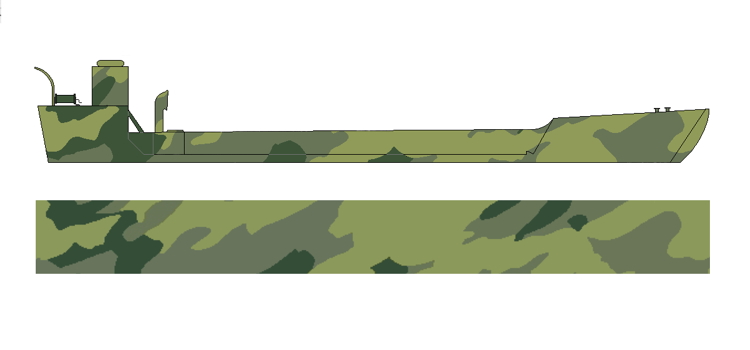
This is a color silhouette from the starboard drawing for Measure 31 Design 20L for the LCT-1 class of tank landing craft dated July 25, 1944. A section from the Design 20L Master has been added to illustrate how the pattern was decided. The specified vertical colors again were green 1, green 2 and green 3 with deck green (20-G) paint on horizontal surfaces. Samples of green 1, green 2 and green 3 colors were included, but were close to haze green, ocean green and navy green respectively. Note, because of the color reproduction process these colors may not be an exact match to the originals.
The Master for Design 20L was sent to BuShips on July 8, 1944, and then was used to create camouflage drawings for many ship classes during July, August and September, such as LCT's, LST's, APD's, ARS's, and AN's.
Original drawing source (in B&W): NARA BS 72177.
July 25, 1944 20L in Measure 31 for LCT-1
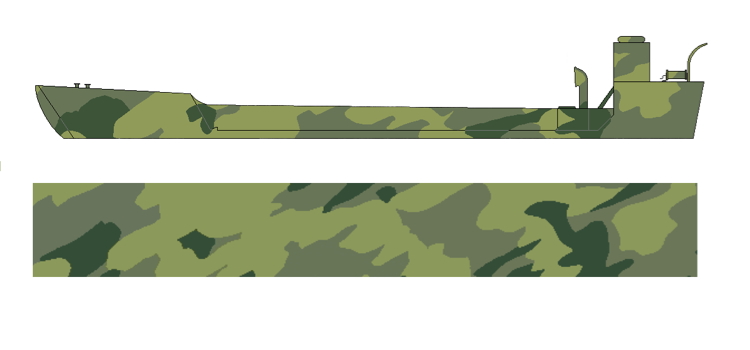
Thie color silhouette from the port side drawing for Measure 31 Design 20L for the LCT-1 class of tank landing craft dated July 25, 1944. The section of the Design 20L Master is included to illustrate how the pattern was applied. The specified vertical colors were green 1, green 2 and green 3 with deck green (20-G) paint on horizontal surfaces. Samples of green 1, green 2 and green 3 colors were included, but were close to haze green, ocean green and navy green respectively. Note, because of the color reproduction process these colors may not be an exact match to the originals.
The Master for Design 20L was sent to BuShips on July 8, 1944, and then was used to create camouflage drawings for many ship classes during July, August and September, such as LCT's, LST's, APD's, ARS's, and AN's.
Original drawing source (in B&W): NARA BS 72177.
July 31, 1944 20L in Measure 31 for LST-1
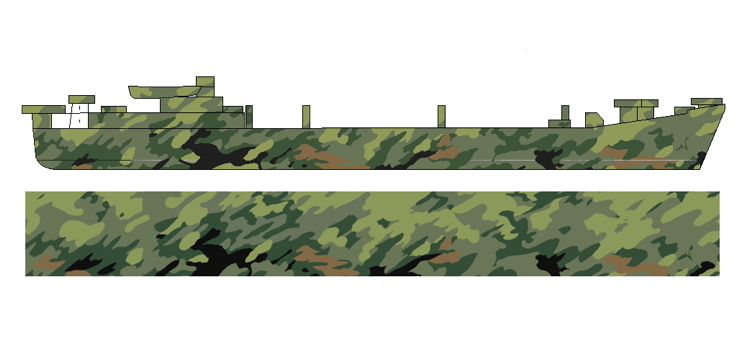
Thie color silhouette of the starboard drawing for Measure 31 Design 20L for the LST-1 class of tank landing ships dated July 31, 1944. The section of the Design 20L Master is included to show how the pattern was transferred. The port side pattern was a near mirror image of the starboard. The specified vertical colors were green 1, green 2 and green 3, brown and dull black (BK) with deck green (20-G) paint on horizontal surfaces. Samples of green 1, green 2, green 3 and brown colors were included, but were close to haze green, ocean green, navy green and brown (4-A) respectively. Note, because of the color reproduction process these colors may not be an exact match to the originals.
The Master for Design 20L was sent to BuShips on July 8, 1944, and then was used to create camouflage drawings for many ship classes during July, August and September, such as LCT's, LST's, APD's, ARS's, and AN's.
Original drawing source (in B&W): NARA BS 72177.
August 15, 1944 20L in Measure 31 for APD-37
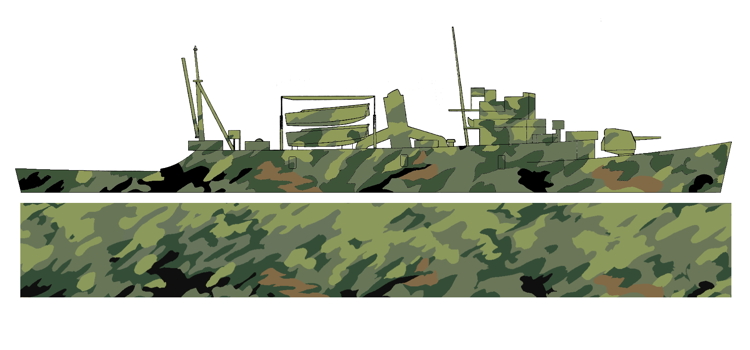
Thie color silhouette of the starboard drawing for Measure 31 Design 20L for the APD-37 class of high-speed transports dated August 15, 1944. The section of the Design 20L Master is included to show how the pattern was transferred. The port side pattern was a near mirror image of the starboard. The specified vertical colors were green 1, green 2 and green 3, brown and dull black (BK) with deck green (20-G) paint on horizontal surfaces. Samples of green 1, green 2, green 3 and brown colors were included with the Master, but were close to haze green, ocean green, navy green and brown (4-A) respectively. Note, because of the color reproduction process these colors may not be an exact match to the originals.
The Master for Design 20L was sent to BuShips on July 8, 1944, and then was used to create camouflage drawings for many ship classes during July, August and September, such as LCT's, LST's, APD's, ARS's, and AN's.
Original drawing source (in B&W): NARA 80-G-177462.
August 15, 1944 20L in Measure 31 for ARS-13
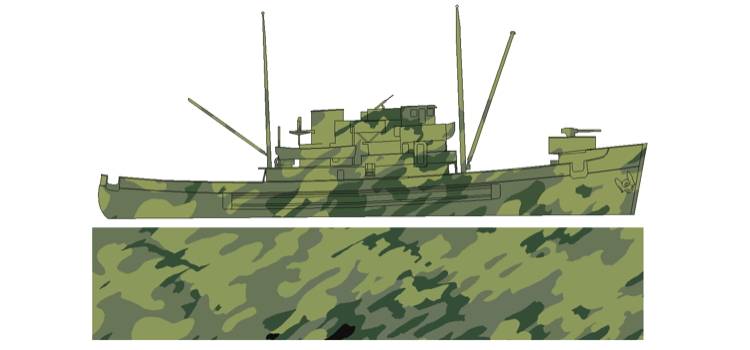
Thie color silhouette of the starboard drawing for Measure 31 Design 20L for the ARS-13 class of rescue tugs dated August 15, 1944. A section of the Design 20L Master is included to show how the pattern was transferred. the port side pattern was a near mirror image of the starboard. Note, the portions of the Master in black were left off. The specified vertical colors were green 1, green 2 and green 3 with deck green (20-G) paint on horizontal surfaces. Samples of green 1, green 2, and green 3 colors were included with the Master, but were close to haze green, ocean green, and navy green respectively. Note, because of the color reproduction process these colors may not be an exact match to the originals.
The Master for Design 20L was sent to BuShips on July 8, 1944, and then was used to create camouflage drawings for many ship classes during July, August and September, such as LCT's, LST's, APD's, ARS's, and AN's.
Original drawing source (in B&W): NARA BS 72175.
August 16, 1944 20L in Measure 31 for APc-1
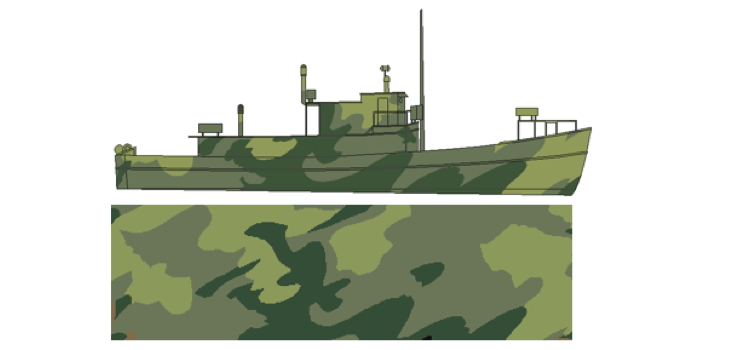
Thie color silhouette of the starboard drawing for Measure 31 Design 20L for the APc-1 class of coastal transports dated August 16, 1944. The relevant section of the Design 20L Master is included to show how the pattern was transferred. the port side pattern was a mirror image of the starboard with some adjustments. The specified vertical colors were green 1, green 2 and green 3 with deck green (20-G) paint on horizontal surfaces. Samples of green 1, green 2, and green 3 colors were included with the Master, but were close to haze green, ocean green, and navy green respectively. Note, because of the color reproduction process these colors may not be an exact match to the originals.
The Master for Design 20L was sent to BuShips on July 8, 1944, and then was used to create camouflage drawings for many ship classes during July, August and September, such as LCT's, LST's, APD's, ARS's, and AN's.
Original drawing source (in B&W): NARA 80-G-177469.
August 18, 1944 20L in Measure 31 for APD-1
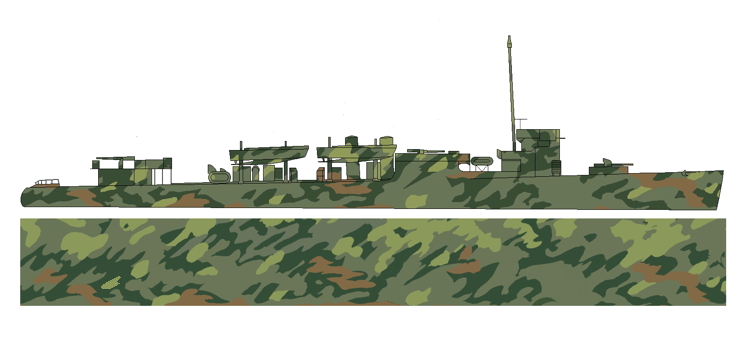
Thie color silhouette of the starboard drawing for Measure 31 Design 20L for the APD-1 class of high-speed transports dated August 18, 1944. A section of the Design 20L Master is included to show how the pattern was transferred. the port side pattern was a mirror image of the starboard. Note, the portions of the Master in black were left off. The specified vertical colors were green 1, green 2, green 3 and brown with deck green (20-G) paint on horizontal surfaces. Samples of green 1, green 2, green 3 and brown colors were included with the Master, but were close to haze green, ocean green, navy green and brown (4-A) respectively. Note, because of the color reproduction process these colors may not be an exact match to the originals.
The Master for Design 20L was sent to BuShips on July 8, 1944, and then was used to create camouflage drawings for many ship classes during July, August and September, such as LCT's, LST's, APD's, ARS's, and AN's.
Original drawing source (in B&W): NARA 80-G-177467.
August 21, 1944 20L in Measure 31 for AN-6
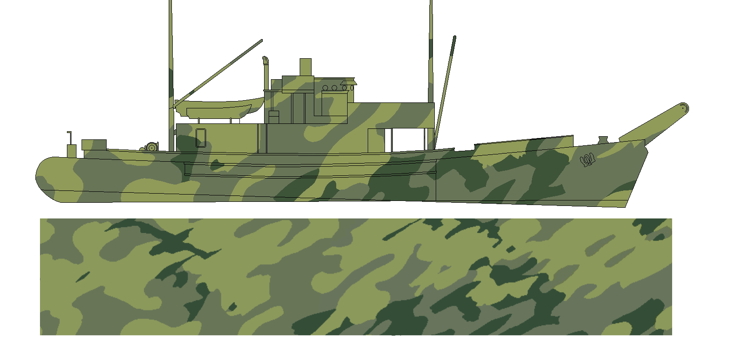
Thie color silhouette of the starboard drawing for Measure 31 Design 20L for the AN-6 class of net tenders dated August 21, 1944. A section of the Design 20L Master is included to show how the pattern was transferred. the port side pattern was a mirror image of the starboard. Note, the portions of the Master in black were left off. The specified vertical colors were green 1, green 2 and green 3 with deck green (20-G) paint on horizontal surfaces. Samples of green 1, green 2 and green 3 colors were included with the Master, but were close to haze green, ocean green and navy green respectively. Note, because of the color reproduction process these colors may not be an exact match to the originals.
The Master for Design 20L was sent to BuShips on July 8, 1944, and then was used to create camouflage drawings for many ship classes during July, August and September, such as LCT's, LST's, APD's, ARS's, and AN's.
Original drawing source (in B&W): NARA BS 72186.
August 29, 1944 20L in Measure 31 for AN-38
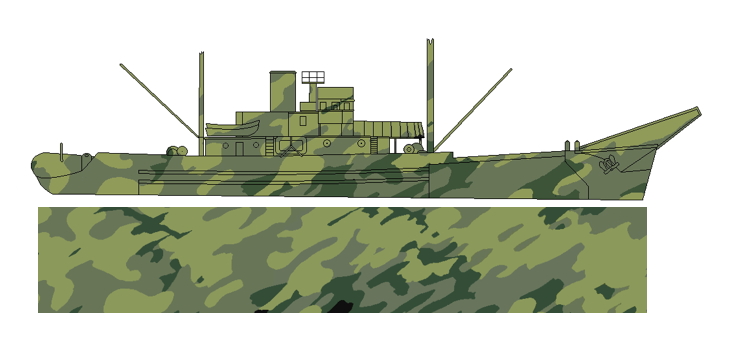
Thie color silhouette of the starboard drawing for Measure 31 Design 20L for the AN-38 class of net tenders dated August 29, 1944. A section of the Design 20L Master is included to show how the pattern was transferred. the port side pattern was a mirror image of the starboard. Note, the portions of the Master in black were left off. The specified vertical colors were green 1, green 2 and green 3 with deck green (20-G) paint on horizontal surfaces. Samples of green 1, green 2 and green 3 colors were included with the Master, but were close to haze green, ocean green and navy green respectively. Note, because of the color reproduction process these colors may not be an exact match to the originals.
The Master for Design 20L was sent to BuShips on July 8, 1944, and then was used to create camouflage drawings for many ship classes during July, August and September, such as LCT's, LST's, APD's, ARS's, and AN's.
Original drawing source (in B&W): NARA San Bruno PHSY Correspondence Box39.
August 1944 ? 20L in Measure 31 for AN-78
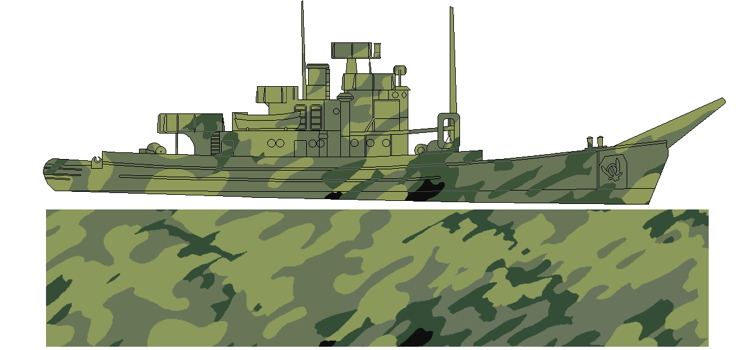
Thie color silhouette of the starboard drawing for Measure 31 Design 20L for the AN-78 class of net tenders dated probably sometime in August 1944. A section of the Design 20L Master is included to show how the pattern was transferred. the port side pattern was a mirror image of the starboard. Note, the portions of the Master in black were included. The specified vertical colors were green 1, green 2, green 3 and black with deck green (20-G) paint on horizontal surfaces. Samples of green 1, green 2 and green 3 colors were included with the Master, but were close to haze green, ocean green and navy green respectively. Note, because of the color reproduction process these colors may not be an exact match to the originals.
The Master for Design 20L was sent to BuShips on July 8, 1944, and then was used to create camouflage drawings for many ship classes during July, August and September, such as LCT's, LST's, APD's, ARS's, and AN's.
Original drawing source (in B&W): NARA BS 72187.
21D Designs
June 1942 Measure 16 Pattern for DD-380
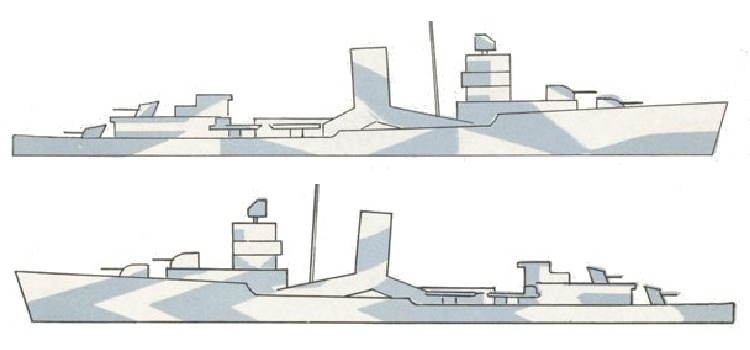
This is a silhouette of Plate IV from June 1942 version of SHIPS-2 labeled “DESTROYER DD 380 Class” the light color was white (5-U) and the pattern was Thayer Blue (5-B). This pattern was used again and became Design 21D.
Design 21D was drawn up for USS Nashville (CL-43) as early as July 14, 1943. In late 1943 and early 1944 it was also drawn for the Fletcher class destroyers in both Measure 31 and Measure 32 colors.
Original drawing source: Plate IV attached to June 1942 version of SHIPS-2.
July 14, 1943 21D in Measure 33 for CL-43
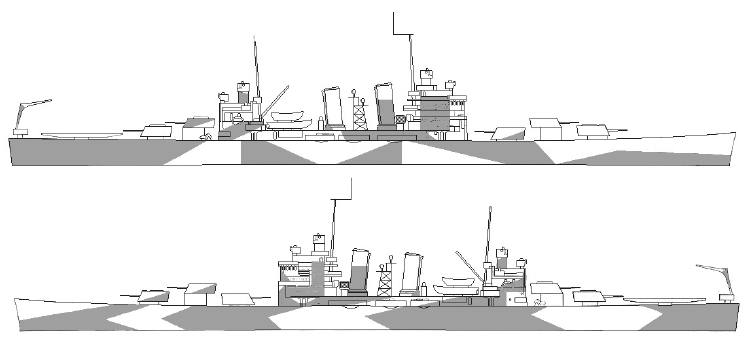
A silhouette of the drawing for Design 21D using Measure 33 for the light cruiser USS Nashville (CL-43) on July 14, 1943. The Measure 33 colors were light gray (5-L) and ocean gray (5-O). This is a good application of the previous Measure 16 pattern with some differences in the superstructure.
Design 21D was drawn up as above from a Measure 16 pattern for USS Nashville (CL-43) as early as July 14, 1943. In late 1943 and early 1944 it was also drawn for the Fletcher class destroyers in both Measure 31 and Measure 32 colors.
Original drawing source: NARA 80-G-157050 and 80-G-157051.
December 22, 1943 21D in Measure 32 for DE-5
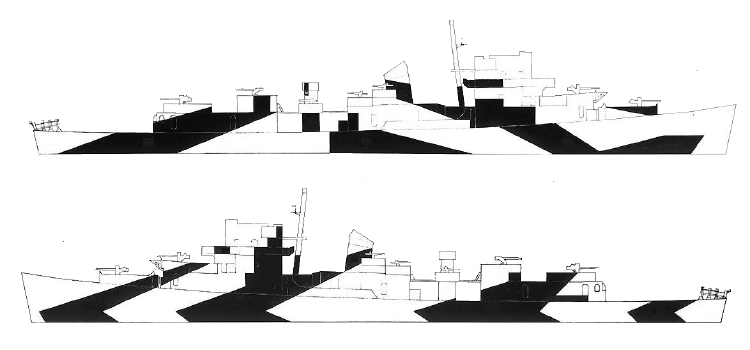
A silhouette of the design drawing for Measure 32/21D for the Evarts class destroyer escorts drawn on December 22, 1943.
Design 21D was drawn up for USS Nashville (CL-43) as early as July 14, 1943. In late 1943 and early 1944 it was also drawn for the Fletcher class destroyers in both Measure 31 and Measure 32 colors.
Original drawing source: NARA 80-G-172858 and 80-G-172873.
December 1943 21D in Measure 32 for DD-445
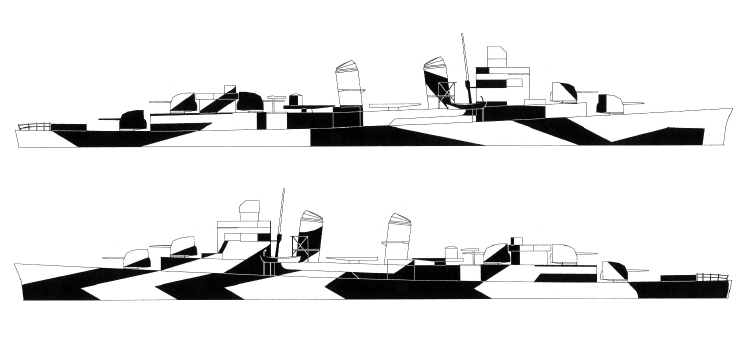
A silhouette of the design drawing for Measure 32/21D for the Fletcher class destroyers drawn probably in December of 1943. A duplicate of this pattern for the Fletcher class using Measure 31 was drawn on January 19, 1944.
Design 21D was drawn up for USS Nashville (CL-43) as early as July 14, 1943. In late 1943 and early 1944 it was also drawn for the Fletcher class destroyers in both Measure 31 and Measure 32 colors as above.
Original drawing source: NARA 80-G-160239 and 80-G-160240.
January 29, 1944 21D in Measure 32 for AM-136
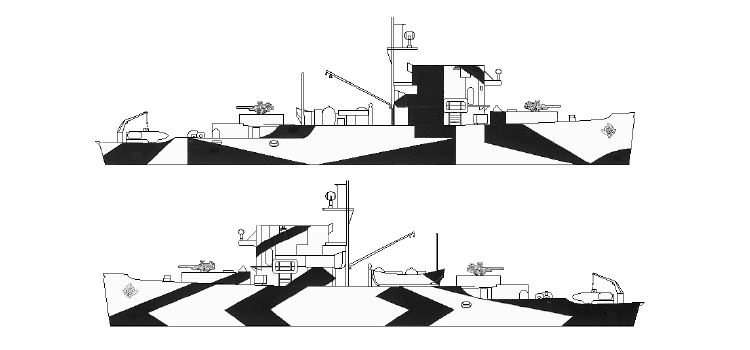
A silhouette of the drawing for Design 21D using Measure 32 for the Admiral class minesweepers drawn on January 29, 1944.
Design 21D was drawn up for USS Nashville (CL-43) as early as July 14, 1943. In late 1943 and early 1944 it was also drawn for the Fletcher class destroyers in both Measure 31 and Measure 32 colors.
Original drawing source: NARA 80-G-105498 and 80-G-105499.
March 1944 21D in Measure 32 for DE-51
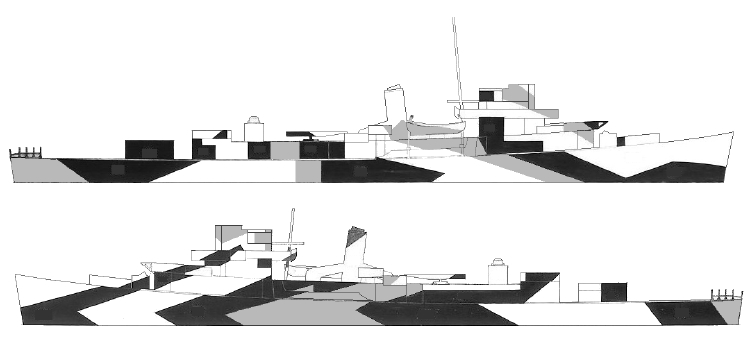
The silhouette for the design drawing for Measure 32/21D for the Buckley class destroyer escorts drawn probably in March 1944. This version of 21D used three colors; for Measure 32 they were dull black (BK), ocean gray (5-O) and light gray (5-L).
Design 21D was drawn up for USS Nashville (CL-43) as early as July 14, 1943. In late 1943 and early 1944 it was also drawn for the Fletcher class destroyers in both Measure 31 and Measure 32 colors.
Original drawing source: NARA 80-G-172861 and 80-G-172869.
March 18 , 1944 21D in Measure 31 for DD-187
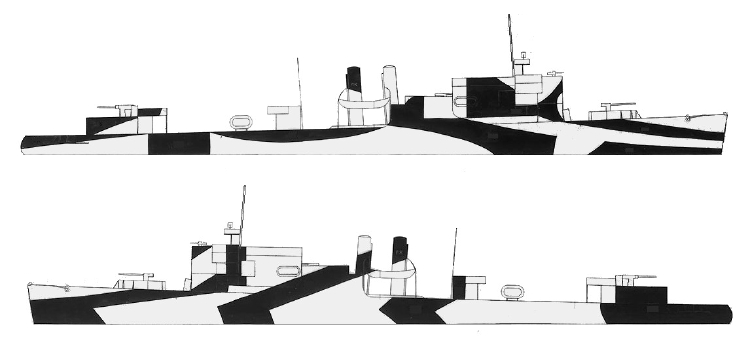
This is the silhouette of Design 21D in Measure 31 colors drawn for the destroyer USS Dahlgren and others dated March 18, 1944. The profile used is from a 4-stack destroyer modified with two less stacks and no torpedo tubes, which was done to become a small seaplane tender (AVD).
Design 21D was drawn up for USS Nashville (CL-43) as early as July 14, 1943. In late 1943 and early 1944 it was also drawn for the Fletcher class destroyers in both Measure 31 and Measure 32 colors.
Original drawing source: NARA 80-G-109645 and 80-G-109646.
April 25, 1944 21D in Measure 32 for AM-55
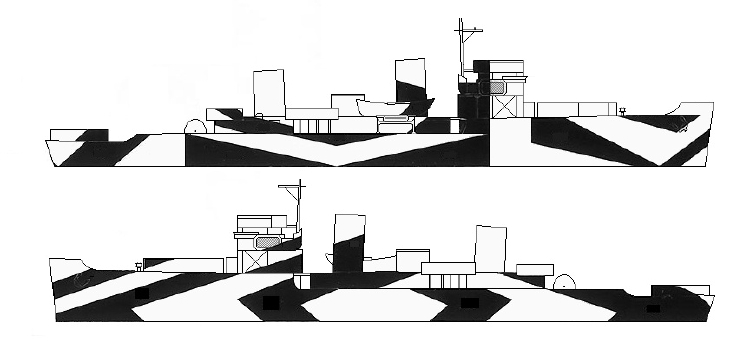
This is a silhouette from the Design 21D drawing for the Raven class minesweepers produced on April 25, 1944.
Design 21D was drawn up for USS Nashville (CL-43) as early as July 14, 1943. In late 1943 and early 1944 it was also drawn for the Fletcher class destroyers in both Measure 31 and Measure 32 colors.
Original drawing source: NARA 80-G-173271 and 80-G-173272.
22D Designs
June 1942 Measure 16 pattern for DD-384
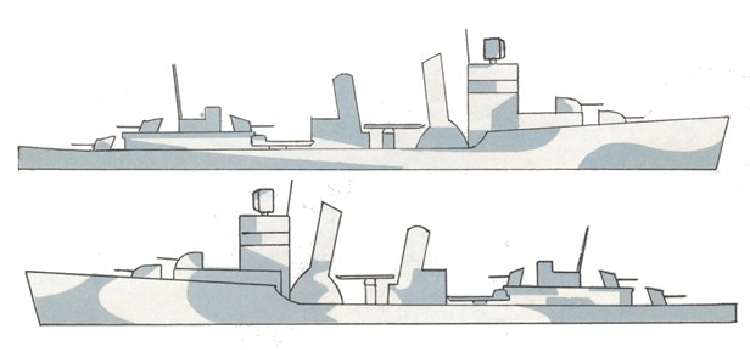
This is a silhouette of Plate VI from the June 1942 version of SHIPS-2 that was labeled “Destroyer DD-384 Class ” the light color was white (5-U) and the pattern was Thayer Blue (5-B). Note, the color for Thayer Blue on this plate may not be an exact match to the actual color. This pattern has distinctive bow panels: a “wave” on the starboard and curves on the port. This pattern became the basis for Design 22D.
Design 22D first appeared as the above pattern for Measure 16 in June 1942. This design was first drawn up on December 3, 1943, for the Evarts class destroyer escorts as well as the Fletcher class destroyers. Design 22D was dated January 27, 1944, for the Buckley class destroyer escorts and used three colors. It was later drawn for the Porter and Benson classes of destroyers. The battleship USS Missouri (BB-63) used Design 22D in Measure 32 colors of dull black, ocean gray and light gray. Design 22D was used for the Atlanta class light cruisers USS San Juan (CL-54) and USS Flint (CL-97). They were painted using Measure 32 in three colors, even though the drawing specified Measure 33 colors.
Original drawing source: Plate V attached to June 1942 version of SHIPS-2.
December 3, 1943 22D in Open Measure for DD-445
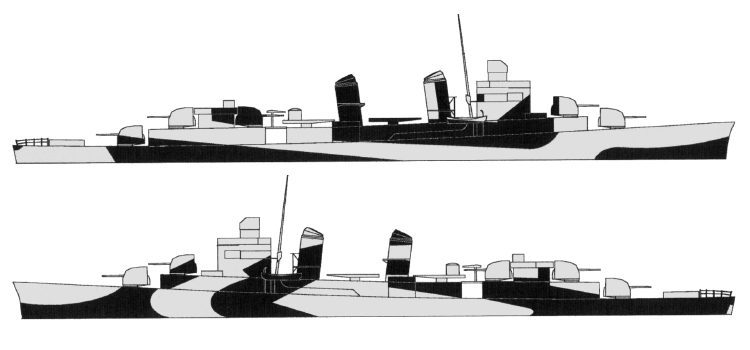
This is a silhouette of the drawing for the Fletcher class destroyers showing design 3_/22D dated December 3, 1943. The vertical colors were dull black (BK) and light gray (5-L) for Measure 32 or ocean gray (5-O) for Measure 31. This drawing was redone probably sometime in January 1944 for the Fletcher class using Measure 31 colors but was otherwise identical.
Design 22D first appeared as a pattern for Measure 16 in June 1942. This design was first drawn up on December 3, 1943, for the Evarts class destroyer escorts as well as the Fletcher class destroyers. Design 22D was dated January 27, 1944, for the Buckley class destroyer escorts and used three colors. It was later drawn for the Porter and Benson classes of destroyers. The battleship USS Missouri (BB-63) used Design 22D in Measure 32 colors of dull black, ocean gray and light gray. Design 22D was used for the Atlanta class light cruisers USS San Juan (CL-54) and USS Flint (CL-97). They were painted using Measure 32 in three colors, even though the drawing specified Measure 33 colors.
Original drawing source: NARA 80-G-162026 and 80-G-162027 for open colors and 80-G-164292 and 80-G-164293 for Measure 31.
December 3, 1943 22D in Open Measure for DE-5
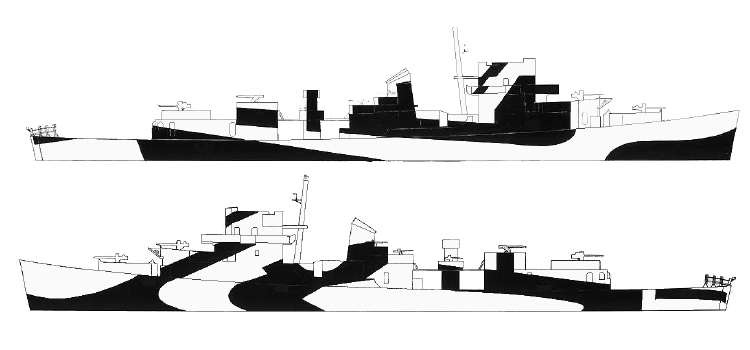
This silhouette is from the drawing for the Evarts class destroyer escorts showing Design 3_/22D dated December 3, 1943. The two vertical colors were dull black (BK) and light gray (5-L) for Measure 32 or either ocean gray (5-O) or haze gray (5-H) instead of light gray to become Measure 31.
Design 22D first appeared as a pattern for Measure 16 in June 1942. This design was first drawn up on December 3, 1943, for the Fletcher class destroyers as well as the Evarts class destroyer escorts. Design 22D was dated January 27, 1944, for the Buckley class destroyer escorts and used three colors. It was later drawn for the Porter and Benson classes of destroyers. The battleship USS Missouri (BB-63) used Design 22D in Measure 32 colors of dull black, ocean gray and light gray. Design 22D was used for the Atlanta class light cruisers USS San Juan (CL-54) and USS Flint (CL-97). They were painted using Measure 32 in three colors, even though the drawing specified Measure 33 colors.
Original drawing source: NARA 80-G-105508 and 80-G-105509.
January 27, 1944 22D in Measure 31 for DE-51
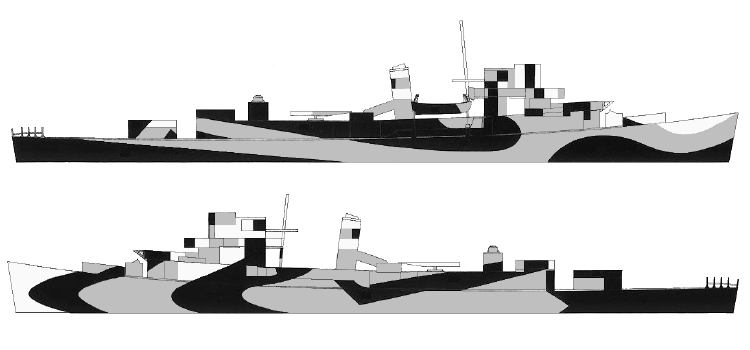
Drawing silhouete of Measure 31 Design 22D for the Buckley class destroyer escorts dated January 27, 1944. This three-color design used dull black (BK), ocean gray (5-O) and light gray (5-L) for the vertical surfaces. The small area used for the lightest color would darken the overall effect to be Measure 31 whether the lightest color was 5-L or haze gray (5-H) and some ships may have used 5-H. There may have been a modification to this drawing to achieve Measure 32 by enlarging the areas used for 5-L enough to lighten the overall reflectance.
Design 22D first appeared as a pattern for Measure 16 in June 1942. This design was first drawn up on December 3, 1943, for the Evarts class destroyer escorts as well as the Fletcher class destroyers. It was later drawn for the Porter and Benson classes of destroyers. The battleship USS Missouri (BB-63) used Design 22D in Measure 32 colors of dull black, ocean gray and light gray. Design 22D was used for the Atlanta class light cruisers USS San Juan (CL-54) and USS Flint (CL-97). They were painted using Measure 32 in three colors, even though the drawing specified Measure 33 colors.
Original drawing source: NARA 80-G-105502 and 80-G-105503.
March 28, 1944 22D in Measure 32 for DD-357
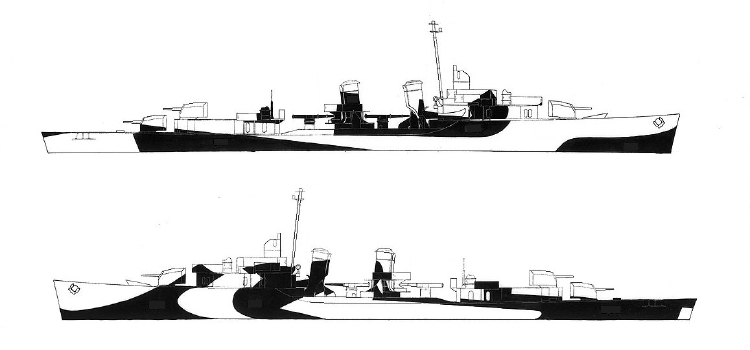
A silhouette of drawing 32/22D, in two colors, for the Porter class destroyers dated March 28, 1944. The vertical colors were dull black (BK) and light gray (5-L).
Design 22D first appeared as a pattern for Measure 16 in June 1942. This design was first drawn up on December 3, 1943, for the Evarts class destroyer escorts as well as the Fletcher class destroyers. Design 22D was dated January 27, 1944, for the Buckley class destroyer escorts and used three colors. It was later drawn for the Porter and Benson classes of destroyers. The battleship USS Missouri (BB-63) used Design 22D in Measure 32 colors of dull black, ocean gray and light gray. Design 22D was used for the Atlanta class light cruisers USS San Juan (CL-54) and USS Flint (CL-97). They were painted using Measure 32 in three colors, even though the drawing specified Measure 33 colors.
Original drawing source: NARA 80-G-170942 and 80-G-170943.
April 1944 ? 22D in Measure 32 for DD-421
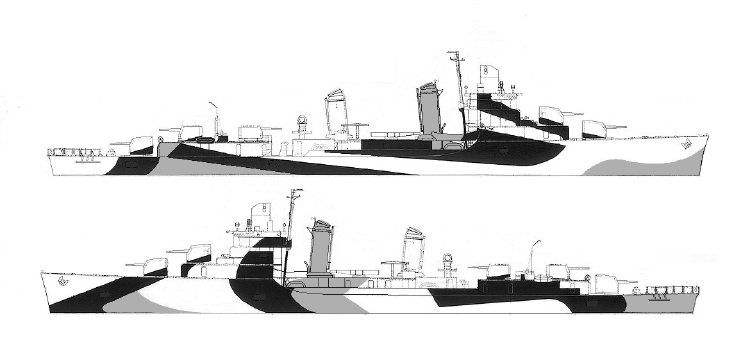
The silhouette for the drawing 32/22D for the Benson class destroyers drawn in early 1944, probably April. Note, this version of 22D uses three colors: dull black (BK), ocean gray (5-O) and light gray (5-L). Some panels are now medium 5-O instead of black as in the earlier two color drawings of 22D.
Design 22D first appeared as a pattern for Measure 16 in June 1942. This design was first drawn up on December 3, 1943, for the Evarts class destroyer escorts as well as the Fletcher class destroyers. Design 22D was dated January 27, 1944, for the Buckley class destroyer escorts and used three colors. It was later drawn for the Porter and Benson classes of destroyers. The battleship USS Missouri (BB-63) used Design 22D in Measure 32 colors of dull black, ocean gray and light gray. Design 22D was used for the Atlanta class light cruisers USS San Juan (CL-54) and USS Flint (CL-97). They were painted using Measure 32 in three colors, even though the drawing specified Measure 33 colors.
Original drawing source: NARA 80-G-170948 and 80-G-170949.
April 5, 1944 22D in Measure 32 for DE-339
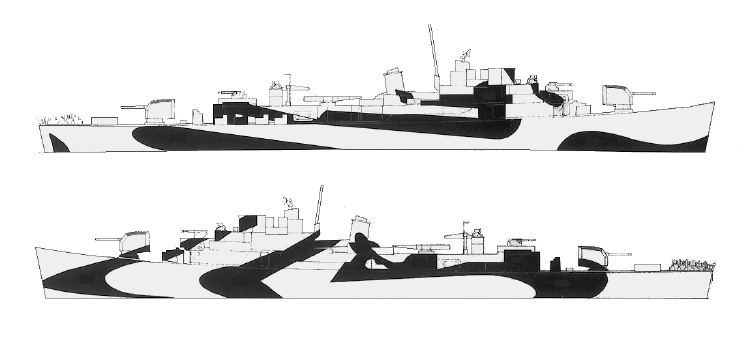
This is the silhouette of the drawing for Measure 32 Design 22D for the John C. Butler class destroyer escorts; the original was dated April 5, 1944. The vertical colors were: dull black (BK) and light gray (5-L), standard for Measure 32. Ships using ocean gray (5-O) or haze gray (5-H) for the lighter color would be in Measure 31.
Design 22D first appeared as a pattern for Measure 16 in June 1942. This design was first drawn up on December 3, 1943, for the Evarts class destroyer escorts as well as the Fletcher class destroyers. Design 22D was dated January 27, 1944, for the Buckley class destroyer escorts and used three colors. It was later drawn for the Porter and Benson classes of destroyers. The battleship USS Missouri (BB-63) used Design 22D in Measure 32 colors of dull black, ocean gray and light gray. Design 22D was used for the Atlanta class light cruisers USS San Juan (CL-54) and USS Flint (CL-97). They were painted using Measure 32 in three colors, even though the drawing specified Measure 33 colors.
Original drawing source: NARA 80-G-172517 and 80-G-172538.
April 18, 1944 22D in Measure 33 for CL-51
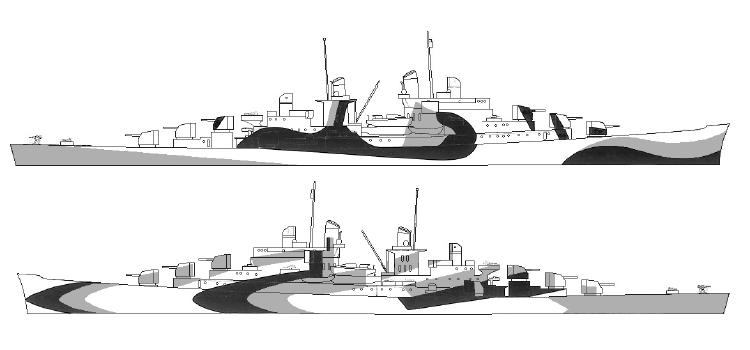
This is a silhouette from the drawing of Measure 33 Design 22D for the Atlanta class light cruisers dated April 18, 1944. The Measure 33 colors specified were: navy blue (5-N), haze gray (5-H) and pale gray (5-P). Measure 32 colors would be dull black (BK), ocean gray (5-O) and light gray (5-L).
Design 22D first appeared as the above pattern for Measure 16 in June 1942. This design was first drawn up on December 3, 1943, for the Evarts class destroyer escorts as well as the Fletcher class destroyers. Design 22D was dated January 27, 1944, for the Buckley class destroyer escorts and used three colors. It was later drawn for the Porter and Benson classes of destroyers. The battleship USS Missouri (BB-63) used Design 22D in Measure 32 colors of dull black, ocean gray and light gray. Design 22D was used for the Atlanta class light cruisers USS San Juan (CL-54) and USS Flint (CL-97). They were painted using Measure 32 in three colors, even though the drawing specified Measure 33 colors.
Original drawing source: NARA 80-G-173266 and 80-G-173267.
May 3, 1944 22D in Measure 32 for AM-136
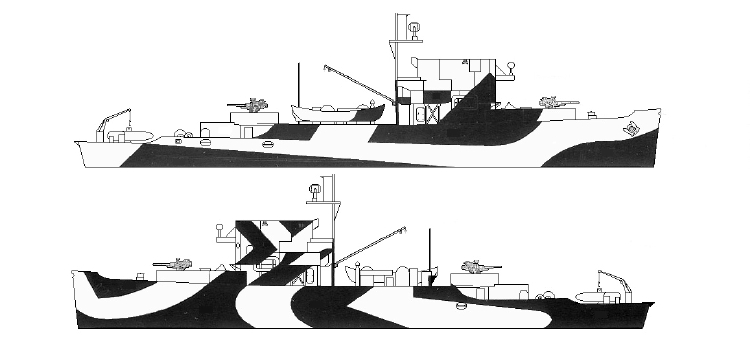
Here is the silhouette of the design drawing for Measure 32/22D in two colors drawn for the Admirable class minesweepers dated May 3, 1944.
Design 22D first appeared as a pattern for Measure 16 in June 1942. This design was first drawn up on December 3, 1943, for the Evarts class destroyer escorts as well as the Fletcher class destroyers. Design 22D was dated January 27, 1944, for the Buckley class destroyer escorts and used three colors. It was later drawn for the Porter and Benson classes of destroyers. The battleship USS Missouri (BB-63) used Design 22D in Measure 32 colors of dull black, ocean gray and light gray. Design 22D was used for the Atlanta class light cruisers USS San Juan (CL-54) and USS Flint (CL-97). They were painted using Measure 32 in three colors, even though the drawing specified Measure 33 colors.
Original drawing source: NARA 80-G-173254 and 80-G-173255.
May 18, 1944 22D in Measure 32 for BB-61
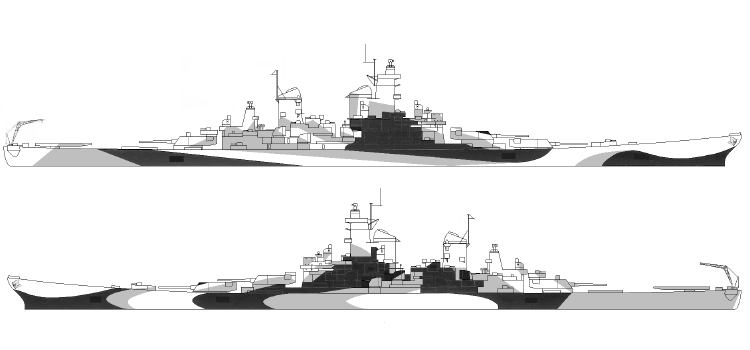
Here is the silhouette of the design drawing for Measure 32/22D in three colors drawn for the Iowa class battleships dated May 18, 1944. The colors were dull black (BK), ocean gray (5-O) and light gray (5-L).
Design 22D first appeared as a pattern for Measure 16 in June 1942. This design was first drawn up on December 3, 1943, for the Evarts class destroyer escorts as well as the Fletcher class destroyers. Design 22D was dated January 27, 1944, for the Buckley class destroyer escorts and used three colors. It was later drawn for the Porter and Benson classes of destroyers. The battleship USS Missouri (BB-63) used Design 22D in Measure 32 colors of dull black, ocean gray and light gray. Design 22D was used for the Atlanta class light cruisers USS San Juan (CL-54) and USS Flint (CL-97). They were painted using Measure 32 in three colors, even though the drawing specified Measure 33 colors.
Original drawing source: NARA 80-G-109729 and 80-G-109730.
May 27, 1944 22D in Measure 33 for CR-96
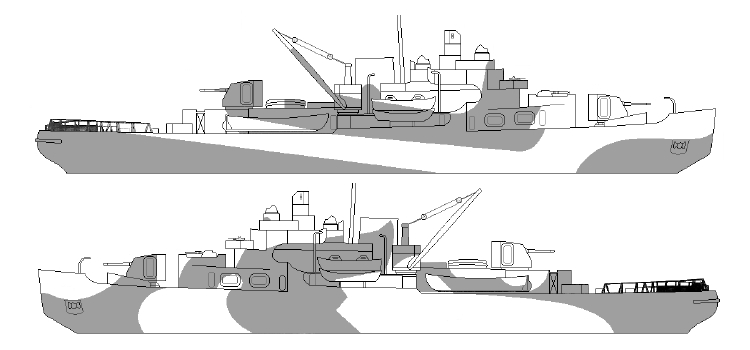
Here is the silhouette of the design drawing for Measure 33 Design 22D in two colors drawn for the Wind class of U.S. Coast Guard icebreakers dated May 27, 1944. This version of Design 22D used the Measure 16 colors of Thayer blue (5-B) and white (5-U), but was labeled Measure 33. The Measure 16 colors were probably selected since Measure 16 was deemed to be effective in northern waters.
Design 22D first appeared as a pattern for Measure 16 in June 1942. This design was first drawn up on December 3, 1943, for the Evarts class destroyer escorts as well as the Fletcher class destroyers. Design 22D was dated January 27, 1944, for the Buckley class destroyer escorts and used three colors. It was later drawn for the Porter and Benson classes of destroyers. The battleship USS Missouri (BB-63) used Design 22D in Measure 32 colors of dull black, ocean gray and light gray. Design 22D was used for the Atlanta class light cruisers USS San Juan (CL-54) and USS Flint (CL-97). They were painted using Measure 32 in three colors, even though the drawing specified Measure 33 colors.
Original drawing source: NARA 80-G-173268 and 80-G-173269.
June 22, 1944 22D in Measure 31 for AGS-5

This is the silhouette of the drawing for Design 22D in two colors drawn for the survey ship USS Sumner (AGS-5) dated June 22, 1944. The Measure 31 colors were dull black (BK) and ocean gray (5-O).
Design 22D first appeared as a pattern for Measure 16 in June 1942. This design was first drawn up on December 3, 1943, for the Evarts class destroyer escorts as well as the Fletcher class destroyers. Design 22D was dated January 27, 1944, for the Buckley class destroyer escorts and used three colors. It was later drawn for the Porter and Benson classes of destroyers. The battleship USS Missouri (BB-63) used Design 22D in Measure 32 colors of dull black, ocean gray and light gray. Design 22D was used for the Atlanta class light cruisers USS San Juan (CL-54) and USS Flint (CL-97). They were painted using Measure 32 in three colors, even though the drawing specified Measure 33 colors.
Original drawing source: NARA 80-G-174752 and 80-G-174753.
July 1944 ? 22D in Measure 32a for DMS-19
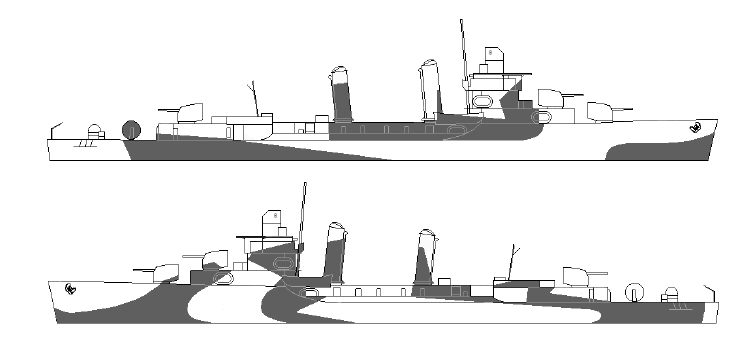
This is the silhouette of the probable drawing for Design 22D in two colors drawn for the Ellyson class of fast minesweepers probably in July 1944. The Ellyson class minesweepers were modified from Benson class destroyers, but did not use the 22D Design for the Benson with three colors; they used a two color design like that shown here. The two colors used were Mesure 32a: navy blue (5-N) and light gray (5-L). The original drawing for this version has not yet been found but probably did exist.
Design 22D first appeared as a pattern for Measure 16 in June 1942. This design was first drawn up on December 3, 1943, for the Evarts class destroyer escorts as well as the Fletcher class destroyers. Design 22D was dated January 27, 1944, for the Buckley class destroyer escorts and used three colors. It was later drawn for the Porter and Benson classes of destroyers. The battleship USS Missouri (BB-63) used Design 22D in Measure 32 colors of dull black, ocean gray and light gray. Design 22D was used for the Atlanta class light cruisers USS San Juan (CL-54) and USS Flint (CL-97). They were painted using Measure 32 in three colors, even though the drawing specified Measure 33 colors.
Original drawing source: NARA ?
23D Designs
June 1942 Measure 16 pattern for Four Stack Destroyers
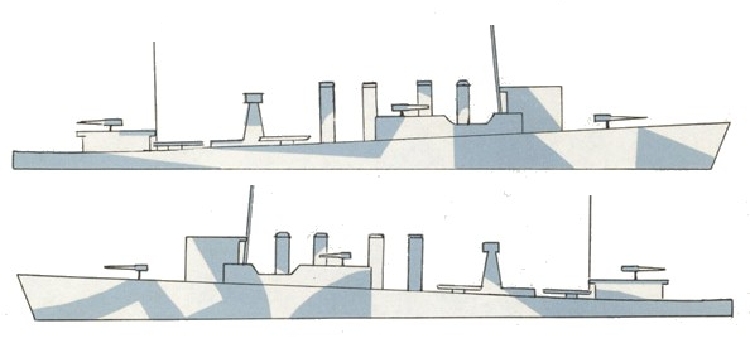
This is a silhouette of Plate VI from the June 1942 version of SHIPS-2 that was labeled “Four Stack Destroyer (Adaptable to Three Stack Destroyer)” the light color was white (5-U) and the pattern was Thayer Blue (5-B). Note, the color for Thayer Blue on this plate may not be an exact match to the actual color. This pattern has distinctive panels on each bow. This pattern became the basis for Design 23D.
Design 23D was derived from a Measure 16 pattern dated June 1942, as shown above. The Design 23D drawing for the Buckley class destroyer escorts was dated March 8, 1944. Design 23D was drawn for Mahan class destroyers on April 13, 1944, and again for Admirable class minesweepers on May 5, 1944. Also on May 18, 1944, the Design 23D drawing was reissued for the destroyer Cassin, rebuilt after being damaged at Pearl Harbor, but both starboard and port bow patterns had been extensively modified even though the design number remained the same.
Original drawing source: Plate VI attached to June 1942 version of SHIPS-2.
January 8, 1944 23D in Measure 31 for DD-445
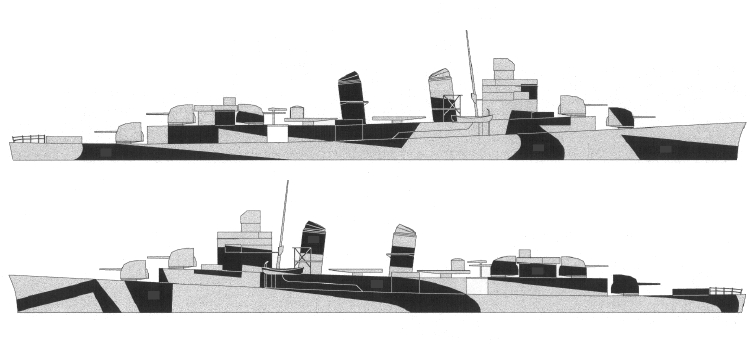
The design drawing for Measure 31/23D for the Fletcher class destroyers. The Measure 31 colors were dull black (BK) and ocean gray (5-O) or haze gray (5-H). Measure 32 would use dull black and light gray (5-L) for the lighter color. This pattern matches the Measure 16 pattern very well on the starboard, but has a few changes on the port side.
Design 23D was derived from a Measure 16 pattern dated June 1942. The Design 23D drawing for the Buckley class destroyer escorts was dated March 8, 1944. Design 23D was drawn for Mahan class destroyers on April 13, 1944, and again for Admirable class minesweepers on May 5, 1944. Also on May 18, 1944, the Design 23D drawing was reissued for the destroyer Cassin, rebuilt after being damaged at Pearl Harbor, but both starboard and port bow patterns had been extensively modified even though the design number remained the same.
Original drawing source: NARA 80-G-164294 and 80-G-164295.
March 8, 1944 23D in Measure 32 for DE-51
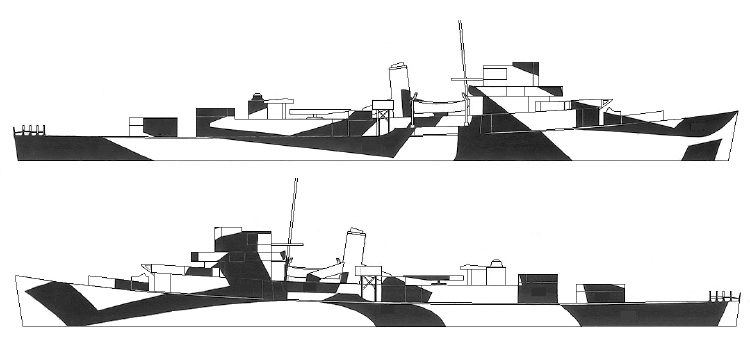
This is a silhouette from the drawing sheets for the Buckley class destroyer escorts showing design 32/23D dated March 8, 1944. The vertical colors were dull black (BK) and light gray (5-L). The bow panels have been slightly modified.
Design 23D was derived from a Measure 16 pattern dated June 1942. The Design 23D drawing for the Buckley class destroyer escorts was dated March 8, 1944. Design 23D was drawn for Mahan class destroyers on April 13, 1944, and again for Admirable class minesweepers on May 5, 1944. Also on May 18, 1944, the Design 23D drawing was reissued for the destroyer Cassin, rebuilt after being damaged at Pearl Harbor, but both starboard and port bow patterns had been extensively modified even though the design number remained the same.
Original drawing source: NARA 80-G-172866 and 80-G-172870.
March 18, 1944 23D in Measure 32 for DD-598
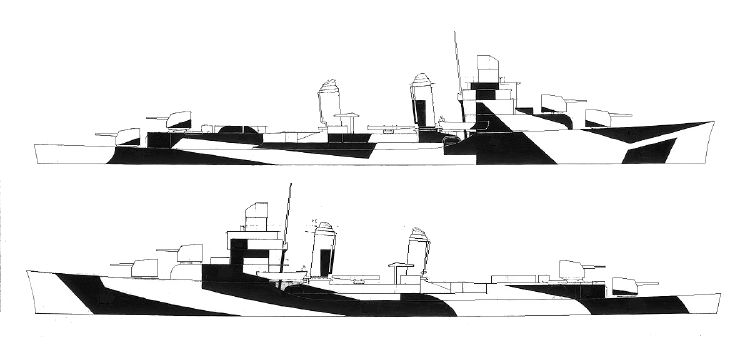
Drawing silhouete of Measure 32 Design 23D for the Benson class destroyers dated March 18, 1944, using the profile of Bancroft (DD-598). This two-color design used dull black (BK) and light gray (5-L) for the vertical surfaces.
Design 23D was derived from a Measure 16 pattern dated June 1942. The design drawing for Buckley class destroyer escorts was dated March 8, 1944. Design 23D was drawn for Mahan class destroyers on April 13, 1944, and again for Admirable class minesweepers on May 5, 1944. Also on May 18, 1944, the Design 23D drawing was reissued for the destroyer Cassin, rebuilt after being damage at Pearl Harbor, but both starboard and port bow patterns had been extensively modified even though the design number remained the same; there is no evidence whether Cassin used this modified design.
Original drawing source: NARA 80-G-170952 and 80-G-170953.
April 13, 1944 23D in Measure 31 for DD-364
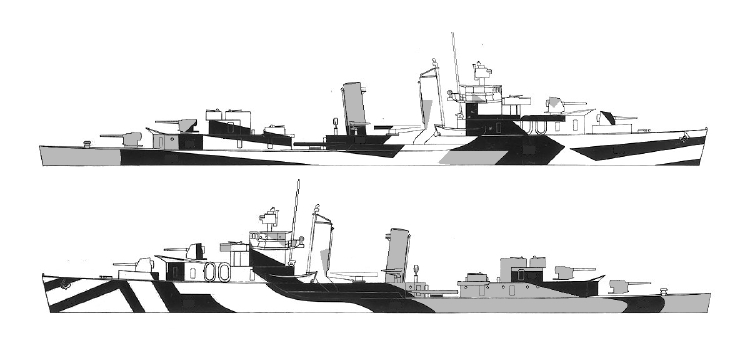
A silhouette of drawing 31/23D, in three colors, for the Mahan class destroyers dated April 13, 1944. The vertical colors were dull black (BK), ocean gray (5-O) and haze gray (5-H); substituting light gray for haze gray would make this Measure 32.
Design 23D was derived from a Measure 16 pattern dated June 1942. The design drawing for Buckley class destroyer escorts was dated March 8, 1944. Design 23D was drawn for Mahan class destroyers as above on April 13, 1944, and again for Admirable class minesweepers on May 5, 1944. Also on May 18, 1944, the Design 23D drawing was reissued for the destroyer Cassin, rebuilt after Pearl Harbor, but both starboard and port bow patterns had been extensively modified even though the design number remained the same.
Original drawing source: NARA 80-G-172527 and 80-G-172529.
May 5, 1944 23D in Measure 33 for AM-136
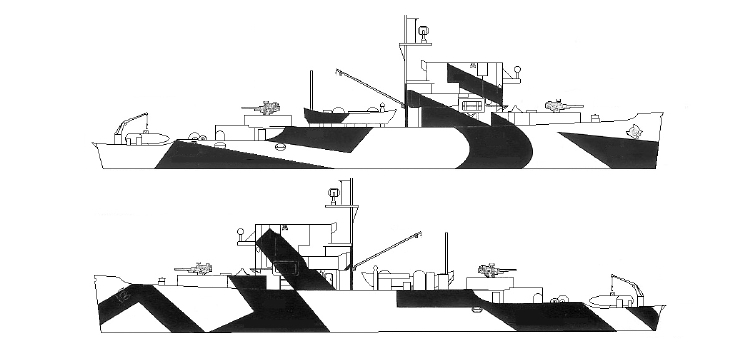
The silhouette for the drawing 33/23D for the Admirable class minesweepers dated May 5, 1944. The vertical colors were white (6-U) and Thayer Blue (5-B) which were Measure 16 colors. Measure 33 colors were usually ocean gray (5-O) and light gray (5-L) or navy blue (5-N) and pale gray (5-P). Note, Thayer Blue was medium to light toned color, but is depicted here in black, so the contrast is not representative. Also note, the port view was mislabeled “starboard” and the starboard drawing was not labeled; this may have caused some ships to apply this design reversed port and starboard. This version of Design 23D retains the curves and shapes of some previous versions.
Design 23D was derived from a Measure 16 pattern dated June 1942. The design drawing for Buckley class destroyer escorts was dated March 8, 1944. Design 23D was drawn for Mahan class destroyers on April 13, 1944, and again for Admirable class minesweepers as above on May 5, 1944. Also on May 18, 1944, the Design 23D drawing was reissued for the destroyer Cassin, rebuilt after Pearl Harbor, but both starboard and port bow patterns had been extensively modified even though the design number remained the same.
Original drawing source: NARA 80-G-173256 and 80-G-173257.
May 18, 1944 23D in Measure 31 for DD-372
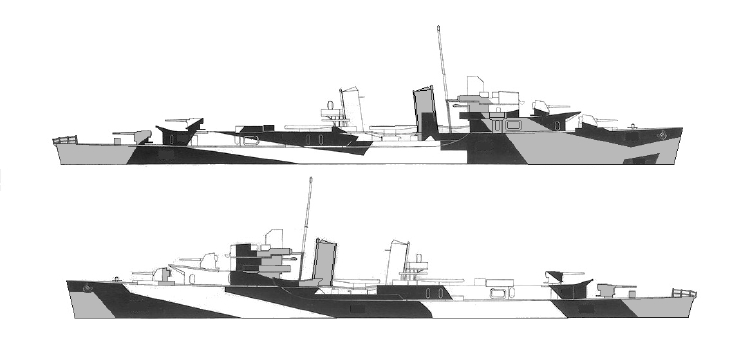
This is the silhouette of the drawing for Measure 31 Design 23D for the USS Cassin (DD-372); the original was dated May 18, 1944. The vertical colors were: dull black (BK), ocean gray (5-O) and haze gray (5-H), standard for Measure 31. The bow patterns on both port and starboard are very different from earlier Design 23D drawings. These changes were apparently not enough to justify a new design number. This version of Design 23D was apparently never used.
Design 23D was derived from a Measure 16 pattern dated June 1942. The design drawing for Buckley class destroyer escorts was dated March 8, 1944. Design 23D was drawn for Mahan class destroyers on April 13, 1944, and again for Admirable class minesweepers on May 5, 1944.
Original drawing source: NARA 80-G-109635 and 80-G-109636.
June 26, 1944 23D in Measure 32 for DD-421
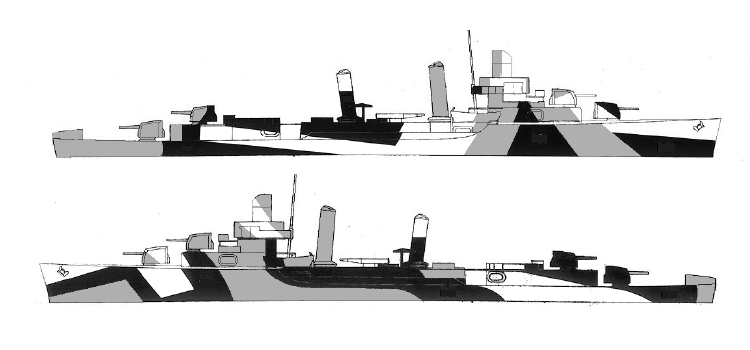
This is a silhouette from the drawing of Measure 32 Design 23D for the Benson class destroyers dated June 26, 1944. The Measure 32 colors were: dull black (BK), ocean gray (5-O) and light gray (5-L). Vessels wanting Measure 31 could subsitute haze gray (5-H) for light gray (5-L) on the vertical surfaces.
Design 23D was derived from a Measure 16 pattern dated June 1942. The design drawing for Buckley class destroyer escorts was dated March 8, 1944. Design 23D was drawn for Mahan class destroyers on April 13, 1944, and again for Admirable class minesweepers on May 5, 1944. Also on May 18, 1944, the Design 23D drawing was reissued for the destroyer Cassin, rebuilt after damage at Pearl Harbor, but both starboard and port bow patterns had been extensively modified even though the design number remained the same; there is no evidence whether Cassin used this modified design.
Original drawing source: NARA 80-G-174775 and 80-G-174776.
24D Designs
June 1942 Measure 16 pattern for DD-445
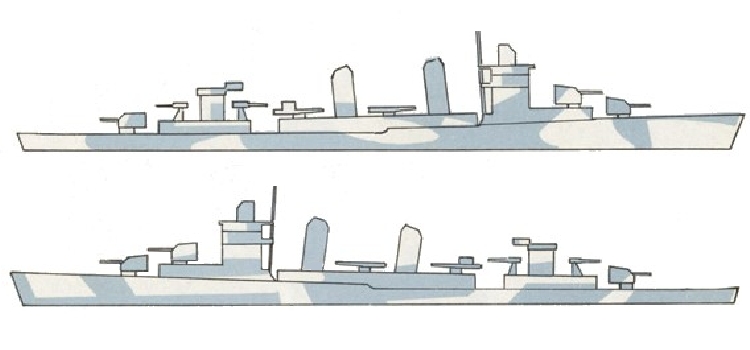
This is a silhouette of Plate X from the June 1942 version of SHIPS-2 that was labeled “DESTROYER DD 445 Class,” the light color was white (5-U) and the pattern was Thayer Blue (5-B). Note, the color for Thayer Blue on this plate may not be an exact match to the actual color. This pattern became the basis for Design 24D.
Design 24D was derived from the above Measure 16 pattern dated June 1942. In December 1943, Design 24D was used for the light cruiser USS Reno (CL-96) in Measure 33 colors: ocean gray and light gray. About the same time 24D was used with Measure 32 colors for the Fletcher class destroyers. In February 1944, it was redrawn for the Cleveland class light cruisers. Design 24D was worn by the light cruisers USS Springfield (CL-66), USS Topeka (CL-67) and USS Astoria (CL-90) in Measure 33 colors and USS Pasadena (CL-65) in Measure 32 colors. Light cruiser USS San Diego (CL-53) also wore Design 24D using the Measure 32 colors dull black and light gray, beginning in April 1944, until the end of the war.
Original drawing source: Plate X attached to June 1942 version of SHIPS-2.
December 21, 1943 24D in Measure 33 for CL-51
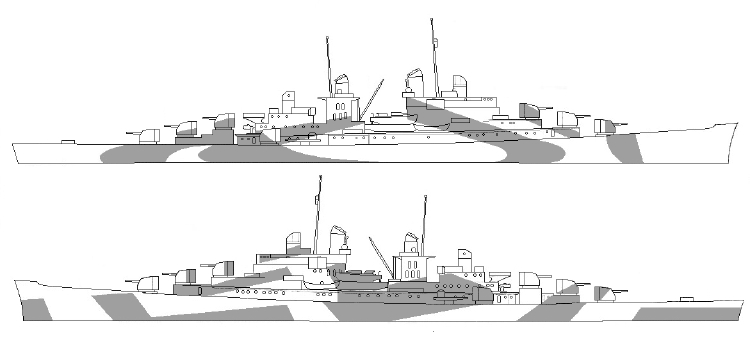
A silhouette of the design drawing for Measure 33/24D for the Atlanta class light cruisers drawn on December 21, 1943. The Measure 33 colors were light gray (5-L) and ocean gray (5-O). This pattern matches pretty well the Measure 16 pattern. The Measure 32 colors would be dull black (BK) and light gray.
Design 24D was derived from a Measure 16 pattern dated June 1942. In December 1943, Design 24D was used for the light cruiser USS Reno (CL-96) in Measure 33 colors: ocean gray and light gray. About the same time 24D was used with Measure 32 colors for the Fletcher class destroyers. In February 1944, it was redrawn for the Cleveland class light cruisers. Design 24D was worn by the light cruisers USS Springfield (CL-66), USS Topeka (CL-67) and USS Astoria (CL-90) in Measure 33 colors and USS Pasadena (CL-65) in Measure 32 colors. Light cruiser USS San Diego (CL-53) also wore Design 24D using the Measure 32 colors dull black and light gray, beginning in April 1944, until the end of the war.
Original drawing source: NARA 80-G-162034 and 80-G-162035.
January 1944 ? 24D in Measure 32 for DD-445

This silhouette is from the drawing for the Fletcher class destroyers showing Design 32/24D dated probably January 1944. The two vertical colors were dull black (BK) and light gray (5-L) for Measure 32. Measure 31 would use the colors dull black and either haze gray (5-H) or ocean gray (5-O).
Design 24D was derived from a Measure 16 pattern dated June 1942. In December 1943, Design 24D was used for the light cruiser USS Reno (CL-96) in Measure 33 colors: ocean gray and light gray. About the same time 24D was used with Measure 32 colors for the Fletcher class destroyers. In February 1944, it was redrawn for the Cleveland class light cruisers. Design 24D was worn by the light cruisers USS Springfield (CL-66), USS Topeka (CL-67) and USS Astoria (CL-90) in Measure 33 colors and USS Pasadena (CL-65) in Measure 32 colors. Light cruiser USS San Diego (CL-53) also wore Design 24D using the Measure 32 colors dull black and light gray, beginning in April 1944, until the end of the war.
Original drawing source: NARA 80-G-160564 and 80-G-160565.
January 6, 1944 24D in Measure 32 for DE-51
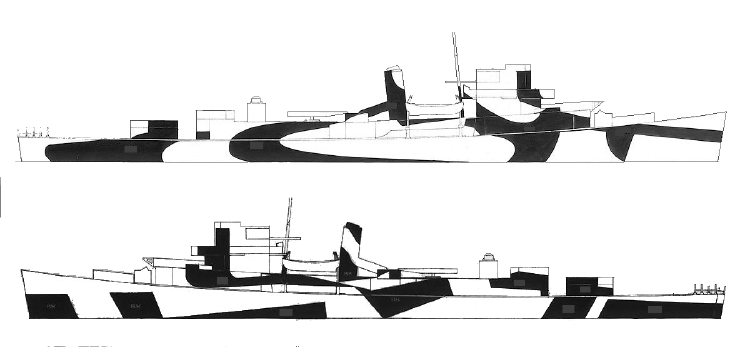
Drawing silhouete of Measure 32 Design 24D for the Buckley class destroyer escorts dated January 6, 1944. This two-color design used dull black (BK) and light gray (5-L) for the vertical surfaces.
Design 24D was derived from a Measure 16 pattern dated June 1942. In December 1943, Design 24D was used for the light cruiser USS Reno (CL-96) in Measure 33 colors: ocean gray and light gray. About the same time 24D was used with Measure 32 colors for the Fletcher class destroyers. In February 1944, it was redrawn for the Cleveland class light cruisers. Design 24D was worn by the light cruisers USS Springfield (CL-66), USS Topeka (CL-67) and USS Astoria (CL-90) in Measure 33 colors and USS Pasadena (CL-65) in Measure 32 colors. Light cruiser USS San Diego (CL-53) also wore Design 24D using the Measure 32 colors dull black and light gray, beginning in April 1944, until the end of the war.
Original drawing source: NARA 80-G-105512 and 80-G-172874.
January 6, 1944 24D in Measure 31 for DE-51
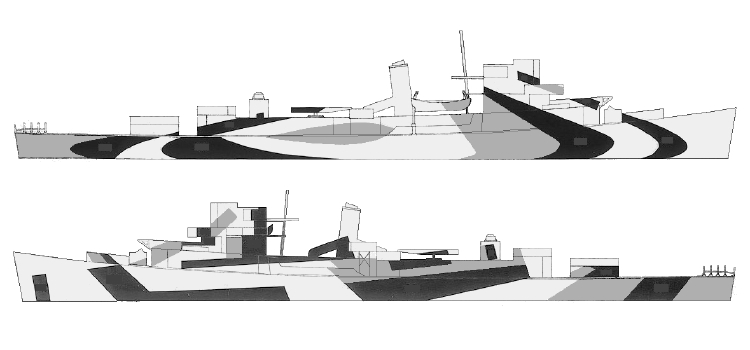
A silhouette of drawing 31/24D, in three colors, for the Buckley class destroyer escorts dated January 6, 1944. The vertical colors were Measure 31: dull black (BK), ocean gray (5-O) and haze gray (5-H); substituting light gray (5-L) for haze gray would make this Measure 32.
Design 24D was derived from a Measure 16 pattern dated June 1942. In December 1943, Design 24D was used for the light cruiser USS Reno (CL-96) in Measure 33 colors: ocean gray and light gray. About the same time 24D was used with Measure 32 colors for the Fletcher class destroyers. In February 1944, it was redrawn for the Cleveland class light cruisers. Design 24D was worn by the light cruisers USS Springfield (CL-66), USS Topeka (CL-67) and USS Astoria (CL-90) in Measure 33 colors and USS Pasadena (CL-65) in Measure 32 colors. Light cruiser USS San Diego (CL-53) also wore Design 24D using the Measure 32 colors dull black and light gray, beginning in April 1944, until the end of the war.
Original drawing source: NARA 80-G-105513 and 80-G-172879.
February 17, 1944 24D in Measure 33 for CL-55
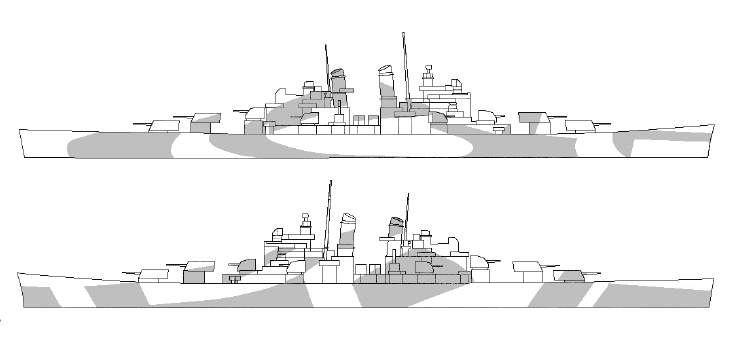
The silhouette for the drawing 33/24D for the Cleveland class light cruisers dated February 17, 1944. Measure 33 colors were ocean gray (5-O) and light gray (5-L) or navy blue (5-N) and pale gray (5-P). Measure 32 would use dull black (BK) and light gray (5-L).
Design 24D was derived from a Measure 16 pattern dated June 1942. In December 1943, Design 24D was used for the light cruiser USS Reno (CL-96) in Measure 33 colors: ocean gray and light gray. About the same time 24D was used with Measure 32 colors for the Fletcher class destroyers. In February 1944, it was redrawn for the Cleveland class light cruisers. Design 24D was worn by the light cruisers USS Springfield (CL-66), USS Topeka (CL-67) and USS Astoria (CL-90) in Measure 33 colors and USS Pasadena (CL-65) in Measure 32 colors. Light cruiser USS San Diego (CL-53) also wore Design 24D using the Measure 32 colors dull black and light gray, beginning in April 1944, until the end of the war.
Original drawing source: NARA 80-G-165985 and 80-G-165992.
25D Designs
May 6, 1944 25D in Measure 31 for DD-692
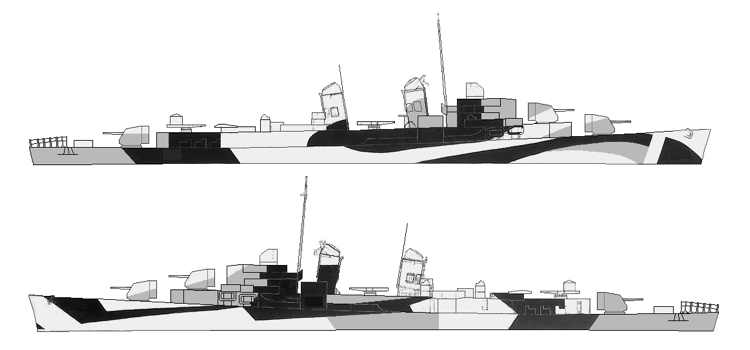
The silhouette from the drawing for Measure 31 Design 25D for the Alen M. Sumner class destroyers dated May 6, 1944. The Measure 31 colors were dull black (BK), ocean gray (5-O) and haze gray (5-H).
This is the only drawing for Design 25D that has yet been found.
Original drawing source: NARA 80-G-109629 and 80-G-109630.
26D Designs
October 18, 1944 26D in Measure 33a for DE-339
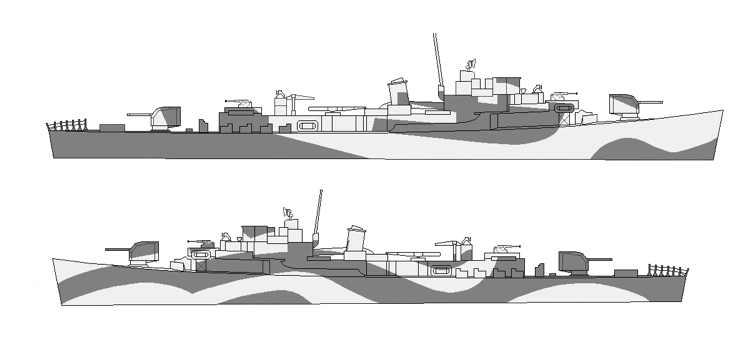
The silhouette from the drawing for 33a/26D for the John C. Butler class destroyer escorts dated October 18, 1944. The vertical colors were ocean gray (5-O) and light gray (5-L) while the horizontal surfaces were solid deck blue (20-B) with no pattern. Design 26D was issued somewhat late in the process of creating Measure 31-32-33 designs. It also shows clear influence from the earlier Design 22D; so much so that, from the starboard side, ships in this design could easily be mistaken for 22D, while the port side differed by quite a lot.
The only other drawing for Design 26D that has yet been found was dated October 24, 1944, for the Buckley class destroyer escorts.
Original drawing source: NARA 80-G-104895 and 80-G-104896.
October 24, 1944 26D in Measure 33a for DE-51
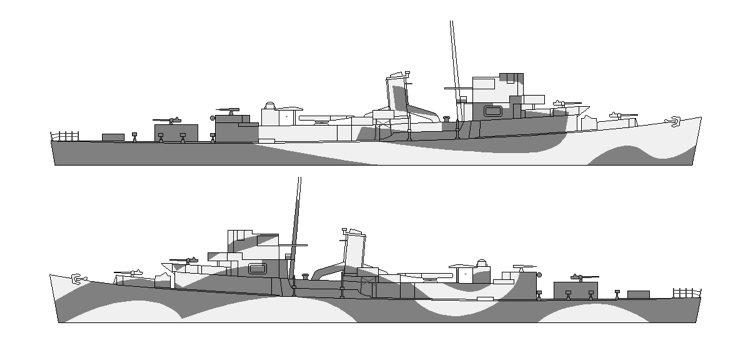
A silhouette from the drawing for Design 26D for the Buckley class destroyer escorts in Measure 33a, originally produced October 24, 1944, which was somewhat late in the process of creating Measure 31-32-33 designs. The vertical colors were: ocean gray (5-O) and light gray (5-L). Design 26D also shows clear influence from the earlier Design 22D; so much so that, from the starboard side, ships in this design could easily be mistaken for 22D. Also, note how the starboard center panel is mis-labeled. There were no known destroyer escorts that used this camouflage.
The first drawing for Design 26D was dated October 18, 1944, for the John C. Butler class destroyer escorts.
Original drawing source: NARA 19-N-73636 and 19-N-73637.
27D Designs
October 25, 1944 27D in Measure 33a for DD-692
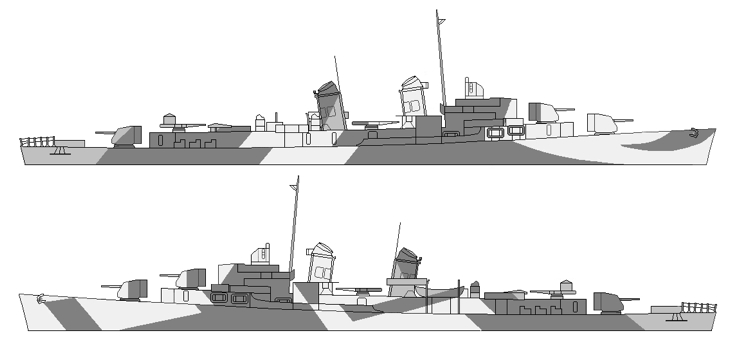
The silhouette from the drawing for Measure 33a Design 27D for the Alen M. Sumner class destroyers dated October 25, 1944. The port side pattern resembles the port side of 24D. This design was developed later among the various designs, and used Measure 33a colors of ocean gray (5-O), haze gray (5-H) and light gray (5-L) with deck blue (20-B) for the decks.
No other drawings of Design 27D have been found.
Original drawing source: NARA 80-G-104907 and 80-G-104908.
28D Designs
October 17, 1944 28D in Measure 33a for DD-692
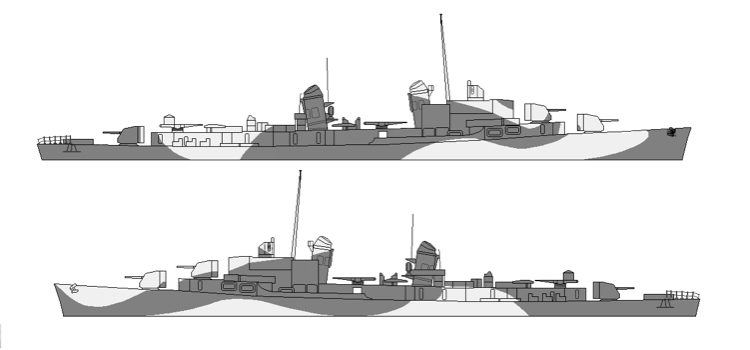
This is the earliest design drawing 33a/28D labeled for the Allen M. Sumner class destroyers dated October 27, 1944. The vertical colors are ocean gray (5-O) and light gray (5-L). The ship profile that was used for this drawing was really of the Gearing DD-710 class. The difference was the added length between the two stacks.
The only other Design 28D drawing yet been found was for the Robert H. Smith class light minelayers.
Original drawing source: NARA 80-G-100070 and 80-G-100071.
November 25, 1944 28D in Measure 32a for DM-23
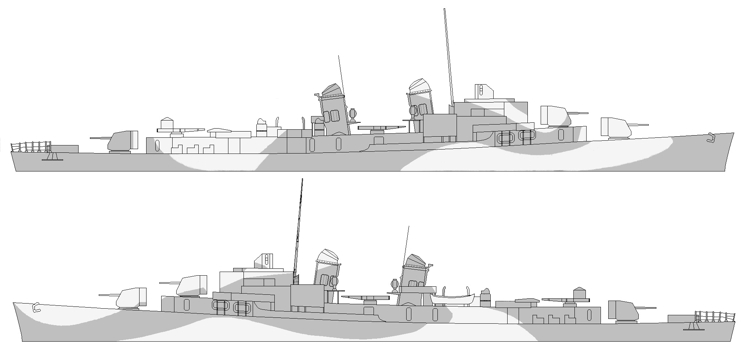
The silhouette of design drawing 32a/28D for the Robert H. Smith class light minelayers modified from Allen M. Sumner class destroyers dated November 25, 1944. The vertical colors are ocean gray (5-O) and haze gray (5-H). The ship profile that was used for this drawing was really of the Allen M. Sumner DD-692 class destroyers. The main difference was that the after torpedo tubes had been removed and the depth charge throwers raised to the former torpedo tube level to make room for mine rails along the deck edge.
The only other Design 28D drawing yet been found was for the Allen M. Sumner class destroyers.
Original drawing source: Floating Drydock.
29D Designs
November 1944 29D in Measure 32a for DMS-19

This is the silhouette from the drawing for Design 32a/29D for the Ellyson class high speed minesweepers which has not yet been found, but probably was drawn in November 1944, since Macomb was photographed in 29D on December 20, 1944. The specified vertical colors were ocean gray (5-O) and haze gray (5-H).
There has been no other version of Design 29D yet found.
A redrawn version of this camouflage can be obtained at The Floating Drydock.
30D Designs
November 30, 1944 30D in Measure 33a for DD-692
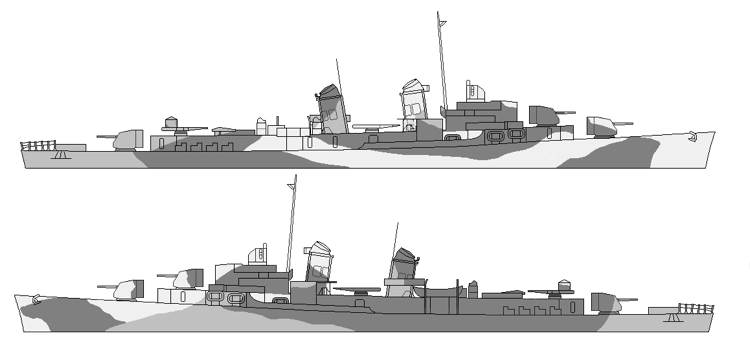
This is the silhouette from the drawing for Measure 33a Design 30D for the Allen M. Sumner class destroyers dated November 30, 1944. The vertical colors are ocean gray (5-O), haze gray (5-H) and light gray (5-L).
There has been no other version of Design 30D yet found.
Original drawing source: NARA 80-G-104905 and 80-G-104906.
31D Designs
December 2, 1944 31D in Measure 33a for DE-339
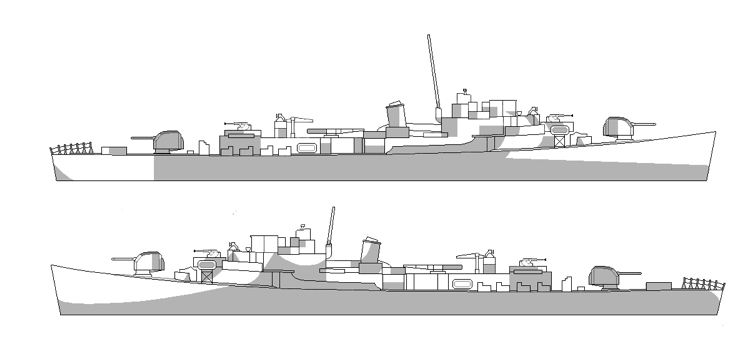
This is the silhouette from the drawing for 33a/31D for the John C. Butler class destroyer escorts dated December 2, 1944. The vertical colors were ocean gray (5-O) and light gray (5-L). Note, that the drawing depicted a ship with torpedo tubes, while the only known ship to carry this camouflage was Cross and she did not have torpedo tubes.
This is the only version of Design 30D yet found.
Original drawing source: NARA 80-G-104911 and 80-G-104912.
35D Designs
March 1, 1945 35D in Measure 33a for DE-5
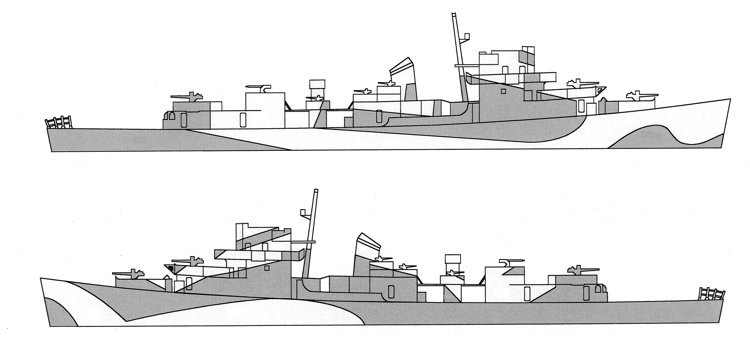
This is the silhouette from the Design 35D drawing for the Evarts class destroyer escorts. The original drawing was dated March 1, 1945, and did not show a whaleboat. This design also shows roots or influence from Design 22D. The colors shown are Measure 33a: ocean gray (5-O) and light gray (5-L). The colors are also numbered in the new designation that indicates they were to be mixed using black instead of purple tint. The horizontal surfaces are all deck blue (20-B) with no pattern. No ships are known to have used this design.
This is the only version of Design 35D yet found.
A copy of this drawing can be obtained from Floating Dry-dock.
Please feel free to continue to contact cleejohnson@usndazzle.com
with any comments, suggestions, or criticisms.
Site last updated: July 4, 2024
Copyright © C. Lee Johnson 2016, 2017, 2018, 2019